British and European Paintings & Prints



8/9 MARCH 2023

OLD MASTER & MODERN PRINTS
WORKS FROM THE COLLECTION OF LAWRENCE GOWING
8 March 2023 at 10am
ANTIQUES & HISTORIC TEXTILES
9 March 2023 at 10am
AUCTIONEERS Nathan Winter Henry Meadows
VIEWING Monday & Tuesday 6/7 March 9.30am-5.30pm Morning of sale from 9am (other times strictly by appointment)
Mallard House, Broadway Lane, South Cerney, Cirencester, Gloucestershire, GL7 5UQ
T: +44 (0) 1285 860006
E: info@dominicwinter.co.uk www.dominicwinter.co.uk
COMMENCING 10.00 am
VIEWING
Monday & Tuesday 6/7 March 9.30am-5.30pm
Morning of sales from 9am (other times strictly by appointment)
Tel: 01285 860006
info@dominicwinter.co.uk
Condition reports now including video conferencing can be requested in the following ways:
T: +44 (0)1285 860006 | E: info@dominicwinter.co.uk
Via the relevant lot page on our website www.dominicwinter.co.uk
Lots marked with AR next to the lot number may be subject to Droit de Suite. Droit de Suite is payable on the hammer price of any artwork sold in the lifetime of the artist, or within 70 years of the artist's death. The buyer agrees to pay Dominic Winter Auctioneers Ltd. an amount equal to the resale royalty and we will pay such amount to the artist's collecting agent. Resale royalty applies where the Hammer price is 1,000 Euros or more and the amount cannot be more than 12,500 Euros per lot.
The amount is calculated as follows:
Royalty For the Portion of the Hammer Price (in Euros)
4.00% up to 50,000
3.00% between 50,000.01 and 200,000
1.00% between 200,000.01 and 350,000
0.50% between 350,000.01 and 500,000
Invoices will, as usual, be issued in Pounds Sterling. For the purposes of calculating the resale royalty the Pounds Sterling/Euro rate of exchange will be the European Central Bank reference rate on the day of the sale.
Please refer to the DACS website www.dacs.org.uk and the Artists’ Collecting Society website www.artistscollectingsociety.org for further details.
For payment arrangements please refer to information for buyers at rear of this catalogue. We would kindly request that commission bids are submitted by 9.30am on the morning of sale.
Customers may submit commission bids or request to bid by telephone in the following ways:
T: +44 (0)1285 860006. |. E: info@dominicwinter.co.uk
Via the relevant lot page on our website www.dominicwinter.co.uk
Live online bidding is available on our website www.dominicwinter.co.uk (surcharge of 3% + vat): a live bidding button will appear 30 minutes before the sale commences. Bidding is also available at the-saleroom.com (surcharge of 4.95% + vat) and invaluable.com (surcharge of 3% + vat).
For payment information see our Information for Buyers page at the rear of this catalogue. For details regarding storage, collection, and delivery please see our Information for Buyers page or contact our office for advice. Successful bidders will not incur storage fees while current government restrictions remain in place.
All lots are offered subject to the Conditions of Sale and Business printed at the back of this catalogue. For full terms and conditions of sale please see our website or contact the auction office. A buyer’s premium of 20% of the hammer price is payable by the buyers of all lots, except those marked with an asterisk, in which case the buyer’s premium is 24%.
Paintings, Watercolours & Prints
Nathan Winter MA (History of Art)
Natasha Broad MA (History of Art)
Colin Meays BA Hons (Conservation)
Antiques & Textiles
Henry Meadows BA Hons, MRICS
Susanna Winters MA (History of Art)

Colin Meays BA Hons (Conservation)

Tel: 01285 860006 info@dominicwinter.co.uk
Cover illustrations:
Front cover: lot 2
Inside front: lot 239
Inside back: lot 489
Back cover: lot 612
Catalogue Produced by Jamm Design – 020 7459 4749 info@jammdesign.co.uk
Photography by Marc Tielemans – 07710 974000 | marc@tielemans.co.uk
Darren Ball – 07593 024858 | darrenball1989@gmail.com



Wednesday 1 March Printed Books, Maps & Documents
Natural History & Original Art
Royalty Posters & Playing Cards
Wednesday 5 April Printed Books including Colour Plate, Maps & Documents James Gillray & The Art of the Caricature
Wednesday 10 May Printed Books, Maps & Documents Atlases, Travel & Polar Exploration
Wednesday 17 May Photographs, Autographs & Historical Documents

Thursday 18 May Military & Aviation History, Medals & Militaria The Tonbridge Battle of Britain Museum
Entries are invited for the above sales: please contact one of our specialist staff for further advice
Thomas Richard Williams (1824-1871). Vanitas still life with skull, open book, glasses and hour glass, 1850-52, stereoscopic daguerreotype, plate size 85 x 170 mm, black passepartout mount, with small printed retailer's ticket of Carpenter & Westley, Opticians, 24 Regent St., London, to verso £1,500-2,000 (17 May 2023)including works from the collection of Sir Lawrence Gowing CBE RA (1918 - 1991)
Dominic Winter Auctioneers are pleased to present for sale by auction a range of important works of art from a number of private collections, most notably that of the eminent British painter, art historian, teacher and curator Sir Lawrence Gowing. Not only an important figure in the Euston Road School, in his professional career as a teacher and curator Gowing also made a significant contribution to the development of art education in the post-war era, and the enhancement of both national and regional public art collections in the U.K.
Gowing was introduced to the painter William Coldstream by W. H. Auden in 1936 (when both Auden and Coldstream were working for the GPO Film Unit), and became Coldstream’s pupil at 12 Fitzroy Street, London after enrolling in 1938. This became the home of the School of Drawing and Painting, set up by Coldstream, Claude Rogers, Victor Pasmore, and Graham Bell, and renamed the Euston Road School after moving premises later the same year. The School was closed due to the advent of the second world war, when Gowing’s Quaker background and Bloomsbury connections led to his conscientious objection (he was given exemption from service on condition that he continued to paint!). By the end of the war Gowing himself began to teach at Camberwell School of Art, alongside Coldstream and Pasmore.
In 1948 aged only 30, Gowing was appointed to the post of Professor of Fine Art at King’s College, Newcastle, a position he held until 1958. At Newcastle he oversaw dramatic changes in the teaching of art through Pasmore and Hamilton’s ‘basic course’, as well as leading on the development of Newcastle’s Hatton Gallery permanent collection and exhibition programme. In 1959, Gowing became principal of the new Chelsea School of Art, under whose direction it became a model of art education: art history was integrated alongside studio practice with an option programme ranging across science, music, philosophy, and literature. Gowing resigned from Chelsea in 1965 in order to become keeper of the British collections and deputy director of the Tate Gallery. He also became a trustee of the National Portrait Gallery, and the British Museum, and was a member of the Arts Council of Great Britain. In 1978, he was elected an associate of the Royal Academy of Arts and made honorary curator of its collections in 1985. He travelled to the United States to serve as Kress Professor at the National Gallery of Art in Washington, D.C., and was also curator of the Phillips Collection in Washington.
Gowing was knighted in 1982 and made a chevalier of the Ordre des Arts et des Lettres, in France in 1985, and received an Honorary Doctorate from Heriot-Watt University in 1980. He wrote perceptively on a number of major artists of the past including Vermeer (1952), Hogarth (1971) Cezanne (1973), Matisse, Bacon, Freud, and Thomas Jones (1985), and made three BBC television programmes, Three Painters (1984, 1986, and 1987), on Massaccio, Vermeer, and Brueghel, Goya, Matisse, and Rembrandt, Turner, Giotto, and Cézanne.

This sale is further enhanced by the inclusion of an important collection of etchings and aquatints by Paul Sandby (1731-1809), one of the most inventive and prolific printmakers in 18th century Britain. This private collection, amassed over forty years or so, ranges from the artist’s early etched figure subjects and views of Scotland, based on topographical sketches made for the Ordnance Survey, to his pioneering aquatint views of the scenery, castles and towns of England and Wales. He created some of the finest works ever made aquatinta: according to Gray (1937) Sandby’s second and third set of Welsh views obtained a ‘luminous and atmospheric effect and richness of tone that was equalled by no other master.’ Thomas Gainsborough described Sandby as ‘the only man of genius’ who had created ‘real views from nature in this country.’
A group of original paintings by the maverick artist and printmaker Morris Cox, originating from the artist’s own estate, as well as a large collection illustrating the development of British wood engraving in the 20th century, adds further interest to the wide range of works on offer in this sale.
To commence at 10am
1* Joni (Icilio Frederico, 1866-1946). A pair of 'tavolette' painted and gilded panels imitating a 15th century Sienese binding, two separate bevel-edged boards with remnants of leather spine attached to each, upper board depicting a youthful male saint wearing a green tunic and metal breastplate, standing on a black and white checkered floor within a relief niche, a halo around his head, and his hands resting on the hilt of a sword, within a relief sectional border of gilt scrolling foliate volutes on a black or burgundy ground, the centre of each side with a heraldic shield, lower board similarly relief panelled and with matching volute decoration, with large heraldic shield in centre surrounded by 6 smaller heraldic shields, some surface loss of paint and gesso, and boards splitting to lower edge, verso of boards each with circular painting, that to upper board depicting a profile head and shoulders portrait of an angel, with pounced halo, on a gilt ground, that to lower board depicting a head and shoulders portrait of a devotional female figure with downcast eyes, dressed in a red robe and white wimple, diameter of each 9 cm (3 1/2 ins), each framed by a thick card mount overlay, painted with gilt foliate volute decoration on a black ground to match exterior of boards, with large pin holes to margins, detached and worn, with some loss, 19 x 12.5 cm (7 1/2 x 5 ins), overall dimensions of boards 19.8 x 13.2 cm (7 3/4 x 5 1/4 ins)


For a similar example see that housed in the Beinecke Library, Yale University (GEN MSS 1452).
Known as the 'prince' of Sienese forgers, Icilio Joni began work in a gilding workshop in Siena as a young man. He went on to set up his own restoration business which led him into the world of forgeries, finding that the market for such items in 19th century Italy was flourishing. Like a number of his contemporaries he forged panel paintings, triptychs, and wooden caskets, passing them off as fifteenth or sixteenth century originals, but, more unusually, he also forged bookbindings. He had read of the distinctive and highly decorated tavolette book covers used by the city of Siena and started to produce his own, layering wooden panels with plaster and painting them with tempera and gold. Although his bindings were somewhat different from the originals - since he had never been to the Archivio di Stato to study the originals - he was able to sell his work through associates in Florence and Rome, and his success was so great that he later claimed in his autobiography that a director from the Archivio di Stato had been convinced by an example of his work and declared it beautiful. Eventually, in the pursuit of fame, Joni revealed the truth, but his workmanship was such that he still received commissions for these bindings, which continue to be sought after today.
The painted heraldic shields depicted on the panels are largely spurious, but tend to copy or are similar to medieval examples such as Henry I Count of Vaudémont in Aspilogia II (d. 1279), Aschfeld of Sussex, the King of Cyprus, Lusignan, Count de la Marche, Seigneur de Valence, the King of Germany, King of Bohemia, King of Rome, and Jean de Barres, Seigneur d'Oissorey (c.1230-1289, French knight and crusader). Further descriptions of the heraldic shields can be supplied.
(2)
Each lot is subject to a Buyer’s Premium of 20% (Lots marked * 24% inclusive of VAT @ 20%)
£700 - £1,000
Attributed to Federico Barrocci (circa 1535-1612). Aeneas’ Flight from Troy, with Anchises, Creusa and Ascanius, circa 1590, oil on canvas, 40 x 54.5 cm (15 3/4 x 21 1/2 ins), wooden frame (56 x 70.5 cm), with label to verso inscribed ‘Prof. L. Gowing’, and printed label of the picture restorers W. Freeman and Son Ltd.
Provenance: Collection of Sir Lawrence Gowing (1918-1991).
Federico Barocci (circa 1535-1612) produced two versions of this work for the Della Rovere family: the first, painted in 1587-88, was sent to the Holy Roman Emperor, Rudolf II of Austria in the spring of 1589, and is now lost, the second, signed and dated 1598, was presented to Cardinal Scipione Borghese, and remains in the Borghese Gallery in Rome.
In 1595 Agostino Carracci issued an engraving after the first of Barocci’s two versions, which he dedicated to Cardinal Odoardo Farnese. The engraving (Bartsch 110) is in exactly the same scale as this finely executed chiaroscuro painting in browns, suggesting the present work may have been a modello for Carracci’s engraving. Another similarly elaborate chiaroscuro version of the same work, in the Royal Collection at Windsor, executed in pen, ink and monochrome oil paint with white heightening, measuring 33.9 x 46.1 cm (RCIN 902343) also corresponds with Agostino Carracci’s engraving after the painting, and was formerly believed to be Agostino’s working copy after the painting preparatory for the engraving, but is now recognised to be the work of Barocci himself, sent to Agostino for that purpose.

See Michael Bury, The Print in Italy 1550-1620, (2001), catalogue nos. 9 and 10.
(1) £3,000 - £5,000
(2) £200 - £300
Provenance: Private Collection, Monmouthshire, England. Similar to the child portraits of Edward



an assistant to Godfrey Kneller about 1693. At the time of Kneller’s death in 1723 Byng was his chief assistant
(1)
Each lot is subject to a Buyer’s Premium of 20% (Lots marked * 24% inclusive of VAT @ 20%)
£400 -
43.2 cm)
Provenance: Private Collection, Monmouthshire, England.
(1) £500 - £800
 4* Circle of Godfrey Kneller (1646-1723). Portrait of a boy in a pink coat, circa 1700-1720, oil on canvas, half-length portrait, halfprofile to left, of a young gentleman, his left hand on his hip, wearing a pale pink silk coat with decorative metal clasps to gusseted sleeves, a crimson cloak, and a fringed white necktie, relined and re-varnished, 39.5 x 30.5 cm (15 1/2 x 12 ins), gilt moulded frame (49.4 x 41 ins)
Byng (circa 1676 – 1753), who became
and lived with him at Great Queen Street in London.
£600
5* Follower of Godfrey Kneller (1646-1723). Oval portrait of a young lady, oil on chamfered wood panel, head and shoulders portrait of a young lady wearing a pale gold silk dress, a blue cloak around her shoulders, some craquelure, 40 x 32 cm (15 3/4 x 12 1/2 ins), gilt moulded frame (52 x
4* Circle of Godfrey Kneller (1646-1723). Portrait of a boy in a pink coat, circa 1700-1720, oil on canvas, half-length portrait, halfprofile to left, of a young gentleman, his left hand on his hip, wearing a pale pink silk coat with decorative metal clasps to gusseted sleeves, a crimson cloak, and a fringed white necktie, relined and re-varnished, 39.5 x 30.5 cm (15 1/2 x 12 ins), gilt moulded frame (49.4 x 41 ins)
Byng (circa 1676 – 1753), who became
and lived with him at Great Queen Street in London.
£600
5* Follower of Godfrey Kneller (1646-1723). Oval portrait of a young lady, oil on chamfered wood panel, head and shoulders portrait of a young lady wearing a pale gold silk dress, a blue cloak around her shoulders, some craquelure, 40 x 32 cm (15 3/4 x 12 1/2 ins), gilt moulded frame (52 x
6* Follower of Godfrey Kneller (1646-1723). Portrait of a young lady, oil on canvas, three quarter length portrait of a young lady wearing a pale gold silk dress, overall craquelure, re-lined and re-varnished, 19th century manuscript inventory labels on stretcher bearing numerals, 30 x 24.5 cm (11 3/4 x 9 3/4 ins), gilt moulded frame (43.3 x 38.1 cm)
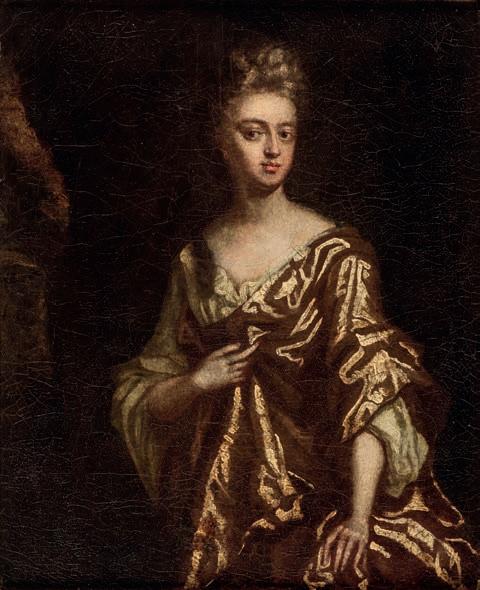
Provenance: Private Collection, Monmouthshire, England. (1) £400 - £600
7* Subleyras (Pierre, 1699-1749). The Visitation, and The Presentation of the Virgin in the Temple, oil on paper laid to panel, 42 x 26 cm (15 x 9 ins), in early ornate moulded gilt frames with striated, foliate, ribbon and acanthus leaf motifs (64 x 48 cm)

Provenance: Collection of Madame Krebs, Sotheby's (Catalogue of fine old master drawings and paintings, including the property of the Rt. Hon. Lord Balfour of Inchrye ... Sir Charles Cave ... the late Herman Cameron Norman ... the Hon. Mrs. Robert Bruce ... Madame Krebs and ... Major S.V. Christie-Miller), 22nd February, 1956, lot 174, where purchased by Agnew & Sons for £350 (hammer); Thomas Agnew & Sons, their label verso, with attribution to Fragonard; Collection of Sir Lawrence Gowing (1918-1991), with Agnew's 1956 invoice (included with this lot).
Pierre Subleyras (1699-1749), a leading 18th century French painter who settled in Rome in 1728, where he worked for Pope Benedict XIV. He is most highly regarded for his religious pictures, which are more serious in spirit than most French works of the Rococo period.
(2) £4,000 - £6,000 Lot

(1)
(2)

 8* Attributed to Benjamin Barker of Bath (1776-1838). Wooded river landscape with faggot gatherer, oil on canvas, 25.5 x 33 cm (10 x 13 ins), old wooden frame (43 x 50.5 cm) Collection of Sir Lawrence Gowing (1918-1991).
8* Attributed to Benjamin Barker of Bath (1776-1838). Wooded river landscape with faggot gatherer, oil on canvas, 25.5 x 33 cm (10 x 13 ins), old wooden frame (43 x 50.5 cm) Collection of Sir Lawrence Gowing (1918-1991).
Lot 10 Lot 11
10* Follower of Raphael (1483-1520). Infant Saint John baptising seated Christ child holding a palm branch, pen and brown ink laid down on paper, sheet size 36 x 34mm (1 7/8 x 1 3/8 ins), 19th century ebonised decorative frame, glazed (11.5 x 10ins)
Provenance: Private collection, Wiltshire, England.
(1) £300 - £500
11* Circle of Giulio Romano (circa 1499-1546). Urn with putti and fruit, circa 1520, pen and brown ink on laid paper, supported on a further sheet of laid paper, inscribed on the mount verso 'Giulio Romano', 120 x 66 mm (4 3/4 x 2 5/8 ins), ebonised and gilt frame (24 x 19 cm)


Provenance: Collection of Sir Lawrence Gowing (1918-1991).
(1) £500 - £800
12 After Giovanni Battista Salvi, Il Sassoferrato (1609-1685). The Madonna at Prayer, probably 18th century, oil on canvas, firmly relined, minor surface loss to lower right corner, 47.1 x 39.8 cm (18 1/2 x 15 5/8 ins), antique-style gilt frame (some minor damage), verso with ink manuscript inscription: 'Given to Rev'd & Mrs Hole by Lady Breeston [?] 1856 England. Brought to Canada 1884. Taken back to England 1898. Brought back to Canada 1936 & given to Francis P. Hole', verso also with blind-tooled 'J. Spondor, liner', and faint ink manuscript title, canvas verso with faint ink manuscript F.P. Hole, the frame 59.5 x 53 cm (1) £500 - £800

13* Franco (Battista, 1510-1561). Allegorical Figure of Chastity, circa 1550, black chalk heightened with white on grey paper backed with laid paper, shaped at the top, inscribed verso in pen and ink ‘Primaticcio 3 3’, with counterfeit collector’s stamp of Sir Peter Lely (see Lugt 2092), and an unidentified initial ‘B’ in pen and ink lower right, sheet size 15.5 x 12.8 cm (8 1/8 x 5 ins), modern wooden frame (49.5 x 35 cm)
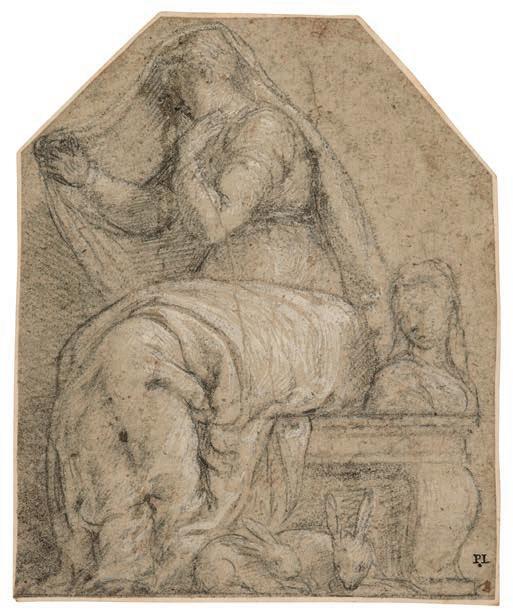
Provenance: Collection of Sir Lawrence Gowing (1918-1991).
The verso of the frame is annotated with notes by Gowing on attribution and iconography obtained from fellow art historians: ‘Popham (from the grave) / Pouncey (after a re-think) and Gere (upside down) now agree that this drawing is by Battista Franco / ? Virtues etc in Hall of Libreria / Giuseppe Porta called Salviati (J.A.G.) / Salviati (better than) / Felicity S.W. / Parmesan School A.E. / Giambattista Zelotti / RBH’.
Previously identified as an allegorical figure of Abundance. However this drawing lacks the main attributes associated with virtue: the presence of rabbits at the Virgin Mary’s feet symbolise the overcoming of lust through chastity, while the veil also symbolises chastity.
Around 1554, Battista Franco was in Venice where he was commissioned to make the ceiling tondi of allegorical subjects and wall panels for the now famous Libreria Marciana, designed by the architect Jacopo Sansovino, and constructed between 1537 and 1588.
(1) £1,500 - £2,000
14* Attributed to Anthonie van Blocklandt (Montfoort 1532-1583 Utrecht). Jacob’s Dream, pen and brown ink with wash, with another drawing to verso (study of two heads in red chalk), on laid paper, sheet size 19.5 x 30.5 cm (7 5/8 x 12 ins), framed (35.5 x 49 cm)



Provenance: Collection of Sir Lawrence Gowing (1918-1991).
(1) £1,500 - £2,000
15* Roman School. The Virgin Mary and Child, with Mary Magdalene, Elizabeth and John the Baptist, circa 1560-75, pen and brown ink with brown wash on 16th century laid paper, heraldic shield watermark with fleur-de-lys, surmounted by a quatrefoil above and letters below (compare Briquet 1836-1843, circa 1560s to 1570s), depicting the Virgin Mary seated with the infant Jesus on her lap, flanked by Mary Magdalene on her left, and the infant John the Baptist holding a dove on her right, watched over by his mother Elizabeth, another woman beside and several small children and a dog, with the four Evangelists behind, set against large stone pillars and a coffered barrel vaulted archway, a few small marks to lower left-hand edge, laid down on 17th century paper with a brown ink single line border, with Dutch watermark of a foolscap wearing a 5 point collar, sheet size 21 x 30 cm (8 1/4 x 11 3/4 ins), mounted, framed and glazed (44.3 x 53.3 ins)
Provenance: Private Collection, Monmouthshire.
(1) £700 - £1,000
Each lot is subject to a Buyer’s Premium of 20% (Lots marked * 24% inclusive of VAT @ 20%)
16* Italian School. Pan surrounded by three feasting satyrs, later 16th century, pen and brown ink and wash with pencil, on laid paper backed by a further sheet of laid paper, with a borderline drawn in with pen and ink, Inscribed to verso in pencil in a 19th century hand ‘Strawberry Hill Sale, April 1842’, sheet size 23.5 x 8.5 cm (9 1/4 x 3 3/8 ins), modern gilt frame (37.5 x 22.5 cm) Horace Walpole, The Great Sale of 1842, Strawberry Hill, according to a pencil inscription verso.
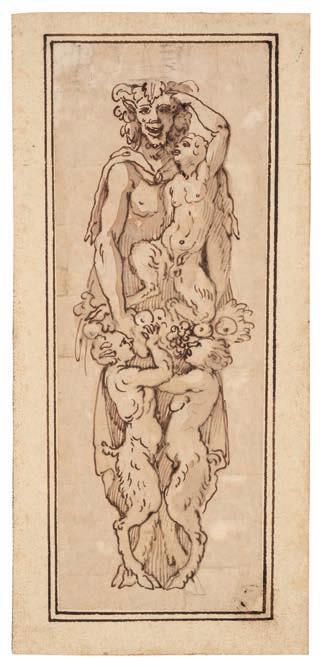
Provenance: Horace Walpole, Strawberry Hill (according to pencil note to verso); Collection of Sir Lawrence Gowing (1918-1991).
‘The Great Sale’ of the contents of Walpole’s gothic residence at Strawberry Hill lasted for 32 days, starting on 25 April 1842.
(1) £300 - £400
17* Circle of Domenico Piola (1627-1703). Studies of Putti in Flight, red chalk, pen and red and brown ink and wash on laid paper, to both recto and verso, sheet size 27 x 41.2 cm (10 5/8 x 16 1/4 ins), framed and double-glazed (43.5 x 58.5 cm)
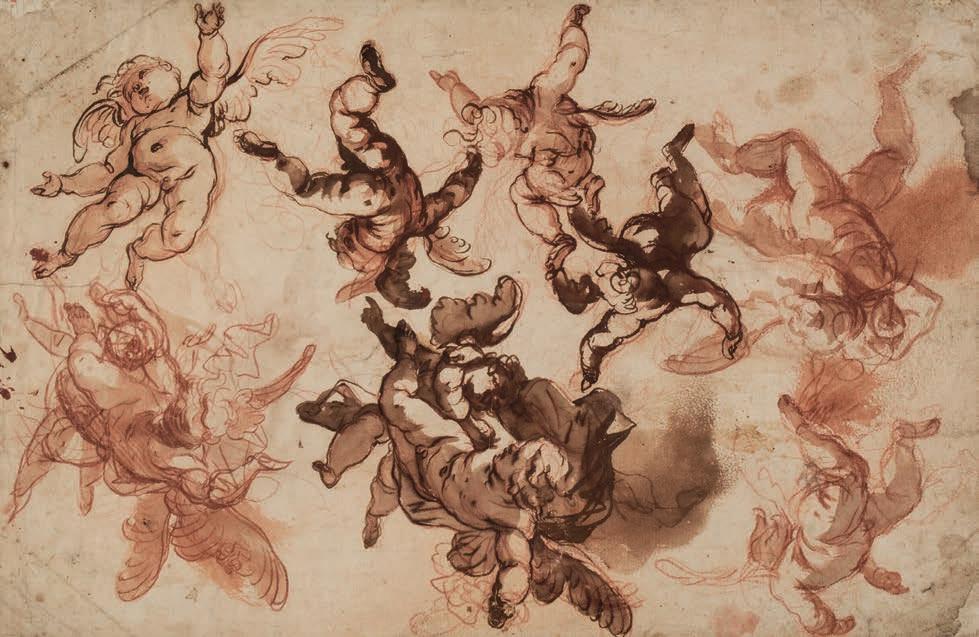
Provenance: Collection of Sir Lawrence Gowing (1918-1991).
(1) £2,000 - £3,000
18* English School. Flowers in a stone vase, 18th century, reverse still life painting on glass, depicting a profusion of flowers in an urn, including tulips, lilies, Japanese quince, honeysuckle, roses, columbines, narcissi, and anemones, with a red admiral butterfly in the foreground, and a stone urn with carved relief, 40.5 x 29 cm (16 x 11 3/8 ins), period carved walnut frame (56.7 x 42 cm) (1) £300 - £500

19* Mortimer (John Hamilton, 1741-1779). Study for head of an old man and other figures, circa 1774, pen and black ink on light brown laid paper, 149 x 120 mm (5 7/8 x 4 3/4 ins), framed and glazed Provenance: Collection of Sir Lawrence Gowing (1918-1991).

The pensive male figure in this drawing is similar in pose to the figure of Caius Marius sitting on the Ruins of Carthage, in the etching by Robert Blyth after Mortimer, taken from a work owned by Richard Payne Knight, and published in 1782. The finished drawing as well as the oil painting of the same subject were exhibited at the Society of Artists exhibition of 1774. (1) £400 - £600
20* Orsi (Tranquillo, 1771-1845). Design for a Tomb, pen, brown ink and brown wash on laid paper, inscribed in pencil to lower margin (in a somewhat later hand) ‘Tranqllo. Orsi’, some light spotting and minor marks, sheet size 197 x 257 mm (7 3/4 x 10 1/4 ins), framed and glazed Provenance: Collection of Sir Lawrence Gowing Estates (1918-1991). Tranquillo Orsi was a professor of architecture in Venice, best known for his design for the interior of La Fenice opera house following the fire of 1836. (1) £300 - £500

21* Dürer (Albrecht, 1471-1528). The Circumcision (from The Life of the Virgin), circa 1503, a very good, black Meder b proof impression printed before the Latin book edition of 1511, beginning to show touches of wear in the densely hatched areas, on laid paper with a High Crown watermark, a few fine, short unobtrusive fissures mainly at the sheet edges, a couple of tiny associated losses, a wormhole towards the upper sheet edge, small losses at the upper and lower right sheet corners, sheet size 297 x 210 mm (11 3/4 x 8 1/4 ins)


Bartsch 86; Meder, Hollstein 198.
(1)
£1,500 - £2,000
22* Dürer (Albrecht, 1471-1528). The Annunciation (from The Life of the Virgin), 1503-1504, woodcut on laid paper with a Flower with Triangle watermark (Meder watermark 127, dated 1471-1524), a good, clear Meder a impression printed after the Latin book edition of 1511, trimmed to the borderline, two small losses at the upper sheet edge, a short fissure at the right sheet edge, two wormholes at the right sheet edge, sheet size 32.2 x 21.1 cm, plus three other woodcuts by Durer from the same series: The Glorification of the Virgin, circa 1505, published 1511, probably a good but uneven Meder a impression after the Latin text edition of 1511, without a discernible watermark, with some wear in the lower left quadrant, trimmed to the borderline, a strip of surface loss to the right of the upper sheet edge, some pale staining upper left and lower centre, minor pinhole damage at the sheet corner tips, The Sojourn of the Holy Family in Egypt, circa 1502, a very good, presumably Meder b-c impression after the 1511 Latin book edition, without a discernible watermark, some losses and damage due to wormage, and The Presentation in the Temple, 1511, some discolouration, two unobtrusive worm tracks (visible when light is shone through) and three small holes towards the upper sheet edge
(4) £400 - £600
23* Dürer (Albrecht, 1471-1528). Christ taking Leave of his Mother, (from The Life of the Virgin), circa 1504, woodcut on laid paper with a Bishop’s Crest watermark (Meder watermark 39, circa 1540-1550), a very good, bright Meder b impression after the Latin book edition of 1511, printing with clarity, trimmed to the borderline, a wormhole towards the upper sheet edge, small losses at three sheet corners and the left sheet edge, a small blue mark to the left shoulder of the female figure supporting the Virgin, sheet size 297 x 208 mm (11 3/4 x 8 1/4 ins), together with The Death of the Virgin, 1510, woodcut, a good impression, presumably after the Latin book edition of 1511, possibly an indistinct watermark, trimmed to the borderline, a few fine fissures centre and at the upper sheet edge with a couple of small associated losses, discolouration towards the sheet edges, The Birth of the Virgin, 1510, woodcut, apparently a good Meder b-c impression after the Latin book edition, trimmed to the borderline, wormage damage, and Christ among the Doctors, circa 1503, woodcut, a good impression, probably a Meder a impression after the 1511 Latin book edition, thinning, similar surface losses and holes due to wormage

(4)
£500 - £800
24* Aldegrever (Heinrich, 1502-circa 1561). Mucius Scaevola before Porsenna, 1530, engraving on laid paper, a good impression, a few pale brown stains, trimmed on the platemark, laid to the mount, 14.5 x 10.3 cm (5 3/4 x 4 ins) framed and glazed (47 x 33 cm)

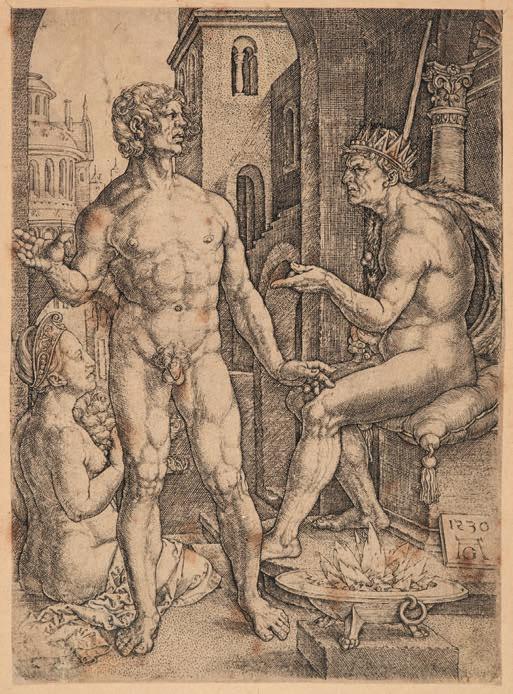
Bartsch, Hollstein, New Hollstein 69.
(1) £150 - £200
25* Trento (Antonio da, circa 1510-1550). Mucius Scaevola, after Parmigianino, circa 1540-1550, chiaroscuro woodcut printed in black and reddish brown, trimmed to the subject, fractionally within at the lower left corner, a couple of inconspicuous repairs in the upper right corner, some discolouration, generally in good condition, sheet size 10 x 14.3 cm (4 x 5 5/8 ins), in carved wooden frame with egg and dart motif (23 x 37 cm)
Provenance: Olimpia Theodoli Fine Prints, Dover Street, London; Private Collection, Somerset, England. Bartsch 21.
(1) £200 - £300
Lot 2426* Gandini (Alessandro, active 1545-1565). Christ in the House of Simon the Pharisee (after Parmigianino after Raphael), circa 1545-65, chiaroscuro woodcut printed from four blocks in shades of greyish-brown on laid paper, indistinct watermark of a Crowned Eagle surmounted by an Orb (?), a very good, clear impression of this rare print, the second, final state, printed by Andreani in 1609, printing strongly and with much gaufrage, trimmed to or just outside the borderline, with some tiny nicks and repaired losses at the sheet edges, otherwise in good condition, trimmed to image, block & sheet size 253 x 372 mm, framed and glazed


Provenance: Collection of Sir Lawrence Gowing (1918-1991).
Bartsch 17; Takahatake 80, fig. 3; Fondazione Cini ALU.1050.1.
J. Johnson, Alessandro Gandini. Uncovering the identity of a chiaroscuro woodcutter, in: Print Quarterly, 2013, pp. 3-13.
(1)
£800 - £1,200
28* Alberti (Cherubino, 1553-1615). The Israelites fleeing Egypt, after Polidoro da Caravaggio, 1576, engraving, a fine proof impression before the dedication and the Coat of Arms of Adriano, with a thread margin at top and right, trimmed on the platemark at left and bottom, with the collector’s stamps of Theodor Falkeisen and Johann Friedrich Huber (Lugt 1008) and Jules Michelin (Lugt 1490) to verso, very good condition, sheet size 237 x 425 mm (9 3/8 x 16 3/4 ins)
Provenance: Theodor Falkeisen (1768-1814) and Johann Friedrich Huber (1766-1832), their stamp to verso (Lugt 1008); Jules Michelin (circa 18151870), painter and watercolourist, his stamp to verso (Lugt 1490).The engravers Falkeisen and Huber ran a print shop in Basel around 1810 trading in prints and drawings.
Bartsch 5.
(1) £300 - £400
27* De Bruyn (Abraham, 1538/40-1587) , Pharoah’s daughter
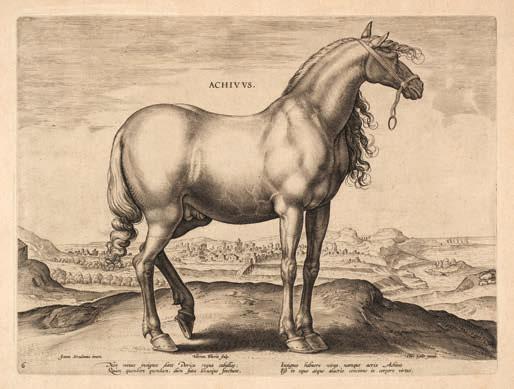
finding Moses, & Joshua plans the conquest of Canaan, after Pieter van der Borcht (from Humanae Salutis Monumenta, by Benito Arias Montano), 1571, two engraved illustrations from the series of 71, both with text to verso, the former a fine, black impression with thread margins, the latter a good impression, a thread margin at left, right and bottom, trimmed to the subject at top, the extreme upper right corner tip lost, minor paper thinning in places, both in good condition, 11.2 x 7.4 cm (4 3/8 x 2 7/8 ins) and 11.3 x 7.7 cm (4 1/2 x 3 ins) respectively

Hollstein 384-454 for the complete series.
(2) £150 - £200
29* Wierix (Hieronymous, 1553-1619). Achivus (from Equile Ioannis Austriaci), after Jan van der Straet, circa 1578, engraving on fine laid paper with an indistinct watermark, a fine impression of the first state, some pale discolouration, old tape at the reverse sheet edges, generally in good condition, plate size 19.5 x 26.3cm (7 3/4 x 10 3/8 ins), sheet size 270 x 325 cm (10 5/8 x 12 7/8 ins)
New Hollstein 532.
(1) £300 - £400
30* After Albrecht Dürer (1471-1528). Saints Nicholas, Ulrich and Erasmus, circa 1580-1620, engraving (in reverse after the original woodcut of circa 1505), a very good, bright impression printing with clarity, on laid paper, 20.6 x 13.8 cm (8 1/8 x 5 3/8 ins)

See Bartsch 118; Meder, Hollstein 233.
(1)
£150 - £250
31* Sadeler (Aegidius, circa 1570-1629). The Virgin and Child with Saint Anne, after Albrecht Dürer, circa 1597, engraving, a very good impression, with thread margins, sheet size 134 x 88mm (5 1/4 x 3 1/2 ins), together with The Beggars, after Lucas van Leyden, circa 1609, engraving, a rather grey New Hollstein (c) impression, trimmed to the borderline, with small inkstamp of the Städtische Kupferstichsammlung, Stettin to verso (Lugt 2312d) , sheet size 109 x 79 mm (5 1/4 x 3 1/2 ins), both in good condition, plus a later woodcut copy after Albrecht Dürer, The Men’s Bathhouse, discoloured Provenance (Lucas van Leyden): Städtische Kupferstichsammlung, Stettin, Pomerania, their stamp to verso (Lugt 2312d).

Hollstein 77 and New Hollstein 143 respectively.
(3) £300 - £400
32* Wierix (Anthonie, 1552-circa 1624). Queen Elizabeth I, engraving, a fine, crisp impression, trimmed to the borderline, 80 x 57 mm (3 x 2 1/4 ins), together with Schut (Cornelis, the Elder,1597-1655). Putto pouring water from an urn, etching, a very good, black impression, the upper right corner made up, two collector’s marks of the Kunstakademie Düsseldorf to verso (Lugt 702 and 2309), 70 x 97 mm (2 3/4 x 3 3/4 ins), both in generally good condition Provenance: Cornelis Schut: Kunstakademie Düsseldorf, two stamps verso (Lugt 702 and 2309).

Provenance: Cornelis Schut: Kunstakademie Düsseldorf, two stamps verso (Lugt 702 and 2309).
(2)
£200 - £300
34* Bolswert (Schelte Adamsz., circa 1586-1659). The Family Concert: As The Old Sing, So The Young Pipe (Soo d’Oude songen soo pepen de Jongen), after Jacob Jordaens, circa 1638–1659, engraving, circa 1638–1659, a very good impression, trimmed on the platemark, retaining the text beneath a fillet of paper around the image, a skilfully repaired, vertical broken crease visible verso (barely visible recto), a couple of short tears in the margins, generally in good condition, sheet size 335 x 463 mm (13 1/4 x 18 1/4 ins) Hollstein 293.

(1) £200 - £300
33* Rembrandt (Harmensz. van Rijn, 1606-1669). Christ driving the Money Changers from the Temple, 1635, etching with drypoint on thin laid paper without watermark, a good but later impression of the fourth (final) state, trimmed on the platemark, retaining a fillet of blank paper around the borderline, one or two thin areas, generally in good condition, 13.8 x 17 cm (5 1/2 x 8 3/4 ins), framed and glazed (35.5 x 41.5 cm)

Bartsch, Hollstein 69; New Hollstein 139; Hind 126.
(1)
£600 - £800
35* Perrier (François, 1590-1650). Six etchings of antique statues (from Segmenta nobilium signorum et statuarum), circa 1638, etchings, fine to very good impressions, printing with plate tone, on laid paper with watermark of a Rampant Lion within a Shield, with margins, some tape staining at the sheet edges, 30 x 20.5 cm (12 x 3 7/8 ins)
(6) £200 - £300

36* Rembrandt (Harmensz. van Rijn, 1606-1669). The Death of the Virgin, 1639, etching on laid paper, without watermark, the fourth state (of 5), some overall light scattered spotting, with margins, small pinhole to lower left of the image (in the draped tablecloth), with William Sharp’s initials in brown ink (Lugt 2650), plate size 410 x 310 mm (16 x 12 1/4 ins), sheet size 430 x 340 mm (17 x 13 1/4 ins), framed and glazed

Provenance: William Sharp (early 19th-century), of Manchester, a friend of Sir Mark Masterman Sykes (1771-1823), one of the great connoisseurs of the period who owned nearly 100,000 prints. Sharp’s collection was sold at Sotheby’s on March 1st, 1878 and 11 following days. According to Lugt, the collector’s identity may also be that of William Sharp (1795-1881) of Enwood Court, Handsworth, near Birmingham ‘a lead and glass merchant originally from Manchester’, whom Waagen met during a visit to the midlands in 1854, or perhaps his father; Collection of Sir Lawrence Gowing (1918-1991). Bartsch 99; New Hollstein 173, iv/v; Hind 161.
(1) £1,000 - £1,500
37* Suyderhoef (Jonas, 1613-1686). Three peasants merrymaking in an Inn, after Adriaen van Ostade, 1647-1652, engraving, a very good, black impression on firm laid paper, with thread margins, sheet 28.4 x 22.3 cm (11 1/4 x 8 3/4 ins), framed and glazed Hollstein 22.
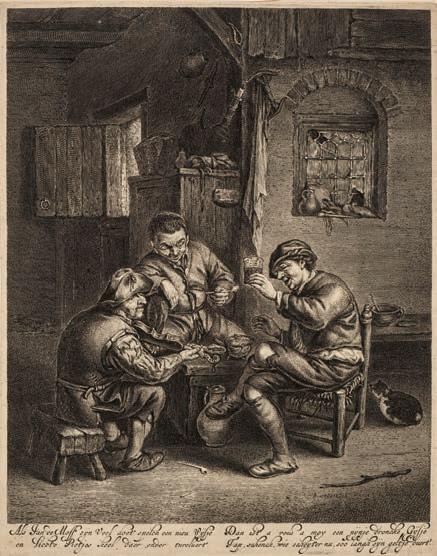
(1)
£200 - £300
38* Rembrandt (Harmensz. van Rijn, 1606-1669). Christ at Emmaus, 1654, etching, burin and drypoint, a good but later impression of the fifth (final) state on wove paper, trimmed to the subject, a short repaired tear lower left, paper thinning in places at the lower sheet edge, some faint brown spotting, trimmed on the platemark, sheet 21.1 x 16.1 cm (8 1/4 x 6 3/8 ins) framed and glazed (33.5 x 27.5 cm)

Bartsch, Hollstein 87; New Hollstein 283.

(1) £500 - £700
39 No lot
Lot 3740 Visscher (Johannes, 1633/34 -1712). Pastoral Landscapes, after Nicolaes Berchem, circa 1660, six etchings with engraving on fine laid paper, each with a partial double headed Eagle surmounted by a Crown watermark (close to Heawood 1300, dated circa 1644), one adhered to the mount in places, watermark unseen, trimmed with a fillet of blank paper around the borderline, four plates adhered to the mount at one sheet edge, two plates with a short tear lower right, generally in good condition (one with a tear at the lower right corner, one with the lower right corner torn), all retaining a fillet of paper around the borderline, hinged at two or four corners to the support sheet, sheet size 152 x 198 mm Hollstein 79, 80 ff.
(6)
£200 - £300
42* Poilly (Nicolas Jean-Baptiste 1675-1747). Pan teaching Daphnis to play the pipes, circa 1700, engraving, a very good impression, with thread margins or trimmed on the platemark, retaining a fillet of blank paper around the borderline, some minor discolouration and a small skinned area in the margins, together with Borgianni (Orazio, circa 1578–1616). God creating the Sun and the Moon,after Raphael, 1615, etching, a very good impression, with narrow margins, adhered to a backing sheet at the reverse sheet corners, some foxing mainly towards the left and right of the image, plus Rode (Christian Bernhard, 1725-1797). Romulus and Remus, 1770, etching, a very good impression, with margins, some minor discoloration, and Manner of Parmigianino. A Female Saint, etching, a very good impression, trimmed to the borderline, some condition defects, 275 x 195 mm (10 7.8 x 7 3/4 ins) and smaller Poilly’s engraving of Pan teaching Daphnis to play the pipes is based on a Roman copy of a Hellenistic original in the Uffizi Galleries, Florence (Inv. no. 1914 n. 92); Rode, Romulus and Remus: Jacobs 195.


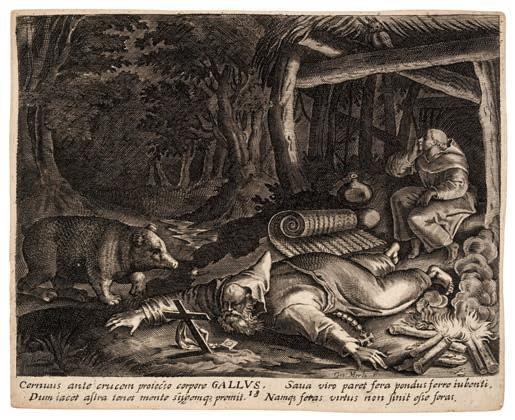
(4) £200 - £300
41 Merli (Giovanni, active second half of 17th century). Six Penitent Saints, engravings, second half of 17th century, on thick laid paer, very good, black impressions, printing with effective contrasts, trimmed on or just within the platemarks, some plates with minor discoloration, generally in good condition, unframed
(6)
£200 - £300
43* Caylus (Anne Claude de Tubieres, Comte de, 1692-1765). Des pêcheurs retirant leurs filets (Fishermen hauling in a catch), after Giulio Romano, circa 1729-40, chiaroscuro woodcut from two blocks, printed in two shades of brown, as published in the Recueil Crozat (Recueil d’estampes d’après les plus beaux tableaux et d’après les plus beaux desseins qui sont en France, plate 65), S. 10 1/2 x 16 1/2 ins, together with Zanetti (Antonio Maria, 1706-1778). Group of five engravings after Giorgione and Titian (from Varie pitture a fresco de’ principali maestri Veneziani), circa 1760, together five engravings on laid paper, plate size 22 x 14 cm, matching gilt frames, glazed, plus Perelle (Adam, 1638-1695). Le Bassin d’Apollon, circa 1680, engraving on laid paper, published by N. Langlois, Paris, plate size 200 x 290 mm, framed and glazed, and other various prints including 9 lithographs by Daumier (les Parisiens en 1852), Les Bons Bourgeois (3), Professeurs et Moutards (2), Les Beaux Jours de la Vie (4), two sepia aquatint engravings from Turner’s Liber Studiorum, by Thomas Lupton (Solway Moss,1816 & Watercress Gatherers, 1819), and a 20th-century reproduction of a touched proof of Hogarth’s Tom Rakewell Arrested (from the Rake’s Progress), all framed and glazed
Provenance: Colonel George Ambrose Cardew (1865-1942), his mark to lower right (Lugt 1134); (20) £300 - £500
44* Piranesi (Giovanni Battista, 1720-1778). Veduta del Pantheon d'Agrippa oggi Chiesa di S. Maria ad Martyres (from the Vedute di Roma), 1761, etching printed on thick laid paper, with watermark of a fleur-de-lys within a double ring, a fine clean impression of the first state (of 5), generally in excellent condition, short closed vertical tear to centre of lower blank margin, plate size 47.5 x 69.5 cm (19 1/2 x 27 3/8 ins), sheet size 54 x 78.5 cm (21 1/4 x 31 ins), black and gilt frame, glazed with mid 20th century printed label of P. & D. Colnaghi & Co. Ltd. to verso (1) £1,500 - £2,000

45* Piranesi (Giovanni Battista, 1720-1778). Veduta del Romano Campidoglio con Scalinata che va alla Chiesa d'Araceli, (from Vedute di Roma), 1757, etching printed on thick laid paper, with watermark of a fleur-de-lys within a double ring, a fine strong and clear impression of the second state (of 5), generally in excellent condition with full margins (now folded in to fit the current window-mount), pale mount stain and a few associated light spots, plate size 40.5 x 54.5 cm (16 x 21 1/2 ins), sheet size 55.5 x 80 cm (21 5/8 x 31 1/2 ins), black and gilt frame, glazed with mid 20th century printed label of P. & D.Colnaghi & Co. Ltd. to verso

(1) £700 - £1,000
46* Piranesi (Giovanni Battista, 1720-1778). Obelisco Egizio (from Vedute di Roma), 1759, etching printed on thick laid paper, with watermark of a fleur-de-lys within a double ring, the second state (of 5), with full margins, generally in excellent condition, old stitch marks to upper blank margin of the sheet (the outer blank margins now folded in to fit the current card window-mount), plate size 54.5 x 40.5 cm (21 1/2 x 16 ins), sheet size 80 x 56 cm (31 1/2 x 22 ins), black and gilt frame, glazed with mid 20th century printed label of P. & D. Colnaghi & Co. Ltd. to verso Hind 53, ii/v; with full margins. Fine lifetime impression.
(1) £600 - £800

47* Piranesi (Giovanni Battista, 1720-1778). Veduta degli avanzi superiori delle Terme di Diocleziano a S. Maria degli Angeli, & Veduta della Villa Estnse in Tivoli (from Vedute di Roma), 1773-1774, two etchings, very good impressions of the first state (of three), from the first Paris edition published 1800-1807, before the addition of numbers, both on laid paper with margins, the first with a few tears in the upper margin, lesser defects at the sheet edges, the second with a small abraded spot in the right-hand tree, residual adhesive to the two vertical folds verso, some discolouration, laid down on board, the first plate size 46.7 x 70.5 cm (18 3/8 x 27 5/8 ins), sheet size 52.5 x 74 cm (20 3/4 x 29 1/4 ins), both framed and glazed Hind 115, i/iii and 105, i/iii respectively.
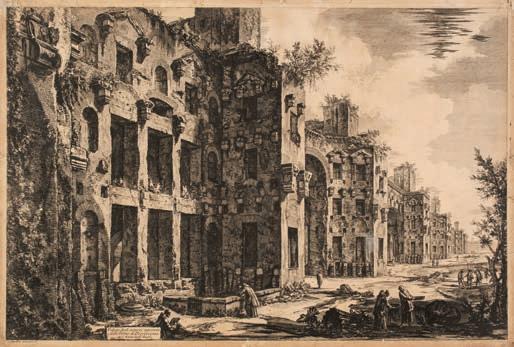
The Baths of Diocletian: Interior of Frigidarum, South Wall, and View of the Villa d’Este in Tivoli.
(2) £200 - £300
48* Sandby (Paul, 1731-1809). John Balfour's Coffee House at Edinburgh, & Man with a Tankard outside an Inn (from the series Good Entertainment: A New Book of Figure Studies), circa 17471756, two etchings, very good impressions on firm laid paper, with margins, together with eight other figure subjects by Sandby: Old Woman with a Basket, three figures in the background (from the series Book of Etchings); Old Man and Woman seated on a Bench, 1747; A Group of Figures in a Landscape; Caricatured heads of a man and a woman, and the figure of a man with a leek or a feather in his hat, (from the series of Figure Subjects), the first state (of two), before the addition of the feather/leek; A group of two women, one carrying a baby, a man and three children; A stout butcher with two other figures and a dog; Head and shoulders portrait of a man, a later impression; Two young ladies, circa 1756, with the initials 'VG' from a Villedary watermark, and one sheet with impressions of Three men in conversation beneath a tree, A Book of Figures; two men, and boy pulling at the jacket of one, and a further impression of the figure of a man with a leek or a feather in his hat (i/ii) printed on one sheet (47.7 x 32 cm, 18 3/4 x 12 1/2 ins), four with margins, the rest trimmed on or within the platemark retaining a fillet of paper outside the borderlines, one trimmed to the subject, generally in good condition, unframed, sheets 13.5 x 10.8 cm (5 1/4 x 4 1/4 ins) and smaller Gunn 32, 43, 44, 46 i/ii, 48, 49, 51, 53, 57, 63 and 46, 55, 56 printed on one sheet. (11) £400 - £600

49* Sandby (Paul, 1731-1809). Scottish Landscapes, circa 17501751, fine to very good impressions on laid paper, comprising five plates from Scottish Landscapes (Second Set), 1750-1751: Scottish Beggars seated resting by Broughton Well, 1750, on thick laid paper with part of an Auvergne double-headed Eagle watermark (cf. Heawood 1317), Capriccio Landscape with the Mackenzie Monument, 1750, inscribed to verso, In the Meadows near Edinburgh, 1751 Leith from Broughton, 1750 and Capriccio with Edinburgh Castle and Arthur’s Seat, 1750, on thick laid paper with part of an Auvergne double headed Eagle watermark (cf. Heawood 1312), together with five plates from Scottish Landscapes (Third Set), circa 1751: Capriccio of Hamilton Collegiate Church and Edinburgh Castle in the distance, Trees and Huts with a distant view of a town by a river, Haddington, East Lothian, A round tower outside a town, with figures, on thick laid paper with a partial Auvergne Letters watermark (see Heawood 427), and Landscape with a ruined Mill, on thick laid paper with part of an Auvergne double headed Eagle watermark (cf. Heawood 1317), plus two plates from Scottish Landscapes (First Set), 1750: Women in a landscape with a ruined tower house in the distance, and Landscape with a woman and a fisherman sitting on a riverbank, by Francis Vivares, most sheets with large margins, several with narrow margins or trimmed on the platemarks (Gunn 81, 82, 77 and figure 58), generally in very good condition, sheet size 47.5 x 31.5 cm (18 3/4 x 12 1/4 ins) and smaller Gunn 78, 80, 81, 82, 83, 84, 85, 86, 87, 89, 72, 77 (and page 132, figure 58). (12) £800 - £1,200

50* Sandby (Paul, 1731-1809). Eight Landscapes, circa 1750-1758, etchings, fine, black impressions on laid paper, including Landscape with a fortified building and travellers: together with three plates from the horizontal Landscapes series: The Canteen Tent (after Philips Wouverman), with an Auvergne watermark, Landscape with a ruined castle, trees and cliffs, with figures, and Moonlit River Scene, plus four plates from the series Landscapes with Figures: Draped female figure carving a heart on an old Tree, on laid paper with a Fleur de Lys with pendant letter T watermark, Chased by a Bull, A woman and children in Windsor Park, the Culloden Obelisk in the distance (laid on card) and Crossing the Bridge, both wide and narrow margins, or trimmed to retain a fillet of blank paper around the borderline, sheet size 32 x 47.6 cm (12 1/2 x 18 3/4 ins) and smaller, generally in very good condition
Gunn 72, 90, 91, 92, 95, 96, 101 and 102.
(8)
£400 - £600
51* Sandby (Paul, 1731-1809). Four etchings from Eight Views of Windsor Great Park, 1754-1758, etchings after Thomas Sandby, very good impressions on sturdy laid paper, comprising the dedication plate, 1754, second (final) state,The Cascade and Grotto (Sandby and Thomas Rooker), 1754-1758, a rare trial proof impression before completion of the sky and other detalls and before letters, also an impression of the first state (of two), and View from the North Side of the Virginia River near the Manour Lodge, 1754-55, the latter three with an Auvergne watermark (see Heawood 426-427), all with margins, except one (Gunn 149) trimmed just within the platemark, retaining a blank border and text around the borderline, sheet size 44.4 x 62.8 cm (17 1/2 x 24 3/4 ins) and smaller Gunn 146b, 147 (2), 149.
(4) £300 - £500
Lot 51
52* Sandby (Paul, 1731-1809). A collection of 18 engravings after Paul Sandby, 1770’s-1780’s, very good impressions, including four by Michael Angelo Rooker: A South East View of Windsor Castle, engraving, 1776, on laid paper (inscribed ‘Mrs Thomson’ verso in pencil); Chatsworth in Derbyshire, engraving, 1775; Seat of the Right Hon.ble the Earl of Harcourt at Nuneham with a distant view of Oxford, engraving, 1775, the latter two on laid paper laid down on card, varnished, the latter inscribed lower margin ‘varnished by my father W.S.’; Knole Park in Kent, engraving, 1775, on laid paper; and Wynn Stay in Denbighshire, 1775, on laid paper; Richard Bernard Godfrey after Paul Sandby, Pembroke Castle, engraving, 1778, on fine laid paper; Mannorbeer Castle, 1779, on laid paper watermarked B B Brun; Woodstock, engraving, 1777, on wove paper, two by William Walker after Sandby: Queen’s Gate at Caernarvon, 1778, engraving on laid paper, and View of Boniton Lin, engraving, 1788, on laid paper laid down on card, varnished; two by Francis Chesham after Sandby: Roche Abbey in Yorkshire, engraving, 1780, on laid paper laid down on card, varnished, inscribed lower margin ‘varnished by my father W.S.’, and The Hot Wells at Bristol from a Meadow, near Rownham Passage, on laid paper with a partial Grapes watermark; two by William Watts after Sandby: Ruins of Stanton Court in Oxfordshire, 1778, and West View of Nottingham Castle, engraving, 1776, both on wove paper; W. & J. Walker after Sandby, Gresford Cottage, Denbighshire, engraving, on wove paper, 1793; Thomas Milton after Sandby, Newstead, in Nottinghamshire, The Seat of Lord Byron, 1780, engraving, on laid paper with an indistinct watermark; and Benjamin Green after Sandby, The Welch Bridge at Shrewsbury, engraving, 1776, on laid paper; plus four engravings by and after other artists, including Joseph Lambert after James Storer, Remains of Eltham Palace, Kent, 1811, etching on wove paper; W. Watts after C. Metz, View of the Isle of Anglesea, 1784, on wove paper; Thomas Milton after Francis Wheatley, Mallahide Castle in the Co. of Dublin, 1783, engraving on wove paper; and Thomas Milton after John James Barralet, The Dargle in the Co. of Wicklow (from Milton’s Views), engraving, 1783, on wove paper, various sizes (21) £200 - £300



53* Sandby (Paul, 1731-1809). Stormy wooded landscape, with cattle drovers, circa 1773, pure aquatint printed in dark grey, with touches of pen and black ink, a rich and atmospheric impression of this experimental aquatint on firm laid paper, with sharp and inky platemarks and narrow margins, in very good condition, plate size 161 x 238 mm (6 1/4 x 9 3/8 ins), sheet size 16.6 x 24 cm (6 1/2 x 9 1/2 ins), unframed

(1) £400 - £600
55* Sandby (Paul, 1731-1809). Ten plates from XII Views in Aquatinta from drawings taken on the spot in South Wales, The First Set, 1775, aquatint title page with dedication and nine aquatint views: Plate I, Chepstow Castle in Monmouthshire; Plate III, St Quintin’s Castle near Cowbridge in Glamorgan Shire; Plate VI, Pembroke Castle; Plate VII, Part of the Remains of Llanphor near Pembroke; Plate VIII, Manerbawr Castle in Pembrokeshire; Plate IX, Manerbawr Castle From the Inward Court, Plate X, Carey Castle in Pembrokeshire, Plate XI, Benton Castle looking down the reach to Milford Haven, Plate XII, Episcopal Palace at St. David’s, all etchings with aquatint, printed in variations of black and grey, bistre, and sepia, very fine, early, richly inked and atmospheric impressions of the first states (of three, four or five), the title page only state (before the edition published by Boydell), printing with clarity and contrasts, and subtle gradations in the aquatint, Plate IX with an indistinct Letters watermark, Plate XII with an indistinct circular watermark, all with margins, variously trimmed, some plates with pale waterstaining and a few paper splits in place, sheet size 36.2 x 53 cm (14 ¼ x 20 7/8 ins) and similar Gunn 196; 197 i/iv; 199, 202- 207 i/iii; 208 i/v. The first states of Sandby’s major aquatint project before the additions of Boydell’s or Sandby’s address. (10) £800 - £1,200


54* Sandby (Paul, 1731-1809). View of a bridge with horseman and bare tree, circa 1773, pure aquatint printed in dark grey and blue, a fine impression of this experimental aquatint, on firm laid paper, inscribed verso in pen and ink, inscribed verso in pencil ‘Experiment in aquatinta by J. P. Sandby / from ... Geo Smith / Derby’ and in pen and ink ‘H Sandby’, trimmed to the subject, in very good condition, sheet size 11.4 x 19.6 cm (4 1/2 x 7 3/4 ins) This work appears to be an experimental aquatint by Paul Sandby’s son, Thomas Paul Sandby, after a work by either George Smith of Chichester or Thomas Smith of Derby; the two names have been confused in this later inscription. H. Sandby would be Paul’s wife or daughter.

(1) £300 - £500
Lot 56
56* Sandby (Paul, 1731-1809). Views in Wales, 1775-1777, etchings and aquatints printed in browns, including Manerbawr Castle in Pembrokeshire, (from Twelve Views in South Wales, 1775), etching and aquatint, a very good, rich impression of the first state (of two); Chepstow Castle in Monmouthshire, a very good impression of the first state (of three), some defects; St Quintin’s Castle near Cowbridge in Glamorgan Shire, 1775-1776, a later impression of the third (final) state; View up North River from the House at Briton Ferry in Glamorganshire, a later impression of the second state (of three), some defects, all from Twelve Views in South Wales, 1775; Harlech Castle in Monmouthshire with Snowdon at a distance, a good but later impression and Conway in the county of Caernarvon (both from Twelve Views in North Wales,1776,) a later impression of Auvergne laid paper; The Entrance to Chepstow Castle (from Twelve Views in Wales, 1777), a very good impression of the only state; and three further works from Twelve Views in Wales: Inside View of Chepstow Castle looking Eastwood, a later impression on Villedary paper with a Crowned Fleur de Lys within Shield watermark with pendant Initials (Heawood 262), Traeth Mawr in the Road to Caernarvon from Festiniog, on J. Whatman laid paper, presumably a later impression of the first state (of two), and Denefawr Castle, a good impression of the only state on Auvergne laid paper, all prints on laid paper, trimmed variously, with margins or to the borderlines, occasional waterstains and tears in the margins, generally in good to fair condition, sheet size 29.2 x 40.6 cm (11 1/2 x 16 ins) and smaller Gunn (respectively) 204, 197, 199, 220, 201, 224, 234, 236, 237, 242. (10) £150 - £200
57* Sandby (Paul, 1731-1809). The Entrance of Warwick Castle from the Lower Court (from Four Views of Warwick Castle,1776), aquatint with etching printed in bistre, a very good impression of presumably the second (final) state, on Villedary laid paper with a Fleur de Lys within Shield surmounted by a Crown watermark (Heawood 1833), with pendant letters VDL, together withanother view from the same series: Part of Warwick Castle from the S.E., aquatint with etching printed in bistre, some condition defects, together with five plates from Miscellaneous Aquatints: Duke of Montagu’s, Black Heath, etching with aquatint printed in brown; two impressions of Cemetery Gate of St Augustine’s Monastery at Canterbury, 1782-89, aquatints printed in black and grey, fine, rich and bright impressions, one with a circular watermark; and two impressions of Tunbridge Castle, aquatints, one printed in bistre and one in black and grey, each with Auvergne laid paper with a Name of Jesus within oval surmounted by a cross watermark (Heawood 2952); plus Inside View of Chepstow Castle looking Eastwood, with a circular watermark, all on laid paper; and an impression of Windsor Castle from the Lower Court on the 5th Novr. on wove paper Gunn 210, 212, 325 & 328.

According to Gunn there are likely two states of The Entrance of Warwick Castle from the Lower Court; she cites an impression at the Yale Centre for British Art, New Haven (B1977.14.13012), which has clear white edged clouds, but no birds.
(9) £200 - £300
59* Sandby (Paul, 1731-1809). Four plates from Six Views of Windsor and Eton, 1776-1777, etchings with aquatint, including a rare signed proof before letters of Windsor Castle from the N.W. a fine, atmospheric early impression of the second (final) state, with the flag dark against the sky, signed, inscribed, titled and dedicated by the artist in pencil ‘WINDSOR CASTLE from the North West, Published / 1 Sept 1776 / To his Grace the Duke of Montagu –Three Views of the Royal Castle of Windsor are most respectfully inscribed by his Grace’s most obedient & most obliged humble servant / P. Sandby R.A.’, backed on stiff laid paper; a further rare trial proof of Windsor Castle from the N.W. with the flag lacking, a fine rich impression on Auvergne laid paper with the Encircled Cross (cf. Heawood 3306), trimmed to the borderline and window mounted, some skinned patches in the lower half of the sheet verso Eton College from Crown Corner, 1776, etching with aquatint printed in bistre, a fine, atmospheric impression of the first state (of two), before re-work to the sky, printing with rich contrasts, on Auvergne laid paper with the Letters watermark (cf. Heawood 3306), trimmed to the borderline, some faint scattered foxmarks; Windsor from Eton, etching with aquatint printed in bistre, a fine, rich impression of the first state (of two), again before changes to the sky, on Auvergne laid paper with the Encircled Cross and Letters watermark (Heawood 3306), with margins, some faint scattered foxmarks; and Windsor Hundred Steps, from Views of Windsor Castle, Small Set, circa 1777, outline etching printed in bistre, on laid paper with a Sphere watermark (related to Heawood 511) backed with stiff card with a Fleur de Lys watermark, unframed, sheet 39.4 x 54.4 cm (15 1/2 x 21 3/8 ins) and smaller Gunn 230, 231, 226 (respectively). (5) £200 - £300

60* Sandby, Paul (1731-1809). Windsor Terrace looking Westward (from Six Views of Windsor and Eton), 1776, etching with aquatint and extensive hand colouring in watercolours. state uncertain as trimmed to the subject, on laid paper backed with thick laid card, with a watercolour border, in very good condition, 28.7 x 44.9 cm (11 1/4 x 17 5/8 ins), unframed
Gunn 228.
(1)
£200 - £300
62* Sandby (Paul, 1731-1809). Sepulchral Monument at Old Capua (from Views in and around Naples, after Pietro Fabris), 1778, a fine impression, printed in browns: and four plates from Ionian Antiquities (1779-1780): Inside of the Ruin at Troas, aquatint with etching printed in sepia and brown two impressions, the first a fine, rich impression of the first state (of two) on Auvergne laid paper, the second a very good impression of the second (final) state, with the publication line, trimmed on the platemark at top and bottom, fractionally within subject at left and right, The Temple at Sunium, and Miletus, aquatints with etching printed in brown and sepia, fine, rich impressions of the first states (of two), The Temple at Sunium on laid paper with a Name of Jesus with Cross and Heart within a Circle watermark (Heawood 2997, dated 1767) and a Letters watermark, trimmed to the borderline, some defects; Miletus on Auvergne (?) laid paper, trimmed to the borderline, retaining the title, a small split and a couple of associated small areas of surface loss in the sky towards the right of subject; sheet size 35.8 x 54.8 cm (14 1/8 x 21 1/2 ins) and slightly smaller Gunn 257, 271, 274 i/ii and ii/ii, 275 i/ii.
(5) £200 - £300
61* Sandby (Paul, 1731-1806). Swansey Castle, 1777, etching with aquatint, a fine, rich impression printed in subtly graduated browns and sepia, on Auvergne laid paper (watermark related to Heawood 3416); together with Plate VII from XII Views in Aquatinta From Drawings Taken on the Spot in South Wales, The First Set 1775: Part of the Remains at Llanphor near Pembroke, etching with aquatint printed in black and grey, a fine, rich impression of the first state (of three), before the edition published by Boydell, plus three further plates from Views in South Wales (The First Set), including two impressions of the title page, good impressions though printing slightly unevenly, one with part of a Letters watermark; and Plate I, Chepstow Castle in Monmouthshire, 1775, etching with aquatint printed in sepia, a good impression of the second state (of three), published by Boydell, with a Fleur de Lys watermark, a little marred by pale staining, and Carew Castle (from Twelve Views in Wales, Third Set, 1777), aquatint printed in sepia and brown, a very good impression, on laid paper with a Cross and pendant letters within an Oval watermark (related to Heawood 922), trimmed on the platemark, all on laid paper; sheet size 35.5 x 53 cm (14 x 20 7/8 ins) and smaller Swansey Castle, intended for the first set of Views in South Wales, was rejected by Sandby.

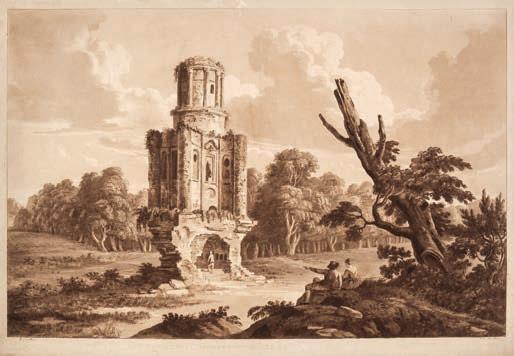

Gunn (respectively) 310, 203 i/iii,196 (2), 197 ii/iii, 239.
(6)
£300 - £500
63* Attributed to Paul Sandby (1731-1806). View of a Scottish river with fishermen and cattle, wooden bridge and castle, circa 1780s, pencil on laid paper, inscribed in pencil in an old hand to verso ‘C … + Bridge / ? by PS’, the upper right corner tip lost, sheet 21 x 27.5 cm (8 ¼ x 10 7/8 ins)
(1) £200 - £300

64* Attributed to Paul Sandby (1731-1806). Wooded Landscape with cattle drovers, pencil on laid paper with a partial Initial watermark, inscribed in pencil verso ‘by Paul Sandby’, sheet size 21.8 x 28 cm (8 1/2 x 11 ins)


(1) £200 - £300
66* After Paul Sandby (1731-1809). Rustic scene with countryfolk droving sheep in a wooded park landscape, a church beyond, circa 1785, watercolour on card backed with laid paper, inscribed verso in pen and blue ink 'Miss E. Vardy's Painting / & given to me Sep.tr 1849.', further inscribed in pencil 'after Paul Sandby' / ... 1785' and 'Eliza Sandby' written next to 'me' in pen and blue ink, 15 x 24.8 cm (5 7/8 x 9 3/4 ins)
This is probably a work undertaken by a pupil of Paul Sandby's, either under his direction or from a work by him.
(1) £200 - £300
65 Sandby (Paul, 1731-1809). The Encampment on Blackheath (from Four Views of Military Encampments), 1783, etching with fine hand-colouring (by the artist or a pupil of his), on laid paper with a Villedary watermark with crowned Fleur de Lys and pendant initials VDL, trimmed to the subject, inset to modern cream laid paper, in very good condition, the watercolour pigments bright and fresh, 29.8 x 45.2 cm (11 3/4 x 17 3/4 ins), window-mounted Gunn 284.
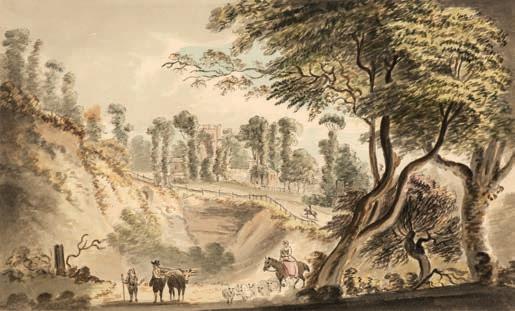
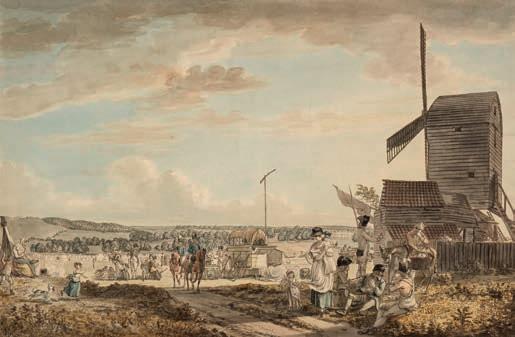
In her catalogue Gunn refers to Sandby’s habitual use of Villedary paper, watermarked with a shield surmounted by a Fleur de Lys.
(1) £300 - £500
67* Sandby (Paul, 1731-1806). View of the Village of Abbey on the Wye, circa 1770’s, pencil on wove paper, inscribed in pencil verso ‘Sketch for View of the Village of Abbey on the Wye / Drawn by P. Sandby R.A. / Engraved by him in aquatinta’, 213 x 202 mm (8 3/8 x 7 7/8 ins)
This drawing appears to be a preliminary sketch for an aquatint of the village of Abbey on the Wye, a Welsh view not included in the published Welsh sets, made by Sandby sometime in the 1770’s. The same composition appears in a later aquatint, of which the British Museum holds a unique hand coloured impression, engraved by Sandby after a drawing by Thomas Rackett, which was issued after Sandby’s death by Thomas Palser in 1812 (museum number 1904,0819.692).
See Gunn, The Prints of Paul Sandby (1731-1809): a catalogue raisonné (2015), number 315.
(1) £200 - £300
68* Sandby (Paul, 1730-1809). Album of 56 etched landscapes and figure subjects, 1747-1758 [but circa 1815], originally executed 1747-1758, final states on Whatman wove paper dated 1815, including 20 figure subjects, 32 landscape subjects, including the three complete sets of Scottish Landscapes (first set, oval, together with one oval landscape etching by Francis Vivares; the second set, vertical; the third set, horizontal), and the complete set of Six Ruins, some pale mottled foxing towards the edges of the album sheets, bound in marbled paper covered boards, gilt tooled leather spine and corners, some wear and tear, the front cover detached, inscribed within ‘Mary Spuring (?)/ Heath Lodge / Thornton Heath’ album size 26.5 x 40.5 cm (10 3/8 x 16 1/4 ins)

Gunn (references in order of appearance in the album, one print per sheet unless stated otherwise): 80, 102; nos. 50, 54, 64, 67, 70, 71 printed on one sheet; 87, 89, 90, 91, 92, 93, 94, 95; nos. 44, 45, 61, 62, 68, 69 printed on one sheet; nos. 48, 51, 55, 57, 63, 103 printed on one sheet; nos. 73, 76, fig. 58 (one plate by Francis Vivares) printed on one sheet; 96, 72; nos. 32, 47, 59, 60, 66 printed on one sheet; nos. 74, 75, 77 printed on one sheet; 83, 85, 88, 78, 79, 86, 84, 107, 81, 106, 110, 82, 108, 109, and 105.
(1) £300 - £500
69* Attributed to Francis Place (1647-1728). View of West Gate [Canterbury?], ‘Part of ye Laday Wistons Palis’, and A View of Rustic Cottages, probably early 18th century, pencil on laid paper, the first with a partial Strasbourg Bend watermark, the first and third with a borderline drawn in pen and grey ink, the first with Sandby’s monogram stamp lower left (Lugt 2112), inscribed upper left ‘Westgatte’ in pencil, sheet size 219 x 120 mm (8 5/8 x 4 3/4 ins), the second titled in pencil at upper edge, sheet size 22 x 12 cm (8 5/8 x 4 ¾ ins), the third inscribed in pencil verso ‘Sir Bruce Ingram’ verso, a short tear lower right corner, adhered to the mount at the remaining corners, sheet size 225 x 142 mm (8 3/4 x 5 5/8 ins), loosely contained in a folded paper sleeve bearing notes on provenance

Provenance: View of West Gate, Canterbury: Paul Sandby (1731-1809), his collector’s mark lower left (Lugt 2112); View of Rustic Cottages: Sir Bruce Ingram (1877-1963, see Lugt 1405a), according to a pencil inscription verso. The paper folder containing the drawings is inscribed in pencil ‘? by / Francis Place./ Ex colln Paul Sandby / Ex colln Sir Bruce Ingram’.

(3) £200 - £300
Each lot is subject to a Buyer’s Premium of 20% (Lots marked * 24% inclusive of VAT @ 20%)
70* Cosway (Richard, 1742-1821). Portrait of Paul Sandby, circa 1790, pencil on stiff wove paper, inscribed verso ‘given me by George Peake / Trinity Parsonage Abergavenny / on the death of his father Rev M. Peake / 22 Feb 1880’, sheet size 119 x 87 mm (4 5/8 x 3 3/8 ins), together with the original copper plate engraved after the portrait by Richard Dagley (published in the Library of the Fine Arts in December 1831), and two impressions of the published stipple engraving, one on thin wove paper, and one printed in colours on stiff wove paper, with a Letters watermark

(4) £500 - £800
71* Goya (Francisco, 1746-1828). De que mal morira? (What illness will he die from?), 1796-97, etching with aquatint, from Los Caprichos, plate 40, the 6th state, printed by the Calcografia for the Real Academia, 1890-1900, 215 x 150 mm (8 1/2 x 6 ins), with margins, framed and glazed, with label of Goldmark gallery label to verso
(1) £200 - £300

47 cm)
(1) £300 - £500
1/2 x 13 3/8 ins), unframed
(1) £200 - £300
5/8 ins), sheet size 54.8 x 68 cm (21 1/2 x 26 3/4 ins), mounted, framed and glazed (67.5 x 80 cm)



(1)
canvas, a fine half-length portrait of a young man with dark hair and side whiskers, wearing oval glasses, a white cravat, and a ceremonial dark coat with gilt embroidered scarlet collar and cuffs, and armorial brass buttons impressed with a Prussian crown above a rampant lion, overall craquelure, re-lined, some small repairs and retouching, 32.5 x 25.7 cm (12 3/4 x 10 1/8 ins), gilt moulded frame (48.5 x 40.5 cm)
(1) £400 - £600
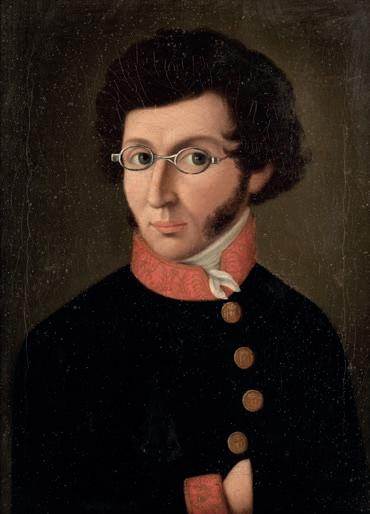
76* Attributed to William Shayer (1787-1879). Cottage scene with children and donkeys, oil on canvas, depicting 2 young peasant girls, the elder with a basket over her arm, the younger proffering some grass to the smaller of 2 donkeys outside a thatched cottage with lattice windows, with a woman watching from the doorway, and washing hanging on a line in the garden, with modern re-lining and restoration, 30.6 x 41 cm (12 1/8 x 16 1/8 ins), gilt moulded frame (45.2 x 55.6 cm)

(1) £200 - £400
78* Continental School. Hurdy-Gurdy player with female companion, mid 19th century, oil on wood panel, depicting a young man with a hurdy-gurdy around his waist, a woman standing with one arm around the man, holding a triangle, 34.4 x 28 cm (13 1/2 x 11 ins), remnants of label to verso ‘Manchester Techni, Ricker? 84, 8 Moult Street’, previous auction stickers to verso, framed (41 x 34.2 cm)

(1) £200 - £300
77* Manner of Théodore Chassèriau (1819-1856). Female nude, oil on board, depicting a young woman holding a draped piece of fabric in front of her naked torso, inscribed in pencil in early hand ‘Chasseriau’ and again in early 20th century hand ‘Th Chasseriau 1819-1856’ to verso, sheet size 33 x 27 cm (13 x 10 5/8 ins), framed (41.5 x 35.5 cm), together with a portrait of a young boy, oil on canvas, laid onto board, depicting a child with blue eyes, blond curly hair and rosy cheeks, paper label with contemporary manuscript inscription ‘C. de Steuben’ (Charles de Steuben 17881856) to verso, sheet size 27 x 19.5 cm (10 5/8 x 7 5/8 ins), framed (33.5 x 26.5 cm)

(2) £300 - £500
79* English School. The Marsh Reed Cutters, mid 19th century, oil on canvas, depicting two labourers, one scything reeds on the edge of a marsh by a river, the other mooring a small rowing boat with a young girl seated in it, possibly East Anglia, indistinct monogram to lower right, 30.7 x 46 cm (12 1/8 x 18 1/8 ins), title in ink to verso of stretcher, no. 68 to upper verso of canvas, framed (39 x 54 cm)
(1) £200 - £300

80* Naive School. A Hereford Bull, mid 19th century, oil on canvas, monogrammed ‘SH?’ to lower right, image flaked and chipped with slight loss, contemporary stretcher, 51 x 77 cm (20 x 30 ins), unframed

81* Dupré (Jules, 1811-1889). French Coastal Scene, 1853, oil on wood panel, coastal landscape in northern France with houses and boats ashore and on the sea, people, signed with initials JD and dated 1853 lower left, 18.5 x 36 cm (7 1/4 x 14 1/8 ins), label to verso ‘L’Atelier, J. Duretz, 3. Rue Macé, Cannes - T.932’, pencil notes to verso of frame ‘TEPPER louis XV tres ajouie’, gilt frame (25 x 42 cm) (1) £200 - £400

82* Levin (Phoebus, 1836-1878). The Countess of Nottingham on her Death Bed Returning Essex’s Ring to Queen Elizabeth I, oil on canvas, signed ‘P. Levin’ lower left, 95 x 88 cm, contemporary label to verso (chipped)

An evocation of the romantic myth of the Earl of Essex given a ring by Elizabeth I as he went off on military campaigns, with the promise if he returned it she would protect him unconditionally. Years later, according to the story, awaiting execution in the Tower of London, Essex threw the ring out of the window to a young lad below, instructing him to take it to his loyal friend Philadelphia, Lady Scrope, but he mistakenly gave it to her sister Katherine, the Countess of Nottingham, instead, who was married to Essex’s nemesis Charles Howard, Lord High Admiral. He made sure the queen never received it. Two years later, the Countess, on her death bed, requested to see Elizabeth and confessed she had concealed the ring from her and asked for forgiveness. The queen in a rage struck Katherine declaring “God may forgive you but I never can”.
Phoebus Levin was a German painter working in London between 1855 and 1878, best-known for his 1864 painting of The Dancing Platform at Cremorne Gardens. (1) £400 - £600
Each lot is subject to a Buyer’s Premium of 20% (Lots marked * 24% inclusive of
(1) £300 - £40083* Willems (Florent, 1823-1905). The Letter, oil on panel, showing a young Flemish woman in 17th century costume resting against a chair, holding a letter, with a spaniel beside her, signed lower left, 30 x 22.5 cm (12 x 8 3/4 ins), gilt moulded frame (45.5 x 36.5 cm)

(1)
£200 - £300
84* Cordier (Henry Charles, 1827-1905). Portrait of a French Nobleman, thought to be King Charles VII, oil on canvas, depicting a man dressed in 16th century attire, standing in front of a cloth drape with fleur de lys pattern, to the side a stained glass window with armorial of Louis II of Anjou, signed lower left ‘H Cordier’, 81.4 x 65.5 cm (32 x 25 3/4 ins)

(1)
£1,000 - £2,000
85* Dutch School. Outward Bound, later 19th century, watercolour on paper, laid onto board, indistinctly signed lower left, sheet size 38.6 x 56.5 cm (15 1/4 x 22 1/4 ins), framed and glazed (63.5 x 80.5 cm)

(1)
£200 - £300
86* English School. Portrait of a horse, 1886, oil on canvas, head and neck portrait of a brown horse, with white star and snip, wearing a leather head collar, ears pricked forward, initialled A.W.M. and dated '86 to upper left, faint dent to back of neck, very slight stretching of the canvas towards lower left corner, 40.8 x 30.6 cm (16 x 12 ins), framed (50 x 40 cm), together with another similar, by the same artist, oil on canvas, head and neck portrait of an unmarked brown horse, with leather head collar and ears pricked forward, initialled A.W.M. and dated '86 lower left, puncture just above initials, 41.2 x 31.2 cm (16 1/4 x 12 1/4 ins), framed (51 x 41 cm), label of F.G. Lawrence & Sons attached to rear

(2) £100 - £200
87* Garaud (Gustave Césaire, 1844-1914). View on the Mediterranean coast, probably Nice, fine oil on canvas, depicting a sunlit bay, with classical portico and stone balustrade to the left, and pink blossom to the right, signed lower left, canvas with ink stamp of Blanchet, Paris, on verso, 24.2 x 37.5 cm (9 1/2 x 14 3/4 ins), attractive period gilt moulded frame (38.8 x 51.8 cm)
(1) £500 - £800

88* Wheeler (John Alfred, 1852-1932). Hunting Scenes, oil on canvas, a set of four, depicting hunting scenes with mounted huntsmen and hounds, two signed ‘A Wheeler’, two relined, 26 x 41 cm (10 1/4 x 16 1/8 ins), framed (35 x 49.5 cm)
John Alfred Wheeler was born at Andoversford, near Cheltenham, and is considered one of the most accomplished animal artists of his day. He enlisted in the 2nd Queens Corps, but his army life was cut short by ill health and in 1842 he was discharged. He married that same year, and turned to painting horses and hunting scenes. By 1854 he was living in Bath. Examples of his work are held by the Victoria Art Gallery, Bath, the National Trust, Somerset Military Museum and the Salford Museum & Art Gallery.
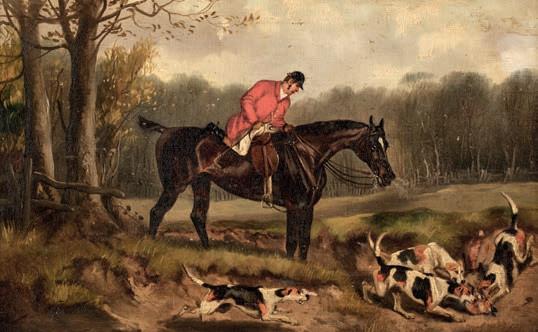


(4) £1,000 - £1,500

89* Richards (John Inigo, 1731-1810). Two Rustic Landscapes, a pair of watercolour and gouache landscapes, one depicting a country view with cows lying and drinking by a river, a castle in the background, the second a riverside landscape with woman holding a jug, and figures outside a cottage, extreme margins with loss from previous mount, partial signature to lower left, slight loss to extreme margins, sheet size 20 x 29 cm (7 7/8 x 11 3/8 ins) and similar (2)


90* Jones (Thomas, 1743-1803). Landscape with farmhouse and trees by a chalk bluff, August 23rd 1771, watercolour on paper, dated August 23 1771 to lower right, 167 x 288 mm (6 5/8 x 11 3/8 ins), mount aperture, framed and glazed, with handwritten labels to verso ‘Thomas Jones Exhib. 1970 Marble Hill - N. M. Wales NO. Lent by Mrs Evan-Thomas’, and ‘From a sketchbook inscribed on the front cover ‘From a book of sketches after nature belonging to Thomas Jones Landscape Painter, No. 1, Harvey Buildings, The Strand. Thomas Jones 1766. On the back cover 1774. Thomas Jones.’, and with a further printed label for the Iveagh Bequest, Kenwood, London, NW3 exhibition of Thomas Jones, Cat. No. 2: Two pages from a Sketch book, 1771. Lent by Mrs Evan-Thomas’

Provenance: Mrs. Evan Thomas; Collection of Sir Lawrence Gowing (1918-1991).
Exhibited: Marble Hill House, London, Thomas Jones (1742-1803), June - August 1970, number 2.
An early, probably Welsh landscape study, and one of a small number of works from Jones’ early years. In his journal, the artist lamented, following his return from Italy, that ‘all the studies I had ever hitherto made either from different Masters or from Nature’ had been damaged beyond recall with just a ‘few sketches and papers... still legible’.Thomas Jones, a Welsh landscape artist, studied under Richard Wilson between 1763 and 1765, and was elected a fellow of the Society of Artists in 1772. Lawrence Gowing’s 1985 Walter Neurath Memorial Lecture The Originality of Thomas Jones was published by Thames and Hudson in 1986.
(1) £1,500 - £2,000
£300 - £50091* Hamilton (Hugh Douglas, circa 1739-1808). Portrait of a Boy, 1772, oval head and shoulders pastel portrait on paper, half-profile to right, of an auburn-haired young boy wearing a black coat with lace-edged white collar, signed and dated lower right, 23 x 18.5 cm (9 x 7 1/4 ins), gilt moulded frame (28.7 x 24 cm)

(1) £300 - £500 Lot
92* Agar (John Samuel, circa 1770-1840). Four Classical Goddesses: Psyche, Rumina, Athena and Themis, 1799, watercolour and pencil on paper, depicting the classical goddesses Rumina (signed and dated), Psyche (signed and dated), Athena and Themis, 119 x 84 mm (4 5/8 x 3 1/4 ins) mount aperture, uniformly mounted in gold leaf frames (31 x 26.5 cm)

(4) £300 - £400
93* Italy. Views of Roman Classical Ruins, circa 1800, four pen & ink drawings with wash, each depicting an architectural ruin and figures, including the Arch of Constantine and the Colosseum, one with small abrasion to upper edge, 15 x 24 cm (5 3/4 x 9 3/8 ins) and slightly smaller, each mounted, matching frames, glazed (largest 31.9 x 38.6 cm)
(4) £300 - £500

94* Roberts (Thomas Sautelle, 1764-1826). View of the Golden Spears, County Wicklow with Powerscourt House, 1802, watercolour on heavy wove paper, depicting the Golden Spears in the distance (the Small and Big Sugar Loaves) and Bray Head beyond, in the foreground, the Chief Secretary, the Right Honourable Charles Abbot, mounted on his horse, inspecting the construction of the military road, greeted by a labourer, holding a shovel in one hand and his hat in the other, two workers digging with pickaxe and wheelbarrow, signed and dated 1802 lower right, with an additional outline sketch in pencil by the artist of a panoramic landscape to verso, some marks and surface damage, particularly to the lower left, closed tear to right hand margin (generally without loss), sheet size 49 x 70 cm (19.5 x 27.5 ins)

The present work is one of Thomas Sautelle Roberts original watercolour views, which he planned to publish as a series of aquatints (coloured and uncoloured), as a series entitled Illustrations of the Chief Cities, Rivers and Picturesque Scenery of the Kingdom of Ireland, a project that was only partially fulfilled. Forty of these large drawings were exhibited at Dublin's old Parliament House, Dublin, in January 1802. According to Freeman's Journal, the paintings were 'principally taken in the County of Wicklow, including the Gold, Copper and Lead Mines' with the 'most interesting views taken from the new military roads and close scenes of the Dargle'. In the Dublin Castle State Paper Office is a letter from the artist, dated 18th December 1801, to the Chief Secretary, the Right Honourable Charles Abbot, requesting permission to exhibit drawings which he had made of the Lord Lieutenant, Philip Yorke (the 3rd Earl of Hardwicke) and the Chief Secretary whilst accompanying them on their Wicklow Excursion.
Following the Irish Rebellion of 1798 the proximity of the Wicklow mountains to Dublin, and their use as a safe retreat for the remnants of the United Irishmen, was of concern to the British administration, and a new military road was proposed to the Lord Lieutenant of Ireland Major Cornwallis in February 1800. Major Cornwallis was replaced in March 1801 by Philip Yorke, 3rd Earl of Hardwicke. Construction of the road began in August 1801 and continued until 1809. A pair of watercolours entitled View of Powerscourt and the Golden Spears and View of The Valley of Glencree, watermarked 1798, unsigned, were sold at Adam's Auctioneers, Dublin, on the 31st May 2017, lot 21, the first of which is taken from the same view point and has a similar overall composition, with Powerscourt House showing in the middle distance.
(1) £2,000 - £3,000
95* Flaxman (John, 1755-1826). Thetis entreating Jupiter to honour Achilles (Homer’s Iliad), circa 1805, pencil on pale cream wove paper, contemporary (or near-contemporary) pencil inscription to upper margin verso: Iliad plate 5 part of, ‘Thetis entreating Jupiter to honor Achilles’, sheet size 200 x 250 mm (7 7/8 x 9 7/8 ins), blank portion to right margin folded over, tipped-onto mounting card, framed and glazed, with handwritten inscription to verso (by Lawrence Gowing), giving the artist’s name and the inscription, as well as provenance: ‘Collections:- Goupil (label), Hodgson Bequest 177’ (label), The Right Hon. Lady Brabourne C. I., Spinx (label), Sir Ronald Campbell KCNG, Robin Campbell. To LG, 1964’
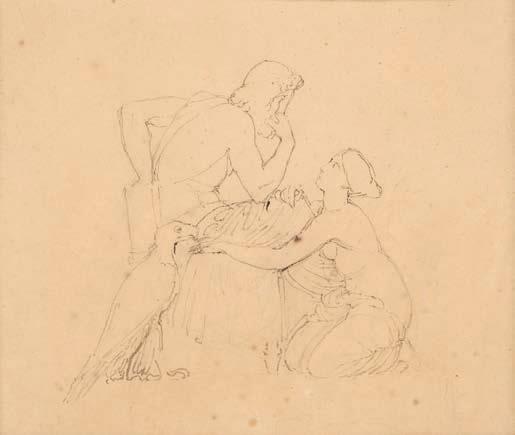
Provenance: James Stewart Hodgson (1827-1899); the Hodgson Bequest, sold Christies, London, June 1893; Laby Brabourne (1896-1979); Sir Ronald Ian Campbell (1890-1983); Robin Campbell, Director, Arts Council of Great Britain (1912-1985); Lawrence Gowing (1918-1991) by 1964.
The original drawing by Flaxman for plate 5 of The Iliad of Homer engraved from the Compositions of John Flaxman, published by Longman Hurst Rees & Orme on March 1st, 1805. The line engraving is one of three compositions engraved by William Blake from Flaxman’s design. Flaxman’s first series of original drawings for the Iliad was commissioned by Georgiana Hare-Maylor, a painter and scholar who was living in Rome at the same time as Flaxman, and were published in Rome in 1793, and in London in 1795. A second set of drawings on the same subject were made by Flaxman for Robert FullatonUdney. The 1805 edition of the work included three new plates engraved by Blake, and two by James Parker (plates 1, 2, 5, 14, and 37 respectively).
(1) £500 - £700
96* Follower of J.M.W. Turner (1775-1851). Bridge in the Middle Distance, sepia watercolour and brown ink on paper, depicting a landscape featuring a bridge over the Thames at Walton on Thames, sheet size 16.8 x 25.7 cm (6 1/2 x 10 1/8 ins), mounted (30 x 38 cm)

(1) £200 - £300
97* Roux (Peter, 1771-1852). Miniature wax relief portraits of Reverend Edward Thorold and Mrs. E. Thorold, 1809-10, a pair of bust-length miniature portraits, the gentleman in profile to the right, wearing coat, waistcoat, frilled chemise, and stock, pink wax in mid relief on black glass, signed under the truncation and dated P. Rouw, Sculptor London 1809, gilt-mounted within dark wood travelling case, diameter 160mm (6 1/4 ins), circular label from original case adhered to verso, with ink manuscript inscription 'The Revd. Edwd. Thorold, Peter Rouw, Sculptor, Modeller of Gems & Cameos to his R.H. the Prince of Wales, 25 Upper Titchfield Street, Fitzroy Square, London, 1810', the lady in profile to the left, wearing a two-string pearl necklace bearing a Maltese cross over a dress with patterned chemisette, her hair informally arranged with a wide hairband, pink wax in mid relief on black glass, signed under the truncation and dated P. Rouw, Sculptor London 1810, gilt-mounted within dark green leather travelling case with convex glass, the leather darkened to the sides, with a small repair to left edge, diameter 143 mm (5 5/8 ins)

Provenance: the current owner purchased the portrait of Mrs. Thorold from Michael Sim of Chislehurst, Kent, on whose website the miniature is described (http://www.michaelsim.com/objets/tassies.html).The website gives in full the wording of the original label, found when the miniature was opened for cleaning. This appears to be almost identical in wording to that described above for the Reverend Thorold, except for identifying the sitting as Mrs E. Thorold. As Reverend Edward Thorold and his wife Mary Wilson were married in June 1809, it seems possible that this pair of miniatures may have been commissioned to celebrate their wedding.
(2) £2,000 - £3,000
98* Harding (George Perfect, 1779/80-1853). Portrait of Edward VI, circa 1825, fine miniature watercolour on card, heightened with bodycolour, a copy after the original painting by Holbein, 190 x 146 mm (7 1/2 x 5 4/5 ins), sheet size 202 x 157 mm, attractive period gilt moulded frame, glazed, with 20th century handwritten label to verso identifying the work and artist
A remarkably fine copy by the miniaturist and copyist George Perfect Harding after the 1553 portrait of King Edward VI, the ‘boy king’, by Hans Holbein, then in the collection of the Earl of Egremont at Petworth. An engraving of this work was published in 1825 by Harding, Lepard and Co. George Perfect Harding exhibited at the Royal Academy between 1802 and 1840, and was a Fellow of the Society of Antiquaries. He travelled extensively copying oil portraits and recording their history, some of which were subsequently engraved for publication. The artist’s notebooks from this period survive and provide a detailed record of the contents of over 250 private collections, including castles, country houses, inns of court, university colleges, livery companies and hospitals.Harding died at Hercules Buildings, Lambeth (where William Blake had also lived), on 23rd December 1853.
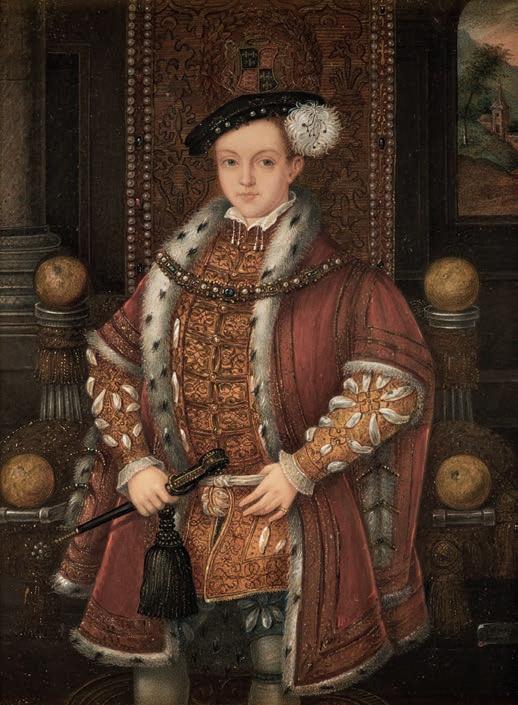
(1) £300 - £500
99* Lory (Gabriel, 1763-1840). Lake Lungern, looking South towards the Brünig Pass, 1826, watercolour and pencil on paper, signed lower centre, bearing the date 1826 to lower edge, spotting (mainly to sky area), tiny worm holes to lower right corner, sheet size 26.5 x 39.3 cm (10 1/2 x 15 1/2 ins), mounted, framed and glazed (42 x 54 cm)


(1) £300 - £500
100* Album. An attractive album of watercolours and drawings, and several prints compiled by Susan M. A. Sheppard, 1824-1830, with ink manuscript inscription at front ‘Susan M. A. Sheppard from her dear friend Miss Leather, Lowestoft Repository, 1827’, containing: 18 watercolours comprising: 7 botanical watercolours; 5 of butterflies; 2 of brightly coloured feathers; 4 more including 2 portraits (one after Rubens) and a grisaille harbour scene, 5 pencil sketches, comprising 4 views and one portrait of a girl playing a drum, one gouache and watercolour portrait of a saint, 3 pen & black ink sketches (1 view, 2 of birds), 1 pen & brown ink view of Bath, plus 2 Baxter prints: Victoria, and the Crucifixion, many mounted onto album leaves, several loosely inserted, many signed or initialled and dated, front free endpaper and attached first leaf (with mounted watercolour) detached, all edges gilt, original maroon morocco gilt, rubbed, front cover stained around edges, and with mounted watercolour scene of two ladies in a garden (slightly marked), 4to
(1)
£200 - £300
Lot 99101* Chambers (George, 1803-1840). Shipping off the coast, Whitby, watercolour on paper laid onto card, sheet size 13.7 x 18.9 cm (5 3/8 x 7 3/8 ins), photocopy of an early inscription by the artist’s son pasted to verso ‘Original watercolour by my late father George Chambers of Whitby G Chambers 1870 London’, framed and glazed (34 x 37 cm), together with Schiedam Harbour, pencil, ink and wash, initialled GC lower left, sheet size 14 x 23.4 cm (5 1/2 x 9 1/4 ins), artist’s name and title in modern ink to verso of frame, framed and glazed (35.5 x 43.5 cm), plus After Clarkson Stanfield (1793-1867). Verona, pencil on laid paper, watermark of a Strasbourg lily with hunting horn, initials J & EG underneath, titled, inscribed Clarkson Stanfield in an early hand, initialled GHJ and dated 1832 lower right, Sotheby's auction ticket on verso dated '21.5.99 Lot 260', sheet size 26.4 x 41 cm (10 3/8 x 16 1/8 ins), framed and glazed (44 x 52 cm), and a pencil view of Norwich from Mousehole Heath, 1920, by Gerald Ackermann (1876-1960), framed and glazed

(4) £200 - £300
102* Colonial School. Picnickers by the shore of a bay with sailing ships, circa 1830’s, watercolour with pencil on paper, laid down on paper, depicting a group of six gentlemen and six ladies engaged in a picnic on a beach, a further gentleman astride the branch of a tree above the group, sailing vessels flying a red ensign in the distance, three faint creases (one vertical and two horizontal), a few small holes repaired and retouched, some light fox spots, 42 x 62 cm (16 1/2 x 24 1/2 ins), mounted, framed and glazed (55.5 x 76.4 cm)
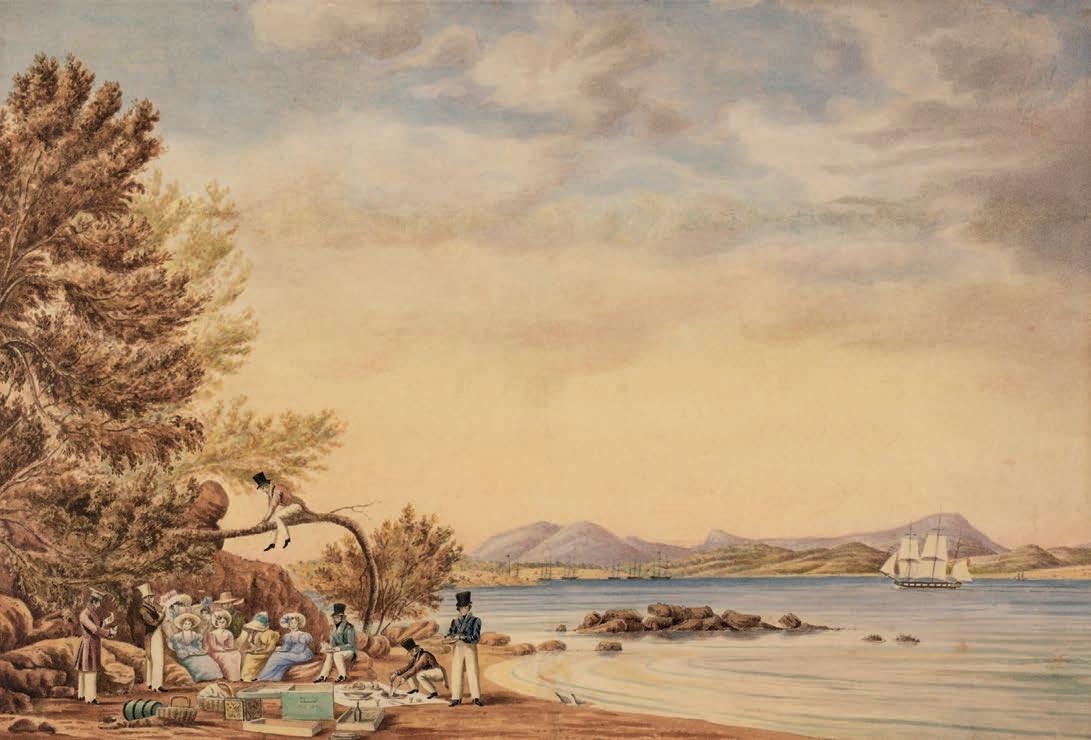
A charming tableaux of early 19th century colonial tourists, their picnic - with baskets, tablecloth, cutlery, wine bottles and tea chests - set out in typically British fashion, the ladies clad in gowns and sun bonnets, the gentlemen in top hat and tails.
(1) £400 - £600
103* Follower of David Cox (1783-1859). Landscape with boy and a fishing rod by a Sluice gate, watercolour on paper, laid onto later card, artist's name in pencil to verso of backing card, some overall toning, sheet size 14 x 22.7 cm (5 1/2 x 9 ins), C.E. Clifford Artists' Colourman label to verso, framed and glazed (37 x 44.7 cm), together with three others including: Riverscape by George Cooper, Brick Works by Rowshan Zara and Seascape by J.J Slater

(4) £200 - £300
104* Nice. View of the Vieux Port, Nice, by P. Merle, 1834, pencil and watercolour wash, within a black ink single line border, depicting the old harbour at Nice, with the Colline du Château, inscribed in pencil below border with the artist’s signature to left side and title and date ‘Nice. 1834’ to right side, lightly toned, aperture size 20.7 x 32 cm (8 1/4 x 12 5/8 ins), mounted, framed and glazed (38.5 x 49.7 cm)

(1) £200 - £300
105* Beyerhaus (Edwin, 19th Century). Portrait of a young woman in silk dress, circa 1840, pencil and chalk, with charcoal, heightened with white, on brown linen backed card, depicting a young girl sitting resting her head on one hand, the other hand holding a book to her chest, signed in pencil lower left, some small spots to margins, sheet size 49.3 x 39 cm (19 3/8 x 15 3/8 ins), framed and glazed (54 x 43.5 cm)

(1) £200 - £300
106* Buckler (John Chessell, 1793-1894). Album of 19 watercolours of Tutbury Church and Castle, Staffordshire, 1812, together 19 watercolour views and studies on wove paper (seven watermarked J. Whatman 1810), comprising a study of the South entrance of Tutbury Church incorporating a general title for the collection, a view of the Bridge at Tutbury showing the church and castle, 12 views of the exterior and interior of the church, ground plan of the church, and four of the castle, each signed and dated lower right, few with light dust-soiling and spotting to margins, sheet size 54.3 x 39.8 cm, contained together within contemporary paper wrapper, bearing manuscript title 'Staffordshire. 19 Drawings by John Buckler F.S.A. 1812 of the Antiquities of Tutbury, for John Townley of Townley, Lancashire at the cost of 33 guineas' followed by a manuscript list of views included
(1) £1,000 - £1,500
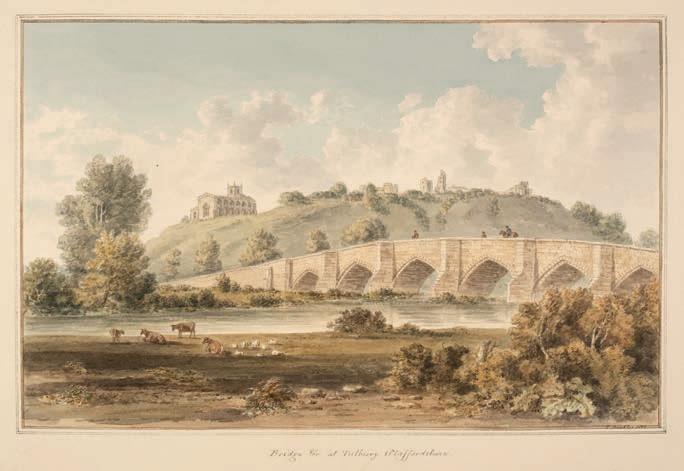



107* After Arthur d’Orsay (1801-1852). Duke of Wellington, oil on wood panel, depicting the Duke of Wellington standing by a small table, his right hand resting on top, 24.5 x 18 cm (9 5/8 x 7 1/8 ins), Henry Graves & Co. label, Christie’s stencil and previous red wax ownership seal to verso, framed (39 x 32 cm), together with another portrait of Arthur Wellesley, 1st Duke of Wellington, by an unknown artist, circa 1870, oil on panel, mount aperture 25 x 19cm (9 7/8 x 7 1/2 ins), framed and glazed (43.5 x 36 cm) NPG 405.

A larger version of the same painting by D’Orsay, dated 1845, is held by the National Portrait Gallery.
(2) £300 - £500
108* Continental School. Fetes Champetres, mid 19th century, intaglio process on ivory, the engraved lines filled in with black ink, each depicting figures in a bucolic setting, the first showing 17th century musicians, including a flautist and a lute player, a lady seated between them with a musical score on her lap, a dog looking on, and a table with food to the right, inscribed in ink in an early hand on verso ‘“Le Concert Noblesse”’, the second showing an 18th century pastoral scene, with central figure holding a carafe in one hand, and raising a drinking vessel aloft in the other, whilst serenaded by two seated violinists to the left, two seated ladies conversing on the right, each approximately 9.5 x 12cm (3.5 x 4 6/8ins)

A pair of finely executed decorative plaques, perhaps originally set into furniture.
(2) £100 - £200
109* English School. Portrait of Maria Boyes, early 19th century, sepia watercolour with pencil on paper, three quarter length portrait of a young woman sitting, in profile to the left, visible area 29.2 x 24 cm (11 1/2 x 9 1/2 ins), deep gilt frame and glazed (46.5 x 41.5 cm), verso with early ink manuscript inscription: The likeness of Maria Isabella Boyes, She died at Bath October the 6th 1819 and was buried at Nafferton, together with a folder containing research notes regarding Maria Isabella Boyes and her family

Maria Isabella Boyes, daughter of John and Isabella (known as Bell) Boyes, was born at Scarborough 2nd March 1800. In 1819 she was visiting Bath on her way down to Devonshire 'for the recovery of her health' but sadly died while still in Bath. A tragic loss for her parents who had already lost their only other child, a son John Benjamin who had died aged 4 years and 4 months. Maria is buried in the family vault in Nafferton Church, near Driffield in the East Riding of Yorkshire.
(2) £300 - £500
110* English School. Captain William Henry Parry, 33rd (The Duke of Wellington’s) Regiment of Foot, 1855, coloured chalks on paper, a fine portrait of Captain Parry in full dress uniform with Crimea medals and sword, indistinctly signed, and dated London 1855 lower right, 61 x 48.5 cm (24 x 19 ins) mount aperture, ebonised and gold frame, glazed (frame size 81 x 68 cm)
William Henry Parry was commissioned Captain with the 33rd Foot on 19 January 1855. This portrait would have been painted in honour of his recent promotion.
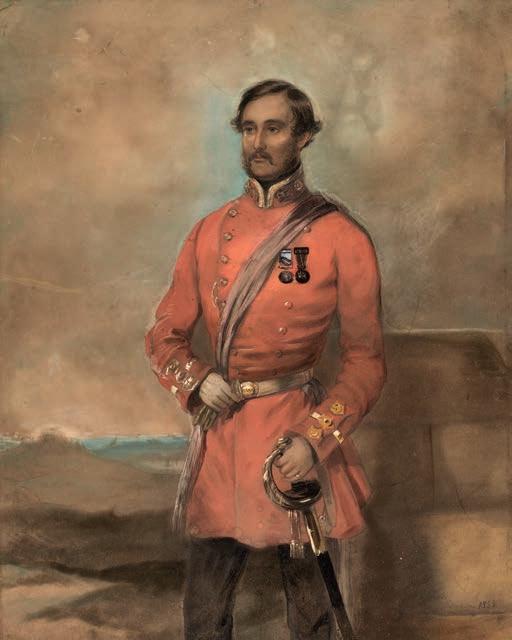
(1) £400 - £600
111* Style of Samuel Shute (1803-1836) & Ruth Shute (1803-1882).
Portrait of a child and a dog, circa 186[?], watercolour and pencil on card, full-length portrait of a child wearing a brown dress and laced black boots, holding a small driving whip in the right hand and a flowering rose stem in the left hand, standing beside a small black dog, with trees and a barn in the background, lightly rubbed and toned, with artist's pencilled notes on verso (including partial date), 23.5 x 20 cm (9 3/8 x 7 7/8 ins), burr maple frame (31.3 x 27.7 cm)
(1) £100 - £200

112* Harnisch (Albert E., 1843–after 1913). Falstaff and his Page, 1872, pen & ink with pencil and wash on laid paper, signed ‘A. E. Harnisch Rome 1872’ to lower right, tipped onto brown card with blind stamp at foot ‘Bristol LM Teinte Julien’, pale spotting, a little discolouration to right edge, sheet size 31 x 25.5cm (12.25 x 10ins), window mounted, backboard verso with title, date and artist on printed adhesive label

Albert E. Harnisch was an American sculptor, probably the son of lithographer and painter Carl Harnisch, a German immigrant. Albert trained at the Pennsylvania Academy of the Fine Arts before moving to Rome in 1869, where he studied and worked for many years.
(1)
£150 - £200
113* Attributed to Henry George Alexander Holiday (1839-1927). Joseph visited by the Angel, 1880, pen, ink, and watercolour on paper, unsigned, laid down on modern backing card, 204 x 201 mm (8 x 8 ins), framed and glazed

The scene is taken from Matthew, Chapter I, verses 18-25, in which an angel appears to Joseph telling him ‘do not be afraid to take Mary home as your wife because what is conceived in her is from the Holy Spirit’.
(1)
£200 - £300
114* Manner of Winslow Homer (1836 -1910), Barge, circa 1880's, gouache with traces of pencil on wove paper, unsigned, sheet size 113 x 165 mm (4 3/8 x 6 1/2 ins), framed and glazed (18 x 23 cm)

(1) £200 - £300
115* Rowbotham (Charles, 1826-1904). Near Arnheim on the Leek, Holland, 1889, watercolour, depicting a riverscape with figures on the riverbank, signed and dated lower left in brown ink, mount aperture 12 x 24.5 cm (4 3/4 x 9 5/8 ins), framed and glazed (29.5 x 41.5 cm)

(1) £100 - £200
Each lot is subject to a Buyer’s Premium of 20% (Lots marked * 24% inclusive of VAT @ 20%)
Lot 113 Lot 114116* Langley (William, 1852-1922). Old Newlyn Quay, watercolour, depicting a view over Newlyn Quay, a fisherman attending to his boat while the tide is out, signed lower right, mount aperture 12 x 16.5 cm (4 3/4 x 6 1/2 ins), framed and glazed (40.5 x 45 cm)
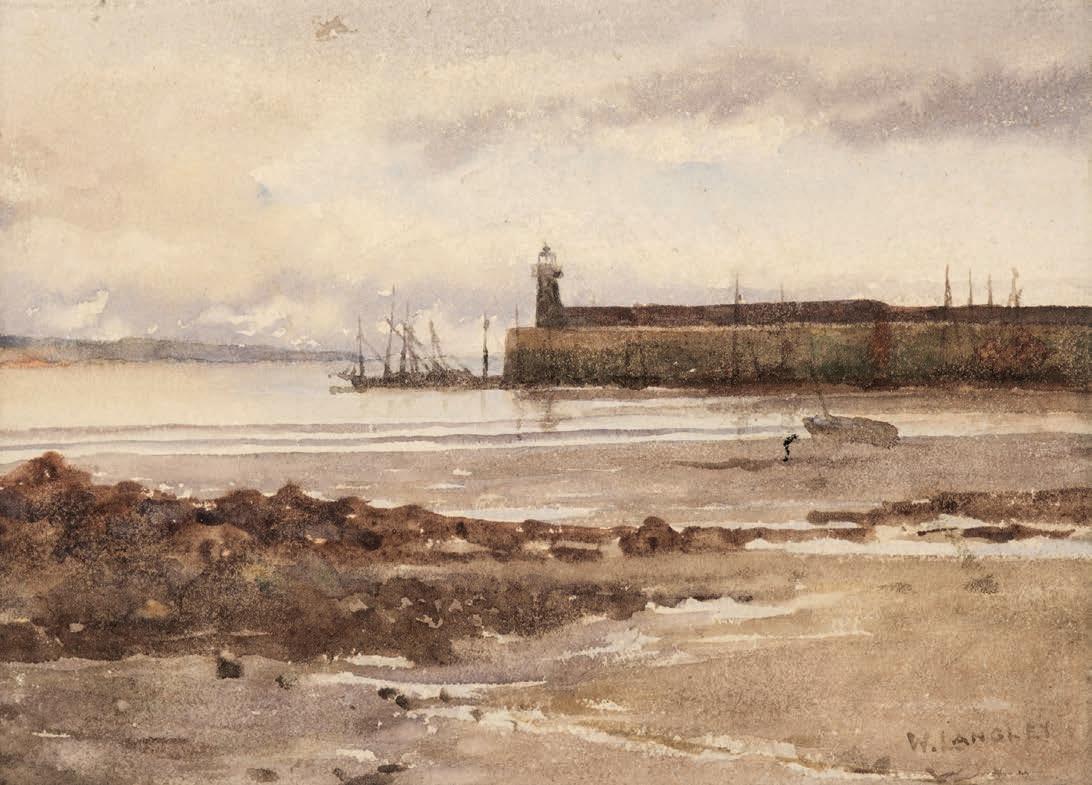
Provenance: Private Collection, Cumbria. Purchased by the father of the current owner from The Valentyne Dawes Gallery, Shropshire on 28th October 2000. Invoice is included in the lot.
(1)
£1,500 - £2,000
117* Varley (John, 1850-1933). Japanese Temple, 1890, watercolour, signed and dated lower left, depicting a Japanese entrance to a temple, two figures dressed in kimonos, one holding an umbrella walking through the entrance, mountains visible in the background, mount aperture 25.5 x 35 cm (10 x 13 3/4 ins), previous auction stencil to verso, framed and glazed (47 x 56.5 cm)

(1) £200 - £300
Lot 117
118* Varley (John, 1850-1933). Street Scene in Japan, 1890, watercolour, signed and dated lower left, depicting a busy street scene with figures using carrying poles and pulling carts, mount aperture 25.5 x 35 cm (10 x 13 3/4 ins), previous auction stencil to verso, framed and glazed (47 x 56.5 cm)

(1) £200 - £300
119* Varley (John, 1850-1933). View from Dolelly Road, North Wales, watercolour, signed lower left, depicting a view of the mountains from the Dolelly road, two figures walking along, mount aperture 25.5 x 37cm (10 x 14 1/2 ins), framed and glazed (44 x 55 cm)

(1) £150 - £200
120* Canella (Antonio, 1849-1922). Portrait of an Artist at his Easel, fine miniature watercolour on paper, signed lower right, mount aperture 111 x 81 mm (4 3/8 x 3 1/4 ins), moulded gilt frame and glazed (30.5 x 28 cm)

(1) £150 - £200
121* Smith (Arthur Reginald, 1871-1934). Ponte Santa Trinità, Florence, watercolour, a view towards Florence from the Arno, with figures on the stone bridge, signed lower right, 36 x 18 cm (14 1/4 x 7 1/8 ins), mounted, framed and glazed (58.5 x 38.4 cm)
(1) £150 - £200
 Lot 120
Lot 120
(2) £300 - £500
in the Summer, 1907,
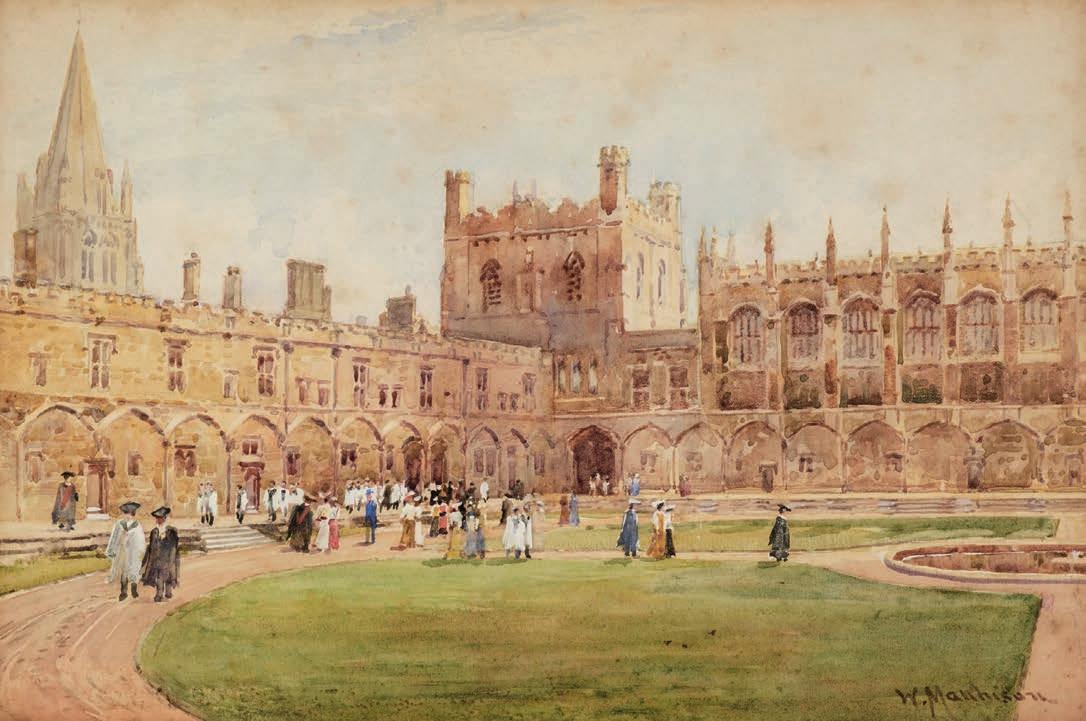

123*
laid onto card, depicting a riverscape one female figure standing on the river side the other sitting in a boat, signed lower right and dated ‘1907’, some overall toning, sheet size 11 x 23.2 cm (4 3/8 x 9 1/8 ins), framed and glazed (20 x 31.4 cm), together with Cook (Herbert Moxon, 1844-1928/9). Landscape, watercolour, depicting two figures walking along a lake edge, sailboats and mountains in the distance, signed lower left, mount aperture 13.2 x 18 cm (5 1/4 x 7 ins), framed and glazed (30 x 35 cm), plus Jones (Fred C., early 20th century). Richmond, Yorkshire, 1916 and 1945, pencil and watercolour, signed and dated lower right, mount aperture 14.8 x 22 cm (5 3/4 x 8 5/8 ins), framed and glazed (37 x 39 cm)
(3) £150 - £200
 122* Williams (Warren, 1863-1918). Welsh Coastal Scene, watercolour, signed lower left, mount aperture 33 x 57.5 cm (13 x 22 5/8 ins), framed and glazed, together with Penmenmawr from Deganwy, watercolour, signed lower right, mount aperture 33 x 57.5 cm (13 x 22 5/8 ins), framed and glazed (53 x 78 cm)
Lloyd (Thomas James, 1849-1910). Boating
watercolour,
122* Williams (Warren, 1863-1918). Welsh Coastal Scene, watercolour, signed lower left, mount aperture 33 x 57.5 cm (13 x 22 5/8 ins), framed and glazed, together with Penmenmawr from Deganwy, watercolour, signed lower right, mount aperture 33 x 57.5 cm (13 x 22 5/8 ins), framed and glazed (53 x 78 cm)
Lloyd (Thomas James, 1849-1910). Boating
watercolour,
125* Netherlandish School. St. Peter in Penitence, late 16th or early 17th century, cast and chased bronze rectangular plaque, Saint Peter in prayer, the cockerel on a column behind him in the background, with suspension loop, 102 x 71 mm (3 7/8 x 2 3/4 ins) not including the loop

Warren, Medieval and Renaissance Sculpture in the Ashmolean Museum: Plaquettes (Oxford: Ashmolean Museum Publications, 2014), pp. 1046 –1048, no. 506; Weber 1043, as Spanish; Molinari 411A.
(1) £300 - £500
126* Flaxman (John, 1755-1826). A group of 7 plaster bas-reliefs from originals by John Flaxman, 20th century, copies of plastersketch models for ‘Come thou blessed 1797-98. First monument to Agnes Cromwell in Chichester Cathedral’, 52 x 26 cm (20 1/2 x 10 1/4 ins); ‘Come thou blessed 1797-98. Plaster model for Cromwell monument’, 34 x 27 cm (13 1/2 x 10 1/2 ins); ‘Defeat of Rebel Angels’, 34 x 47 cm (13 1/2 x 18 1/2 ins); ‘Two Gentlemen with Clasped Hands. Study for Monument V’, resin, 35 x 15 cm (13 3/4 x 6 ins); ‘Thy Will Be Done: Sketch for a monument to Thomas Brand at Wath, Yorkshire, 1815-16’, 31 x 23 cm (12 x 9 ins); An Evangelist, 36 x 14 cm (14 1/4 x 5 1/2 ins); sketch for a monument, semi-circular, 24 x 42 cm (9 1/2 cx 16 1/2 ins)
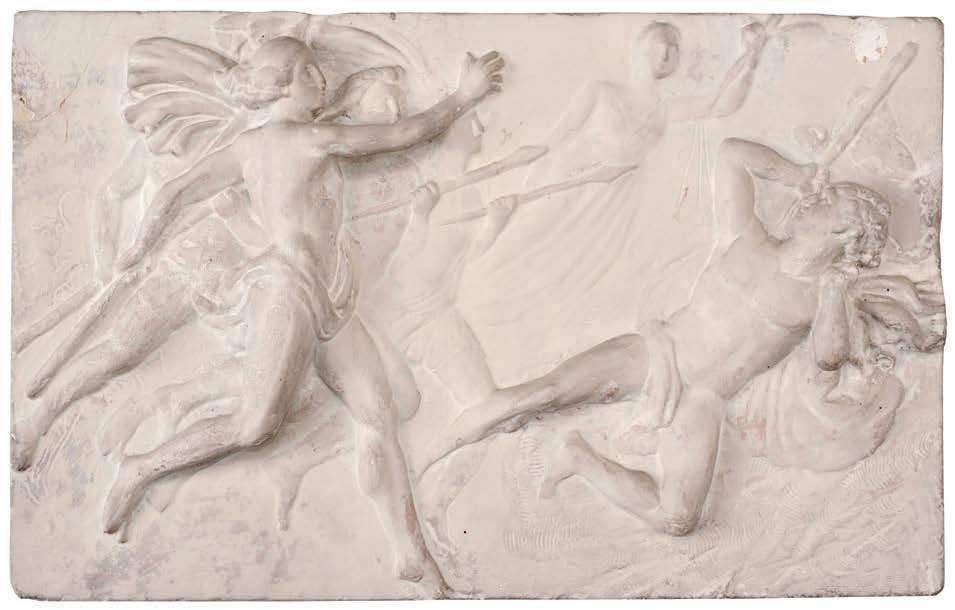
Provenance: Collection of Sir Lawrence Gowing (1918-1991).
Flaxman kept his clay originals of these sketch-models in their hundreds round the walls of his studio and these are now chiefly held in the collection of University College, London. It is likely these plaster copies were made between 1975 and 1985, the period when Gowing served there as Principal of the Slade School of Fine Art.
(7) £300 - £500
127* Crome (John, 1768-1821). Road by Park Palings, etching and drypoint on chine collé, second state (of 2), signed in pencil lower right, inscribed in pencil in later hand by ‘Road by Park Palings
Theobald no 19, only state, early impression’, plate size 105 x 175 mm (4 1/8 x 6 7/8 ins), sheet size 185 x 269 mm (7 1/4 x 10 1/2 ins), old frame, framed and glazed
Provenance: Collection of Sir Lawrence Gowing (1918-1991).
Theobald 19 (only state); Clifford E19 ii/ii; Goldberg 230 ii/ii. Unpublished in his lifetime, this early etching by Crome was later issued in the portfolio titled Norfolk Picturesque Scenery, consisting of 30-1 Etchings by the late John Crome, founder of the Norwich Society of Artists, and printed from the plates as left by himself, in 1834.
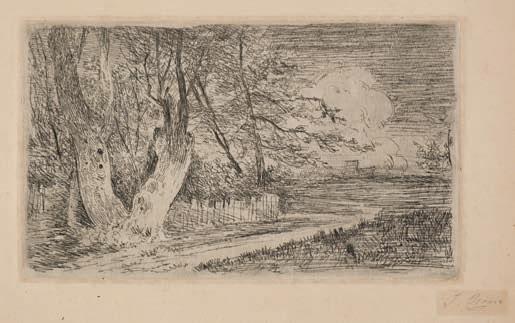
(1)
£150 - £200
128* Géricault (Théodore, 1791-1824). Cheval devoré par un Lion, 1823, crayon lithograph, a fine impression of the rare second state (of four), before the removal of Villain’s address, on wove paper, with margins, image size 19.4 x 23.8 cm (7 5/8 x 9 3/8 ins), together with Cheval que l’on promène avant la course and La Course (from Suite de Huites Petits Pièces), 1823, crayon lithographs on wove paper, both printed on one sheet, from the album published by Gihaut Frères, Paris, sheet size 55.1 x 40 cm (21 1/2 x 15 3/4 ins)

Literature: Delteil 67, 56, 56.
(2) £300 - £500
129* Meryon (Charles, 1821-1868). Tourelle, Rue de la Tixeranderie, 1852, etching and drypoint, the fourth state (of five), published in 1861 in an edition of 30 impressions, plate size 245 x 129 mm (9 5/8 x 5 ins), framed and glazed (52.5 x 42.3 cm)
Provenance: Purchased from Garton & Cooke in April 1987;thence by family descent.
Schneiderman 24, iv/v; Delteil/Wright 29 iv/v.
The house stood at the corner of the rue de Coq, demolished in 1851, and is now part of the extended rue de Rivoli in Paris. Meryon sought to capture the architecture and spirit of an ancient Paris that was soon to be lost due to Baron Haussmann’s modernisation programme.
(1) £300 - £500

Lot 131
130* Meryon (Charles, 1821-1868). Saint Etienne-du-Mont, Paris, 1852, etching and drypoint on laid paper, the 8th (final) state, published in an edition of 30 impressions, plate size 24.4 x 13 cm (9 5/8 x 5 1/8 ins), with margins, framed and glazed (52.5 x 42.3 cm) Schneiderman 25, viii/viii. Wright 25, viii / viii.

(1) £300 - £500
131* Haden (Seymour, 1818-1910). Kensington Gardens II (Large Plate), 1859, etching with drypoint, printing with selectively wiped plate tone, signed in pencil to lower margin, image size 19.7 x 12.5 cm (7 3/4 x 4 7/8 ins), sheet size 23.5 x 15.6 cm (9 1/4 x 6 1/8 ins), framed and glazed (42.3 x 32.4 cm), together with Out of Study Window, etching, depicting a view of a city emerging from behind trees and bushes, image size 10.5 x 25.6 cm (4 1/8 x 10 1/8 ins), framed and glazed (32 x 42.5 cm)

Schneiderman 31.
Provenance: Out of Study Window was purchased in April 1987 from Garton & Cooke, thence by descent through the family.
(2) £300 - £500
132* Manet (Edouard, 1832–1883). Le chanteur espagnol, ou Le guitarero (The Spanish Singer, or The Guitarist), 1861, etching on heavy laid paper, the 5th state (of 7), mount-stained, plate size 298 cm x 244 mm, sheet size 445 x 358 mm, hinge-mounted, framed and glazed

Provenance: Sir Lawrence Gowing (1918-1991). Harris 12; McKean Fisher 11; Guérin 16.
(1) £700 - £1,000
133* Manet (Edouard, 1832-1883). The Gypsies (Les Gitanos), 1862, etching on pale cream laid paper, from the Strolin edition of 100 copies published in 1905, plate size 315 x 236 mm (12 3/8 x 9 1/4 ins), with margins, framed and glazed, with printed stock label to verso Guerin 21. Harris 18.
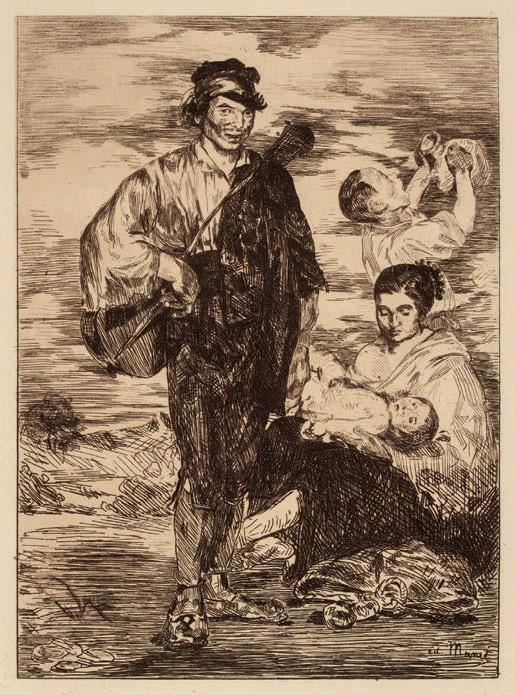

Published in Manet’s Trente Eaux-fortes Originales, Paris, 1905, edited by Théodore Duret, and issued in an edition of 100 copies only.
(1) £700 - £1,000
134* Meryon (Charles, 1821-1868). Rue des Chantres, 1862, etching and drypoint, the 5th state (of 6), printed in an edition of 100 impressions, printed by Pierron and published by Rochoux, image size 27.9 x 11.9 cm (10 7/8 x 4 5/8 ins), framed and glazed (52.5 x 42.3 cm)

Provenance: Purchased from Garton & Cooke in April 1988 thence by family descent. Schneiderman 85.v/vi.
(1) £400 - £600
135* Holman Hunt (William, 1827-1910). A Day in the Country, 1865, etching, a proof, reworked by the artist with ink and pencil, inscribed in pencil to lower margin ‘5th Biting after...? touched upon with ink and pencil’, plate size 185 x 216 mm, with top margin trimmed to plate mark, and other margins short, framed and glazed
(1) £200 - £300
Lot 134136* Haden (Seymour, 1818-1910). A Castle, County Wicklow, 1865, etching with drypoint, depicting extensive vegetation in the foreground, a castle visible in the distance, signed in pencil to lower margin, image size 10.2 x 13.7 cm (4 1/8 x 5 3/8 ins), framed and glazed (32.5 x 42.3 cm), together with Egham Lock, 1859, etching, signed in pencil to lower margin, image size 14.9 x 22.5 cm (5 7/8 x 8 7/8 ins), framed and glazed (32 x 42.5 cm), plus Amalfi, 1858, etching, Schneidermann’s third state (of three), unsigned, image size 11.6 x 7.8 cm (4 1/2 x 3 1/8 ins), framed and glazed (42.5 x 32 cm)
Kensington Gardens II (Large Plate), 1859, etching with drypoint, printing with selectively wiped plate tone, signed in pencil to lower margin, image size 19.7 x 12.5 cm (7 3/4 x 4 7/8 ins), sheet size 23.5 x 15.6 cm (9 1/4 x 6 1/8 ins), framed and glazed (42.3 x 32.4 cm), together with
Out of Study Window, etching, depicting a view of a city emerging from behind trees and bushes, image size 10.5 x 25.6 cm (4 1/8 x 10 1/8 ins), framed and glazed (32 x 42.5 cm)
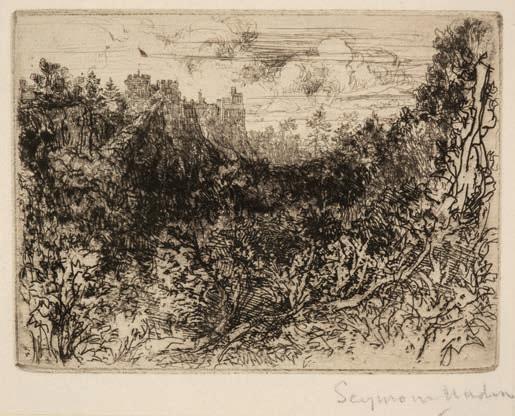
Provenance: Egham Lock purchased from Garton & Cooke in April 1987; thence by descent.
(3) £200 - £300
137* Manet (Edouard, 1832–1883). Charles Baudelaire de Face III (Portrait of Charles Baudelaire, Full Face), 1868, etching on thin laid paper, the 4th and final state, with printed inscription to lower margin of the image ‘Peint et Gravé par Manet 1865’ and ‘Imp. A. Salmon’, plate size 94 x 82 mm (3 7/8 x 3 1/4 ins),sheet size 197 x 149 mm (7 3/4 x 5 7/8 ins), hinge-mounted, framed and glazed Provenance: Collection of Sir Lawrence Gowing (1918-1991). Moreau-Nélaton 16; Guérin 38; Harris 61.
Final published state of Manet’s portrait of Baudelaire, after a photograph by Nadar.
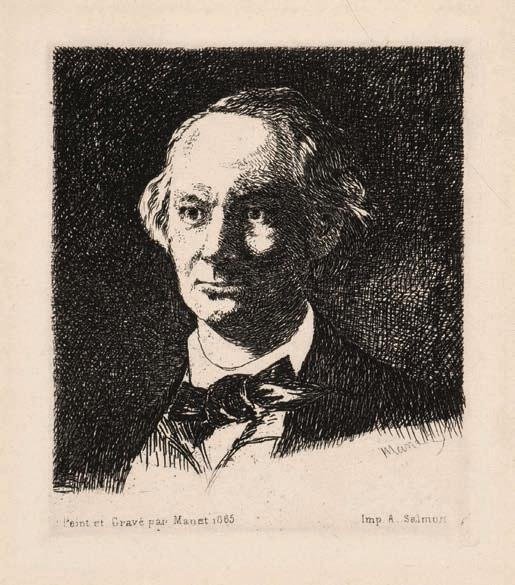
(1) £300 - £500
138* Lançon (Auguste, 1836-1887). Les Trappistes, Paris: A. Quantin, 1883, 10 aquatint etchings, depicting scenes from the daily life of Trappist monks, some spotting (mainly affecting margins), sheet size approximately 45 x 31.5 cm (17 3/4 x 11 3/8 ins), 8 with their numbered captioned tissue guards (spotted with some tears and edge chips), loosely contained in original titled paper portfolio, limited edition (128/250 copies)
(1) £100 - £150
139* Dicksee (Frank, 1853-1928). A Love Story, 1884, etching on wove paper by Adolphe Lalauze after Frank Dicksee, published by Thomas Agnew & Sons, July 1st 1884, a proof signed by both the engraver and artist, with Printseller’s Association blindstamp to lower left corner, image size 32.5 x 47 cm (12.75 x 18.5 ins), sheet size 45 x 63.5 cm (17.7 x 25 ins), laid down on card, old frame, glazed, with early handwritten label to verso ‘A Love Story Royal Academy 1883 Painted by Frank Dicksee’, framed and glazed (1) £100 - £150

140* Sisley (Alfred, 1839-1899). Bords du Loing, La Charrette, 1890, etching, a very good, delicate impression, without letters (an edition with letters was published by La Gazette des Beaux Arts), plate size 14.5 x 23 cm (5 3/4 x 9 ins), sheet size 18.8 x 27.8 cm (7 3/8 x 11 ins) Delteil 1.

(1) £100 - £150
141* Whistler (James Abbott McNeill, 1834-1903). Stéphane Mallarmé, 1892, transfer lithograph on greyish ivory chine collé on pale cream wove paper, tab-mounted to backing card, signed in the plate lower right, printer’s blindstamp of H. Belfond to lower left blank margin, sheet size 117 x 75 mm (4 1/2 x 3 ins), framed and glazed, together with The Doctor, 1895, lithograph on off-white glossy wove paper, published in an edition of about 3,000 in The Pageant, November, 1896, pale mount-stain, sheet size 253 x 186 mm (10 x 7 3/8 ins), window-mounted Spink, Stratis & Tedeschi (online), 60 and 110.

(2) £200 - £400
142* Whistler (James Abbott MacNeill, 1834-1903). The Doctor, 1894, lithograph on cream paper, two abrasions to outer corners recto (where previously mounted), sheet size 23.5 x 17.8 cm (9.25 x 7 ins), together with My Brother the Doctor [from The Pageant, 1896], lithograph, sheet size 25.2 x 18.8 cm (10 x 7.5 ins), plus three other lithographs by Whistler from The Studio (Savoy Pigeons, The Louvre & The Smith’s Yard), each with blindstamp, some marks and light surface soiling, plus one further Whistler lithograph on cream laid paper of a continental facade (from Quarto no. 2, 1896), and other etchings and lithographs, various, including a signed landscape etching by George Goodall, unsigned etchings by Fred Burridge, and D. Y. Cameron, two lithographs from The Studio by R. Goff and C. E. Holmes, etc.
(12) £150 - £200
143* Vuillard (Edouard, 1868-1940). Jeux d’Enfants, 1897, lithograph in colour on chine, from the edition of 100 published by Ambroise Vollard, Paris, in L’Album d’estampes originales de la Galerie Vollard, signed in pencil lower right, pale mount stain, one or two short closed tears to outer blank margins, extreme upper right corner with small loss, sheet size 42.5 x 57.5 cm, old wood frame, glazed with label to verso for the Arts Council of Great Britain exhibtion of Bonnard and Vuillard at Edinburgh, 1945, catalogue number 143 Roger-Marx 29.

(1) £2,000 - £2,500
144* Zorn (Anders, 1860-1920). King Oscar II (second plate), 1898, etching on Van Gelder Zonen laid paper, with partial watermark, the second state (of 2), signed in pencil, mount stain, plate size 244 x 177 mm (9 5/8 x 7 ins), sheet size 320 x 252 mm (12 5/8 x 10 ins), hinge-mounted Delteil 130; Asplund 132 ii/ii.

(1) £300 - £500
Each lot is subject to a Buyer’s Premium of 20% (Lots marked * 24% inclusive of VAT @ 20%)
145* Hoytema (Theodoor van, 1863-1917). Five Angora Rabbits, lithograph, signed in pencil to lower margin, image size 41.5 x 32.5 cm (16 3/8 x 12 3/4 ins), framed and glazed (83 x 62.5 cm)

Provenance: Purchased from Garton & Cooke in April 1988, thence by family descent.
(1) £200 - £300
146* Persian Miniatures. Battle Scenes (possibly from the Shahnameh (Book of Kings) of Ferdowsi, Persia, 18/19th century, gouache on laid paper, depicting three different battle scenes including: one with two mounted warriors looking down on a decapitated soldier, with two other soldiers behind a hill gazing down on the scene, another with a group of mounted and unmounted soldiers looking on as one slits the throat of an enemy, the helmets suggesting a Shiraz style of painting, some losses to gold painted areas, some tears and frayed edges, light stains, all approximately 28.5 x 19.5 cm (11 1/4 x 7 6/8 ins)
(3)
£300 - £500
147* Persian miniatures. Scenes from the Divan of Hafez or the Khamseh of Nizami, probably late 18th century, four watercolour and gouache persian miniatures on paper, heightened in gold, nasta’liq script at head of one and to verso of each, the largest 21.5 x 14 cm, framed and glazed
The miniatures most likely depict scenes from the Divan of Hafez and the Khamseh of Nizami, though the individual events have not been identified.


(4)
£300 - £500
148* Rajasthan School. Erotic Scenes, Rajasthan, 19th century, four erotic miniatures, watercolours on card, one depicting a woman astride a dark lover, enclosed by gold-speckled bolsters on ochre and blue background; the other showing the pink-fleshed lover standing with a woman perched on a stool, with gold-flecked bolster on bold orange and yellow background, the jewelled armbands, necklaces and earrings showing boldly against the naked bodies, and the final identical pair depicting a threesome of a dark lover and two women, well drawn features, margins a little rubbed and chipped, largest image approx. 25.5 x 16 cm (10 x 6 1/4 ins)

(4)
£300 - £500
149* Mughal School. Portrait miniature of Shahabuddin Baig Muhammad Khan Shah Jahan (1592-1666), 19th century, opaque pigments on an oval ivory panel, 6.5 x 5 cm, tooled leather easel frame, frame size 15 x 12 cm

Shah Jahan, the fifth Mughal Emperor of India and ruled from 1628 to 1658. Born Prince Khurram, he is remembered as a patron of Mughal architecture and is known for the legacy of architectural structures constructed during his reign. The most famous being the Taj Mahal, which he built in memory of his favourite wife Empress Mumtaz Mahal.
(1) £200 - £300
150* Japanese School. Mountainous Landscape, circa 1900, watercolour on silk, in 4 sections, forming one continous image, mounted on 4 patterned silk and paper scrolls, inscription in Japanese to upper left of image, with 2 printed red seals, wooden baton to each lower edge, hanger to each top edge, each verso with small title label at top of scroll, overall image size 76.6 x 77.6 cm (30 1/8 x 30 1/2 ins)
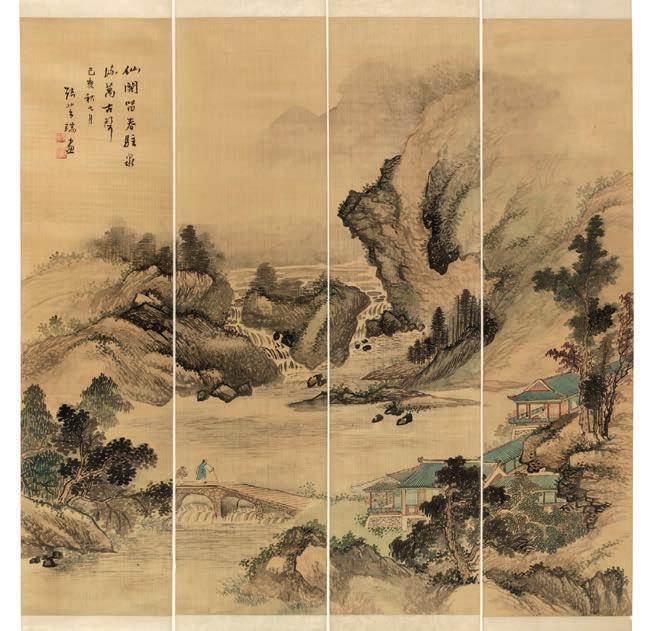

(4) £200 - £300
151* Japanese School. View of Mount Fuji in the distance, circa 1910-20, black and grey ink on paper heightened with gold lacquer, signed 'Hogetsu', with seal marks, small stain near left edge, sheet size 50.2 x 24.9 cm (19 3/4 x 9 3/4 ins), laid on thin board, framed and glazed (58.5 x 33 cm), verso with label of Knott and Kershaw late A. Knott [of] Yorkshire Street, Oldham, together with two similar views by the same artist: a lakeside view with a Japanese pagoda, and a lakeside view with Mount Fuji in the background, both black and grey ink on paper heightened with gold lacquer, signed 'Hogetsu', with seal marks, the former with long narrow stain to lower right area, the latter with vertical band of toning, visible areas 49.2 x 24.2 cm (19 3/8 x 9 1/2 ins) and 22.8 x 28.7 cm (9 x 11 1/4 ins) respectively, both framed and glazed (58.5 x 33 cm & 33 x 39 cm)
(3) £200 - £300

152* Clausen (George, 1852-1944). Mother and Child, watercolour and gouache on stiff card, laid onto board, signed lower right, sheet size 17.8 x 24.2 cm (7 x 9 1/2 ins), framed and glazed (36 x 41.5 cm) (1) £200 - £300
153* Sickert (Walter Richard, 1860-1942). La Chiozzotta, soft pencil on pale brown paper, signed Sickert - Venezia to lower right, 24 x 19 cm (9 1/2 x 7 1/2 ins), mount aperture, period label to verso of the Beaux Arts Gallery, 7 Bruton Place, Bond Street, London to verso, with typewritten title ‘La Chiozzotta’ Drawing by W. Sickert, and inscribed below in pencil L. Gowing, additional label to upper corner in ink ‘BA 180’, framed and glazed (48.5 x 38 cm)
Provenance: Beaux Arts Gallery; Sir Lawrence Gowing (1918-1991). The Beaux Art Gallery was opened in 1923 by Frederick Lessre, brother-inlaw of Walter Sickert.
Literature: Wendy Baron, Sickert Paintings and Drawings (2006), p284, catalogue no. 19713.
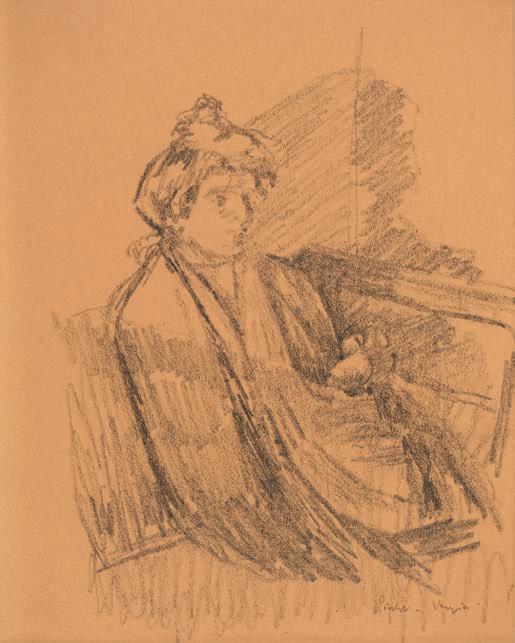
Sickert made four trips to Venice (1895-96, 1900, 1901, and 1903-04). The present work is likely to date from 1903-04, when the artist was forced to work indoors due to bad weather. Sickert used models formt he local trattorias to produce a number of important figure paintings including Study in Rose (Barron 197).
(1) £2,000 - £3,000
154AR* Bénézit (Emmanuel Charles, 1887-1975). Soleil dans la Brume, circa 1908, coloured chalks on paper, monogrammed lower right ‘EB’, Mercury Gallery London label to verso, sheet size 22.8 x 28.6 cm (9 x 11 1/4 ins), framed (41.5 x 47.5 cm)

Provenance: Private Collection: Gloucestershire.
Exhibited: Mercury Gallery, London, E.C. Bénézit, oils and watercolours, June 27 - July 28 1990, number 45.
(1) £150 - £200
155* Goodwin (Albert, 1845-1932). La Boca, Pollensa, Majorca, circa 1900-1920, coloured chalks on beige wove paper, titled lower right, sheet size 24.2 x 31.6 cm (9 1/2 x 12 3/8 ins), together with a collection of 8 colour chalk landscape sketches by the artist, one with some edge tears and loss, similar sizes, plus a sketchbook of 18 views in black chalk, 27.2 x 35.8 cm (10 3/4 x 14 1/8 ins), some landscapes and views titled, including St Mawes Castle, The Castle at Villenueve, Pulborough, Falaise, The Chess Rickmansworth, Carshalton Surrey, Across the Valley Belvedere, Near Petit Andelys, one view with AG monogram, and two other large scale chalk studies, one of a young woman in coloured chalks (damaged with loss), the other a study of a dinner table in black chalk, laid down on later card, 75.5 x 58.8 cm (29 3/4 x 23 1/8 ins) and smaller (12) £200 - £300

156* Hong Kong. Garden landscape with coastal view and figures, by A.N. Pybus, 1910, watercolour, with traces of pencil, depicting a large fountain amongst pavilions and trees, with an array of figures, including a street seller with yoke and baskets, the sea and hills in the background, inscribed in pencil lower left ‘Hong Kong Jan: 1910. - A.N. Pybus’, lightly foxed in places, 19 x 26.2 cm (7 1/2 x 10 1/4 ins), mounted, framed and glazed (32.5 x 36.5 ins)
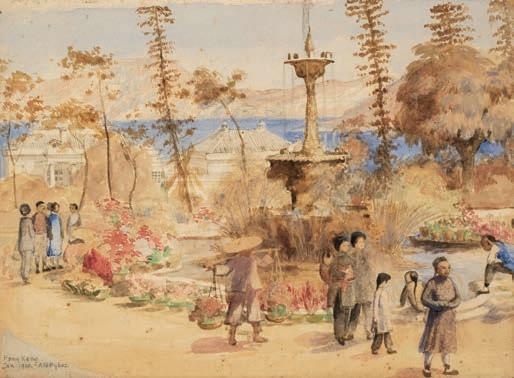

(1) £150 - £200
157* Keeling (Gertrude, exhibited 1896-1940). The Tar Maker, watercolour on grey paper, signed lower right, mount aperture 33.5 x 25 cm (13 1/4 x 9 3/4 ins), framed and glazed (55.2 x 46 cm)

Gertrude Keeling, painter and etcher, exhibited at many galleries including the Royal Academy, Walker Art Gallery, Royal Institution, Glasgow Institute of Fine Art and The Society of Women Artists between 1896 and 1940.
(1) £200 - £300
Lot 157
Each lot is subject to a Buyer’s Premium of 20% (Lots marked * 24% inclusive of VAT @ 20%)
158AR* Sleigh (Bernard, 1872-1954). A Little Picture Map for the Christmas Pilgrimage, watercolour with pen and ink on thick wove paper, signed in pencil to verso Bernard Sleigh R. B. A. Charlotte Rd, Edgbaston, sheet size 35 x 26.5 cm (13 3/4 x 10 1/2 ins)
Provenance: Private Collection, Cotswolds, England.
(1) £700 - £1,000
159* Hardie (Martin, 1875-1952). Dug outs in front line Hun trenches on the North Bank of the Piave, November 4, 1918, watercolour with pen and brown ink on laid paper, signed and dated lower right, inscribed with the title to verso, and stamped ‘HQ B.E.F. Itlay Ch. Mitchel, L. Col., Intelligence’, 22.5 x 31 cm (9 x 12 1/4 ins) mount aperture, framed and glazed

(1) £200 - £300
161* Clausen (Sir George, 1852-1944). Mother and Child with chickens by a farm building, watercolour and gouache on paper, signed lower right, 170 x 235 mm (6 3/4 x 9 1/4 ins) mount aperture, framed and glazed

(1) £200 - £300
160* Leaver (Noel Harry, 1889-1951). A City Gate, watercolour, signed lower left, depicting a Middle Eastern scene looking through a stone arch towards a mosque, mount aperture 25 x 35.5 cm (9 7/8 x 14 ins), previous auction stencil and typed label with title and artist to verso, framed and glazed (38 x 51.5 cm), together with Country Landscape, 1919, watercolour, signed and dated lower right, mount aperture 17.5 x 26.5 cm (6 7/8 x 10 3/8 ins), framed and glazed (37 x 45 cm)

(1)
£200 - £300
162* Despiau (Charles, 1874-1946). Female Nude, pale red chalk on cream laid paper, signed lower right, 320 x 240mm (12 1/2 x 9 1/2 ins) mount aperture, framed and glazed

Provenance: Collection of Sir Lawrence Gowing (1918-1991).
(1) £100 - £150
163* Hankey (William Lee, 1869-1952). Villa Nomades, watercolour on whatman’s board, depicting a large white house with terracotta coloured roof within a wooded landscape, signed lower right, No 3 Villa Nomades in pencil to margin, sheet size 38 x 45.5 cm (15 x 17 7/8 ins), previous owner’s notes in ink to verso, old adhesive tape to verso edges

(1) £100 - £150
165* Nicholls (George Frank, 1885-1937). View of Oxford from Queen’s College, watercolour, depicting a view over Oxford featuring the dome of the Radcliffe Camera, signed lower right, mount aperture 25.5 x 35.2 cm (10 x 13 7/8 ins), framed and glazed (46 x 56 cm)

(1) £200 - £300
164* Nicholls (George Frank, 1885-1937). Brasenose College, Oxford, watercolour, depicting a view of Brasenose College from Radclyffe Square, Oxford, signed lower left, mount aperture 27 x 35.7 cm (10 5/8 x 14 ins), framed and glazed (48.5 x 55 cm)

(1)
£200 - £300
166* Rothenstein (William, 1872-1945). Portrait of John Masefield, 1920, red and white chalk on pale brown paper, head-andshoulders, half-profiled to right, signed with initials and dated lower right, 278 x 183 mm (11 x 7 1/8 ins) mount aperture, framed and glazed (60 x 49.5 cm)
(1) £200 - £400

167* Allcott (Walter Herbert, 1880-1951). Going to the Fair, 1922, watercolour on paper, signed and dated lower right, 22 x 25 cm (8 3/4 x 9 7/8 ins) mount aperture, framed and glazed, with City Museum & Art Gallery Birmingham label to verso for the exhibition Masterly Art (Birmingham School of Art 1884-1920), 1986-87, together with Knight (Laura, 1877-1970). Dancing Angel, 1963, blueball point ink on letterhead paper, with printed address 16 Langford Place, St Johns Wood, London, NW8, dated 20 December 1963, and with inscription by the artist 'to my very dear friends Archie and Peggy...', signed 'with love, Laura', lower right, 12 x 20 cm (4 7/8 x 7 7/8 ins) mount aperture, framed and glazed, plus one other watercolour by Bernard Fleetwood Walker (1892/93-1965)

(3) £300 - £500
168* French School. Sailing Boats by the Coast, 1924, watercolour on card, depicting a harbour scene with boats near the shore, signed ‘L 1924’ lower left, sheet size 52.5 x 66 cm (20 6/8 x 26 ins)
(1) £200 - £300
 Lot 167
Lot 167
169AR* Hunt (Cecil Arthur, 1873-1965). Bridge at Sisteron, watercolour and gouache, signed lower left and titled ‘Sisteron’ lower right, 24.7 x 36.7 cm (9 3/4 x 14 1/2 ins) mount aperture, framed and glazed, with printed title label to verso and exhibition label for the R.W.S. Galleries to verso
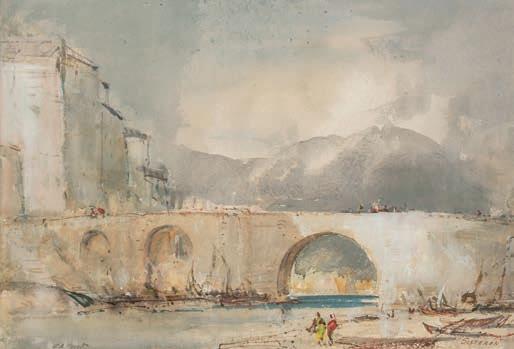
Exhibited: Royal Society of Painters in Water-Colours, London, Cecil A. Hunt, 1873-1965 : retrospective exhibition, May 1966.
(1) £300 - £500
171* Wright (Robert Murdoch, 1889-1962). Returning from the Mosque, watercolour, a landscape with middle eastern figures, and a Mosque and other buildings in the distance, 33.5 x 23.5 cm (13 1/4 x 9 1/4 ins) mount aperture, framed and glazed (57.5 x 46.4 cm)

(1) £100 - £150
170AR* Mason (Frank Henry, 1876-1965). H.M.S. Amazon, watercolour heightened with bodycolour on card, signed lower right, sheet size 38.5 x 52 cm (15 1/8 x 20 1/2 ins), framed and glazed (52.3 x 67 cm)

Mason was part of the Staithes Group of artists, born at Seaton Carew, Hartlepool. He entered the world of marine engineering but gave it up to become a full time artist.
(1) £300 - £400
172AR* Smith (Matthew, 1879-1959). Reclining Nude, 1931, pencil on paper, signed lower left, some light overall toning with two discolouration spots to upper right, laid down on board, with Warren Gallery label to verso, and small circular sticker marked in ink ‘8 M. Smith’ to verso, sheet size 50 x 67 cm (19.7 x 26.3 ins), framed and glazed, with printed exhibition label for the Royal Academy of Arts Sir Matthew Smith Exhibition 1960
Provenance: W. Grossmann, 79 Harley Street, London; sold Phillips, London, Tuesday November 14, 2000, lot 195; Private Collection, Gloucestershire.
Exhibited: Royal Academy of Arts, Sir Matthew Smith Exhibition, 1960, catalogue number 19.
A life study by Matthew Smith, depicting his partner Vera Cunningham, most likely executed in Paris in 1931. According to John Rothenstein, the artist regarded his figure paintings of the period from 1930 to 1932 while in Paris as his finest work (see John Rothenstein, Matthew Smith, 1962, page 5, where this drawing is also illustrated).
(1) £1,000 - £1,500
173* Pilawski (Wieslaw, 1916-1972). Reclining Nude, circa 1950's, oil on board, size 15 x 25.5 cm (5 7/8 x 10 ins), together with 4 others by the same artist comprising: Country village landscape, seaside landscape, industrial landscape and crouching figure, all with artist's name in pen to verso, approximately 15 x 25.5 cm (5 7/8 x 10 ins)
(5) £200 - £300
174* Welch (Denton, 1915-1948). Self Portrait, 1934-36, coloured chalk on paper with embossed blindstamp to upper right corner Dixon’s David Cox Drawing, sheet size 34.2 x 27.5 cm (13 1/2 x 10 6/8 ins), together with a small archive of related ephemera including I Left My Grandfather’s House, an account of his first walking tour by Denton Welch, published by Lion and Unicorn Press, 1958, a seven page typed manuscript story by Denton Welch entitled Discoveries, plus a cartoon sketch by Welch of a man with a bandage around his head lying in bed eating gruel saying ‘I don’t think I am sick which proves that I am not “phase of belief”’, What Would Eddy Do? in red to the left margin, and seven related photographs: four of Denton Welch and three of Evelyn Sinclair Methuen-Campbell 107.

Provenance: Evelyn Sinclair, thence by descent.
Denton Welch was born in 1917 in Shanghai and educated at Repton School, from which he ran away aged 16. He became a student at Goldsmiths’ School of Art, and whilst still at art school in 1935 he was hit by a car when out cycling. The accident left him in permanent pain which was to dog him throughout his short life and ultimately lead to his early demise in 1948 at the age of 33. Unable to return to his studies after the accident, Welch lived an invalid’s life in the Kent countryside with his devoted housekeeper, Evelyn (Evie) Sinclair, who remained with Welch at his different residences until May 1946, two months after Welch and his partner Eric Oliver moved to Middle Orchard, at Crouch near Borough Green, Kent. However, Sinclair returned to Middle Orchard in July 1948 to assist Welch until his death. During all this time he continued to paint and write, building up a large body of work. His paintings were exhibited during his lifetime in London as well as posthumously in 1954 by Leicester Galleries, and in November 1984 by Abbott and Holder.
(1 folder) £300 - £500

175AR* Dunoyer de Segonzac (André, 1884-1974). Bords de Rivière avec Ferme, pen and black ink on laid paper signed lower left, mount-stained, sheet size 34 x 50.5 cm (13 3/8 x 19 7/8 ins), framed and glazed

Provenance: Collection of Sir Lawrence Gowing (1918-1991).
(1) £150 - £200
176AR* Coldstream (William, 1908-1987). Thelma, 1936, pencil on light tan paper, with printed and typed exhibition label to verso for the Tate Gallery exhibition of the work of William Coldstream, catalogue number 104, 302 x 215 mm (11 7/8 x 8 3/8 ins) mount aperture, framed and glazed

Provenance: Collection of Sir Lawrence Gowing (1918-1991).
Exhibited: William Coldstream, South London Art Gallery, Camberwell, 27 April - 26 May, 1962 (and touring to The University, Leeds, City Art Gallery, Bristol, Glynn Vivian Art Gallery, Swansea, Southampton Art Gallery, and City Museum and Art Gallery, Birmingham), catalogue number 104. Catalogue introduction by Lawrence Gowing, and article ‘Coldstream and the sitter’ by Adrian Stokes.
A study of Thelma Hulbert (1913-1995), artist and teacher, born in Bath, Somerset, where she studied at the School of Art. During the later 1930’s Hulbert was a model, secretary and student at the Euston Road School run by William Coldstream, Victor Pasmore, Claude Rogers and Graham Bell. From 1962 to 1972 she taught at the Central School of Art and Design. A retrospective of her work, organized by Bryan Robertson, was shown at the Whitechapel Gallery in 1962.
(1) £500 - £800
177AR* Henderson (Keith, 1883-1982). From the Nerja Bridge northwards, watercolour, depicting a Spanish landscape with river and mountains, signed lower right, James Bourlet & Sons Ltd and R.W.S Galleries labels to verso, mount aperture 40 x 57.5 cm (15 3/4 x 22 6/8 ins), framed and glazed (65.5 x 81.5 cm)
(1) £200 - £300

178AR* Birch (Samuel John ‘Lamorna’, 1869-1955). Newlyn Harbour, 1941, watercolour, signed and dated on verso in artist’s hand, mount aperture 15.9 x 22.6 cm (6 1/4 x 8 7/8 ins), The Fine Art Society label with title, artist and date to verso (some loss of text), framed (33.6 x 41 cm)
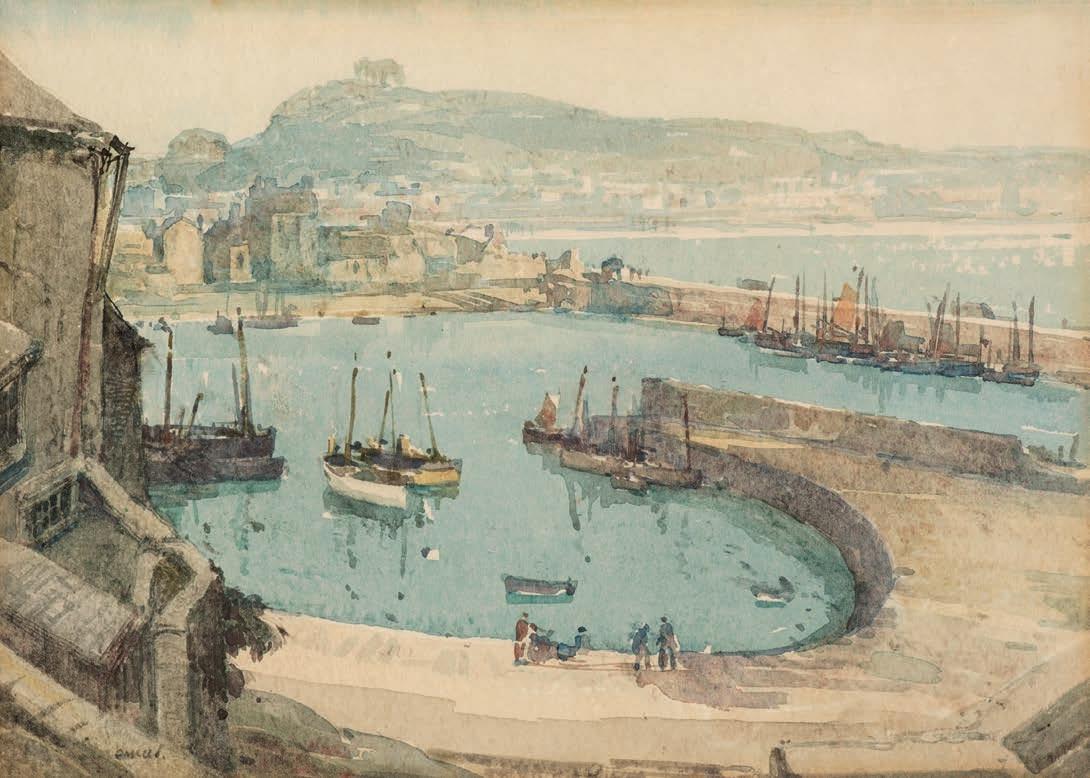
Provenance: Private Collection, Cumbria. Purchased by the father of the current owner from The Moonraker Gallery in Fowey, Cornwall on 27th July 2001.
Exhibited: The Fine Art Society, 1943. Apart from a brief period of study at the Atelier Colarossi, Paris in 1895, Birch was largely self-taught. Birch first visited West Cornwall in the late 1880s and settled in the Lamorna Valley in 1892.
(1) £700 - £1,000
179* Welch (Denton, 1915-1948). Bone Head, 1943, carved bone sculpture of a primitive head, mounted on a wooden base (3 x 4.2 cm), initialled and dated on verso, height 13.9 cm Methuen-Campbell 129.

Provenance: Evelyn Sinclair, thence by descent. See lot 174 for more information regarding provenance.
(1) £500 - £700 Lot
180AR* Gowing (Lawrence, 1918-1991). Masaccio's Tribute Money, 1944, pencil and wash on paper, sheet size 38.5 x 74 cm (15 1/8 x 29 1/8 ins), framed and glazed (45.5 x 83 cm)

Provenance: Collection of Sir Lawrence Gowing (1918-1991).
(1) £200 - £300
181AR* Pasmore (Victor, 1908-1988). Standing female nude, circa 1940-45, pencil on cream wove paper, signed with initials, light mount stain, minor surgace soiling and handling marks, handwritten presentation label by the artist in pencil to verso ‘To Lawrence thank you for having me’, slightly irregular sheet size 24 .5 x 15 cm (9 5/8 x 6 1/8 ins), framed and glazed

Provenance: Collection of Sir Lawrence Gowing (1918-1991). The drawing is likely to date from the period of Pasmore’s involvement with the Euston Road School, roughly from 1937 to 1947.
(1) £500 - £800
182* Kobinger (Hans, 1892-1974). Otztal and Tyrol, Austria, 1947, two watercolour landscapes on paper, each signed and dated lower left, 48 x 60cm (19 x 23ins) and slightly smaller, framed and glazed


(2) £200 - £300
Lot 181
183AR* Pasmore (Victor, 1908-1988). Orchard, circa 1947, pencil on cream wove paper, signed with initials lower right, sheet size 19 x 25.5 cm (7 1/2 x 10 ins), mounted at corners with adhesive tape to backing card, framed and glazed
Provenance: Collection of Sir Lawrence Gowing (1918-1991).
Similar to preparatory drawings Pasmore made for the painting Suburban Gardens (British Council, artuk.org/artworks/suburban-gardens-176808) in the Betts Collection, University of Reading, and online at Jenna Burlingham Fine Art.
(1) £700 - £1,000
185AR* Ardizzone (Edward, 1900-1979). Artist and Model, red chalk on paper, signed with initials in pencil lower right, 21.5 x 27.2 cm (8 1/2 x 10 3/4 ins) mount aperture, framed and glazed, with label of Chris Beetles gallery to verso

Provenance: Chris Beetles, London; purchased by the present owner 21 March 1987 (copy of invoice attached).
(1) £400 - £600
184AR* Birch (Samuel John ‘Lamorna’, 1869-1955). Fishing in the Valley, 1948, watercolour, signed and dated lower right, mount aperture 18 x 29.7 cm (7 1/8 x 11 6/8 ins), framed and glazed (43.4 x 53.8 cm)
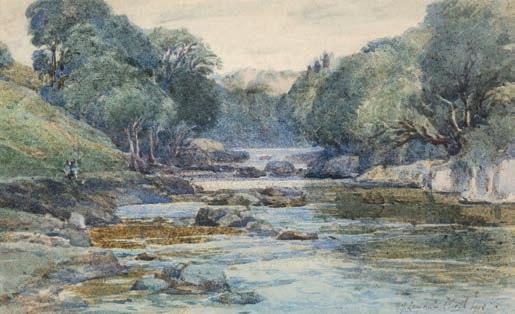
Provenance: Private Collection, Cumbria. Purchased by the father of the current owner from The Valentyne Dawes Gallery, Shropshire on 28th October 2000.
Apart from a brief period of study at the Atelier Colarossi, Paris in 1895, Birch was largely self-taught. Birch first visited West Cornwall in the late 1880s and settled in the Lamorna Valley in 1892.
(1) £700 - £1,000
186AR* Coldstream (William, 1908-1987). Ilona Guinsberg, pencil on off-white wove paper, inscribed in pencil to lower left margin 'Ilona G.', probably in Sir Lawrence Gowing's hand, sheet size 32.5 x 25 cm (12 3/4 x 9 7/8 ins), mounted


Provenance: Collection of Sir Lawrence Gowing (1918-1991).
(1) £700 - £1,000
Lot 189
187AR* Coldstream (William, 1908-1987). Lawrence Gowing, pencil on pale cream heavy wove paper, inscribed in pencil to lower left margin ‘LG. drawn by WMC’, sheet size 33 x 25.5 cm (13 x 10 ins), mounted
Provenance: Collection of Sir Lawrence Gowing (1918-1991).
(1) £400 - £600
188AR* Coldstream (William, 1908-1987). Sally Chilver, circa 1950’s, pencil on thin paper, inscribed in pencil to lower margin ‘Sally Chilver, whom LG. was painting at the time’, probably in Sir Lawrence Gowing’s hand, one or two minor marks and creases towards lower margin, sheet size 30 x 21 cm (11 3/4 x 8 1/4 ins), mounted
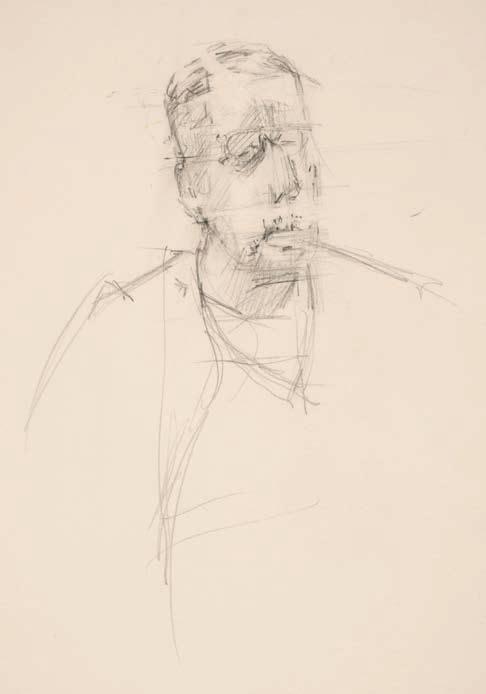
Provenance: Collection of Sir Lawrence Gowing (1918-1991).
(1) £300 - £500
189AR* Coldstream (William, 1908-1987). Woman seated on a chair by a window with pot plant, pencil on pale cream wove paper, inscribed in pencil to verso ‘Coldstream’, sheets size 38 x 28 cm (15 x 11 ins)


Provenance: Collection of Sir Lawrence Gowing (1918-1991).
(1) £400 - £600
190AR* Lamb (Henry, 1882-1960). Julia Strachey Reading, pencil on pale cream wove sketchbook paper, inscribed the artist to lower margin ‘for Julia, from Henry. 1950’, light mount toning, and faint horizontal crease, tape residue to upper margin to verso, sheet size 208 x 134 mm (8 3/8 x 5 3/8 ins), window-mounted Provenance: Sir Lawrence Gowing (1918-1991).
Gowing met the author Julia Strachey (1901-1979) in 1939 when Gowing was just twenty-one, and they were married in 1952. Through her Gowing came into contact with members of the Bloomsbury Group, including Quentin Bell.
A similar pencil study of Julia reading, from the Patricia and Donald Oresman Collection, was sold at auction by William Doyle in November 2018, lot 238.

(1) £300 - £500
191AR* Pasmore (Victor, 1908-1988). Rocks and Sea (Beach in Cornwall), 1950, pen and ink on cream wove paper, signed with initials and dated lower right, sheet size 23.7 x 29.7 cm (9 3/8 x 11 5/8 ins), laid down on light brown backing card, framed and glazed Provenance: Sir Lawrence Gowing (21 April 1918 – 5 February 1991).

A similar composition titled Beach in Cornwall, also dated 1950 (10 1/2 x 12 1/2 inches) is in the collection of the Arts Council of Great Britain (AC 287), and is illustrated in Victor Pasmore (Art in Progress series) by Jasia Reichardt, published by Methuen in 1962.
One of a number of drawings of Porthmeor Beach made by Pasmore during a stay in St. Ives, Cornwall in the summer of 1950, at the invitation of Ben Nicholson. Pasmore had been introduced to Nicholson in 1949 by Terry Frost, then a student of Pasmore’s at Camberwell School of Art. Though he only visited once, Pasmore exhibited at the newly founded Penwith Society of Arts in 1950 and joined a few years later. His friend William Townsend recorded that the St Ives drawings consisted of ‘extremely simple designs for houses, rocks, cliffs and spiralling shapes of water’ (Andrew Forge, ed., Townsend Journals, 1976, p.90).
(1) £700 - £1,000
192* Weissenborn (Helmut, 1898-1992). Beach Scene, circa 1950s, coloured pastel on paper, a beach scene with bathing huts and figures, signed lower right, mount aperture 24.5 x 32.6 (9 5/8 x 12 7/8 ins) framed and glazed, with artist’s handwritten label to verso with address of 15 Calnricarde Gardens, W.”., and price of 8 guineas, (48.5 x 52.5 cm), together with seven other 20th century British watercolours, pastels and gouaches by John Harwood, Moored Boats, Reginald Grenville Eves, Pond Lane, Sussex, William Mason, At the Seaside, Arthur E Davies, Sand and Sails, Blakeney, Arthur Bell Foster, Granite Quarry, Ribblesdale, Ernest Boyce Uden, Collecting the Wood, and C.W. Taylor, Cow Barn, all but one signed, all framed and glazed
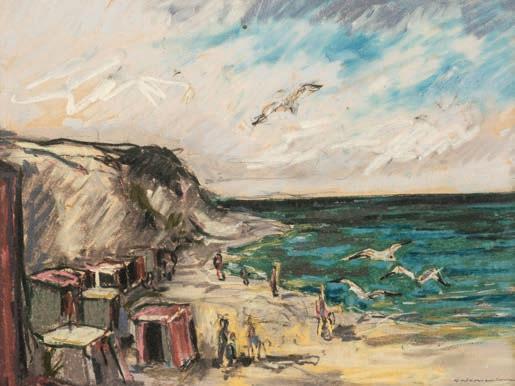
(7)
£250 - £350
193AR* Frost (Sir Terry, 1915-2003). Standing Nude - Elbow on Knee, circa 1951, pencil on pale cream wove paper, a study of a full length standing nude undertaken at Penwith Gallery Life Class, signed lower right: Terry Frost Penwith Gall L.C., with a further note by the artist to upper right corner of the sheet giving a list of other attendees: Lawrence, McNaghten, Ramsay, Brown, Bayley, Miss Hocken,Fuller student, Bunt, White, Fuller, sheet size 33 x 20 cm (13 x 7 7/8 ins), with Anthony Hepworth and Belgrave Gallery labels to verso, framed and glazed (52.5 x 40 cm)

Provenance: Pauline Del Mar.
Illustrated: Mel Gooding Terry Frost: Act & Image - works on paper through six decades, Belgrave Gallery, 2000.
(1) £400 - £600
194AR* Macnab (Iain, 1890-1967). Market Place, Woodstock, 1951, black ink and pen, titled and signed by the artist in pencil lower margin, edges toned, designed for Introduction to Woodstock by J.M. Shelmerdine published by The Samson Press, 1951, sheet size 19 x 25.4 cm (7 1/2 x 10 ins), mounted

(1) £100 - £150
195AR* Tunnicliffe (Charles Frederick, 1901-1979). Magnificent Man of War Bird (The Old Man and the Sea, 1953, scraperboard illustration for Ernest Hemingway’s The Old Man and the Sea published by the Reprint Society in 1953, 90 x 150 mm (3 5/8 x 5 7/8 ins) mount aperture, framed and glazed, with Welsh Arts Council label to verso for the exhibition of the work of C. F. Tunnicliffe

Provenance: Private Collection, Cotswolds, UK.
Exhibited: Wild Lives: The Art of Charles F. Tunnicliffe RA, 1901-1979, Weslh Arts Counsil-Mostyn Art Gallery, 1980, no. 31.
(1) £200 - £400
196AR* Coldstream (William, 1908-1987). Study of a woman seated in front of a sideboard with vase, graphite and red pencil on heavy wove paper, sheet size 50.5 x 33.5 cm (19 7/8 x 13 1/8 ins), together with a smaller figure study of a woman in pencil

(2)
£300 - £400
197AR* Spare (Austin Osman, 1888-1956). Dawn: Procession of the Procarnators, 1955, pastel on paper, depicting a sunset over a landscape, a line of figures carrying flaming torches, signed and dated lower right, sheet size 28.5 x 62.5 cm (11 1/4 x 24 5/8 ins), label with ‘No.180’ and title in artist’s hand to verso, along with previous owner’s address label ‘Lieu. Col P. Boxer of Malton, Suffolk’, framed (38 x 71.5 cm)

Exhibited: Archer Gallery, Westbourne Grove, 1955, no. 180. This was Spare’s last exhibition held during his lifetime. A copy of the catalogue is in the Sackler Library, Oxford. Procarnate is defined in the Metaphysical Dictionary as ‘To go forward into a life one has not experienced as yet’.
(1)
£2,000 - £3,000
198* Olds (Paul, 1922-1976). Buildings on Ile St. Louis, circa 1958, oil on canvas laid onto board, canvas size 46 x 54.7 cm (18 1/8 x 21 1/2 ins), The Redfern Gallery label to verso, framed 58.6 x 67.5 cm (12 1/8 x 26 5/8 ins)
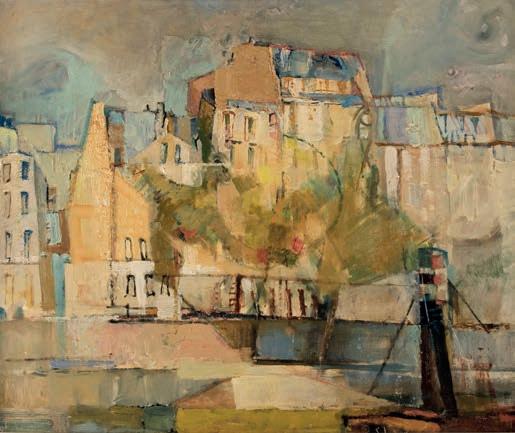
Exhibited: The Redfern Gallery, February 1958.
(1) £100 - £150
199AR* Burra (Edward, 1905-1976). Head of a Woman, brown ink on paper, with additional study of a male nude to verso, in pencil, with E. J Burra red studio stamp to lower right, 35 x 21 cm (13 3/4 x 8 1/4 ins), framed and double-glazed (64.2 x 48.2 cm), with Lefevre Gallery label to verso

Provenance: Edward Burra estate; Lefevre Fine Art, London.
(1) £200 - £400
201AR* Sutton (Phillip, 1928-). Standing Nude, watercolour on card, 140 x 85 mm (5 1/2 x 3 3/8 ins), with artist’s name and address to verso: Phillip Sutton 3, St. James Grove, W.11, London, framed and glazed (36 x 29.5 cm), together with two similar postcard watercolours by Phillip Sutton, addressed to Lawrence Gowing Esq. Gordon House, Lanbourne, Berks., one titled Landscape (Tree and Hedge), the other The Garden, the latter with postmark to verso dated 19 July 1960 Provenance: Collection of Sir Lawrence Gowing (1918-1991).

(3) £200 - £300
200AR* Rossiter (Anthony, 1926-2000). Spring in Grasmere, 1960, watercolour and gouache on wove paper, label to verso with artist’s name and title, signed and dated ‘A. Rossiter / April ‘60’ lower right, with a further label with artist’s name and title of work D 10372, 57 x 83.8 cm (20 x 30 ins), apparently in good condition, unexamined out of the frame, framed and glazed (58 x 91 cm)

(1) £200 - £300
202* Creedy (Jean, 1920-2014). Dartmoor Forest, near Haytor, South Devon, 1960s, oil on canvas, unsigned, 45 x 56 cm (17 3/4 x 22 ins), framed (66 x 76 cm), with ink manuscript inscription and title label on verso, together with a small untitled oil on board landscape (Dorset or Dartmoor), framed
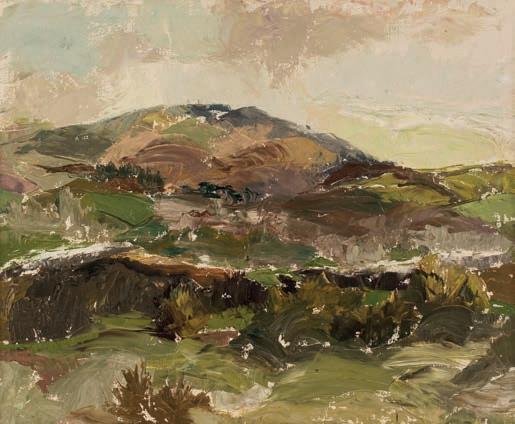
Jean Creedy studied at Exeter University, the Chelsea College of Art, and London University. A Fellow of the Royal Society of Arts, she has exhibited at the Heffner Gallery, Cambridge, Galleri Docent Duc, Stockholm, the Royal Academy Summer Exhibitions, and the Royal West of England Academy amongst others.
(2) £100 - £150
Each lot is subject to a Buyer’s Premium of 20% (Lots marked * 24% inclusive of VAT @ 20%)
203AR* Blackadder (Elizabeth, 1931-2021). Golden Pheasant, circa 1961, mixed media on paper, signed lower left, original Aitken Dott & Son (Scottish Gallery) label to verso, with typed artist name, title and number 0565, remnants of old exhibition label, sheet size 66 x 98 cm (26 x 38 1/2 ins), framed and glazed (88 x 120 cm)

Provenance: Private Collection, Gloucestershire.
Exhibited: The Scottish Gallery, 1961; The Scottish Gallery, 150th Anniversary Exhibition, Edinburgh, August - September 1992, number 110.
(1) £5,000 - £7,000
204* Matania (Franco, 1922-2006). Standing Female Nudes, coloured chalks on tinted paper, two studies of full length female nudes, both signed or initialled, mount aperture from 45.5 x 23.5 cm (17 7/8 x 9 1/4 ins) to 61.5 x 30.5 cm (24 2/8 x 12 ins), both framed and glazed, together with another similar study of a rugby player, coloured chalks on tinted paper, initialled to lower right, mount aperture 53.5 x 29 cm (21 1/8 x 11 3/8 ins), framed and glazed (3) £200 - £300

205* Miners (Neil, 1931 - 2010). Cornish Coast, 1963, watercolour, signed, dated and titled to lower right, mount aperture 20 x 38 cm (7 7/8 x 15 ins), framed and glazed (47 x 64.5 cm), together with three other similar works by the same artist, one watercolour and coloured pencil and two in black pencil and chalk, signed with monogram, all framed and glazed
Neil Miners (1931-2010) studied at Falmouth School of art and spent most of his life living in the town, is best known for his seascapes. Falmouth Art Gallery has several of his works in its permanent collection.
(4) £100 - £200
206AR* Ardizzone (Edward, 1900-1979). The Fight on the Bridge, circa 1965, pen and black ink on ivory wove paper, inscribed with the title by the artist in pencil to lower left, 152 x 190 mm (6 x 7 1/2 ins) mount aperture, framed and glazed, with Chris Beetles gallery label to verso
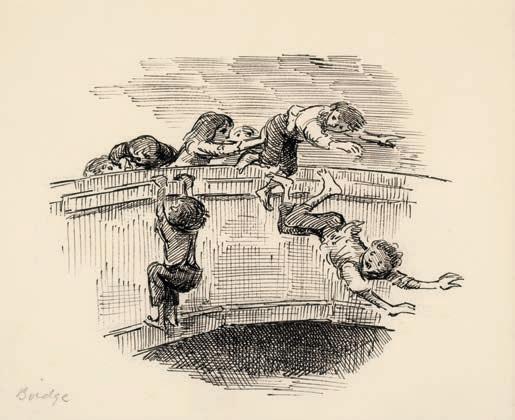
Original illustration for the Milldale Riot by Freda Nichols, published by Ginn & Co. Ltd. in 1965, chapter XIV, page 11.
(1) £300 - £500
207* Buckle (Claude, 1905-1973). The Bridge, France, watercolour, signed lower left, mount aperture 32.8 x 38.5 cm (12 7/8 x 15 1/4 ins), framed and glazed (59.5 x 64 cm), together with Boat Repairs, watercolour, signed lower left, mount aperture 31 x 44.5 cm (12 1/4 x 17 1/2 ins), framed and glazed (57.5 x 70 cm)

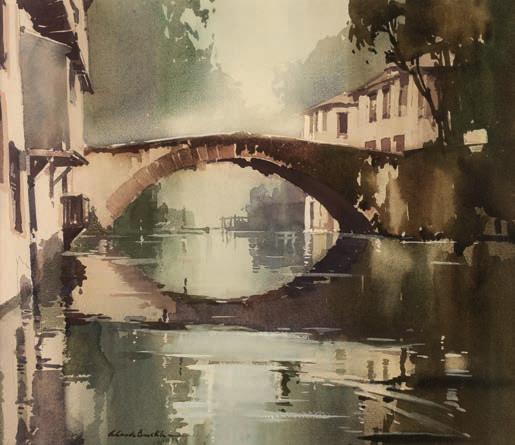
(2) £300 - £500
208* Creedy (Jean, 1920-2014). Approach to Battle, East Sussex, watercolour on wove paper, signed lower right, mount aperture 27.7 x 35.5 cm (10 7/8 x 14 ins), pencilled inscription and label on verso, together with: Across the Lake, Sheffield Park, Brighton, watercolour on wove paper, mount aperture 18.8 x 25.7 cm (7 3/8 x 10 1/8 ins), ink manuscript inscription and label on verso, plus 3 other English landscape watercolour views: Rocks in Landscape, Bowerman’s Nose, Manaton, Dartmoor; New Forest, near Cadnam; April Showers, all mounted, framed and glazed (54 x 71.5 cm and smaller), all labelled on versos, and with 4 charcoal drawings on paper: Alpine Landscape 3 (1970s); Rocks in Landscape, Scotland; Windsor Park; Scottish Lakeland, all signed and mounted, with label on versos, three in clip frames (48 x 60 cm and smaller), and a colour print, signed by Creedy and numbered 36/40, showing boats in a harbour

Jean Creedy studied at Exeter University, the Chelsea College of Art, and London University. A Fellow of the Royal Society of Arts, she has exhibited at the Heffner Gallery, Cambridge, Galleri Docent Duc, Stockholm, the Royal Academy Summer Exhibitions, and the Royal West of England Academy amongst others.
(10) £150 - £200
Lot 207209* Creedy (Jean, 1920-2014). Distant Mountains from Katoomba Falls, watercolour on wove paper, signed lower right, mount aperture 29 x 39.2 cm (11 1/2 x 15 3/8 ins), together with two other Australian watercolour views: Blue Mountains Landscape 1 [and] 2, both signed and mounted, plus a watercolour landscape Foothills of the Appalachian Mountains, signed and mounted, all framed and glazed (59 x 74.5 cm and smaller), labelled on versos (the first item labelled ‘Distant Mountains from Katoomba Falls d’Alcudia [?]), some with ink manuscript inscription on verso, and another similar possibly American landscape, signed watercolour on paper

Jean Creedy studied at Exeter University, the Chelsea College of Art, and London University. A Fellow of the Royal Society of Arts, she has exhibited at the Heffner Gallery, Cambridge, Galleri Docent Duc, Stockholm, the Royal Academy Summer Exhibitions, and the Royal West of England Academy amongst others.
(5) £100 - £200
210AR* Cuming (Frederick George Rees, 1930-2022). Spring Squally Sky, oil on board, signed lower left, sheet size 18 x 40.5 cm (7 1/8 x 15 7/8 ins), title written on verso in pencil, framed (30 x 53 cm)

(1) £400 - £600
211AR* Lawson (Sonia, 1934-). Russian Winter, mixed media on paper, signed lower right, additionally inscribed in ink below ‘love from Sonia’, sheet size 17.1 x 24.7 cm (6 3/4 x 9 3/4 ins) mount aperture, framed and glazed (33.5 x 39.6 cm)

Provenance: James Kirkup (1918-2009), poet and critic was given the drawing from Sonia Lawson. Current owner purchased for their own private collection: Gloucestershire.
Sonia Lawson was born in Wensleydale into a family of artists and studied at the Royal College of Art. She lived in a remote cottage in the village of Castle Bolton where she hosted many like minded, creative visitors including: J.B Priestly, James Kirkup, Jacob Kramer and Philip Naviasky.
(1) £150 - £200
212AR* McComb (Leonard, 1930 – 2018). Two Female Nudes, 1978, pencil and wash on handmade paper, signed with monogram and dated 1978 lower right, 25 x 19.5 cm (9 3/4 x 7 3/4 ins), laid down on backing card, framed and glazed, with presentation inscription from the artist to Lawrence Gowing to verso ‘For Lawrence with very best wishes Len McComb, May 23rd 1978’

Provenance: Collection of Sir Lawrence Gowing (1918-1991).
(1) £200 - £300
Lot 211213AR* Batchelor (Mary, 1944-2017). Primroses and Strawberries, pastel, depicting a table top set with strawberries in a stemmed glass and a primrose plant in a terracotta pot within a circular bowl, with additional strawberries and a spoon beside, 35.3 x 46 cm (13 7/8 x 18 ins), mounted, framed and glazed (62.8 x 72.7 ins), backboard with manuscript title and address labels in the artist’s hand

(1) £200 - £300
215AR* De Grey (Roger, 1918-1995). Camer Street, 1980s, charcoal on paper, signed with initials lower right, 39 x 40.5 cm (15 3/8 x 15 7/8 ins) mount aperture, framed and glazed, with printed exhibition label for the work to verso, ?? no. 62, and a further Royal Academy of Arts type written exhibition label for the Roger de Grey exhibition
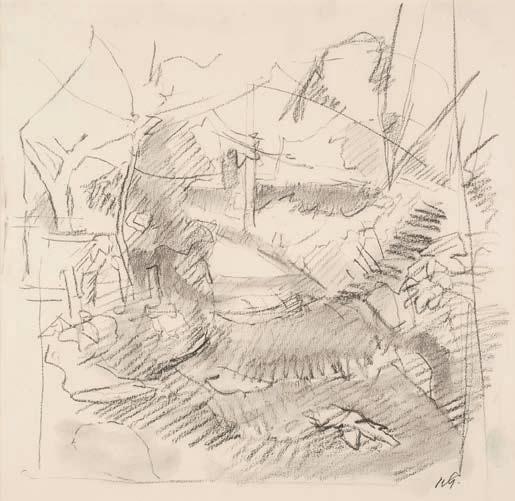
Provenance: Collection of Sir Lawrence Gowing (1918-1991).
Exhibited at the Royal Academy of Arts, Roger de Grey, 11 July-22 September 1996, No. 62. (1) £200 - £300
214* Cavaciutti (Peter, 1952-).Spring Rain in Giulia, Chinese ink and pigments on hand-made paper, printed red seal to lower left, mount aperture 38.5 x 25 cm (15 1/8 x 9 7/8 ins), original handwritten label by the artist with printed red seal, and additional label of Benjamin C. Hargreaves, Drawings and Watercolours, 12 Napier Avenue, London, to verso, framed and glazed (57 x 43 cm), together with four other smaller similar works by the same artist, including: Autumn Landscape, Waiting for Autumn's Return, (both with similar labels to verso), etc.

(5) £200 - £300
216AR* Jones (Allen, 1937-). Dancers, 1984, pencil on paper, signed and dated lower right, inscribed ‘For Lawrence’ lower left, 15 x 14 cm (6 x 5 1/2 ins), framed and glazed (unexamined out of frame)
Provenance: Sir Lawrence Gowing (1918-1991), gifted to him by the artist. (1) £500 - £800
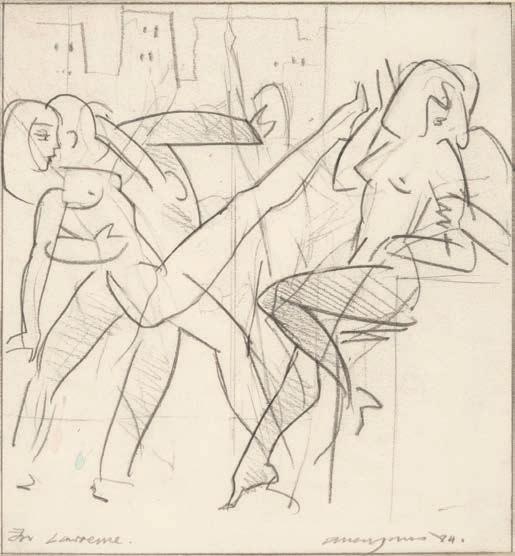
217*
Walking to the Boat on Minnewanka, Banff National Park, Canada, 1984, watercolour laid onto paper, signed and dated lower right, label with title in ink to verso along with Thos, Agnew & Sons Ltd label and letter from Worth to a previous owner, sheet size 22.2 x 33.2 cm (8 3/4 x 13 1/8 ins), framed and glazed (45 x 54 cm), together with Epsom Grandstand, 1969, watercolour on card, signed and dated lower right, titled in pencil to verso, sheet size 22.4 x 33 cm (8 3/4 x 13 ins), framed and glazed (33.8 x 44 cm)

Worth trained at the Royal College of Art he went on to become president of the Royal Watercolour Society from 1992-95 and in 2003 he won the Turner Watercolour Award.


(2) £100 - £200
219AR* Blake (Peter, 1932-). Composition, circa 1986, pen and crayon, signed upper left margin, mount aperture 8.5 x 13 cm (3 3/8 x 5 1/8 ins), framed and glazed (21.5 x 25.5 cm), together with a signed copy of Peter Blake by Marina Vaizey, London: Weidenfeld and Nicolson, 1986, ink inscription to half-title ‘To Mervyn Peter Blake R.A. Nov 14. 86’, together with a copy of an invitation to celebrate the work of Peter Blake on Thursday 28th November 1985, (3) £400 - £600

(1) £200 - £300
(14 1/8 x 8 1/8 ins), all in matching frames, glazed (6) £150 - £200
Worth (Leslie Charles, 1923-2009). 218AR* Brunsdon (John, 1933-2014). Horham Road, 1984, watercolour, signed, titled and dated 1984 in pencil to lower right, mount aperture 42 x 44 cm (16 1/2 x 17 3/8 ins), framed and glazed (61 x 62 cm)221* Aynscomb-Harris (Martin John, 1937-2016). Harbour Scene, circa 1990s, watercolour and gouache, all signed, mount aperture 48.5 x 73 cm (19 1/8 x 28 3/4 ins), framed and glazed (61 x 85.5 cm), together with seven similar by the same artist, all mounted, framed and glazed (8) £200 - £300

222* Bosquet (Thierry, 1937-). Palazzo Foscarini, near San Barnaba, Venice, 1992, gouache on card, signed and dated lower right, sheet size 47 x 53 cm (18 1/2 x 20 6/8 ins), Stephanie Hoppen label to verso, antique-style gilt frame, glazed (58 x 64 cm), together with
Interior Venetian Scene, 1993, gouache on paper, signed and dated lower right, mount aperture 59 x 28.2 cm (23 1/4 x 11 1/8 ins), Stephanie Hoppen label to verso, gilt frame, glazed (70.6 x 40.5 cm) The Belgian stage and costume designer Thierry Bosquet has collaborated with Maurice Béjart (1927-2007), most notably for La Traviata and Seraphita at the Théâtre de la Monnaie in Brussels (both 1973) and worked with many theatres and opera houses across the world.
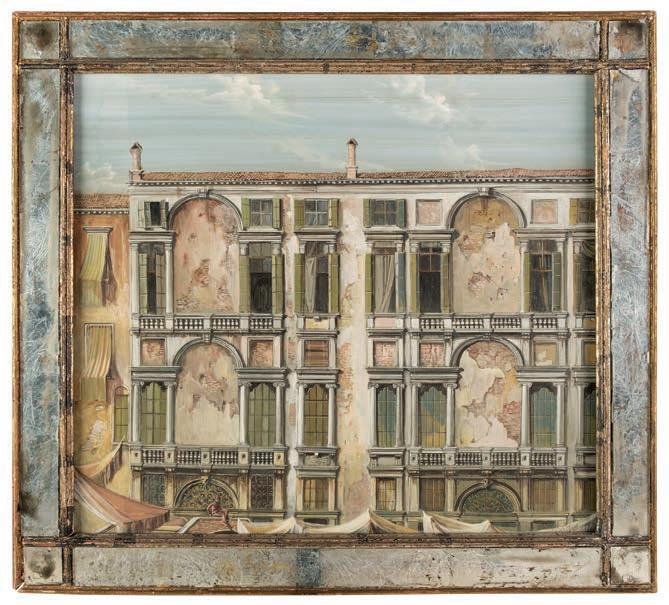
(2) £200 - £400
223* Creedy (Jean, 1920-2014). Trie-Château, near Gisors (France), 1992, watercolour on wove paper, signed and dated lower right, mount aperture 25.5 x 37 cm (10 x 14 1/2 ins), with two other watercolours of European scenes: Landscape near Malaga, and an unknown cityscape (from a folio), both signed, mounted, all framed and glazed with (43.5 x 24 cm and similar), labelled on versos

Jean Creedy studied at Exeter University, the Chelsea College of Art, and London University. A Fellow of the Royal Society of Arts, she has exhibited at the Heffner Gallery, Cambridge, Galleri Docent Duc, Stockholm, the Royal Academy Summer Exhibitions, and the Royal West of England Academy amongst others.
(3) £80 - £120
224* After Samuel S. Miller (circa 1807-1853). Picking Flowers, circa 1840-1850 [but 20th century], oil on canvas, depicting a girl standing in a garden with a basket of flowers hanging from her arm, a cat playing with some flowers at her feet, a cottage and a lake behind her, closed tear to upper left verso of canvas with very minor loss of paint (1mm), very lightly marked, canvas size 94 x 68 cm (37 x 26 3/4 ins)

A smaller 20th century copy of the original in the Fenimore Art Museum, Cooperstown, gift of Stephen C. Clark, inventory no. N0255.1961.
(1) £150 - £200
225AR* Cuming (Frederick George Rees, 1930-2022). Fisherman's Huts, Hythe Beach, circa 1975-80, oil on canvas, signed lower left, inscribed to stretcher verso 'Beach Huts Hyth', and numbered 28, canvas size 41 x 50.5 cm (16 x 20 ins), gilded wood framed, with an autograph letter from the artist to the previous owner describing the creation of this painting, attached to the back of the frame Provenance: Private Collection, Wiltshire, England, thence by descent. The artist describes the painting as follows: 'I lived in Hythe Kent for 17 years. I had a small roomed studio in my house, and for a period rented a part of the lifeboat house on the front at Hythe near the fishing boats. The pictures if of the Fishermans Huts on the Hythe Beach and is one of the many studies that I made there probably between 1975 and 82. I found the colours and surfaces presented by these cobbled up buildings very attractive and paintable.'

(1) £500 - £800
Lot
226* Cameron (David Young, 1865-1945). Venetian Palace, etching printed with plate tone, signed in pencil to lower margin, image size 37 x 20.5 cm (14 1/2 x 8 ins), framed and glazed (63 x 52.5 cm) Cameron was a very influential etcher. He studied at Glasgow School of Art before joining life classes at the Royal Scottish Academy. During the First World War, Cameron was appointed official war artist to the Canadian government and in 1933 was made the King’s Painter in Scotland.
(1) £300 - £500

227* Camden Town School. Figure in an interior, circa 1910, oil on canvas board, depicting a shadowy interior scene framed by a pair of open panelled doors, of a study or studio with tall windows, a male figure about to mount several stone steps leading through an open door at the far side of the room, a desk and chair in the foreground, the desk crowded with various objects, including candles, papers, a goblet, and a flowering plant, 39.3 x 29.3 cm (15 1/2 x 11 1/2 ins), gilt moulded frame (53.5 x 43.5 cm)

(1) £500 - £800
228* German School. Sunday Wedding, early 20th Century, oil on canvas, depicting a church on a hill, a crowd gathering at the bottom, two figures walking down the hill, canvas size 41.5 x 28.2 cm (16 3/8 x 11 1/8 ins), framed (50.5 x 37.4 cm)
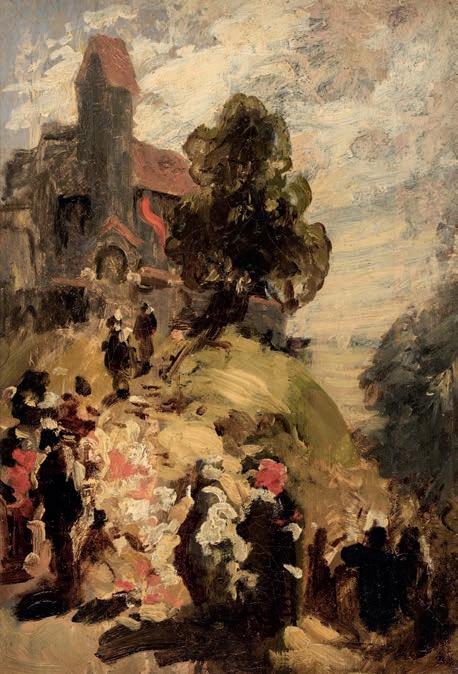
(1) £150 - £200
229* Picabia (Francis, 1879-1953). Three Grotesque Figures, pen and black ink on paper, unsigned, 36.5 x 26.5 cm (14 3/8 x 10 1/2 ins), framed and glazed

Provenance: Collection of Sir Lawrence Gowing (1918-1991).
(1) £300 - £500
230AR* Bénézit (Emmanuel Charles, 1887-1975). La Route de St. Tropez à Gassin, 1920, oil on thin wood panel, signed lower left, titled, dated in artist’s hand to verso, Mercury Gallery London label to verso, panel size 19 x 24 cm (7 1/2 x 9 1/2 ins), framed (27 x 31.8 cm)

Provenance: Private Collection, Gloucestershire.
Emmanuel Charles Bénézit became a pupil of J.P.Laurens and studied at the Academie Julian et Colarossi. His first exhibition in the U.K was at the Mercury Gallery in 1973.
(1) £200 - £400
231AR* Birch (Samuel John ‘Lamorna’, 1869-1955). Lamorna Cove, oil on canvas, signed lower left, canvas size 15.2 x 20.5 cm (6 x 8 1/8 ins), Winsor & Newton stamp to verso of canvas, framed (27.2 x 32.5 cm), together with a letter of provenance from The Moonraker Gallery, Fowey, Cornwall confirming authentication from Sotheby’s Provenance: Private Collection, Cumbria. Purchased by the father of the current owner from The Moonraker Gallery in Fowey, Cornwall.

Apart from a brief period of study at the Atelier Colarossi, Paris in 1895, Birch was largely self-taught. Birch first visited West Cornwall in the late 1880s and settled in the Lamorna Valley in 1892.
(1) £1,500 - £2,000



232* Attributed to Eileen Murray (1885-1962). Continental Scene with Mother and Child, oil on paper, laid onto board, unsigned, size 35.5 x 25.2 cm (14 x 9 7/8 ins), remains of yellow chalk number and artist’s name inscribed in later hand to upper verso of frame ‘Eileen Murray (Irish)’, framed (48 x 38 cm)
(1)
£150 - £200
233* Modern British School. Mother and Child, circa 1910, oil on canvas, depicting a seated lady with red hair, wearing a black gown with white collar, holding a baby aloft, with a glass vase on the table beside, and 2 Japanese pictures hanging on the wall behind, unsigned, stretcher bearing manufacturer's stamp 'Chenil by the Town Hall Chelsea' and remains of paper label 'Charles Chenil & Co. Ltd.', 116.5 x 126.5cm (46 x 50 ins), framed (129.5 x 139.5 cm)
Provenance: Ted Few, London; 'Ted Few: An Idiosyncratic Eye Collection', 24th March 2021, Rosebery's, London, lot 370 (unsold); subsequently sold to the father of the present owner.
Charles Chenil & Co Ltd were picture dealers, artists' colourmen, brush manufacturers, and framemakers, based at 183a, and later also at 181, King’s Road, Chelsea, London. The business operated between 1906 and 1927, and was run by Jack Knewstub, who intended the gallery to form a focal point for London's bohemian artists' set. Knewstub was brother-in-law to both William Rothenstein and William Orpen, and a friend of Augustus John who sold many of his paintings through the Chenil and had a large studio in the garden there. Indeed, Knewstub facilitated shows of a host of other celebrated British modern artists of the period, including Spencer Gore, David Bomberg and William Roberts.
(1)
£700 - £1,000
234AR* Gurschner (Herbert, 1901-1975). Trafalgar Square, London, circa 1930, oil on canvas, signed ‘GURSCHNER’ lower left, re-lined, 58.5 x 70 cm (23 x 27 1/2 ins), unframed
Provenance: Estate of the artist, thence by descent to the present owner. Herbert Gurschner was born in Innsbruck and studied at the Munich Academy of Fine Art. In 1924, he married the English actress Ella Delores Erskine, through whom he was introduced to international hight society and English collectors. He exhibited in England and America from 1925 onwards, including the Fine Art Society in 1929 and 1931, Agnew’s in 1938 and the Cooling Galleries, New York in the same year.
(1)
£2,000 - £3,000
235* Manner of Alfred Munnings (1878-1959). Gypsy Encampment amongst Trees, circa 1920's, oil on panel, depicting two gypsy caravans with horses and handlers in a woodland clearing, 20.2 x 31.2 cm (8 x 12 1/4 ins), framed (25.5 x 36.5 cm)

(1)
£250 - £300
236* Mathews (B., 20th century). Mediteranean Courtyard, circa 1930s, oil on canvas board, signed lower left, 50 x 61.5 cm (19 3/4 x 24 ins), together with another similar from the same artist depicting a busy harbour with shipping, oil on canvas board, signed lower right, 50 x 60 cm (19 3/4 x 23 3/4 ins), the first work unframed, the second with period white painted frame

(2)
£150 - £200
237AR* Cox (Morris, 1903-1998). Man with Horse, 1933, tempera on board, signed and dated lower right, size 68 x 43.4 cm (26 3/4 x 17 1/8 ins), label with printed title, and ‘45’ in white chalk to verso Provenance: From the family of Alan Tucker (1933-2017), Stroud bookseller and poet, and co-author of Morris Cox and the Gogmagog Press (1991).

Exhibited: Morris Cox, Centennial Exhibition - A Selection of Visual Art (1921-1996), 2003.
Morris Cox was a printer, poet, printmaker, painter and puppeteer. At the age of 13 he recieved a scholarship to West Ham School of Art where he studied for 6 years. In 1957 he set up Gogmagog Press resolving to print his own work in his own way. Cox painted in oil and watercolour for over 60 years. In 1994 an exhibition of his work was held at the Victoria & Albert Museum, to celebrate the acquisition of Cox’s personal archive of Gogmagog books and early colour prints.
(1) £700 - £1,000
Lot 236238AR* Rogers (Claude, 1907-1979). Woman in a Black Shawl (Portrait of the Artist’s Wife, Elsie), circa 1935, oil on canvas, relined, with a gallery label of Ernest, Brown & Phillips, Ltd., The Leicester Galleries, and three exhibition labels to verso, and a further handwritten label with the name and address of former owner Mrs Noel Blakiston, 6 Markham Square, S.W.3., 61.5 x 51 cm (24 x 20 ins), antique gilt carved wood frame (77 x 67cm)

Provenance: Mrs. Noel Blakiston, née Georgiana Russell (1903-1995), thence by descent.
Exhibited: Arts Council of Great Britain, British Painters 1939-1945, New Burlington Galleries, London, 1 January - 31 December 1946. Hatton Gallery, King’s College in the University of Durham, Paintings & Drawings by Claude, 14 February - 12 March 1955, catalogue no. 8; and Arts Council of Great Britain, Welsh Committee, British Art and the Modern Movement 1930-40, Cardiff, 13 October - 25 November 1962, catalogue no. 152.
Claude Rogers acted as external examiner to the fine art department at Newcastle between 1954 and 1966.
£2,000 - £3,000
239AR* Cox (Morris, 1903-1998). Negress, 1935, tempera on board with incised lines, signed and dated lower right, size 30.5 x 24.4 cm (12 x 9 5/8 ins), label with printed title to verso

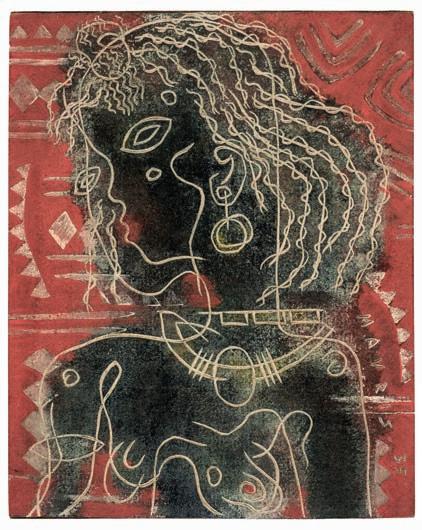
Provenance: From the family of Alan Tucker (1933-2017), Stroud bookseller and poet, and co-author of Morris Cox and the Gogmagog Press (1991). Exhibited: Morris Cox, Centennial Exhibition - A Selection of Visual Art (1921-1996), 2003.
Morris Cox was a printer, poet, printmaker, painter and puppeteer. At the age of 13 he recieved a scholarship to West Ham School of Art where he studied for 6 years. In 1957 he set up Gogmagog Press resolving to print his own work in his own way. Cox painted in oil and watercolour for over 60 years. In 1994 an exhibition of his work was held at the Victoria & Albert Museum, to celebrate the acquisition of Cox’s personal archive of Gogmagog books and early colour prints.
(1) £400 - £600
240AR* Cox (Morris, 1903-1998). Lao Tse, 1937, oil on board with collage (string), signed and dated lower right, size 53 x 34cm (20 7/8 x 13 3/8 ins), label with printed title, and ‘13’ in white chalk to verso Provenance: From the family of Alan Tucker (1933-2017), Stroud bookseller and poet, and co-author of Morris Cox and the Gogmagog Press (1991). Morris Cox was a printer, poet, printmaker, painter and puppeteer. At the age of 13 he recieved a scholarship to West Ham School of Art where he studied for 6 years. In 1957 he set up Gogmagog Press resolving to print his own work in his own way. Cox painted in oil and watercolour for over 60 years. In 1994 an exhibition of his work was held at the Victoria & Albert Museum, to celebrate the acquisition of Cox’s personal archive of Gogmagog books and early colour prints.

(1) £600 - £800
241*
Laid to Rest, watercolour and gouache on paper, laid onto board, depicting a graveyard overlooking a Mediterranean landscape, sheet size 46.3 x 62.3 cm (18 1/4 x 24 3/4 ins), framed and glazed (65.3 x 79 cm)
Debenham attended the Slade School of Art. She then moved to the South of France where she worked with leading French artists and writers such as Matisse, Soutine, de Segonzac and Gide. She regularly exhibited in Paris and London.
(1) £200 - £300
In 1902 at the age of 24 Exley was awarded a scholarship to study at the Royal College of Art, where he spent five years. Exley exhibited work at the Royal Academy, Glasgow Institute, Connell & Sons Gallery, London, the Redfern Gallery, London, and for the Royal Society of Painter Etchers and Engravers.

(1)
£200 - £300
244AR* Cox (Morris, 1903-1998). Bomb Crater, Epping Forest, 1948, tempera on board, signed and dated lower left, size 41 x 61.5 cm (16 x 24 1/4 ins), label with printed title, and ‘42’ in white chalk to verso Provenance: From the family of Alan Tucker (1933-2017), Stroud bookseller and poet, and co-author of Morris Cox and the Gogmagog Press (1991). Exhibited: Morris Cox, Centennial Exhibition - A Selection of Visual Art (19211996), 2003.

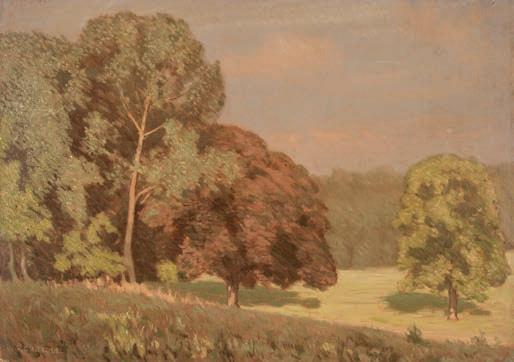
Morris Cox was a printer, poet, printmaker, painter and puppeteer. At the age of 13 he recieved a scholarship to West Ham School of Art where he studied for 6 years. In 1957 he set up Gogmagog Press resolving to print his own work in his own way. Cox painted in oil and watercolour for over 60 years. In 1994 an exhibition of his work was held at the Victoria & Albert Museum, to celebrate the acquisition of Cox’s personal archive of Gogmagog books and early colour prints.

(1)
£400 - £600
243*
Hill, acrylic on board, depicting a wooded landscape, signed lower left, titled and signed to verso, sheet size 24.7 x 34 cm (9 3/4 x 13 3/8 ins), with another similar entitled Purbeck Hills, together with Sketch in Sussex No. 4 & No.3, acrylic on card, one depicting a countryside landscape with farm buildings against a white stone hill, the other depicting a country landscape with a farm building in the distance, both with printed labels to verso with artist’s name in type and title in ink, sheet sizes 12.6 x 21.5 cm (5 x 8 1/2 ins), mounted, plus Blakeney Norfolk, acrylic, depicting a seascape with boats moored by the sand, mount aperture 12.2 x 19.5 cm (4 7/8 x 7 5/8 ins), framed and glazed (24.8 x 29.5 cm), and two folders of artist’s drawings and sketches, mainly in pencil, dated from 1930 -1965, including mainly landscapes and buildings including: Grasmere, Nayland nr Stoke, Norfolk, Morsden, Wells, Blakeney, Shute Devon, Kings Lynn, Hastings, Pulborough, Corfe, Oban, etc., a few include extensive observational notes in pencil, plus a 15 original reference photographs
(8)
Each lot is subject to a Buyer’s Premium of 20% (Lots marked * 24% inclusive of VAT @ 20%)
£200 - £300
Lot 245
242* Exley (James Robert Granville, 1878-1967). Sweet Peas, 1943, oil on canvas, monogrammed lower left, canvas size 51 x 61 cm (20 1/8 x 24 ins), framed (63 x 74 cm) Creps p.173. Needell (Philip Gregory, 1886-1974). Early Morning, Autumn, Mill245AR* Cox (Morris, 1903-1998). Figure with Butterflies, 1948, tempera on board, signed and dated lower right, size 54.8 x 44.5 cm (21 5/8 x 17 1/2 ins), label with printed title, and ‘37’ in white chalk to verso

Provenance: From the family of Alan Tucker (1933-2017), Stroud bookseller and poet, and co-author of Morris Cox and the Gogmagog Press (1991).
Exhibited: Morris Cox, Centennial Exhibition - A Selection of Visual Art (19211996), 2003.
Morris Cox was a printer, poet, printmaker, painter and puppeteer. At the age of 13 he recieved a scholarship to West Ham School of Art where he studied for 6 years. In 1957 he set up Gogmagog Press resolving to print his own work in his own way. Cox painted in oil and watercolour for over 60 years. In 1994 an exhibition of his work was held at the Victoria & Albert Museum, to celebrate the acquisition of Cox’s personal archive of Gogmagog books and early colour prints.
(1) £700 - £1,000
246AR* Stokes (Adrian, 1902-1972). Trees at Hurtwood, 1949, oil on canvas, signed and dated to verso on the stretcher, and label to verso of the frame for the 1982 Arts Council exhibition of the work of Adrian Stokes, the present work listed as number 23 in the catalogue, 32.5 x 24 cm (13 x 9 1/2 ins), wood frame

Provenance: Collection of Sir Lawrence Gowing (1918-1991).
Exhibited: Adrian Stokes, Arts Council touring exhibition, Serpentine Gallery, London, June-July 1982, Huddersfield Art Gallery, July-August 1982, City Museum and Art Gallery, Gloucester, September-October 1982 (catalogue number 23 as Trees at Hurtwood).
(1) £700 - £1,000
247*
century. Parrot, oil on board, showing a parrot on a perch with an Indian Palm Squirrel eating fruit, artist monogram lower left, 75.5 x 49 cm (29.75 x 19.25 ins), framed (91 x 65.3 cm)

(1) £200 - £400
Provenance: Private Collection, Monmouthshire, England.
(1) £300 - £400
Emberson, Colin, 20th 248* MacGowen (Robert, 20th Century). Figure Foreshore, 1950s, watercolour, gouache, and black ink on paper signed lower right, and titled lower left, 38.5 x 31 cm (15 x 12 1/4 ins) mount aperture, period frame, glazed249AR* Cox (Morris, 1903-1998). Ghost of my Great Grandmother, 1951, acrylic on board, signed and dated upper left, size 46 x 38 cm (18 1/4 x 15 ins), label with printed title, and ‘48’ in white chalk to verso Provenance: From the family of Alan Tucker (1933-2017), Stroud bookseller and poet, and co-author of Morris Cox and the Gogmagog Press (1991).

(1) £400 - £600
250AR* Murphy (Myles, 1927-). Head of a Young Man, circa 1955, oil on board, size 59 x 46 cm (23 1/4 x 18 1/8 ins), contemporary manuscript label to verso with artist's name and address, unframed Provenance: From the collection of Craigie Aitchison (1926-2009). The subject of this study may also be Craigie Aitchison.

Myles Murphy was born in Lancashire, and attended local art evening classes taught by L.S. Lowry. His formal artistic education was at the Slade School of Art, where his tutors included Claude Rogers and William Coldstream. When he and fellow student Craigie Aitchison graduated, they won an Abbey Travelling Scholarship and together went to Ravenna. Murphy began teaching at the Slade in 1959, then at Chelsea College up to 1974. He painted throughout his tenure, and his Yellow Nude was acquired for the Arts Council Collection from the London Group in 1964.
(1) £300 - £500
251AR* Stephenson (Ian, 1934-2000). Chair Development, 1955, oil on wooden frame and board, mounted on white painted frame, inscribed by the artist to verso Chair Development 1955 15” x 13 1/4” IStepehnson, additional handwritten pencil label to verso I. Stephenson King’s College Newcastle, signed and dated ‘Chair Development/1955/I Stephenson’ to verso, with additional presentation inscription to verso by the artist ‘for Lawrence with gratitude for his friendship, Roger’, and further inscribed by the artist with title ‘Camer Street R de Grey’, 38.5 x 34 cm (15 1/4 x 13 1/4 ins), overall backing frame size 63.5 x 59 cm (25 x 23 1/4 ins)
Provenance: Collection of Sir Lawrence Gowing (1918-1991).
Born in County Durham, Ian Stephenson is recognised as one of the most important British abstract artists of his generation. He studied at Kings College Newcastle-Upon-Tyne between 1951 and 1956 alongside Noel Forster, where he was taught by Lawrence Gowing, Victor Pasmore, and Richard Hamilton. He featured in the ground breaking Redfern Gallery exhibition Metavisual Tachiste and Abstract Painting in 1957 and held his first exhibition with Noel Forster in London at the New Vision Centre in 1958. His work was included in Antonioni’s iconic film Blow-Up in 1966, and a retrospective of his work Ian Stephenson: Paintings 1955-66 and 1966-77 was held at Hayward Gallery London in 1977 (touring to the Arnofini Gallery, Bristol, and Turnpike Gallery, Leigh-on-Sea). Stephenson returned to Newcastle to take up a post as Director of Foundation Studies in Fine Art at Newcastle 1966 until 1970 alongside Hamilton and Pasmore. His work was described as ‘the most beautiful being made in this country’ in the introduction by Joanna Drew for the catalogue for the 1977 Hayward Gallery retrospective.
£1,500 - £2,000
Each lot is subject to a Buyer’s Premium of 20% (Lots marked * 24% inclusive of VAT @ 20%)

252AR* Camp (Jeffery, 1923-2020). Pakefield in Summer, circa 1959, oil on board, signed lower right, 64.5 x 96.5 cm (25 1/2 x 38 ins), with period label to verso of the Beaux Arts Gallery, 7 Bruton Place, Bond Street, London, an additional price label above for this work dated 14 June 1959, framed

Provenance: Collection of Sir Lawrence Gowing (1918-1991).
(1) £1,500 - £2,000
253AR* Stokes (Adrian, 1902-1972). Still Life with Bottles and Glass, 1959, oil on canvas, signed with painted initials to edge of canvas verso, and dated ‘59, horizontal tear to the canvas towards upper left, generally without loss, approximately 6.5 cm in length, 63.5 x 76 cm (25 x 30 ins), wood frame

Provenance: Collection of Sir Lawrence Gowing (1918-1991).
(1) £1,500 - £2,000
Each lot is subject to a Buyer’s Premium of 20% (Lots marked * 24% inclusive of VAT @ 20%)
254AR* Cox (Morris, 1903-1998). Bird’s Eye View, 1959, tempera on masonite, signed and dated lower right, size 60 x 44 cm (23 5/8 x 17 1/4 ins), label with printed title to verso

Provenance: From the family of Alan Tucker (1933-2017), Stroud bookseller and poet, and co-author of Morris Cox and the Gogmagog Press (1991).
Exhibited: Morris Cox, Centennial Exhibition - A Selection of Visual Art (1921-1996), 2003.
(1) £300 - £500
256AR* Maeckelberghe (Margo, 1932-2014). Chûn Castle West Penrith, 1962, oil on canvas, depicting a view across moorland, a building in the distance, canvas size 35.3 x 46 cm (13 7/8 x 18 1/8 ins), inscribed by artist to verso of stretcher with title and date, framed (49.5 x 59.8 cm), together with a small bundle of posters from various galleries advertising exhibitions including Penwith Society 49-94, etc.,

Margo Maeckleberghe was born in Penzance, where she grew up and lived for most of her life. Her studio was situated at the top of the moors between Penzance and Zennor, and was thus both the actual as well as metaphoric centre of her vision. She studied at Penzance School of Art, and then from 1949 to 1952 attended Bath Academy of Art at its postwar home, Corsham Court in Wiltshire, rather than at the Slade in London where she had also been offered a place. Corsham had become an important centre for modern painting in Britain, whose principal, Clifford Ellis, appointed artists of stature to head its specialist courses; the head of painting was William Scott. many visiting tutors came from Cornwall, including Bryan Wynter, Terry Frost and Peter Lanyon, the latter being a particularly important influence on Margo’s work.
(1) £300 - £500
255AR* Cox (Morris, 1903-1998). Forest Vista, 1960, acrylic on board, signed and dated lower right, size 68.5 x 50.5 cm (27 x 19 3/4 ins), label with printed title, and ‘84’ in white chalk to verso

Provenance: From the family of Alan Tucker (1933-2017), Stroud bookseller and poet, and co-author of Morris Cox and the Gogmagog Press (1991).
(1) £300 - £500
257AR* Yates (Fred, 1922-2008). Polruan, oil on board, depicting figures walking along West Street, Polruan Methodist Chapel to the left, signed lower right, board size 26 x 20.5 cm (10 1/4 x 8 ins), framed (34 x 28.5 cm)
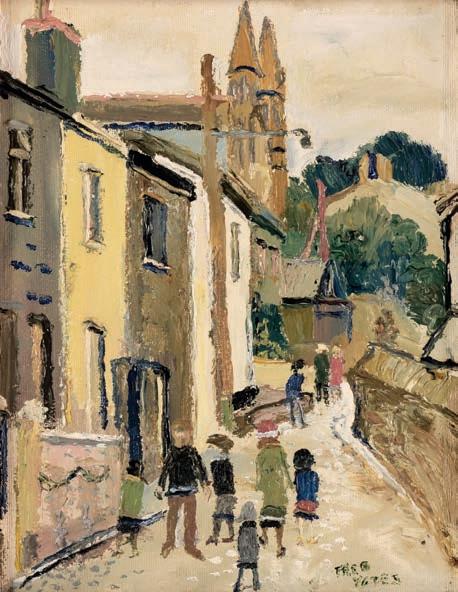
Provenance: Private Collection, Cumbria. Purchased by the father (who lived in the yellow house) of the current owner, from Michael J. Bowman on 28th January 2006. Invoice included in lot.
Fred Yates was born in Manchester in 1922. He served in the Grenadier Guards during the war, and with his serviceman grant enrolled at Bournemouth College where he received a formal education in drawing, printmaking and painting. In 1950 he won a travelling scholarship to Rome and Florence. He resided in Cornwall for nearly thirty years.
(1) £1,500 - £2,000
258AR* Stokes (Adrian, 1902-1972). Still Life with Bottles, 1965, oil on canvas (with manufacturers stamp to verso: Herga prepared by Windsor & Newton Ltd.), signed with initials to verso to edge of canvas verso, and dated ‘65, painted initials ADS to edge of canvas, Marlborough Fine Art label to verso bearing the stock number XLOL 3977, and title Stilllife (16), 59.5 x 72.5 cm (23 1/4 x 28 1/2 ins), wood frame Provenance: Collection of Sir Lawrence Gowing (19181991).
(1) £1,500 - £2,000

259AR* Hitchens (Ivon, 1893-1979). Sand, 1966, oil on canvas, signed lower right, with artist’s handwritten label to verso: ‘SAND’, 1966, 20 1/4 x 41 1/2 Ivon Hitchens, Greenleaves, Petworth, Sussex’, and an additional handwritten care label in the artist’s hand ‘you are advised not to remove this glass without first consulting the artist or the Waddington Galleries’, and small printed stock label for Waddington Galleries bearing the number A2141, 51 x 105 cm (20 x 41 1/4 ins) mount aperture, period painted white and gold wood frame with inset grey fabric slip, glazed (66 x 120 cm)
Provenance: Private Collection, Oxfordshire, UK.
This important painting has been in private ownership since it was purchased by the father of the present owners from Waddington Galleries, London, in the 1960’s. One of a sequence of works exploring the interaction of the reclining nude figure with landscape which preoccupied the artist over a long period.

From the 1950’s Hitchens adjusted his unique language for the painting of landscape to the different demands of the human body, achieving a fluency and authority which is now universally recognised.
(1) £15,000 - £20,000
260* Gaisford (Paul, 1941-). Earl of Kimberley’s Estate, 1975, oil on canvas, depicting a country landscape near Wymondham, Norfolk with cows grazing under the trees, signed and dated ‘75-6’ lower right, size 92 x 121 cm (36 1/4 x 47 5/8 ins), framed Gaisford is a landscape and figure painter, born in Dorking, Surrey. He studied at Camberwell School of Art, the Slade School of Fine Art and the Berlin Academy.
(1) £300 - £500
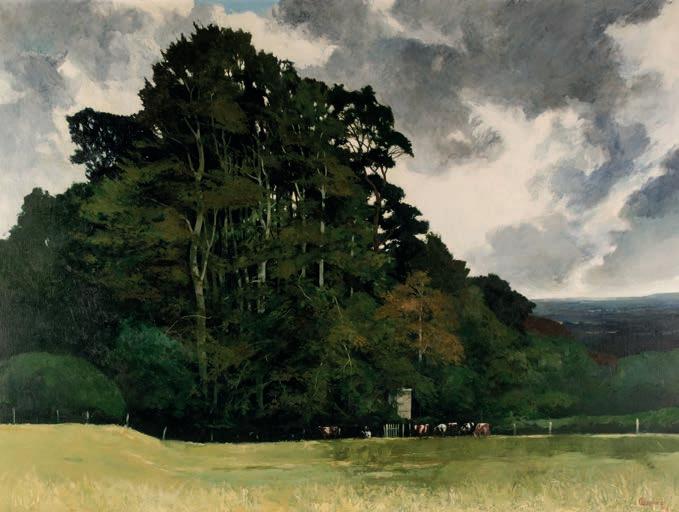
261AR* Maeckelberghe (Margo, 1932-2014). Boscastle, oil on board, depicting a view from the sea looking towards Boscastle harbour and the village, board size 30 x 60.5 cm (11 3/4 x 23 3/4 ins), Sancreed Studios label to verso, framed (43.4 x 73.5 cm), together with a small folder of postcards, some with handwriting from the artist to a friend,
Margo Maeckleberghe was born in Penzance, where she grew up and lived for most of her life. Her studio was situated at the top of the moors between Penzance and Zennor, and was thus both the actual as well as metaphoric centre of her vision. She studied at Penzance School of Art, and then from 1949 to 1952 attended Bath Academy of Art at its postwar home, Corsham Court in Wiltshire, rather than at the Slade in London where she had also been offered a place. Corsham had become an important centre for modern painting in Britain, whose principal, Clifford Ellis, appointed artists of stature to head its specialist courses; the head of painting was William Scott. many visiting tutors came from Cornwall, including Bryan Wynter, Terry Frost and Peter Lanyon, the latter being a particularly important influence on Margo’s work.
(1 and folder)
£300 - £500
263AR* Cotton (Alan, 1936-). Venice Moorings on the Grand Canal, oil on canvas, signed lower left, canvas size 25.5 x 30.5 cm (10 x 12 ins),signed to verso of upper stretcher by artist, title, artist’s name and address to verso of lower stretcher in ink, framed (40.7 x 46 cm) Cotton attended Redditch and Bournville School of Art. Once he graduated from there he joined the Painting School at the Birmingham College of Art. In 2005 Alan was tour artist for the then Prince of Wales when he toured Sri Lanka, Australia, New Zealand and Fiji.

(1) £200 - £300
262AR* Renton (Joan, 1935-). Golden Harvest, oil on board, depicting an abstract landscape, signed lower right, board size 53 x 78 cm (20 7/8 x 30 3/4 ins), framed (64.5 x 88.2 cm)



Provenance: Private Collection, Gloucestershire.
Exhibited: A Festival Exhibition of Paintings of Joan Renton, Young Artists Gallery, Edinburgh City Arts Centre, August - September 1975, No. 52. A copy of the catalogue included with the painting.
(1) £400 - £600
264AR* Batchelor (Mary, 1944-2017). Red Sky at Night & Summer Landscape, together 2 acrylic paintings, the first depicting a setting sun framed by an avenue of trees, the second depicting a low farmhouse surrounded by fields, signed lower left and right respectively, each approximately 15 x 15 cm (6 x 6 ins), matching mounts and glazed frames (37.7 x 37.7 cm), backboard of Red Sky with artist’s printed label and manuscript title label in the artist’s hand
(2) £200 - £300
Each lot is subject to a Buyer’s Premium of 20% (Lots marked * 24% inclusive of VAT @ 20%)
266AR* Cox (Morris, 1903-1998). Phyllis, 1981, acrylic and oil on board with collage, signed and dated lower right, size 60.5 x 46 cm (24 x 18 ins), label with printed title, and ‘385’ in white chalk to verso

Provenance: From the family of Alan Tucker (1933-2017), Stroud bookseller and poet, and co-author of Morris Cox and the Gogmagog Press (1991). Morris Cox was a printer, poet, printmaker, painter and puppeteer. At the age of 13 he recieved a scholarship to West Ham School of Art where he studied for 6 years. In 1957 he set up Gogmagog Press resolving to print his own work in his own way. Cox painted in oil and watercolour for over 60 years. In 1994 an exhibition of his work was held at the Victoria & Albert Museum, to celebrate the acquisition of Cox’s personal archive of Gogmagog books and early colour prints.
(1) £200 - £400
267AR* Cox (Morris, 1903-1998). Bikini Promenade, 1984, acrylic and oil glaze with collage, signed and dated lower right, size 61 x 46 cm (24 x 18 ins), label with printed title to verso

Provenance: From the family of Alan Tucker (1933-2017), Stroud bookseller and poet, and co-author of Morris Cox and the Gogmagog Press (1991). (1) £200 - £400
265AR* Chamberlain (Trevor, 1933-). September Clouds, oil on board, signed lower right, sheet size 18 x 25 cm (7 x 9 7/8 ins), Ash Barn gallery label to verso with artist’s address, framed (26 x 33.5 cm)
(1) £200 - £300

Each lot is subject to a Buyer’s Premium of 20% (Lots marked * 24% inclusive of VAT @ 20%)
268AR* Rooney (Mick, 1944-). Down in the Taverns, 1985, gouache, signed and dated lower right, mount aperture 48 x 32 cm (18 7/8 x 12 5/8 ins), Mercury Gallery Edinburgh label to verso, framed and glazed (66 x 51.5 cm)

Provenance: Private Collection, Gloucestershire.
Exhibited: Mick Rooney, June 20 - July 20 1985, Mercury Gallery, Edinburgh. Mick Rooney studied at the Sutton and Wimbledon School of Art, the Royal College of Art and was the Rome Scholar for 1967-8. He has been exhibited in many galleries and his ‘Still Memories’ exhibition toured throughout Folkstone, Eastbourne, Bath and London in 1989.
(1) £700 - £1,000
269AR* Cox (Morris, 1903-1998). Triptych: Native Village, 1988-89, acrylic on board, in three panels, signed and dated lower right, overall size 46 x 118 cm (18 x 46 1/2 ins), label with printed title, and ‘480a’ in white chalk to verso

Provenance: From the family of Alan Tucker (1933-2017), Stroud bookseller and poet, and co-author of Morris Cox and the Gogmagog Press (1991). (3) £600 - £800 Lot
100
270AR* Rooney (Mick, 1944-). Carriage Cleaners, 1989, tempera and oil on paper, signed and dated lower right, mount aperture 50 x 39.5 cm (19 3/4 x 15 1/2 ins), Mercury Gallery label to verso, framed and glazed (67 x 57.5 cm)

Provenance: Private Collection, Gloucestershire.
Exhibited: Mick Rooney, New Paintings, October 25 - November 25 1989, Mercury Gallery, London, No. 16.

Mick Rooney studied at the Sutton and Wimbledon School of Art, the Royal College of Art and was the Rome Scholar for 1967-8. He has been exhibited in many galleries and his ‘Still Memories’ exhibition toured throughout Folkstone, Eastbourne, Bath and London in 1989.
(1) £1,000 - £1,500
271AR* Rooney (Mick, 1944-). Night Train, 1989, oil and acrylic on paper, signed and dated by artist lower left, mount aperture 28.5 x 17.5 cm (11 1/4 x 6 7/8 ins), Mercury Gallery label to verso, framed (44 x 33 cm)
Provenance: Private Collection, Gloucestershire.
Exhibited: Mick Rooney, New Paintings, October 25 - November 25 1989, Mercury Gallery, London, No. 22.
Mick Rooney studied at the Sutton and Wimbledon School of Art, the Royal College of Art and was the Rome Scholar for 1967-8. He has been exhibited in many galleries and his ‘Still Memories’ exhibition toured throughout Folkstone, Eastbourne, Bath and London in 1989.

(1) £500 - £800
272* Mcmillan (Ian Douglas, 1946-). Landscape Themes, acrylic on canvas, signed on verso by the artist with the title and address, canvas size 71 x 86 cm (28 x 33 7/8 ins), framed (79.5 x 93.5 cm)
Provenance: Private Collection, Gloucestershire.
Exhibited: Festival 1975, Contemporary Art in Scotland, 17 August - 13 September, No. 87.
(1) £200 - £400
273AR* Cox (Morris, 1903-1998). Nimbus, 1990, acrylic on board with collage (including mother of pearl inset), signed and dated upper right, size 51 x 46 cm (20 x 18 ins), label to verso with printed title

Provenance: From the family of Alan Tucker (1933-2017), Stroud bookseller and poet, and co-author of Morris Cox and the Gogmagog Press (1991).
(1) £200 - £400
274* Hawker (Susan, 1949-). Tuscany Landscape, oil on canvas, canvas size 70.5 x 92 cm (27 3/4 x 36 1/4 ins), Jonleigh Gallery label to verso with artist’s name and title in type Hawker studied at the Royal College of Art. She was elected to the Royal Watercolour Society in 1975 and showed work in various group exhibitions at the Royal Academy and Camden Arts Centre. She also had solo exhibitions at Thackeray Gallery and Carlisle City Art Gallery.

(1) £300 - £500
275* Bonney (Peter, 1953-). Shovel and Fork, oil on board, signed and dated lower right, titled to verso, 80 x 68 cm (31 1/2 x 26 3/4 ins), gilt frame (99 x 79 cm), together with Milk Can and Old Door, 2003, oil on board, signed, dated lower right, titled to verso, 80 x 68 cm (31 1/2 x 26 3/4 ins), gilt frame (99 x 79 cm)
(2) £300 - £500

276* Meyer (John, 1942-). Back from the Sneeuberge, 2016, acrylic and mixed media on canvas, signed lower right, signed, titled, and inscribed on the stretcher, 115 x 155 cm (45 1/4 x 61 ins), deep recessed black frame (119 x 158 cm)
South African painter John Meyer is best known for his realistic depictions of landscape, genre scenes, and portraits. Born in 1942 in Bloemfontein, South Africa, he went on to study at Johannesburg Technical College School of Art before working in advertising and as an illustrator in London. He then returned to Johannesburg where he lives and works.
The South African landscape has long been a source of inspiration for Meyer. The present, monumental landscape, suffused with light, is executed in his characteristic hyper realist style – in his words ‘One could say I’m obsessed with the magical properties of paint, with the process that allows for and unlocks the magic.’

Meyer’s work has been exhibited internationally, most recently at Circa Gallery in Johannesburg (2021), the Saatchi Gallery in London (2018), and the Everard Read Gallery in London, Cape Town, and Johannesburg (2008 –2021). In 2015, Lost in the Dust – a body of fifteen works addressing the effects of the AngloBoer War – was exhibited at Everard Read (Cape Town and Johannesburg) and Bonham’s (Edinburgh).
(1)
£20,000 - £25,000
278* LePere (Auguste, 1849-1918). Fin de Journee, 1st state, circa 1889, wood engraving, published by Sagot, numbered ‘9/35 1st Etat’ and signed by artist in pencil to lower margin, publisher’s blindstamp to lower margin, title in pencil to verso, two margins uncut, image size 21.2 x 14.5 cm (8 3/8 x 5 3/4 ins), sheet size 27.2 x 19.5 cm (10 3/4 x 7 5/8 ins), mounted, together with Loups de Mer, circa 1897, colour wood engraving, published by L’Estampe Moderne, numbered ‘130’ from a limited run of 150 on verso, image size 34.2 x 25.2 cm (13 1/2 x 9 1/2 ins), sheet size 55 x 40.4 cm (21 6/8 x 15 7/8 ins), plus two other similar by the same artist, titled: Le Soldat Prussien, and Les Trophees
Lugt 2254.
Lepere was apprenticed at the age of 13 to Joseph Burn Smeeton who was based in Paris. Lepere is considered the leader in the revival of wood engraving in Europe.

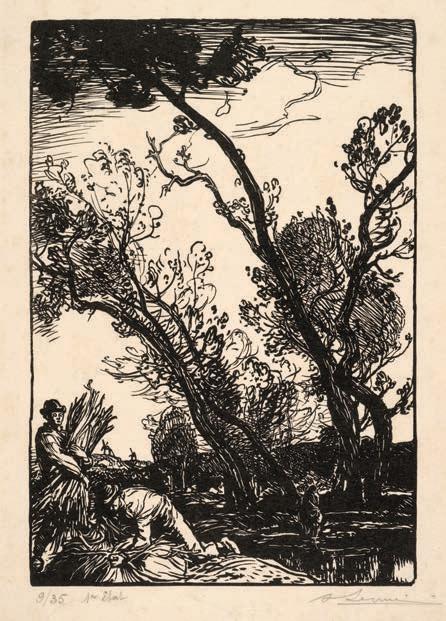

(4) £200 - £300
277* Bewick (Thomas, 1753-1828). Three Dogs (The Bulldog, The Small Water Spaniel and A Terrier), 3 wood engravings printed on one sheet of Barcham Green hand-made paper from the original blocks, printed by Iain Bain on an Albion handpress, published by Merivale Editions in an edition of 500, and numbered 223/500 in pencil, sheet size 29 x 20.2 cm (11.4 x 8 ins), together with The Lesser Redpole (from the History of British Birds, Vol 1, 1797), wood engraving printed on one sheet of 145gsm Zerkall mouldmade paper from the original blocks, printed by Iain Bain on an Albion handpress, published by Merivale Editions in an edition of 500, and numbered 456/500 in pencil, sheet size 29 x 20.7 cm (11 3/8 x 8 1/4 ins)
(2) £70 - £100
280AR* Gibbings (Robert John, 1889-1958). The Mill, 1919, woodcut on cream wove paper, signed and dated in pencil to lower margin, image size 10.8 x 7 cm (4 1/4 x 2 3/4 ins), sheet size 12.5 x 8.9 cm (4 7/8 x 3 1/2 ins)
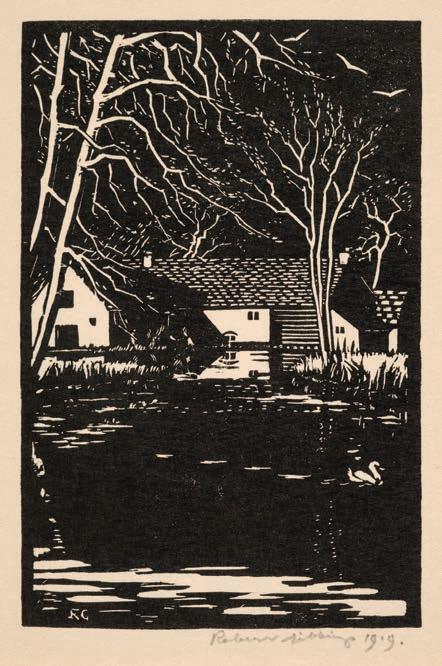
Empson, Wood-Engravings of Robert Gibbings, 11. (1) £150 - £200

281AR* Craig (Edward Henry Gordon, 1872-1966). Robinson Crusoe, wood engraving, dated, signed and numbered 8/50 in pencil to lower margin, slightly toned, two small insect holes to lower right margin, image size 11.3 x 9.2 cm (4 1/2 x 3 5/8 ins), sheet size 18.1 x 12.7 cm (7 1/8 x 5 ins), mounted

(1) £150 - £200
282* Gill (Eric, 1882-1940). St. Bernadette, circa 1926, wood engraving, Cleverdon edition 1929, image size 10.5 x 8 cm (4 1/8 x 3 1/8 ins), sheet size 16.5 x 14.6 cm (6 1/2 x 5 3/4 ins), mounted (1) £100 - £150

283* Lee (Sydney, 1866-1949). Venetian Merchant, 1928, wood engraving, signed in pencil, image size 30 x 38.8 cm (11 3/4 x 15 1/4 ins), sheet size 39.5 x 50 cm (15 1/2 x 19 6/8 ins), mounted (1) £150 - £200
Lot 281
284AR* Hermes (Gertrude, 1901-1983). Borage, circa 1930, wood engraving on cream laid paper, image size 22.6 x 13.4 cm (8 7/8 x 5 1/4 ins), sheet size 32.5 x 23.5 cm (12 3/4 x 9 1/4 ins), mounted (1) £300 - £500

285AR* Leighton (Clare, 1898-1989). Lambing (January from The Farmer’s Year), 1931-32, woodcut on laid paper, the full sheet, signed, titled, marked Second State, and numbered 1/30 by the artist in pencil, a rich, dark impression, image size 20.3 x 26.5 cm (8.1 x 10.5 ins), sheet size 28 x 38 cm (11 x 15 ins), mounted (1)
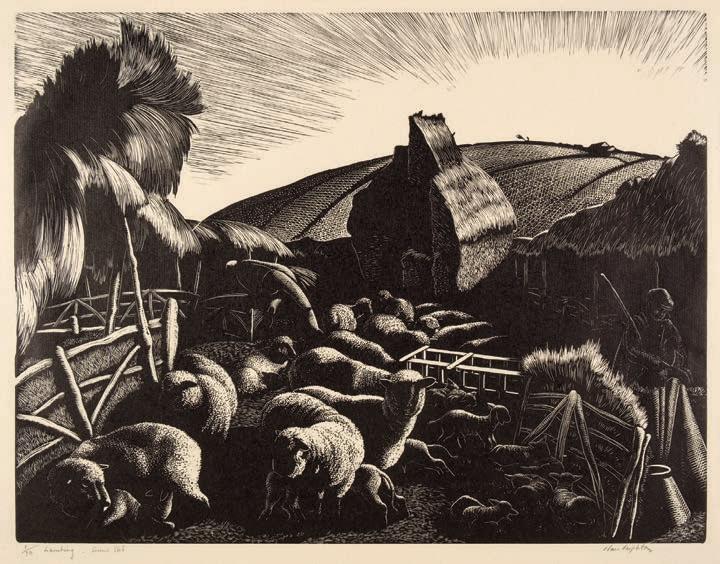
£600 - £800
286* Soper (George, 1870-1942). Seagulls, wood engraving on japon, artist’s stamp to verso, image size 17.8 x 14 cm (7 x 5 1/2 ins), sheet size 23 x 16.8 cm (9 x 6 5/8 ins), mounted, together with Eichenberg (Fritz, 1901-1990). The Shepherdess, woodcut, titled, signed and numbered ‘6/50’, image size 25.1 x 14.3 cm (9 7/8 x5 5/8 ins), sheet size 39.4 x 27.4 cm (15 1/2 x 10 3/4 ins), mounted, plus Rice (Bernard, 1900-1998). The Descent from the Cross, circa 1935, woodcut on thick paper, titled, signed and numbered ‘4/35’ to margins, image size 23.2 x 30.2 cm (9 1/8 x 11 7/8 ins), mounted, together with 14 other woodcuts and engravings by Mills, Wade, Farleigh, E.H.G. Craig, etc., including a reprint of a Reynold Stone, a reproduction of Rockwell Kent’s Angel and two woodcuts by Edward Craig of Ellen Terry and Sir Henry Irving, mounted and framed together (17)

£200 - £300
Lot 286
287AR* Underwood (Leon, 1890-1975). The Ark, wood engraving on japon, signed, small nick to left hand margin, image size 17.9 x 15.9 cm (7 x 6 1/4 ins), sheet size 28 x 20.5 cm (11 x 8 1/8 cm), mounted

Leon Underwood was an influential teacher who taught Henry Moore, Gertrude Hermes, Blair Hughes-Stanton and Roland Vivian Pitchforth at his Brook Green School in London. The Ark was cut for the endpiece of his book Animalia: Or Fibs about Beasts
(1)
£200 - £300
288AR* Hermes (Gertrude, 1901-1983). Monkshood (or Leopardesbayne), circa 1931, wood engraving, some minor stains to margins, image size 23.1 x 13.5 cm (9 1/8 x 5 1/4 ins), sheet size 33.2 x 23.5 cm (13 1/4 x 9 1/4 ins), mounted


Originally published by the Swan Press in 1931.
(1)
£300 - £500
289AR* Leighton (Clare, 1898-1989). The Frightened Shepherd Boy (from Wuthering Heights), circa 1931, woodcut on japon paper, signed, titled, and numbered 24/30 by the artist in pencil, image size 17.9 x 13.4 cm (7 x 5 1/4 ins), sheet size 25.4 x 21.7 cm (10 x 8 1/2 ins), mounted
(1)
£300 - £500
Lot 288290AR* Parker (Agnes Miller, 1895-1980). The Cock and the Jewel, circa 1931, wood engraving, numbered 29/36 in pencil to lower margin, image size 7.8 x 12.4 cm (3 1/8 x 4 7/8 ins), sheet size 13 x 19 cm (5 1/8 x 7 1/2 ins), mounted
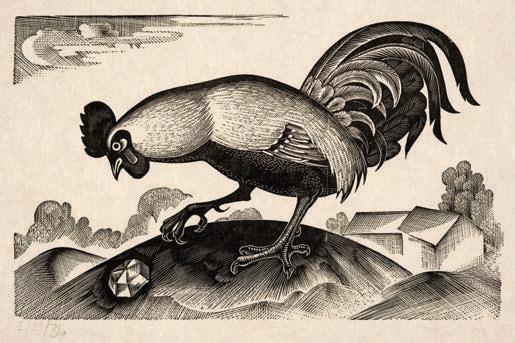
Printed from the original block held in the National Museum of Wales by David Esslemont at Gwasg Gregynog Press.
Agnes Miller Parker studied at Glasgow School of Art from 1911 to 1917. Married to fellow artist William McCance they became part of the Chiswick Group which included Blair Hughes Stanton and his wife Gertrude Hermes. (1) £150 - £200
292AR* Leighton (Claire, 1898-1989). Winter, circa 1932, woodcut, depicting a man bent over holding a stick, carrying a bundle of firewood on his back, signed, titled, and numbered 2/50 by the artist in pencil, image size 23 x 19 cm (9 x 7 1/2 ins), sheet size 30.5 x 24 cm (12 x 9 1/2 ins), mounted Produced for the cover of The Listener, Christmas issue, 1932.

(1) £400 - £600
291AR* Parker (Agnes Miller, 1895-1980). The Fables of Esope, circa 1931, wood engraving, numbered XII/24/30 in pencil to lower margin, image size 7.9 x 12.3 cm (3 1/8 x 4 7/8 ins), sheet size 13 x 19.2 cm (5 1/8 x 7 5/8 ins), mounted

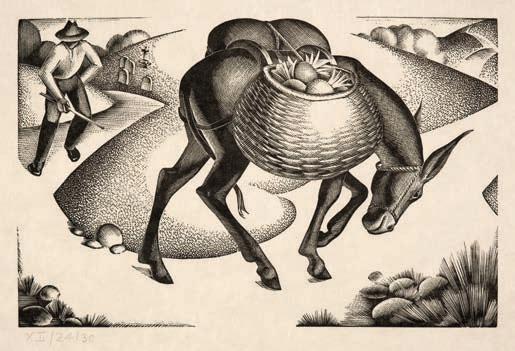
Printed from the original block held in the National Museum of Wales by David Esslemont at Gwasg Gregynog Press.
Agnes Miller Parker studied at Glasgow School of Art from 1911 to 1917. Married to fellow artist William McCance they became part of the Chiswick Group which included Blair Hughes Stanton and his wife Gertrude Hermes. (1) £150 - £200
293AR* Leighton (Clare, 1898-1989). Haymaking (June from The Farmer’s Year), circa 1933, wood engraving, signed, titled, and numbered 3/30 by the artist in pencil, image size 20 x 25 cm (7 7/8 x 9 7/8 ins), mount aperture 21.8 x 27 cm (8 5/8 x 10 5/8 ins), framed and glazed (43 x 47 cm)
(1) £400 - £600
294* Gill (Eric, 1882-1940). The Single Bed, ‘Thanks’ (The Constant Mistress), 1934, wood engraving, signed and numbered 10/20 in pencil, with fore-margins, plate size 9.9 x 7.8 cm (3 7/8 x 3 ins), sheet size 23 x 14 cm (9 x 5 1/2 ins), mounted Physick 875.

(1) £200 - £300
295* Buday (George, 1907-1990). Timon of Athens i-x, 1940, ten wood engravings on japon, each signed, titled, dated and numbered 44/50, image size 22.8 x 13.5 cm (9 x 5 1/4 ins), sheet size 41.7 x 27 cm (16 3/8 x 10 5/8 ins)

Buday produced these engravings for Timon of Athens by William Shakespeare, published, in a limited run of 1950, by The Limited Editions Club, 1940.
(10)
£300 - £500
296 Farleigh (John, 1900-1965). In the End is my Beginning, wood engraving on japon, depicting a large, twisted tree, growing amongst tombstones in a graveyard, image size 47 x 31 cm (18 1/2 x 12 1/4 ins), sheet size 54.5 x 42 cm (21 1/2 x 16 1/2 ins), together with Magnolia, wood engraving on japon, signed, titled and numbered '8/10', image size 14.5 x 10 cm (5 3/4 x 4 ins)

(2)
£200 - £300
297AR* Parker (Agnes Miller, 1895-1980). Hill Tops, 1940, wood engraving on japon paper, signed and titled in pencil by the artist to lower margin, image size 20.5 x 30.5 cm (8 1/8 x 12 ins), sheet size 26.2 x 35.6 cm (10 1/4 x 14 ins), mounted
This wood engraving is shown with a preparatory drawing on page 294-5 of Ian Rogerson’s catalogue raisonne, The Wood Engravings of Agnes Miller Parker. Rogerson suggests this may have been cut for London Transport. Agnes Miller Parker studied at Glasgow School of Art from 1911 to 1917. Married to fellow artist William McCance they became part of the Chiswick Group which included Blair Hughes Stanton and his wife Gertrude Hermes.
(1) £150 - £200
298* Wyatt (Leo, 1909-1981). A Happy Life Consists in Tranquillity of Mind, six wood engravings in various colours on cream paper, including quotes from people comprising: Ben Lieberman, Michelangelo, Cicero, Seneca and Confucius, all but one signed and numbered 75/75, image sizes 21.5 x 16.2 cm (8 1/2 x 6 3/8 ins), sheet sizes 32.8 x 25.5 cm (12 7/8 x 10 ins)
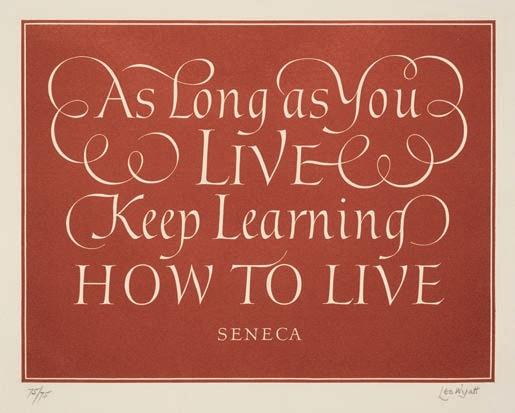
(6) £200 - £300
299AR* Leighton (Clare, 1898-1989). ‘And dared to call the Earth my own’, circa 1941, woodcut on japon paper, signed, titled, and numbered 11/15 by the artist in pencil, originally produced for By Light of Sun by Elsie Syminton published in 1941, image size 15 x 11.5 (5 7/8 x 4 1/2 ins), sheet size 19.3 x 13.2 cm (7 5/8 x 5 1/4 ins) (10 x 8 1/2 ins), mounted
(1)
Each lot is subject to a Buyer’s Premium of 20% (Lots marked * 24% inclusive of VAT @ 20%)
£200 - £400
300AR* Parker (Agnes Miller, 1895-1980). Greeting Card Proof, 1944, wood engraving, black and green end of year card proof 1944-45, image size 7 x 5.5 cm (2 3/4 x 2 1/8 ins), sheet size 21.7 x 11.5 cm (8 1/2 x 4 1/2 ins), part printed (one colour only) on verso, Agnes Miller Parker studied at Glasgow School of Art from 1911 to 1917. Married to fellow artist William McCance they became part of the Chiswick Group which included Blair Hughes Stanton and his wife Gertrude Hermes. While Parker had taught herself the basics of wood engraving Stanton and Hermes encouraged her to refine her talent.


(1) £70 - £100
 Lot 299
Lot 299
301AR* Bliss (Douglas Percy, 1900-1984). Morayshire Crofter, wood engraving, signed, titled and numbered 10/50, image size 10.3 x 15.9 cm (4 x 6 1/4 ins), sheet size 16.7 x 24.5 cm (6 1/2 x 9 5/8 ins), mounted, together with Morayshire Shepherd, wood engraving, signed, titled and numbered 5/50, image size 10.5 x 16 cm (4 x 6 1/4 ins), sheet size 15.7 x 20.8 cm (6 1/4 x 8 1/4 ins), mounted, plus Balmoralism, wood engraving on light brown paper, signed and titled, image size 7 x 9.6 cm (2 3/4 x 3 3/4 ins), sheet size 17.8 x 20.6 cm (7 x 8 1/4 ins)

Provenance: Morayshire Shepherd and Crofter purchased directly from Rosalind Bliss (artist’s daughter).
Bliss trained with Edward Bawden and Eric Ravilious at the RCA School of Design. (3) £200 - £300
302AR* Mayo (Eileen Rosemary, 1906-94). The Squirrel, wood engraving on japon paper, signed, titled and numbered 45/80 in pencil to lower margin, image size 16.6 x 13.4 cm (6 3/8 x 5 1/4 ins), sheet size 19.6 x 18.2 cm (7 3/4 x 7 1/8 ins), mounted

(1) £300 - £400
Lot 302
303* Unwin (Nora Spicer, 1907-1982). Infant Joy, wood engraving on japon, titled, signed and numbered ‘5/30’, image size 14.2 x 9.8 cm (5 6/8 x 3 7/8 ins), sheet size 18.7 x 14 cm (7 2/8 x 5 1/2 ins), mounted, together with Hassall (Joan, 1906-1988). Urania, wood engraving, title page for Urania by Ruth Pitter, London: The Cresset Press, 1950, image size 14 x 8.9 cm (5 1/2 x 3 1/2 ins), sheet size 16.7 x 11.8 cm (6 5/8 x 4 5/8 ins), mounted, along with a similar by the same artist entitled Young Pigeon, plus Clayton (Katharine M, 19th-20th century). Cranes, wood engraving, signed lower margin, image size 3.5 x 7.6 cm (1 3/8 x 3 ins), sheet size 13.3 x 10.2 cm (5 1/4 x 4 ins), mounted, and another wood engraving by Lettice Sandford
(5) £200 - £300

304* Morgan (Gwenda, 1908-1991). In The Barn, circa 1954, wood engraving, signed, titled and numbered 10/30 in pencil to lower margin, engraving for a Christmas card for Sampson Press in 1954, some toning, image size 10.2 x 15.3 cm (4 x 6 ins), sheet size 17.1 x 19.2 cm (6 3/4 x 7 1/2 ins), mounted


Gwenda Morgan was born in Petworth, West Sussex, and studied at Goldsmith’s College of Art in London. She continued her education at Grosvenor School of Modern Art with a focus in wood engraving under Scottish artist Iain Macnab. She exhibited at the Royal Academy and the Redfern Gallery, and was a fellow of the Royal Society of Painter-Etchers and Engravers.
(1) £200 - £300
306* Mackley (George, 1900-1983). Watchtower, circa 1958, wood engraving on Japon, signed, titled, numbered 16/75, some loss to lower left margin, image size 12.7 x 15.2 cm (5 x 6 ins), sheet size 17.9 x 21.3 cm (7 x 8 3/8 ins), mounted

This illustration was used on page 18 of Scene Through a Wood, a century of modern wood engraving curated by Anne Desmet RA for the Ashmolean Museum to mark the 100th anniversary of the Society of Wood Engravers.
(1) £300 - £400
305* O’Connor (John, 1913-2004). African Boy, wood engraving in yellow and black, signed in pencil to lower left margin, image size 7.6 x 10.4 cm (3 x 4 1/8 ins), sheet size 21.4 x 15 cm (8 3/8 x 5 7/8 ins), mounted, together with Girl with Flowers, wood engraving in black, yellow and pink, signed in pencil to lower right margin, image size 7.3 x 10 cm (2 7/8 x 4 ins), sheet size 21.4 x 15 cm (8 3/8 x 5 7/8 ins), mounted

These wood engravings were originally cut for The Oldie magazine and subsequently used in People & Places published by the Whittington Press in 1999.
(2) £100 - £150
307* Morgan (Gwenda, 1908-1991). It’s a Short Walk to the Sea, circa 1960, wood engraving on japon, signed, titled and numbered 4/50 in pencil to lower margin, image size 17.6 x 17.6 cm (6 7/8 x 6 7/8 ins), sheet size 23 x 20.4 cm (9 x 8 ins), mounted
Gwenda Morgan was born in Petworth, West Sussex, and studied at Goldsmith’s College of Art in London. She continued her education at Grosvenor School of Modern Art with a focus in wood engraving under Scottish artist Iain Macnab. She exhibited at the Royal Academy and the Redfern Gallery, and was a fellow of the Royal Society of Painter-Etchers and Engravers.
Each lot is subject to a Buyer’s Premium of 20% (Lots marked * 24% inclusive of VAT @ 20%)
(1) £200 - £300 112
308*
1900-1983).
circa 1962, wood engraving, signed, titled and numbered 42/75 in pencil to lower margin, image size 12.7 x 15.2 cm (5 x 6 ins), sheet size 19.1 x 22.8 cm (7 1/2 x 8 7/8 ins), mounted

(1) £300 - £400
309*
1933-).
II, 1962, wood engraving, signed, titled and dated, image size 9.7 x 9.2 cm (3 7/8 x 3 5/8 ins), sheet size 19.7 x 11.8 cm (7 3/4 x 4 5/8 ins), mounted, together with

Three Vignettes from Under the Hawthorn, wood engraving, signed and numbered 494/500, published by Merivale Editions, each vignette 4.9 x 7.2 cm, sheet size 29.2 x 20.8 cm (11 1/2 x 8 1/8 ins)

(2) £150 - £200
310*
Cow Parsley, circa 1963, wood engraving, signed in pencil, image size 20 x 16 cm (7 7/8 x 6 1/4 ins), sheet size 24.2 x 20.5 cm (9 1/2 x 8 1/8 ins), mounted This wood engraving was produced for Weeds & Wildflowers published in a limited edition of 250 copies by Two Horse Press in 1965. It was also later used in a frontispiece for George Mackley Wood Engraver published by Gresham Books in 1981.
(1) £300 - £400
Mackley (George, Drawbridge, Lot 309 Tute (George Willam, Dandelion Mackley (George, 1900-1983).311AR* Parker (Agnes Miller, 1895-1980). Mayor of Casterbridge, circa 1964, two wood engravings, one showing a well dressed man and woman walking together through woods, the other showing a well dressed young lady peering around curtains, produced for The Mayor of Casterbridge, New York: Limited Editions Club, 1964, both signed in pencil to lower margin, image sizes 15.8 x 9.2 cm (6 1/4 x 3 5/8 ins), sheet sizes 24.4 x 16.4 cm (9 5/8 x 6 1/2 ins), mounted Agnes Miller Parker studied at Glasgow School of Art from 1911 to 1917. Married to fellow artist William McCance they became part of the Chiswick Group which included Blair Hughes Stanton and his wife Gertrude Hermes.
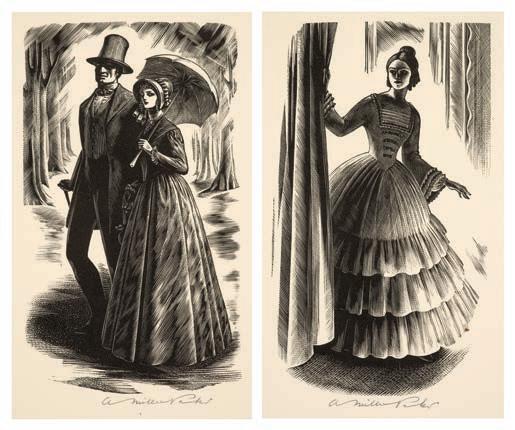
(2) £200 - £300
Lot 313
312* Brookshaw (Percy Drake, 1907-1993). Nine Lives (II), 1970, linocut on light brown paper, signed, titled and numbered 2/6 1st ed in pencil, image size 20.5 x 27.2 cm (8 x 10 6/8 ins), sheet size 26 x 36 cm (10 1/4 x 14 1/8 ins), mounted, together with Nine Lives (I), 1971, linocut on light brown paper, signed, titled and numbered 4/6, edges laid onto card, a few closed tears to lower margin, some spotting, image size 25 x 25.5 cm (9 7/8 x 10 ins), sheet size 31.7 x 36.5 cm (12 1/2 x 14 3/8 ins), mounted Brookshaw trained at the Central School of Arts and Crafts. He designed advertising posters usually depicting sporting events for London Transport between 1928 and 1958. He also taught lithography at Goldsmith’s College School of Art.


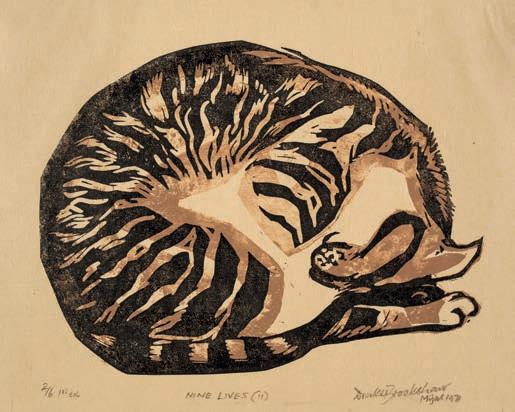
(2) £150 - £200
Each lot is subject to a Buyer’s Premium of 20% (Lots marked * 24% inclusive of VAT @ 20%)
Lot 314
313AR* Poole (Monica, 1921-2003). Foxgloves, circa 1975, wood engraving, signed and numbered 4/175, slightly toned, image size 19.9 x 10.8 cm (7 3/4 x 4 1/4 ins), sheet size 30.8 x 23 cm (12 1/4 x 9 ins), mounted
(1)
£100 - £150
314* Smith (Richard Shirley, 1935-). Rhinoceros Beetle, 1978, wood engraving, signed, dated and numbered 95/100, engraved for Buzz Buzz published by Gruffyground Press, 1981, image size 11.5 x 9.4 cm (4 1/2 x 3 3/4 ins), sheet size 24.5 x 14.9 cm (9 5/8 x 5 7/8 ins), mounted, with an unsigned duplicate, together with The Dark Tower, Ozymandias and Monuments in the Desert, 1970, three wood engravings, all signed and dated artist’s proofs, engraved for The Poems of Percy Bysse Shelley, published by the Limited Editions Club, 1971, image sizes approximately 8.9 x 6.5 cm (3 1/2 x 9/16 ins), sheet sizes 18.4 x 15.6 cm (7 1/4 x 6 1/8 ins), plus Nine Vignettes from The Gourmet’s Garden, 1986, wood engraving printed in green, signed, dated and numbered 7/500, published by Merrivale Editions, each vignette 40 x 30 mm, sheet size 29.2 x 20.8 cm (11 1/2 x 8 1/4 ins), and a letter and a card from the artist (7) £200 - £300
315* Lawrence (John, 1933-). Of Birds and Beasts, 1989, wood engraving, signed, titled, dated and numbered ‘19/50’ in pencil to lower margin, engraved for The New Treasury of Poetry published by Blackie, 1990, image size 20.3 x 15.2 cm (8 x 6 ins), sheet size 35.6 x 24 cm (14 x 9 1/2 ins), mounted, together with The Four Seasons, four wood engravings, all signed, titled, dated and numbered ‘46/120’, printed from the original blocks cut for The Magic Apple Tree by Susan Hill, 1982, reissued by The Fleece Press, 1997, image size 20.3 x 14.4 cm (8 x 5 5/8 ins), sheet size 31.4 x 22 cm (12 3/8 x 8 5/8 ins), plus


John Clare’s England, three vignettes, wood engraving, signed and numbered ‘409/500’, published by Merrivale Editions, each vignette 6 x 9 cm, sheet size 29.3 x 20.6 cm (11 1/2 x 8 1/8 ins), and two other similar engravings produced for The Shepherd’s Calendar published by the Whittington Press, 1978, all but one signed
(5) £200 - £300
Lot 315
316* Niekerk (Sarah Van, 1934-2018). Signora Fernando, wood engraving, signed, titled and numbered ‘1/100’, image size 20.4 x 14.8 cm (8 x 5 3/4 ins), sheet size 32 x 23 cm (23 5/8 x 9 ins), mounted, together with Rooks, 1990, wood engraving, signed, dated, titled and numbered ‘9/120’, image size 11.5 x 9 cm (4 1/2 x 3 1/2 ins), sheet size 25.2 x 19.4 cm (9 7/8 x 7 5/8 ins), mounted, plus
Three Sheep, wood engraving, three vignettes, signed, titled and numbered ‘58/500’, vignette size 5.1 x 7.5 cm, sheet size 29.4 x 20.6 cm (11 1/2 x 8 1/8 ins), mounted, and another similar artist’s proof entitled Market, signed in pencil
(4) £100 - £150
317* Brett (Simon, 1943-). The Ugly Beast, wood engraving, signed, titled and numbered '244/500', image size 10 x 12.6 (4 x 5 ins), sheet size 20.7 x 29.1 cm (8 1/8 x 11 1/2 ins), printed directly from the block at Rocket Press, Blewberry, presented in a printed Merrivale Editions folder, also with Cadenza Letters by the same artist, signed, titled and numbered '2/50', together with Phipps (Howard, 1954-). Afternoon Tea, 1990, wood engraving, signed, dated and numbered 'Ap', image size 12.7 x 8.2 cm (5 x 3 1/4 ins), sheet size 19.6 x 15.6 cm (7 3/4 x 6 1/4 ins), mounted, plus Brett (Simon, 1943-). The Ugly Beast, wood engraving, signed, titled and numbered '244/500', image size 10 x 12.6 (4 x 5 ins), sheet size 20.7 x 29.1 cm (8 1/8 x 11 1/2 ins), printed directly from the block at Rocket Press, Blewberry, presented in a printed Merrivale Editions folder, also with Cadenza Letters by the same artist, signed, titled and numbered '2/50', plus Garton & Co (publishers). The Wood Engravings, An Explorer, Cows and Old Tree, three wood engravings after John Nash, Eric Ravilious and Reynolds Stone, all numbered 'A 2/10', largest image size 11.4 x 8.3 cm (4 1/2 x 3 1/4 ins), sheet size 30.2 x 23.9 cm (11 7/8 x 9 3/8 ins), in an envelope style folder, and eight other wood engravings by various artists including: Paul Kershaw, Clare Curtis, Jeroen van Duyn, Miriam MacGregor, Kenneth Lindley, Hilary Paynter (12) £200 - £300

318* Wormell (Christopher, 1955-). An Alphabet of Animals, 1990, linocut printed with colour, title page for An Alphabet of Animals by the artist, signed, dated and numbered 3/50, image size 20.5 x 20.5 cm (8 1/8 x 8 1/8 ins), sheet size 31.8 x 23 cm (12 1/2 x 9 ins), together with a signed copy of the book published by Collins, 1990 The artist produced the linocuts for his son Jack, they were subsequently published by Collins in 1990.

(2) £100 - £150
319AR* Desmet (Anne, 1964-). Rotunda x 4, wood engraving, four vignettes, signed and titled, ‘A/P’ and ‘To Ann with best wishes’ in pencil to lower margin, some spotting, each vignette approximately 8.8 x 7.4 cm, sheet size 22.7 x 50.8 cm (8 7/8 x 20 ins), mounted Anne Desmet was born in Liverpool, UK, in 1964. She gained a BA & MA at the Ruskin School of Art, Oxford University, and a Postgraduate Diploma in Printmaking at Central School of Art and Design, London, UK. Desmet was elected a member of the Royal Academy of Arts and is only the third wood engraver ever elected to the RA in its entire history.

(1) £100 - £150
Lot 319
13 ins), old frame, glazed, with framers label of Charles Chenil 7 Co., Ltd., 183a, King’s Road, Chelsea to verso Schwabe 44.
(1) £200 - £300
Cameron was a very influential etcher. He studied at Glasgow School of

before joining life classes at the Royal Scottish Academy. During the First World War, Cameron was appointed official war artist to the Canadian government and in 1933 was made the King’s Painter in Scotland.
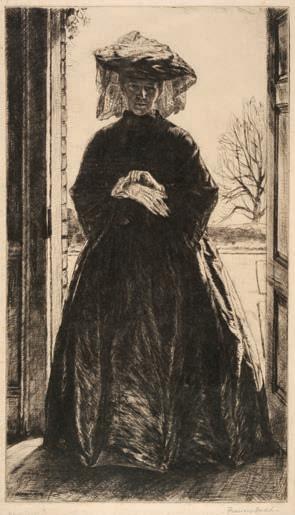

(1) £150 - £200

324* Cheston (Charles Sidney, 1882-1960). Somerset and Dorset, group of 8 landscape etchings, etching, all signed in pencil, depicting scenes including: The Storm, Purbeck, Aller Hill and Studland Farm, etc., image size 16.9 x 22.8 cm (6 5/8 x 9 ins), sheet size 22.4 x 30 cm (8 3/4 x 11 3/4 ins), all framed and glazed (8) £100 - £150

326* Landscapes. Osborne (Malcolm, 1880-1963). Holyrood Palace, 1913, drypoint etching, signed in pencil, faint mount stain, small stain to right edge of margin, plate size 22.9 x 28.9 cm (9 x 11 3/8 ins), sheet size 29.5 x 40.4 cm (11 5/8 x 15 7/8 ins), hinge mounted, together with Baskett (Charles Henry, 1872-1953), The Dawn Wind, etching with aquatint, signed and titled in pencil, some adhesive marks to blank margins, plate size 34.4 x 51.5 cm (13 1/2 x 20 1/4 ins), sheet size 41 x 56.5 cm, hinge mounted plus Angus (Stanley, active 1932-1938), City Hall London [actually Middlesex Guildhall], drypoint etching, titled and signed Angus within platemark, signed in pencil to lower right margin, pencilled title The Guildhall in margin, adhesive tape staining to top and bottom margin edges, plate size 41.8 x 21.3 cm (16 1/2 x 8 3/8 ins), sheet size 49.5 x 28.5 cm, with 6 other etchings comprising: 4 by Edward W. Sharland (1884-1967), including the Moat at Bristol Castle, Rouen Cathdedral, Chester Cathedral, and a city docks scene; one by Russell Sidney Reeve (1895-1970), circus folk with camel and giraffe; and one by an unidentified artist, entitled Bruges


(9) £150 - £200
325* Anderson (Stanley, 1884-1966). The Hedger, copper line engraving on laid paper, signed in pencil, inscribed 'Ed:50', titled 'The Hedger. (Line engraving). Edition 50 prints', by the artist to lower margin, some overall toning to image, plate size 18.8 x 15 cm (7 3/8 x 5 7/8 ins), sheet size 31.6 x 25.8 cm (12 1/2 x 10 1/4 ins), framed and glazed (42.5 x 38 cm) Meyrick and Heuser, 210.
First exhibited at the 166th exhibition of the Royal Academy of Art in 1934, number 1264. (1) £70 - £100

327* Walcot (William, 1874-1943). A Tragedy of Sophocles at Hadrian’s Villa, 1913, etching with aquatint on cream wove paper, signed in pencil, pale mount stain, some light spotting, plate size 43.4 x 46.4 cm (17 1/8 x 18 1/4 ins), sheet size 66.7 x 67.3 cm (26 1/4 x 26 1/2 ins), hinge mounted, limited edition 68 copies, together with: Anthony in Egypt No.1 - A Visit to Cleopatra, 1913, etching and aquatint on cream wove paper, signed in pencil, mount stain, some spotting (mainly to margins), two faint scratches to upper left area, plate size 54.7 x 45.9 cm (21 1/2 x 18 ins), sheet size 67.8 x 55.3 cm (26 3/4 x 21 3/4 ins), hinge mounted, limited edition 50 copies
Tragedy: Dickins 1; E H-L 14. Walcot’s R.E. (Royal Society of Painter-Etchers) Diploma print.
Anthony: Dickins 4; E H-L 17.
(2)
328* Brodsky (Horace Ascher, 1885-1969). Expulsion, 1914, linocut on wove paper, this impression hors commerce, aside from the edition of 75 published impressions, signed in pencil lower left and marked H/C lower right, image size 26 x 16.5 cm (10 1/4 x 6 1/2 ins), with margins, framed and glazed (unexamined out of frame), together with Seaby (Allen William, 1867-1953). Lapwings, colour woodcut, unsigned, image size 21.5 x 21.5 cm (8 1/2 x 8 1/2 ins), sheet size 24.5 x 24 cm (9 1/2 x 9 1/2 ins), framed and glazed, plus Richter (Heinrich, 1884-1981). Abstract Female, 1965, lithograph, signed, dated and numbered ‘10/50 Für Peter’, sheet size 21 x 21.9 cm (8 1/4 x 8 5/8 ins), and one etching by Christof Seiz

(2)
£100 - £150
329* Sickert (Walter Richard, 1860-1942). Ennui (The Medium Plate), 1914/15, etching on laid paper, with watermark of a unicorn and letters F J (probably F. J. Head), the rare first state, before all lettering, issued circa 1925 (the final state was advertised in 1929), signed and titled ink, slight diagonal paper flaw from the upper margin into the image, heavy mount stain, plate size 227 x 175 mm (9 x 6 7/8 ins), sheet size 305 x 220 mm (12 x 8 5/8 ins)

Provenance: Collection of Sir Lawrence Gowing (1918-1991).
Bromberg 156 i/vi. The rare first state of one of Sickert’s most famous prints, for which Bromberg lists only two impressions (Private Collection, formerly Sir Hugh Walpole, and Victoria & Albert Museum). An impression of the first state was exhibited at the Leicester Galleries exhibition of Sickert’s prints in 1925.
(1) £1,500 - £2,000
£200 - £300330* Walcot (William, 1874-1943). The Trojan Horse - Virgil’s Aeneid II, 1914, etching with aquatint on thick wove paper, published in an edition of 29 impressions, signed in pencil, mount stain to margins, some pale spotting, plate size 62.8 x 82.3 cm (24 3/4 x 32 3/8 ins), sheet size 66.3 x 86.3 cm (26 1/8 x 34 ins), hinge mounted Dickins 20; EH-L 35.

(1) £150 - £200
331* Sickert (Walter Richard, 1860-1942). The Old Bedford (The Large Plate), 1915, etching on pale cream wove paper, the 4th state (of 12), some mount toning, hairline horizontal tear (without loss) to the upper right blank margin just below the platemark (approximately 4.5 cm), the plate printed slightly obliquely onto the sheet, plate size 265 x 156 mm (10 1/2 x 6 1/4 ins), sheet size 326 x 254 cm (12 7/8 x 10 ins), tab-mounted, framed and glazed Provenance: Collection of Sir Lawrence Gowing (1918-1991). Bromberg 130 iv/xii.

(1) £600 - £900
332* Soper (George, 1870-1942). Summer, the Last Load, drypoint etching on pale cream wove paper, signed in pencil, laid down on backing card, and outer blank edges of the sheet with heavy glue residue, sheet size 29.5 x 42.5 cm (11 1/2 x 16 3/4 ins), framed and glazed with period printed label of James Connell & Sons., 47 Old Bond Street, London to verso, together with another by the same artist

Feeding Time, drypoint etching, signed in pencil, 19.4 x 32 cm (7 5/8 x 12 5/8 ins), framed and glazed with period printed label of James Connell & Sons to verso, plus an etching of a river landscape by Joseph Knight (1837-1909), signed in pencil, framed and glazed, with period printed label of George Barm dealer in works of art, 69 Bradshawgate, Bolton to verso (frame size 58 x 48.5 cm)
(3) £100 - £150
333* Nevinson (Christopher Richard Wynne, 1889-1946). Column on the March, 1917, offset colour lithograph on thin wove, signed in pencil lower right, sheet size 287 x 220 mm (11.3 x 8.7 ins), as issued in the book Modern War Paintings by C.R.W. Nevinson, with an introductory essay by P. G. Konody, 1st edition, London: Grant Richards Ltd., 1917, monochrome plates, untrimmed, original green cloth-backed boards with printed paper title labels to upper cover and spine, one or two minor marks, in printed dustwrapper, some wear with loss to spine, otherwise in very good condition, 4to (1) £300 - £500

334* Walcot (William, 1874-1943). First Wooden Temple of Jupiter, 1918, etching with drypoint and aquatint on cream wove paper, published in an edition of 100 proofs, signed in pencil, tiny foxing spot to upper plate edge, small brown mark to left margin, plate size 12.5 x 17.7 cm (5 x 7 ins), sheet size 22.8 x 28.2 cm (9 x 11 1/8 ins), mounted, together with Emperor Hadrian entering Salonica, 1918, etching with drypoint and rockerwork on cream wove paper, published in an edition of 150 proofs, signed in pencil, lightly toned, one pale foxing spot to right side, plate size 7.9 x 12.6 cm (3 1/8 x 5 ins), sheet size 22.6 x 27.8 cm (8 7/8 x 11 ins), mounted, plus The Sacred Fair, Egypt, circa 1918, etching with drypoint and aquatint on cream wove paper, published in an edition of 51 proofs, signed in pencil, lightly toned, two small brown spots (one to right side, one to lower edge), closed tear towards upper right corner (previously repaired on verso), plate size 15.9 x 22.8 cm (6 1/4 x 9 ins), sheet size 26.8 x 39.3 cm (10 1/2 x 15 1/2 ins), mounted, and St. Peter’s, Rome, 1919, etching on cream wove paper, published in an edition of 246 impressions, signed in pencil, plate size 15.1 x 17.4 cm (6 x 6 3/4 ins), sheet size 42.6 x 30.3 cm (16 3/4 x 12 ins), mounted, plus Villa Quintilii, 1921, drypoint with etching and aquatint on cream wove paper, edition of 400 impressions, signed in pencil, lightly toned, some foxing spots, mainly to margins, plate size 18 x 25.4 cm (7 1/8 x 10 ins), sheet size 28.6 x 34.8 cm 11 1/4 x 13 3/4 ins), mounted Dickins 47, 48, 27, 60 and 71; Elizabeth Harvey-Lee 68, 69, 42, 83 and 98, respectively.

(5) £200 - £300
335* Hampshire (Ernest Llewellyn, 1882-1944). St. Paul’s Cathedral from the Thames, etching, signed and titled in pencil, light mount toning, plate size 150 x 230 mm, with margins, together with Trafalgar Square, London, etching, signed and titled in pencil, and three other etchings by Ernest Hampshire: Windsor Castle, York Minster, and Bath Abbey, all signed, plus one other small etching of Westminster by Maria Eaton, signed, all framed and glazed (6) £100 - £150
 Lot 334
Lot 334
336* Wyllie (William Lionel, 1851-1931). London Bridge, etching and drypoint on pale cream wove paper, signed in pencil lower left, plate size 124 x 327 mm (4 7/8 x 12 7/8 ins), 195 x 410 mm (7 3/4 x 16 ins), window-mounted

(1)
£200 - £300
337* Nieuwenkamp (Otto Wynand, 1874–1950). View in Dordrecht, 1897, from the set of six etchings by Nieuwenkamp and Johannes Graadt van Roggen (1867-1959), etching on wove paper, a very good impression printed in brown-black, printing with atmospheric contrasts, signed in pencil, titled ‘Dordrecht’ and numbered 1-35 No 4, with the blindstamp of the publisher P.J. Zürcher, The Hague, with margins, adhered to the backing board towards the sheet edges, generally in good condition, plate size 28.3 x 20.3 cm (11 x 8 ins), sheet size 40.3 x 30.5 cm; together with Armand Guillaumin (1841–1927), Vue prise de Saardam, etching printed in red and olive green, from the1906 first edition of “Histoire des Peintres Impressionnistes” by Theodore Duret, published by Floury, Paris; Jozef Israëls (1824-1911), The Odd Couple, 1873, two impressions, etchings on Arches laid paper (one with a partial Arches watermark), and Charles West Cope, Hush, 1878, etching on laid paper, a very good proof impression before letters, signed in pencil (the etching was published by The Etching Club, 1879); and Hope Deferred, 1877, etching on laid paper, a very good impression, signed in pencil, both with wide margins, largest sheet size 44 x 29 cm

(6)
£150 - £200
338* Sickert (Walter Richard, 1860-1942). Cicely Hey (The Small Plate), circa 1923, etching, the second state (of 2), plate size 145 x 73 mm, framed and glazed, with Ernest Brown & Phillips, Ltd. The Leicester Galleries label to verso Provenance: Collection of Sir Lawrence Gowing (1918-1991). Bromberg 212, II/II.
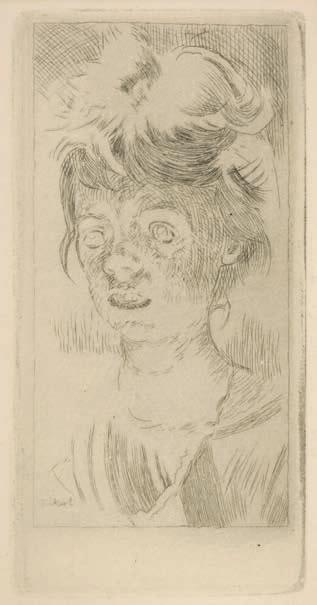
(1)
£400 - £600
Lot 337339* Sickert (Walter Richard, 1860-1942). Jack Ashore (Small Plate), 1923, etching on laid paper, plate size 181 x 134 mm (7 1/8 x 5 1/4 ins), some overall brown discolouration from backing board, sheet size 29 x 21.5 cm (11 1/2 x 8 1/2 ins), framed and glazed Provenance: Collection of Sir Lawrence Gowing (1918-1991). Bromberg 214, ii/ii.

(1) £200 - £300
341* Pierneef (Jakob Hendrik, 1886-1957). Bolandse Plaas, Krommerivier, 1925, linocut on thin japan tissue, signed and dated 1925 in pencil, hairline horizontal tear to the image lower left (without loss), light creases, mounted to sheet edges with short strips of masking tape, image size 138 x 201 mm, sheet size 155 x 202 mm, framed and glazed with printed label to verso of Woodart, 70 Salt River Rd., Woodstock, Cape Town to verso
Nilant (F.E.G.) Die Hout- en Linosneë van J. H. Pierneef. (Cape Town: A .A. Balkema, 1974), 16.
Famous for his linocut views depicting Cape Dutch architecture, South African artist Pierneef kept the majority of his blocks and pulled impressions on demand. This helps to explain the sometimes differing dates inscribed by the artist on different impressions of the same work.

(1) £300 - £500
342AR* Tunnicliffe (Charles Frederick, 1901-1978). The Old Quarry Road, 1926, etching, a very good impression, on laid paper, signed in pencil and numbered 62/75, with a small margin at bottom, otherwise trimmed to the platemark, slight discolouration verso, generally in good condition, sheet size 23 x 30.2 cm (9 x 11 7/8 ins)

(1) £150 - £200
340AR* Brockhurst (Gerald Leslie, 1890-1978). Corinne, 1925, etching on cream laid paper, one of 106 proofs of the fifth state published December 1925, signed in pencil, plate size 139 x 102 mm (5.5 x 4 ins), sheet size 286 x 211 mm (11.25 x 8.3 ins) Wright 50 v/v & 14. Fletcher 50 & 14.

(1)
£200 - £300
343* Phillips (Walter Joseph, 1884-1963). Jim King’s Wharf, Alert Bay, British Columbia, 1927, colour woodcut on japan paper, signed, titled and numbered 100/100 in pencil to lower margin, image size 27.5 x 20.5 cm (10 7/8 x 8 1/8 ins), period frame, glazed, with label to verso of Aldridge Bros. Art Dealers Picture Restorers and Frame Makers, The Little Gallery, Worthing, frame size 52 x 40 cm Anglo-Canadian artist Walter Joseph Phillips was born in Lincolnshire, and studied at the Municipal School of Art in both Birmingham and Great Yarmouth. In 1913 he emigrated to Winnipeg, where he found employment as a teacher. By 1917, he had begun to experiment with the colour woodcut, eventually publishing The Technique of the Colour Woodcut in 1926. The following year Phillips made his first trip to the west coast of British Columbia, visiting Alert Bay and Village Island.

In his unpublished manuscript entitled Wet Paint (available at wjphillips.ca/wet-paint), the artist describes the present work: ‘some of the coastal steamers tie up at the end of this crazy wharf, and discharge consignments of groceries and other articles of commerce, for the genial Chinese merchant Jim King, whose store stands at the shore end of it. The tide races along Johnstone Straight between the shore and Vancouver Island, whose snow-capped peaks may be seen in the distance. An Indian dug-out canoe is passing - admire its graceful lines. Gasoline-driven fishing boats - trollers and seiners, tramp steamers and launches pass us frequently, and the big liners that ply between the great southern ports of Alaska, at regular intervals. It has become a busy sea-way. The composition does not present any feature of outstanding interest. The canoe was introduced for balance, and to help lead the eye to the end of the wharf, which is the focal point. A distant island is connected with the wharf on the picture plane by intrusive lines and parts, and the vertical direction of the piles merges gradually into the horizontal by virtue of their spreading reflections.’
(1) £1,000 - £1,500
344AR* Tunnicliffe (Charles Frederick, 1901-1979). The Kestrel, 1927, etching with drypoint on laid paper, from the published edition of 75 impressions, signed and numbered 32/75 in pencil, plate size 253 x 358 mm (10 x 14 1/8 ins), sheet size 285 x 405 mm (11 1/4 x 16 ins)
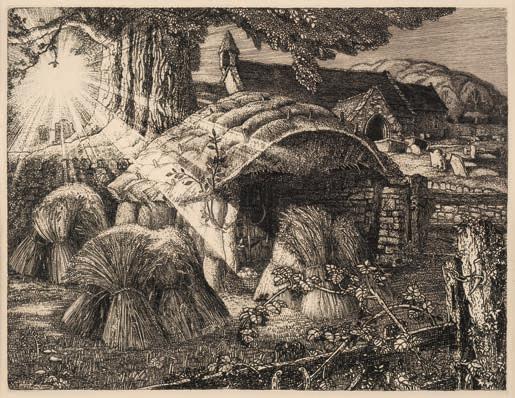

(1) £300 - £500
345AR* Tanner (Robin, 1904-1988). Martin’s Hovel, 1927, etching on pale cream heavy wove paper (with partial blindstamped title visible to extreme lower right blank corner for the Robin Tanner Memorial Portfolio), likely to have been issued by Merivale Editions in 1989, but an unnumbered impression aside from the published edition of 100, artist’s name and date etched in the image lower left, plate size 16 x 18.8 cm (6.4 x 7.5 ins), sheet size 29.5 x 34.7 cm (11 5/8 x 13 5/8 ins), framed and glazed (42.4 x 43.2 cm) Garton 3.
According to Garton the hovel is based on a farm building in Allington near Chippenham. As with most of Tanner’s work the image is an amalgamation of studies including Saint Nicholas Church at Biddestone, the gate with a cowhorn fastening in Upper Castle Combe and a tree on a ha-ha wall in Corsham.
(1) £200 - £300
346* Icart (Louis, 1888-1950). Danseuse, from Dessins de Louis Icart, circa 1928, offset lithograph printed in black, white and pink on buff paper, signed in pencil, apparently in good condition, unexamined out of the frame, 44.5 x 34.2 cm (17 1/2 x 13 3/8 ins), framed and glazed (71 x 60 cm)

(1) £150 - £250
348AR* Badmin (Stanley Roy, 1906-1989). Evening Light, near Sevenoaks, 1929, etching on laid paper, a fine artist’s proof on antique Dutch laid paper (watermarked with shield and ‘Charles I’), aside from the edition of 40 published by XXI Gallery, signed and titled in pencil, additionally inscribed by him ‘To David & Mary on their 25th’, plate size 130 x 166 mm (5.1 x 6.5 ins), sheet size 222 x 270 mm (8 7/8 x 9 5/8 ins), framed and glazed, with label to verso (by the artist) giving the title of the work as ‘Evening Light (near Sevenoaks & Riverhead)’, and artist’s name, publication details, further inscribed ‘To David & Ellen Downey on their 25th Anniversary’ Beetles 16.
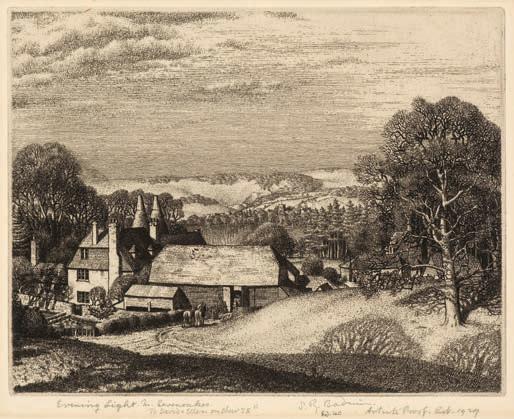

(1) £300 - £500
347*AR* Tanner (Robin, 1904-1988). Wiltshire Hedger, 1928, etching on cream laid paper, a fine, rich impression of the rare first state (of three), before the vertical shading on the façade of the house and the bank before it, signed and dated ‘28 in pencil lower right, and numbered II in roman numerals lower left, mount-stained, the full sheet, small squares of brown gummed paper to outer corners verso, plate size 100 x 148 mm, sheet size 198 x 266 mm Garton 7.
The second state was published by Nicholson in an edition of 50 in 1928, while the third state was published in an edition of 12 much later by Garton & Cooke. Another impression of the first state, numbered XVI in roman numerals (as here), was sold in these rooms on 23 July 2021, lot 456.
(1) £1,500 - £2,000
349* Burnley (Cynthea B., 1900-1964). Bloomsbury, 1929, wood engraving on fine japan paper, this impression unnumbered (there was an edition of 35 signed impressions), signed and titled in pencil to lower margin, image size 156 x 112 mm (6 1/8 x 4 3/8 ins), sheet size 205 x 167 mm (8 x 6 1/2 ins), framed and glazed

Cynthea Burnley was born in Bradford and studied sculpture at the Royal College of Art, graduating in 1931. She exhibited at the Society of Wood Engravers and the Redfern Gallery, London.
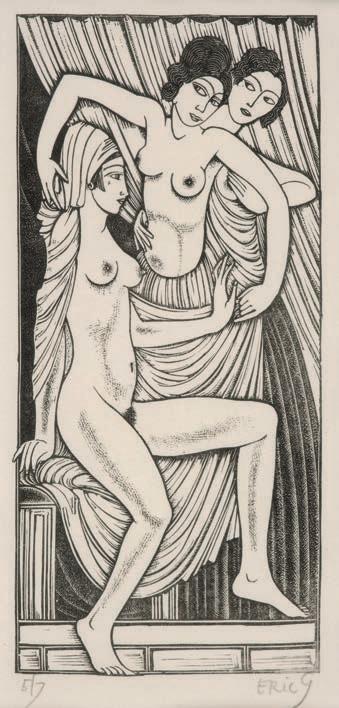
(1) £150 - £200
350AR* Flint (William Russell, 1880-1969). Doorway, Concarneaux, 1929, drypoint etching on pale cream laid paper, signed in ink, and numbered XI to lower margin, plate size 25 x 19.5 cm (9.75 x 7.7 ins), sheet size 33 x 25.5 cm (13 x 10 ins), framed and glazed, with period gallery label for the Fine Art Society, dated 29-8-1934

Wright 19, v.
(1) £100 - £150
351* Gill (Eric, 1882-1940). Ecce Tu Pulchra Es (from Canticum Canticorum), 1929, copper engraving on thin laid paper, first state, signed in pencil to lower right, numbered 5/7, plate size 14.4 x 6.6 cm (5 5/8 x 2 1/2 ins), sheet size 17.4 x 10 cm (6 7/8 x 4 ins), framed and glazed 37 x 26.5 cm, ‘1st state’ inscribed to sheet verso.
Physick 614.
(1) £200 - £300
352AR* Seaby (Allen William, 1867-1953). Buttercups and Daisies, colour woodcut, titled and signed in pencil to lower margin, image size 19.7 x 25 cm (7 3/4 x 9 7/8 ins), framed and glazed (42.5 x 52.5 cm)

Purchased from Garton and Cooke in April 1988, thence by descent. (1) £150 - £200
354* Tunnicliffe (Charles Frederick, 1901-1979). The Pasture Gate, etching on thin wove paper, from an edition of 75 impressions, signed and numbered 28/75 in pencil, light mount stain, minor loss to extreme upper left and right blank corners, plate size 223 x 284 mm (8 4/5 x 11 1/5 ins), sheet size 255 x 317 mm (10 x 12 1/2 ins), together with two other 20th-century prints: The Crane, by Lionel Lindsay, wood engraving, issued in an edition of 100 proofs, signed in pencil, and Discretion is the Better Part of Valour, by J. R. G. Exley, etching, signed and inscribed ‘To Mr Short’, both mounted (3) £300 - £400

353AR* Seaby (Allen William, 1867-1953). Goat with Two Kids, colour woodcut on wove paper, signed in pencil, faintly toned, couple of pale fox spots, image size 22 x 31.1 cm (8 3/4 x 12 1/4 ins), sheet size 24.3 x 34.1 cm (9 1/2 x 13 1/2 ins), hinge mounted (1) £150 - £200

355AR* Anderson (Stanley, 1884-1966). Between Tides, Dieppe, 1931, copper line engraving, on thick cream wove paper, signed in pencil, inscribed ‘Ed: 85’, titled ‘Between Tides. Line Engraving. Editions 85 proofs -’, by the artist in the lower margin, mountstained, plate size 18.5 x 21.5 cm (7 1/4 x 8 1/2 ins), sheet size 28 x 36 cm (11 x 14 1/4 ins), framed and glazed 42.5 x 44 cm. Meyrick & Heuser 195.
(1) £200 - £300

357AR* Badmin (Stanley Roy, 1906-1989). Mill Street W, 1932, etching on Basingwerk Parchment wove paper, with margins, signed and titled in pencil, and additionally inscribed “1st T - 1st St., Frankfort & B.V. , one ed. only”, and further inscribed by the artist to lower blank margin “1.1. May 20th 1937”, plate size 155 x 170 mm (6 1/5 x 6 4/5 ins), sheet size 220 x 283 mm, hinged to top margin of mount, framed and glazed Beetles 33.


Illustrated in Fine Prints of the Year 1932. Issued by the Twenty One Gallery in an edition of 25 impressions in 1932. The present work is a trial proof, apparently printed by the artist in 1937, and very likely given as a present to David and Mary Downey, related to Badmin by marriage. The Twenty One Gallery on Mill Street was bombed during the Second World War, and the street is now a continuation of Savile Row. According to the artist, the man entering the gallery in the scene is a self portrait.
(1) £500 - £700
356AR* Badmin (Stanley Roy, 1906-1989). Burford, Oxfordshire, 1931, etching on laid paper (indistinctly watermarked), an artist’s proof (aside from the edition of 45 published by the Twenty One Gallery), signed and inscribed “To David & Mary Downey with best wishes” in pencil, plate size 137 x 194 mm (5 3/8 x 7 3/8 ins), sheet size 200 x 260 mm
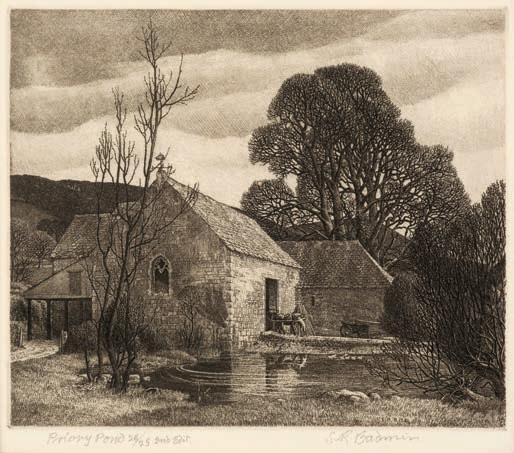
Beetles 25.
(1) £400 - £600
Lot 357
Each lot is subject to a Buyer’s Premium of 20% (Lots marked * 24% inclusive of VAT @ 20%)
358AR*
(Stanley Roy,
Priory Pond, 1932, etching on laid paper, watermarked L.& CIE (FRANCE), signed, titled and additionally inscribed to lower blank margin Priory Farm Kingstanley Glos., and marked 2nd state, a rich, delicate impression, plate size 132 x 157 mm (5.2 x 6.2 ins), sheet size 214 x 216 mm (8.4 x 8.5 ins)
Beetles 32.
Priory Pond is near Kingstanley, Stroud, Gloucestershire. The subject of this etching is the Saxon barn at Priory Farm, Leonard Stanley, Gloucestershire. The first edition and records were lost in the war but the plate survived.
(1) £300 - £500
Badmin 1906-1989).359AR* Piper (John, 1903-1992). Abstract Composition, 1936, colour lithograph, printed by Curwen Press, and published by Contemporary Lithographs, signed, image size 61 x 46 cm (24 x 18 1/8 ins), sheet size 67.5 x 50.5 cm (26 1/2 x 19 7/8 ins)
 Levinson 7.
Levinson 7.
360* Gill (Eric, 1882-1942). Title page, Henry’s Doubts, and one other..., from King Henry VIII, 1937, 3 wood engravings on thin pale cream wove paper, each signed and numbered 9/10, 2/10, and 2/10 respectively, 345 x 235 mm, window-mounted Physick 925-7.
Gill made six wood engravings to illustrate Shakespeare’s King Henry VIII which were published by the Limited Editions Club in 1939 in an edition of 1950 copies. The present works are from the separate edition of only ten impressions, each of which is numbered and signed by the artist.

(3) £300 - £500
361AR* Raverat (Gwendolen, 1885-1957). The Golden Age, 1937, wood engraving printed in colours on four conjoined sheets of thin wove paper, an artist’s proof, aside from the published edition of 68 impressions, signed, image size 203 x 540 mm (8 x 21 1/4 ins), with margins, sheet size 235 x 568 mm, framed and glazed (unexamined out of frame)
Selborne & Newman (1996) 479. Rare. No impression of this spectacular pastoral colour wood engraving recorded at auction.
(1) £700 - £1,000

362 Various Artists. Xxe Siecle, number 4, edited by G. di San Lazzaro, Paris: Chroniques du Jour, Christmas 1938, two colour lithographs: Marcel Duchamp (Obligation pour la Roulette de Monte Carlo) and Max Bill (Variation 13), and 8 colour linocuts: Henri Matisse (Teeny), Henri Laurens (Les Poissons), Joan Miro (Personnage au Soleil), Jean Arp (Constellations), Magnelli, De Chirico (Cabina Misteriosa), Helion and Zadkine (the latter supplied twice in this copy), the De Chirico printed to both sides of the pale blue sheet (recto in yellow and verso in red), monochrome illustrations, light marks to first and last leaves, original printed wrappers, lightly rubbed and marked, large 4to (32 x 25 cm) Schwarz 406 (Duchamp); Duthuit 723 (Matisse); Dupin 40 (Miro). Vingtieme Siecle was founded and published by Gualtiero di San Lazzaro, journalist, art critic and dealer. From 1938 to 1939 5 issues of the magazine were issued, the last being a double number (5/6). Publication resumed after the war in 1951 with a new series. Approximately 1000 to 1200 copies of this number were issued.


(1) £1,000 - £1,500

363AR* Piper (John, 1903-1992). Kemp Town [from Brighton Aquatints], 1939, uncoloured aquatint, plate size 188 x 276 mm (7 3/8 x 10 7/8 ins), sheet size 253 x 390 mm, with autograph presentation note from the artist to Lawrence Gowing, on Fawley Bottom Farmhouse letterhead paper, dated 19 vii 84 ‘Dear Lawrence, I found one of these & send it with love, Ever John’, framed and glazed together

(1) £200 - £300
364* Adamson (George Worsley, 1913-2005). Whit Monday, St. Mary's, Wigan, 1947, etching, the 5th state, printed in 1980, signed, titled, and numbered 9/35, plate size 40.2 x 28.4 cm (15 3/4 x 11 1/8 ins), together with Dixon (Frederick Clifford, 1902-1992). A London Street, 1927, etching, signed in pencil lower right, plate size 23.2 x 29.2 cm (9 1/8 x 11 1/2 ins), plus Brangwyn (Frank, 1867-1956). A Romantic Landscape, etching printed with pale green plate tone, signed in pencil, plate size 15 x 23.3 cm (5 7/8 x 9 1/8 ins), and three other etchings, including one by William Walcot, signed in pencil, an estuary landscape by B. Eyre Walker, and The Coming Storm by Geoffrey S. Garnier, signed, titled and numbered 90/100 in pencil, all framed and glazed (Eyre Walker without glass)

G. 317 (Brangwyn).
(6) £300 - £500
365AR* Rouault (Georges, 1871-1958). Il a été maltraité et opprimé et il n'a pas ouvert la bouche, from Miserere, 1923, published 1948, copper photo-engraving on Arches laid paper, watermarked Ambroise Vollard, plate XXI from the series, published in an edition of 425 impressions by Edition de l'Etoile Filante, Paris, printed by Jacquemin, pale mount stain (generally in very good condition), plate size 582 x 411 mm (22 15/16 x 16 3/16 ins), sheet size 64.5 x 50.5 cm (25 1/2 x 20 ins), with handwritten label attached to verso, framed and glazed (97 x 78.5 cm)
Provenance: Mercury Gallery London, circa 1970.
Chapon 26.
(1) £700 - £1,000
366AR* Rouault (Georges, 1871-1958). Obeissant jusqu'à la mort et à la mort de la Croix, from Miserere, 1923, published 1948, copper photo-engraving on Arches laid paper with watermark and Amboise Vollard, plate LVII from the series, published in an edition of 425 impressions by Edition de l'Etoile Filante, Paris, printed by Jacquemin, pale mount stain (generally in very good condition), plate size 582 x 411 mm (22 3/4 x 16 ins), sheet size 65 x 50.5 cm (25 1/2 x 20 ins), later handwritten label to verso, framed and glazed (97 x 78 cm)
Provenance: Mercury Gallery London, circa 1970.
Chapon XX
(1) £700 - £1,000
367AR* Lord (Elyse Ashe, 1900-1971). Ducks in a Pond, Chinese Manner, etching printed in colours on thin japan paper, from the published edition of 75 impressions, signed, titled Chinese, and numbered 37/75 in pencil, plate size 210 x 300 mm (8.25 x 11.8 ins), with margins, framed and glazed
(1) £100 - £150
Lot 364368* Poole (Monica, 1921-2003). Chalk and Flint, woodcut printed in four colours on wove paper, image size 12.6 x 20.5 cm (5 x 8 ins), sheet size 18.6 x 23.8 cm (7 1/4 x 9 3/8 ins), hinge mounted, together with Jowett (Katherine, 1882-1972), The Hata Gate, Peking, in Sunshine, colour linocut on wove paper, signed in pencil, image size 20.2 x 14.5 cm (8 x 5 3/4 ins), sheet size 22.5 x 15.8 cm (8 7/8 x 6 1/4 ins), hinge mounted, plus Bayley (Marguerite E., active 1929-1940), The Chariot of Israel & the Horsemen Thereof, wood engraving on wove paper, signed in pencil, titled and numbered 5/100, image size 15.9 x 21 cm (6 1/4 x 8 1/4 ins), sheet size 17.4 x 22.6 cm (6 7/8 x 8 7/8 ins), hinge mounted, and Bicat (André, 1909-1996), In the Trastevere, Rome, colour lithograph on wove paper, signed in pencil, titled and with pencilled inscription: Happy Xmas, with love - André, sheet size 38.5 x 27 cm (15 1/4 x 11 ins), mounted (4) £150 - £200


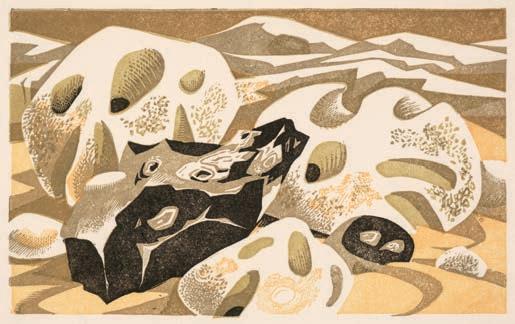
371* Walker (John G., 1939-). Headingley, 1969, colour screenprint, an artist’s proof, aside from the published edition of 75 impressions, signed and dated in pencil, and marked a/p, sheet size 71 x 103 cm (28 x 40 1/2 ins), period silver metal frame, glazed Provenance: Collection of Sir Lawrence Gowing (1918-1991).
(1) £100 - £150
369AR* Cliffe (Henry, 1919-1983). Composition, 1958, colour lithograph, signed in pencil, dated and marked Proof, repaired short closed edge tear to upper blank margin, sheet size 75 x 54.5 cm (29 1/2 x 21 1/2 ins)



(1) £150 - £200
370* Kawanishi (Yuzaburo, 1923-2014). Osaka Temple, 1960-61, oban colour woodblock on thin japan paper, from the edition of 100 impressions, signed, and numbered 19/100, sheet size 30.5 x 41 cm (12 x 16 ins), loose with original backing card bearing a printed label for the work in Japanese, and a printed biography of the artist in English, together with two other colour woodblocks by Kawanishi from the same series, one oban-format showing Osaka Temple from a different viewpoint, the other a harbour scene at night with fireworks and Osaka Temple in the distance, each with printed labels to verso of the original backing card

From the series Osaka Hakkei (Eight Views of Osaka). The third view here shows the fireworks and lanterns of the boats illuminating the dark Okawa river in Osaka.
(3) £200 - £300
372AR* Brunsdon (John, 1933-2014). Coastal Scene on the Lleyn Peninsula, etching and aquatint, titled, signed and numbered 84/350 in pencil, plate size 60 x 45 cm (23.5 x 17.3/4 ins), sheet size 79 x 57 cm (31 x 22 1/2 ins), framed and glazed, Christie’s Contemporary Art label to verso, together with Rugged Farmland, etching and aquatint, titled, signed and numbered 46/150 in pencil to lower margin, plate size 22.5 x 28.8 cm (8 7/8 x 11 3/8 ins), framed and glazed (39.2 x 44.5 cm)
Provenance: ‘Farmland’ was purchased from Christie’s in March 1986 and has since been kept in the same family.
(2) £200 - £300
Each lot is subject to a Buyer’s Premium of 20% (Lots marked * 24% inclusive of VAT @ 20%)
373AR* Tanner (Robin, 1904-1988). Easter, 1970, etching on cream handmade wove paper, with watermark ‘handmade’, a very good, strong impression of the third (final) state, signed in pencil and numbered 2/50, from the edition published by Penn Print Room, 1974 (there was a further edition of 25 published by Garton & Cooke, in 1984), wide margins, a deckle edge at top and right, plate size 39 x 26.6 cm (15 3/8 x 10 1/2 ins) sheet size 51 x 43.7 cm (20 x 17 1/4 ins) Garton 25.
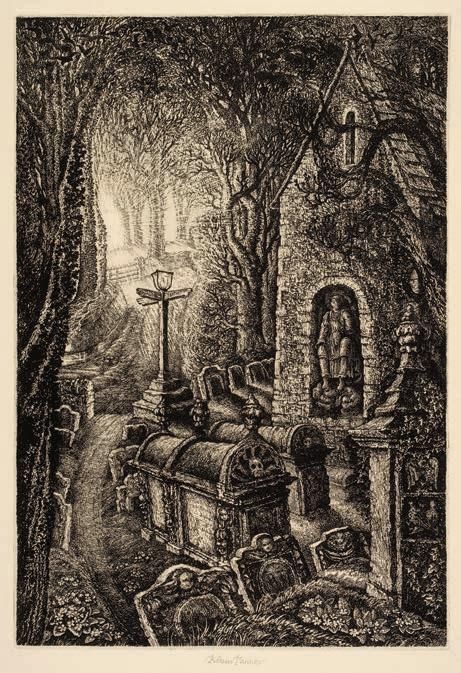
(1) £300 - £500
374* Frink (Elisabeth, 1930-1993). Horse, 1972, etching printed in sepia, on thick wove paper, signed and numbered 28/75, plate size 250 x 200 mm, sheet size 295 x 240 mm, from the edition of 75 impressions issued with the deluxe edition of the book The Art of Elisabeth Frink, with an Introduction by Edwin Mullins, published by Lund Humphries in 1972, original black cloth in dustwrapper, short closed tear to upper margin, 4to (300 x 245 mm)

(1) £400 - £600
375AR* Tanner (Robin 1904-1988). Full Moon, 1973, etching on pale cream heavy wove paper, signed in pencil to lower margin, sheet margins to verso lightly abraded, plate size 24.3 x 18.8 cm (9 5/8 x 7 3/8 ins), sheet size 32.9 x 26.4 (12 7/8 x 10 3/8 ins), framed and glazed (45.8 x 39 cm)

Garton 29, iii.
According to Garton the setting of this etching is the valley of Woodford Brake near the cobbled ford across Broadmead Brook which runs between Nettleton and Castle Combe.
(1) £200 - £300
376AR* Tanner (Robin, 1904-1988). The Plough, 1973, etching on pale cream wove paper, from the edition of 12 impressions, published by Garton & Cooke in 1982, signed in pencil to centre of lower blank margin ‘Robin Tanner’, plate size 16 x 18.8 cm (6.4 x 7.5 ins), sheet size 26.6 x 34.4 cm (10 1/2 x 13 1/2 ins), framed and glazed (42.4 x 43.2 cm)


Garton 30 iv.
(1) £300 - £400
378AR* Pasmore (Victor). Cave of Calypso I, 1977, colour etching on thick wove paper with blindstamp, from the edition of 60 impressions published by Marlborough Graphics, signed and dated by the artist lower right, and numbered 30/60 lower left, some overall discolouration, plate size 37 x 37.5 cm (14 1/2 x 14 3/4 ins), sheet size 68.5 x 58.5 cm (27 x 23 ins), framed and glazed, with Christie’s Contemporary Art label to verso Bowness & Lambertini 59.
(1) £200 - £300
377* Feild (Maurice, 1905-1988). W. H. Auden, three lithographs on pale cream wove paper, plus two duplicates, each signed in pencil, one marked artist’s proof, sheet size 41 x 38 cm (16 x 15 ins) and similar, together with other various modern prints including a late re-issue of Sickert’s Noctes Ambrosianae, from the cancelled plate, an etching signed in the plate V. d. S. after a drawing by Augustus John of a woman’s head in profile, numbered in pencil 28/35, a signed etching by Graeme Willson, entitled The Dream of Cuthbert Broderick, 1985, signed and numbered 15/60, an etching by Elaine Shemilt, signed, dated ‘75, numbered 2/5, and two other etchings, dated 1981 and 1982 by Susan Horlode (?)

(11) £100 - £200
Each lot is subject to a Buyer’s Premium of 20% (Lots marked * 24% inclusive of VAT @ 20%)
379AR* House (Gordon, 1932-2005). Manx Yellow, 1978-1979, etching in colours on wove paper, signed in pencil, titled, dated and marked Proof, plate size 41 x 30.3 cm (16 1/8 x 12 ins), sheet size 59.5 x 44.6 cm (23 3/8 x 17 1/2 ins)
(1) £150 - £200

380AR* Tanner (Robin 1904-1988). December: Elegy for the English Elm II, 1978, etching on wove paper, depicting an ancient chapel with bell tower, set in a valley lit by a crescent moon, from the edition of 25 published by Garton & Cooke, 1984, signed in pencil to lower margin, plate size 30.3 x 24.3 cm (11.75 x 9.5 ins), sheet size 44.3 x 39 cm, Garton & Co label to verso with printed title and edition, framed and glazed (51 x 45 cm) Garton 39 ii.

According to Garton the church derives from the North Wiltshire church of Inglesham (which William Morris ‘saved’ from restoration). The wooden plough is one preserved by Lackham College of Agriculture.
(1) £400 - £600 Lot
381AR* Kenny (Michael, 1941-1999). Hills and River Shores, circa 1980, colour screenprint, signed, titled and numbered 26/50 in pencil, image 90 x 122 cm (35 3/8 x 48 ins), sheet size 99 x 129.5 cm (39 x 51 ins), in excellent, fresh condition, framed and glazed (105.5 x 135 cm)

(1) £100 - £150
382AR* Brunsdon (John, 1933-2014). Dunes at Porteynon Bay, etching and aquatint, signed, titled and numbered ‘Trial Print 5’ in pencil, mount aperture 47 x 61 cm (18 1/2 x 24 ins), framed and glazed (65 x 81 cm), together with Anne Hathaway’s Cottage and Garden, etching and aquatint, signed, titled and numbered ‘Artist Proof 9/20’, plate size 11.1 x 29 cm (4 3/8 x 11 3/8 ins), framed and glazed (19.5 x 40 cm)

(2) £200 - £300
383AR* Brunsdon (John, 1933-2014). Minsmere Beach, etching and aquatint, signed, titled and numbered ‘72/125’ in pencil, mount aperture 47.5 x 63 cm (18 3/4 x 24 3/4 ins), framed and glazed (67 x 81 cm)
(1) £150 - £200

384* Martin (Frank Vernon, 1921-2005). Sèvres Babylone, circa 1981, colour etching on embossed paper, titled, signed and numbered ‘71/150’ in pencil to lower margin, plate size 38.4 x 54 cm (15 1/8 x 21 1/4 ins), sheet size 57.5 x 78 cm (22 5/8 x 30 3/4 ins) framed and glazed, together with Montparnasse Bienvenue, colour etching on embossed paper, titled, signed and numbered ‘71/150’ in pencil to lower margin, plate size 38.4 x 54 cm (15 1/8 x 21 1/4 ins), sheet size 57.5 x 78 cm (22 5/8 x 30 3/4 ins), framed and glazed (61.8 x 81.5 cm)


(2) £200 - £400
Lot 386
385AR* Tanner (Robin, 1904-1988). Still is the Land (The Farms of Home), 1986, etching on pale cream wove paper, from the edition of 10 impressions, published by Garton & Co. in 1988, printed by the artist, and initialled by the artist to lower margin, plate size 14.4 x 20.8 cm (5 5/8 x 8 1/4 ins), sheet size 28.3 x 37 cm (11 1/8 x 14 1/2 ins), framed and glazed (36.5 x 42.4 cm) Garton 49 ii.

(1) £200 - £400
386* Barbour (Marie, 1963- ). Back Street, 1987, linocut on wove paper, signed in pencil, titled, dated and numbered 3/15, image size 79.5 x 57 cm (31 1/4 x 22 1/2 ins), with margins, framed and glazed (103.5 x 73.5 cm)

(1) £100 - £150
Each lot is subject to a Buyer’s Premium of 20% (Lots marked * 24% inclusive of VAT @ 20%)
Lot 387
387AR* Howson (Peter, 1958-). ‘Johnie’, 1987, etching on thick arches paper, with watermark, from the series Saracen Heads, published by Flowers Graphics, London in 1988, and printed by Printmakers Workshop, Edinburgh, in an edition of 30 impressions, signed, dated, titled and numbered 5/30 in pencil, plate size 327 x 245 mm (12 7/8 x 9 5/8 ins), sheet size 565 x 380 mm, neatly hingemounted, framed and glazed
(1)
£200 - £300
388AR* Piper (John, 1903-1992). Cascade Bridge, Halswell, 1987, colour screenprint on wove paper, published by Marlborough Fine Art, London in an edition of 70 impressions, signed and numbered 16/70 in pencil, image size 460 x 677 mm (18 1/2 x 26 5/8 ins), with margins, framed and glazed Levinson 397.
(1)
£600 - £800
389AR* Rothenstein (Michael, 1908-1993). Purple Flowers, 1989, colour woodcut printed in green, blue, black, pink, red and orangeyellow, published in an edition of 29 proofs, printed by Anna Elinson at the Argus Studio in May 1989, signed and numbered 8/29, image size 48 x 41 cm (19 x 16 1/4 ins) with margins, framed and glazed, with Goldmark Gallery label to verso Sidey L1 (illustrated on the dustwrapper).

A variation of Rothenstein’s woodcut Red Flowers, with the flower heads printed in a pinkish purple.
(1)
£300 - £500
390AR* Rooney (Mick, 1944-). Spanish Duo, The Saxophonist & The Poor Musician, circa 1989, suite of three hand-coloured etchings, all artist’s proofs, signed and titled to lower margin, all marked ‘AP 1/35’ to lower margin in pencil, plate size from 20.5 x 12.7 cm (8 1/8 x 5 ins) to 20.5 x 15.5 cm (8 1/8 x 6 1/8 ins), framed and glazed in matching frames (54 x 47 cm)

Provenance: Private Collection, Gloucestershire, England. Mick Rooney studied at Sutton and Wimbledon School of Art, the Royal College of Art and was Rome Scholar for 1967-68. His Still Memories exhibition toured Folkstone, Eastbourne, Bath and London in 1989.

(3)
£150 - £200
Lot 389391* Niekerk (Sarah van, 1934-2018). Wick Court, Arlingham, Gloucestershire, 1990, wood engraving of a farmhouse and animals, signed and dated in pencil to lower margin, and numbered 54/120, mount aperture 21.5 x 26.7 cm (8 1/2 x 10 1/2 ins), framed and glazed (41 x 44 cm), together with Mortimer (Roger, 20th/21st century). Coast Path Study, 1995, etching, signed, titled and dated by the artist to lower margin, numbered 1/10, plate size 24.5 x 17.2 cm (9 5/8 x 6 3/4 ins), framed and glazed (40 x 32 cm), plus Sidoli (Dawn, 1933-). Redland, 1979, screenprint, an artist’s proof, signed, titled and dated lower margin, mount aperture 30.5 x 21.7 cm (12 x 8 1/2 ins), framed and glazed (50.3 x 40.4 cm) (3) £150 - £200

392AR* Tindle (David, 1932-). David’s Jacket, 1994, etching and aquatint, from an edition of 50 impressions, signed, and numbered 31/50 in pencil, plate size 25 x 20 cm (10 x 8 ins), with margins, framed and glazed, with Redfern Gallery label to verso, dated 1995 (1) £150 - £200

393* Washington (Earl Marshawn, 1962-). Eve, 2006, wood engraving, signed, titled, dated and numbered 1/75, image size 21.2 x 13.9 cm (8 3/8 x 5 1/2 ins), sheet size 35.5 x 21.7 cm (14 x 8 1/2 ins), together with A Version of Eve, 2006, wood engraving, signed, titled, dated and numbered 41/60, image size 26.8 x 13.5 cm (10 1/2 x 5 1/4 ins), sheet size 35.4 x 21.6 cm (13 7/8 x 8 1/2 ins)

Washington is a wood engraver who forged the work of famous engravers selling them as originals or the work of his great grandfather Earl Mack Washington (1862-1952). These two prints are (i) an enlarged version of Gill’s bookplate for Jacob Weiss and (ii) a copy of Eric Gill’s Eve without the serpent.
(2) £200 - £300
9 MARCH 2023 at 10am

To
401* Caiger-Smith MBE (Alan, 1930-2020). A collection of Aldermaston Pottery, including an earthenware lidded storage jar by Alan Caiger-Smith, decorated with birds, leaves and berries, blue marks to base, 22 cm high, together with a bowl by Elizabeth Frith-Powell, two hairline cracks around the edge, 9 cm high x 23.5 cm diameter, a jug by Angela Monckton, 19 cm high, a large lidded water jug by David Tippler, 30 cm high and other items of Aldermaston Pottery

(8) £200 - £300
402* Caiger-Smith MBE (Alan, 1930-2020). ‘Deep Gypsy’ earthenware bowl, lustre glaze with stylised scrolls on a dark blue ground, monograms to base, 15 cm high x 19 cm across Alan Caiger-Smith (1930-2020), studied at the Camberwell School of Arts and Crafts and King's College, Cambridge. He trained pottery at the Central School of Art & Design in 1954 under Dora Billington.

Caiger-Smith established the Aldermaston Pottery in West Berkshire in 1955. The pottery was a cooperative workshop of about seven potters making functional and domestic ware and tiles. Caiger-Smith revived and perfected tin glaze and painting on red earthenware clay. A technique adopted during the medieval Islamic period and also much later by the likes of William De Morgan, Pilkington's Royal Lancaster and others. The factory ceased production when it was sold in 2006.
(1)
£200 - £300
404* Glass. An 18th-century double series cotton air twist stem wine glass, 16.5 cm high, together with an 18th-century double series spiral cotton air twist funnel wine glass, 19cm high, an 18thcentury double series cotton air twist stem wine glass, the bowl engraved with flowers and a latticework swag, 12 cm high plus a 20th-century glass in the 18th-century style, the bowl engraved with flowers, 14 cm high
(4) £200 - £300
405* Glass. A collection of 18th-century and later drinking glasses including an 18th-century wine glass with etched funnel bowl on conical foot, 12 cm high, a pair of Georgian ale glasses with barley and hops engraving, 13.5 cm high, a George III period facet cut toast glass, 11cm high, a facet cut wine glass with bladed knob stem and conical foot, 11.5cm high, absinth glass, 9.5cm high, plus 25 other pieces of glassware various sizes, largest 18cm high smallest 7cm high (31) £200 - £300

403* Ehlers (Annegret). Lowerdown Cross, Bovey Tracey, Devon circa 1946-1955, a tapered bowl with an incised decoration, black glaze interior, impressed seal mark, 11.5 cm high x 18 cm diameter, together with another black glaze vase, 21 cm high plus an ovoid vase black glaze with seal mark 17 cm high
(3)
£100 - £150
406* Gouda Pottery. A collection of Gouda pottery, including a large candlestick circa 1928, polychrome floral decoration on a black ground, 39 cm high, a floral decorated baluster vase, 31 cm high, a floral decorated bowl, 30 cm diameter, a small floral decorated ovoid jug, 13 cm high and other items of Gouda pottery, some damage (19) £100 - £150
 Lot 401 Lot 402
Lot 401 Lot 402
407* Hayes (Peter, 1946 -). A large cream coloured flattened bottle form pottery vase, with incised decoration incised mark and dated (19)90 to base, 38 cm high x 40 cm wide

(1)
£200 - £300
409* Stained Glass. A pair of art deco leaded glass panels, each with a central green roundel bordered by a red lozenge on an amber ground with red border, 68 x 27 cm
(1) £50 - £70
410* Studio Pottery. A collection of studio pottery including a lidded vase by David Frith, Brookhouse Pottery, square tapered form with scale decoration and roundels on a brown ground, impressed seal mark to base, 22 cm high, a large earthenware vase by Christopher Aston for Elkesley Pottery, brown running glaze, impressed mark to base, 34 cm high, a vase by Anthony Bernulf Hodge, oval form with impressed mark to base, 20.5 cm, a Rebecca Harvey saltglaze jug, 10 cm high and other items
(16) £200 - £300
411* Studio Pottery. A studio pottery oversized teapot, with a two-tone brown glaze and large spout with an additional handle, and flowerhead seal mark beneath the main handle, 42 cm long x 27 cm high
(1) £70 - £100

408* Leeds Pottery. An Edward VII commemorative creamware pottery tea service for the Royal Visit to Leeds on 7 July 1908, comprising teapot, sugar bowl and cover, milk jug and two tea cups and saucers, with relief moulded Leeds Coat of Arms and overpainted in silver, the bases impressed ‘Royal visit to Leeds July 7, 1908, W.L. Hepton, Lord Mayor, Leeds Pottery’, general crazing throughout, teapot 21 cm long, teacups 5.5 cm high x 6cm diameter, with a period illustrated advert titled ‘Leeds Pottery, Souvenir of the Royal Visit to Leeds’

Wildred Lawrence Hepton was Mayor of Leeds from 1907-08.
(5)
£200 - £300
412* Ipsen (Peter, Danish, 1815-1860). The Ages of Love, a neoclassical terracotta and porcelain relief moulded panel by Peter Ipsen after Bertel Thorvaldsen (1768/70-1844), showing a classical scene on a terracotta ground, within a Greek key border, impressed marks of P Ipsen Kobenhavn Eneret 391 to verso, presented in a glazed ebonised frame, frame size 25 x 52.5 cm
(1) £150 - £200

413* After Pierre-Jules Mené (1810-1879). A bronze sculpture modelled as two dogs hunting a fox, one dog attacking the fox whilst another looks on against a naturalistic tree trunk, signed and dated ‘P.J. Mene 1849’, 49 cm long
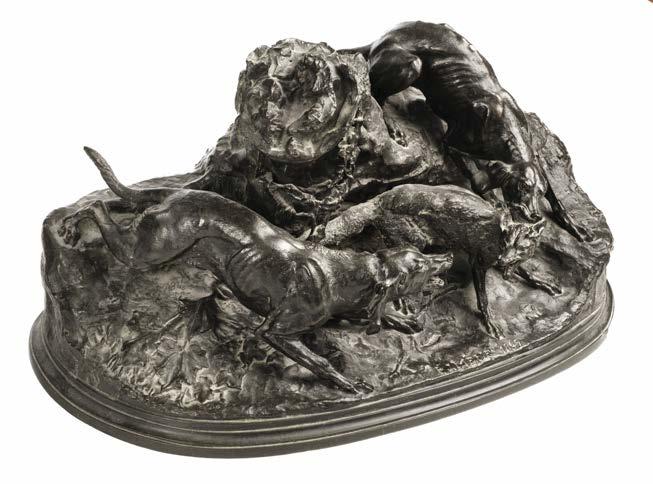
(1) £300 - £500
414* Binnacle. A ships brass binnacle from RFA Lyness, the dial by Einar Weilbach & Co, Copenhagen, Denmark, numbered B646 129CP, the brass case with port and starboard, approximately 54 cm high x 75 cm wide
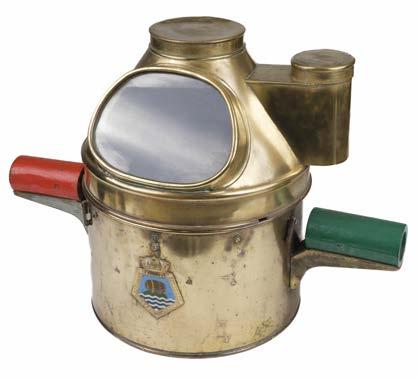
RFA Lyness was a Ness Class Stores Support Ship, officially numbered 309818 built by Swan Hunter of Wallsend on Tyne, she was launched in 1966 and sold to the United States Navy in 1981 and renamed Sirius and Texas Clipper III
(1)
£150 - £200
415* Bronze Sculpture. A 19th century style bronze, modelled as a pensive female in classical drapery seated with foot resting on a stool with claw feet, mounted on a red marble base, unsigned, 38 cm high

(1) £200 - £300
Each lot is subject to a Buyer’s Premium of 20% (Lots marked * 24% inclusive of VAT @ 20%)
416* Carriage Clocks. A late 19th century brass carriage clock, the white enamel dial with black roman numerals and subsidiary seconds dial, the brass case with swing handle and finely engraved with flowers, the movement with platform escapement and alarm, the base with 5 holes, 12 cm high (excluding the handle), working but would benefit from an overhaul, with key, together with a late 19th century French brass carriage clock, the porcelain dial with black roman numerals and finely handpainted with flowers and gilt decoration, the brass case with side panels and rear door inset with porcelain panels decorated with cherubs, the inner door numbered 152, with platform escapement and swing handle, 11 cm high (excluding handle), working with key
(2) £200 - £300

417* Clock. A Victorian Aesthetic period mantel clock in the style of Lewis Foreman Day, the architectural oak case inset with blue and white pottery panels printed, the dial showing Old Father Time, with black arabic numerals and two winding holes, surrounded by signs of the zodiac and shepherd panel frieze, with two elaborate brass finials, the rear with brass movement stamped 26014 A&N, with key and pendulum, 38 cm high x 25 cm wide x 12.5 cm deep

Lewis Foreman Day (1845-1910) was a British decorative artist and industrial designer who was an important figure in the Arts and Crafts movement.
(1)
£300 - £500
418* Clock. A Victorian drop dial mahogany wall clock, the white circular enamel dial signed F. Horner, 16 Fitzwilliam Road, Clapham, SW.4’, with blued steel hands and black roman numerals with fusee movement, housed in a finely carved mahogany case, 60 cm long Probably displayed in a retail outlet or institution.

(1)
£300 - £500
419*
A pair of Victorian glass decanters, probably for campaign or travelling use circa 1870, the bottles, slice cut and moulded decoration, each with a lip for pouring and stopper, 20 cm high contained in a fitted red tooled leather box with brass catches, 12 cm high x 25cm wide x 22.5 cm deep
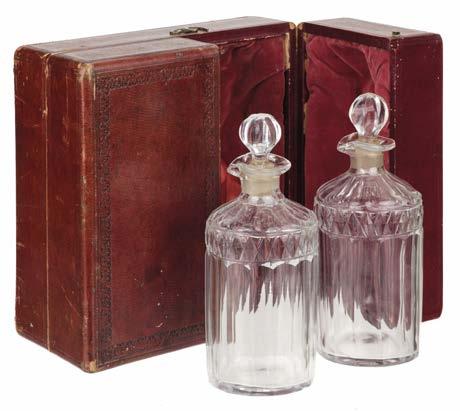
(1)
£70 - £100
Decanters.420* Falconry. A late 16th century silver hawking ring or vervel belonging to Sir Henry Lee of Ditchely (1533-1611), the face of the ring engraved with the seal of Sir Henry Lee K.G., and the band engraved ‘Sr Henry Lee Kt Baront, 5mm diameter, with related manuscript documents including a memorandum for the acquisition of the ring in 1890



Sir Henry Lee KG (1533-1611) of Ditchley, Oxfordshire was Queen’s Champion and Master of the Armouries under Queen Elizabeth I.
As Queen’s Champion, Lee advised the Accession Day tilts annually on 17 November, the most important Elizabethan court festival from the 1580s. He retired as Queen’s Champion in 1590, and the poems “His Golden Locks” by George Peele and “Time’s Eldest Son” were set to music by John Dowland and performed at the lavish pageant. Lee was made a Knight of the Order of the Garter in 1597 and founded Aylesbury Grammar School in 1598. Lee was also a Member of Parliament for Buckinghamshire between 1558 and 1572 and built up and estate at Ditchley in Oxfordshire from 1583. Here he commissioned the Ditchley Portrait of Queen Elizabeth which is now in the National Portrait Gallery.
One of the documents included with the lot is written by the 4th Earl of Chichester and details the ring being transferred to him from the Reverend Frederick George Lee D.D. of All Saints Vicarage Lambeth in 1890, there is a family tree verso and a wax seal of the Earl of Chichester.

The hawking ring or vervel was part of the equipment used by those who hunted with birds (the sport of falconry). Hunting was a sport engaged by the upper classes and nobility of the Elizabethan period and the ring would have been used to attach the bird’s leg in order to secure the bird to its perch.
(1)
£2,000 - £3,000
handle, 12cm diameter,
Ogden Smiths
salmon fly reel, 11.5 cm diameter, Ogden Smiths salmon fly reel, 11 cm diameter, Walker Bampton of Alnwick narrow drum trout fly reel, 9 cm diameter, Malloch’s patent side casting reel with alloy spool and brass mechanism, 8.5 cm diameter
(5) £150 - £200
 421* Fishing Reel. Eaton & Delton salmon fly reel, engraved ‘Eaton & Deller Makers 6 & 7 Crooked Lane London’ additionally engraved with owner’s initials, composite and alloy drum with ebonised
together with an
alloy
421* Fishing Reel. Eaton & Delton salmon fly reel, engraved ‘Eaton & Deller Makers 6 & 7 Crooked Lane London’ additionally engraved with owner’s initials, composite and alloy drum with ebonised
together with an
alloy
422* Fishing Reel. A rare Illingworth No 1 threadline casting reel circa 1905, stamped ‘Illingworth Casting Reel Patent 9338-1905’, the mechanism numbered ‘22’, the drum 9 cm diameter, in original box with accessories (1) £300 - £500

425* Fredericks (20th century). A white marble bust of Nelson, the half bust carved in the traditional manner on an integral mottled green socle base, incised ‘Fredericks’ to rear, 31cm high (1) £200 - £300

423* Fishing Reels. Malloch’s Patent alloy drum casting reel, with lever action, stamped twice ‘Mallochs Patent’ 10 cm diameter (4ins), together with another brass fishing reel by Grays of Inverness, the drum engraved with makers name, ivorine handle 8.5 cm diameter, plus a collection of small brass fishing reels, largest 6 cm, smallest 4.5 cm, and four wood and brass reels, largest 10 cm diameter, smallest 7.6 cm diameter (10) £100 - £150
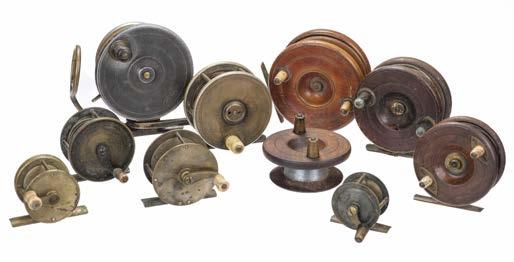
424* Fishing Rods. A collection of vintage fishing rods, comprising Hardy Palakona No 2 LRG Spinning rod, 9ft 6ins; Hardy Palakona, The Viscount Grey rod 10ft 6ins 2 piece rod; Alex Martin of Glasgow, 11ft 6ins 3 piece split cane with cloth bag; The Tank Aerial rod 7ft 6ins fly rod circa 1940s, together with bamboo measuring pole in Farlow wooden travelling rod box plus 22-yard surveyors chain (7) £150 - £200
426* Hip Flask. An Edwardian hip flask by Gorham Co, crocodile skin, glass and silver plate, the detachable cup stamped ‘Gorham Co 0100 Silver S’, 15.5 cm long (1) £70 - £100

427*Indian School. A pair of late 19th century Indian bronze figures, modelled as semi-naked male and female wearing traditional dress adorned by beads and headdress, 24 cm high (2) £200 - £300

428* Mirror. A George III concave novelty glass wall / shaving mirror, the original curved glass with spotting with ebonised wood frame and brass hanging loop, 20.5 x 15.5 cm, together with a George III walnut wall / shaving mirror, the original glass in poor condition, the slender walnut frame with some cracks, with brass hanging loop, 17.5 x 21.5 cm
(2)
£100 - £150
431* After Pradier (James, 1790-1852). Saffo Assia, circa 1880, bronze of a seated female in classical robe with lyre, signed J. Pradier, Susse, with foundry mark to base, 28.5 cm high x 40 cm long


(1) £200 - £300
432* Sculptures. Laing (Gerald), bronze modelled as a recumbent female, signed and dated 1939, numbered 488.1, 30 cm long, together with Pompon (Francis), art deco bronze bird standing on a plinth signed, black marble base, 24 cm high, two female nude plaster sculptures and other items
(6)
429* Mirrors. An attractive pair of late Victorian oval giltwood mirrors, each with bevel edge glass and floral moulded frame with beaded edge, 35 x 28.5 cm, together with a later rectangular mirror, the gilt painted frame moulded with shell and pierced scroll decoration, 46 x 36 cm

(3) £100 - £150

430* Pocket Barometer. A Victorian pocket barometer by Ross, London, brass case with silvered engraved dial, the opposite side with a compass and mercury barometer, 50 mm diameter, contained in a red leather case, together with a large plaster roundel of King George V, presented in a cloth covered frame with brass plaque engraved ‘H.R.H. The Prince of Wales. Original plaster cast by F. Bowcher. Acquired by the Committee of the International Philatelic Exhibition London 1906 as a design for prize medals, cracked, 30 cm diameter plus a collection of military cap badges and other items
(1)
£200 - £300
433* Soete (Pierre de, 1886-1948). Minerva Motors, bronze scuplture with marble base, original spear lacking, signed ‘P.de Socte’ to edge of lower bronze base, small plate on front of marble base reads ‘Minerva Motors a The Midland Counties Motor Garage Co Ltd a L’Occasion du 25 Anniv. De Fondation des Usines Minerva 1897-1922’, height 33 cm
Minerva Motors was a Belgian firm started by a young Dutchman, Sylvain de Jong, in Antwerp. In 1903 de Jong founded Minerva Motors (after successfully producing bicycles and motorbikes). Minerva Motors produced luxury automobiles until 1956 when the company closed. This sculpture celebrates The Midlands Counties Motor Garage on the occasion of the 25th anniversary of the founding of the Minerva factories 1897-1922.
(1)
£200 - £300
434* Walking Stick. A Victorian folk art wooden walking stick, carved from one piece with a grip of a bearded gentleman wearing a top hat, silver ferrule engraved with initials and the shaft with masks, birds, snakes and other wildlife with brass tip, 92 cm long

(1)
£150 - £200
£100 - £150
435* Ancient Greece. Head of an Actor, Alexandrian, circa 1st century BC, painted terracotta, some damage, 12h x 10w x 10d cm (4 3/4 x 4 x 4 ins), mounted on a wooden plinth

Provenance: Collection of Sir Lawrence Gowing (1918-1991).
(1) £200 - £300
438* Oinochoe. A Greek wine jug from the Apulian region of Southern Italy, circa 400-300 B.C., the terracotta jug with long scroll handle and decorated with a lady of fashion and overpainted with white enamel decoration on a spread foot, several chips to the foot and general wear commensurate with age, 28.5 cm high, with certificate of authenticity
Provenance: Vanessa Purcell & Co Antiquities, London, 1994.
(1) £200 - £300
436* Egypt. An ancient Egyptian oil lamp, frog type 2nd -4th century, pink teracotta, 11.5 x 10 x 3.5 cm, together with a Roman jug, grey body with handle, undecorated, 14 cm high

Provenance: Private collection, West Country. Believed to have been found in Glanum, France.
(2) £200 - £300
437* Oil Lamp. A Roman terracotta oil lamp, circa 1st century A.D., with moulded decoration depicting an archer, lacking handle, 10.5 cm long, together with a smaller and lighter terracotta oil lamp, 8.5 cm long

The first purchased from Vanessa Purcell & Co Antiquities, 1994.
(2) £100 - £150
439* Terracotta Figure. A Greek terracotta figure, Boeotian region, circa mid 5th century B.C., modelled as a male holding a vessel, hollowed back, 25.5 cm, presented on a modern perspex stand

Provenance: Vanessa Purcell & Co Antiquities, 1994.
(1) £200 - £300
Chinese miniature jade vase, carved with ring handles, 5.5 cm high, together with a jade archers ring carved with deer, 3.5 cm high plus a jade pei, carved with a monkey eating a fruit, the opposite side carved with a Chinese symbol, 5 cm high

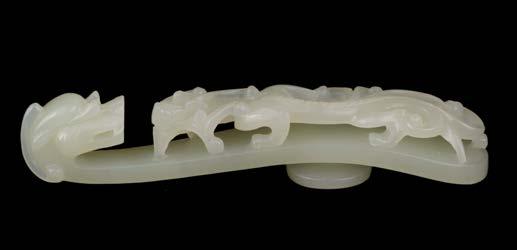


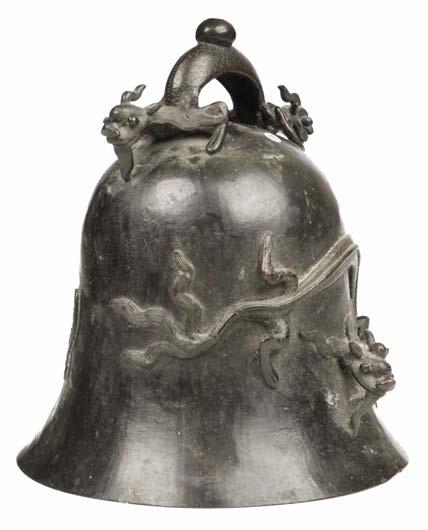
448* Table Cabinet. An early 20th century Chinese wooden table cabinet, a combination of dark and light wood, the two hinged doors finely carved and pierced with figures, pagodas, landscapes and exotic birds, enclosing a bank of seven drawers, all various sizes carved with foliate sprays, two further drawers to the lower section and raised on straight supports, 50 cm high x 42 cm wide x 23.5 cm deep

- £200



16
 445* Jade. A Chinese pale jade brush washer, of plain tapered form, 3 cm high x 6 cm wide (1) £100 - £150
446* Jade. A large Chinese jade boulder, naturalistically carved 14 cm long, presented on a hardwood stand (1) £100 - £150
447* Jade. A Chinese jade bangle, apple green colour, 8 cm diameter, together with a similar bangle, 7 cm diameter (2) £150 - £200
(1) £100
445* Jade. A Chinese pale jade brush washer, of plain tapered form, 3 cm high x 6 cm wide (1) £100 - £150
446* Jade. A large Chinese jade boulder, naturalistically carved 14 cm long, presented on a hardwood stand (1) £100 - £150
447* Jade. A Chinese jade bangle, apple green colour, 8 cm diameter, together with a similar bangle, 7 cm diameter (2) £150 - £200
(1) £100
450* Africa. A Fulani shepherd’s shirt, early 20th century, looselywoven cream cotton, hand-stitched in narrow panels (approxinately 8 cm wide) to form a tunic, with round neck, wide openings for arms, tucked yoke, gores to skirt, and with circular and geometrical motifs worked in woollen embroidery to front and back of yoke, in red, green, and black, a few minor marks, 9 cm section of one seam unstitched, width 73 cm (28.75 ins), length 95 cm (37.5 ins)

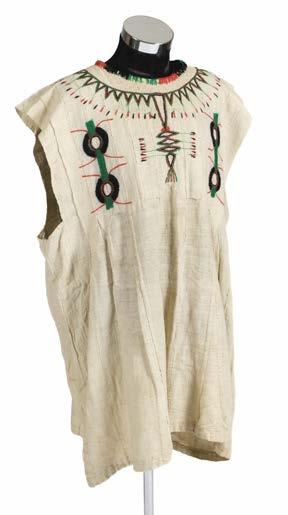
Provenance: Collection of Romy Rey.
Similar to that held by the Minneapolis Institute of Art (accession number 2013.78.4).
(1) £100 - £150
452* Africa. An Ashanti or Ewe kente cloth, Ghana, early 20th century, composed of woven cotton rectangles, of geometric patterns, and 2 with the form of a hand, in red, yellow, blue, and green, hand-stitched together to form a cloth of 17 strips, small hole with stitched repair to one corner, width 122 cm (48 ins), length 193 cm (76 ins), together with 3 other textile items, including another hand-stitched kente cloth of 17 strips, probably slightly later, woven in maroon, orange, yellow, blue, and green, 12 cm section of one seam unstitched, small hole and stitched repair to one edge, width 180 (71 ins), length 246 cm (97 ins), and a kente-style large thick cotton cloth, woven with rectangles and bars in red, yellow, green, orange, and white, on a ground of wide brown stripes and narrow pale stripes, fringed to long sides, width 167.5 cm (66 ins), length 251.5 cm (99 ins)

Provenance: Collection of Romy Rey.
The kente cloth is a wrap dress worn by both men and women of the Ashanti and the Ewe peoples in Ghana. Traditionally used for special social or sacred functions, the kente cloth is worn like a toga wrapped around the body and draped over one shoulder, or sometimes around the waist. Legend has it that during the reign of Oti Akenten (1630-1660), the chief of Ghana’s Ashanti people, two brothers from the Ashanti village of Bonwire learned how to craft kente cloth by watching a spider weaving a web. The arrangement of the colours and patterns used would correspond to a name, phrase or idea, and thus the textile could speak a story or represent a symbol which could be interpreted and reinterpreted.
(4) £200 - £300
451* Africa. A large appliqué panel, probably African, early 20th century, hand-stitched cotton, with pink and white appliqués forming an all-over pattern of 8-petalled flowers within circular and star borders, with quatrefoils between, on a dark grey ground, selvedges to sides, machine-stitched hem top and bottom, some edge-fading, lightly soiled in places, 230.5 x 151 cm (90.75 x 59.5 ins), together with other woven and embroidered textiles various, including South American and African

Provenance: Collection of Romy Rey.
(12) £150 - £200
453* Africa. An Ashanti tribe hunter’s tunic, Ghana, 19th century, hand-stitched long tunic of blue and cream striped coarse cotton, with wide sleeves, round neck with small ‘V’, and yoke lined with coarsely-woven beige fabric, front and back of yoke onlaid with brown, tan and white leather patches sewn on with leather ‘thread’, in various geometric shapes (squares, rectangles, triangles), a number of the patches themselves onlaid with red or yellow fabric, seams becoming unstitched in a few places, some minor wear to onlays, width cuff to cuff 140 cm (55 ins), length 105 cm (41.25 ins)

Provenance: Collection of Romy Rey.
A rare Ashanti garment, worn by the general of the tribe, the leather onlays presumably signifying animals killed.

(1)
£300 - £500
455 Guyana. Beadwork apron, early 19th century, woven seed bead apron, composed mainly of white beads, with a border of blue beads to upper edge and border of blue and red beads to lower edge, a few beads missing, but mostly intact, upper edge with plaited cotton thread border terminating in remains of ties at each corner, lower edge fringed, sides with edging of tufted knots, 18 x 38 cm (7 x 15 ins)
Very similar to a Kali’na woman’s apron dating to the early 19th century held by the Musée de Beaux-Arts et de l’Archéologie de Besançon.

(1) £200 - £300
454* Coptic. An Egyptian cloth fragment, circa 5th-8th century AD, woven linen and wool border, with a row of roundels enclosing stylised figures, animals, and birds, within a patterned border, in dark green, orange, and brown, on a pale brown ground, edges frayed, and one blank edge with some toning, approximately 55 cm (21.5 ins) x 15.5 cm (96.25 ins) at widest points
Provenance: from the Zika Ascher Collection and Ascher Archives.
Zikmund Ascher (1910-1992), known as Zika and nicknamed ‘The Mad Silkman’, was a Czech textile businessman, artist and designer who, with his wife Lida (1910-1983), became a leading name in the field of British textiles, art, and fashion. The pair, who arrived in Britain at the outbreak of WWII, were innovators who pushed the conventions of British fabric design in daring new directions. They brought colour and vibrancy to the bleak face of post-war textiles, and with this, hope and optimism was conveyed through their work. They experimented with bold patterns and new and unconventional fabrics, including mohair, rayon, parachute nylon and cheesecloth, influencing top couturiers such as Christian Dior, Cristobel Balenciaga and Yves Saint-Laurent, and they also collaborated with leading artists such as Georges Braque, Pablo Picasso, Henry Moore, Ivon Hitchens and Henri Matisse, to produce a series of iconic silk scarves. In 1987 the V&A in London mounted a retrospective exhibition of the Aschers’ work, and published an accompanying book by Valerie D. Mendes and Frances M. Hinchcliffe entitled Ascher: Fabric, Art, Fashion.
(1)
£100 - £200
456* India. A Chang Naga warrior ceremonial cowrie shell body cloth, early 20th century, thick woven cotton cloth, with orange squares on a brown ground (slight loss of the orange in places), composed of 3 hand-stitched strips, stitched with cowrie shell circles arranged in 3 rows of 5, 4 circles missing to one strip, 4 x 4.5 cm hole patched on verso, and a number of small darns, edges sometime trimmed and overlocked, 82 x 137 cm (32.25 x 54 ins), together with 7 other textile items, mostly Asian in origin, including: a mid 20th century hand-stitched Turkmenistan triangular crimson silk shawl, 2 sides with hand-woven wide border of geometric patterned stripes in red, yellow, and black, and twisted fringing in red and black, sides with border 183 cm (72 ins), remaining side 182 cm (111 ins); a Pua Kumba wall hanging, Sarawak, Borneo, handwoven in pink, cream, and purple, depicting 2 figures in traditional dress, short ends fringed, 76 x 49.5 cm (30 x 19.5 ins); and a Javanese batik wall hanging with wayang figures within a floral border, printed in brown, cream, and gold, on a black cotton ground, a few small marks, 52 x 205 cm (20.5 x 80.75 ins)
Provenance: Collection of Romy Rey.
(8) £200 - £300
457* Native American. A beaded tunic, late 19th/early 20th century, hand-stitched thick orange cotton tunic, with wide openings for arms, front with pouch pocket and embellished with polychrome beaded strips, name ‘R. Divry’ worked in stem stitch in yellow thread to lower left of front, nape with a large insect(?) motif hand-embroidered on a purple panel, some light soiling and occasional loss of beadwork, 1 or 2 small holes, width 66 cm (26 ins), length 63 cm (25 ins)


Provenance: Collection of Romy Rey.
(1) £100 - £150
459* South America. A ceremonial double-sided reversible huipil, mid 20th century, hand-made tunic composed of 2 layers of heavy cream cotton, elaborately embroidered to front and back in polychrome cotton threads with a design of 3 stars surrounded by geometric borders, with floral stems to lower edge between 2 pairs of birds in flight, some foxing, but overall in good condition, width 120 cm (47.25 ins), length 84 cm (33 ins)

Provenance: Collection of Romy Rey.
An unusual huipil made from two layers of fabric, presumably for extra warmth. The embroidery is so skilled that the reverse is almost as neat as the front, and the piece could certainly be worn inside out. Ceremonial huipils are the most elaborate of the traditional garments of South America. Such items could take as long as a year to make, and were reserved for weddings, burials, and women of high rank, and even used to dress the statues of saints.
(1) £150 - £200
458* Pakistan/Afghanistan. A collection of 5 beaded jumlo tops, late 19th-mid 20th century, each composed of black cotton, handstitched to form a tunic with wide sleeves and multi-gored skirt, each heavily encrusted to bodice and sleeves with various embellishments, including woven fabric strips and embroidery, buttons and press studs, coins and medallions, beads, jewelled metal pendants, etc., 2 with lead weights to sleeves, 1 with metal zip feature, some minor wear in places, various sizes

Provenance: Collection of Romy Rey.
The jumlo is one of the most lavishly embroidered and embellished garments in South Asia, worn by Muslim women in remote Kohistan. Each jumlo is unique, typically handstitched by the woman who wears it. The skirt of the dress is formed from triangular gussets - some examples have as many as 600 - and the garment was worn with trousers and an embroidered shawl.
(5) £300 - £500
460* South America. A collection of traditional huipil tunics, early-later 20th century, 14 hand-made garments, elaborately woven and/or embroidered with floral decoration, geometric designs, stylised figures, animals, and birds, and other symbolic designs, including huipil from Mexico (e.g. Oaxaca) and Guatemala (e.g. Chajul), generally in good condition, various sizes
Provenance: Collection of Romy Rey.
(14) £300 - £500
463* Tribal Art. A pair of early 20th century African hardwood stools, each with circular dished top over three curved supports, 21 cm high x 24 cm diameter

(1) £70 - £100
461* South America. A collection of traditional huipil tunics, early-later 20th century, 14 hand-made garments, elaborately woven and/or embroidered with floral decoration, geometric designs, stylised figures, animals, and birds, and other symbolic designs, including huipil from Mexico (e.g. Oaxaca) and Guatemala (e.g. Chajul), generally in good condition, various sizes
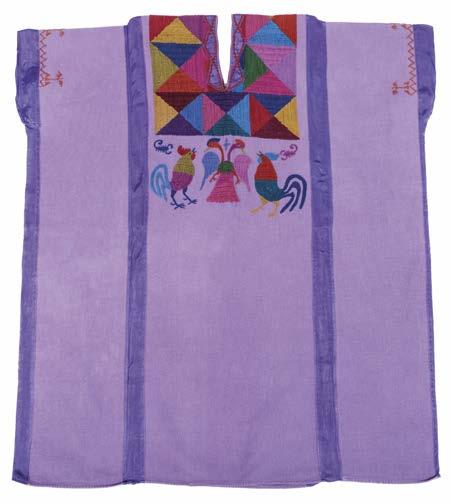
Provenance: Collection of Romy Rey.
(14)
£300 - £500
462* Yemen. A collection of 8 garments (qamis), 19th/early 20th century, each composed of black cotton, hand-stitched to form an unstructured tunic, loosely cut with wide sleeves, and heavily embellished with silver threadwork (talli) in varying degrees to front and back, all with some wear, various sizes

Provenance: Collection of Romy Rey.
The qamis was apparently often worn inside out, both to keep the ornamentation clean and to prevent the prying eyes of strangers seeing the intricacy of the handwork, which was considered bad luck to the owner and wearer of the dress. Older qamis are much more intricately adorned than later ones.
(8) £200 - £400
464* Tribal Art. A 19th century high ranking Zulu leaders shield (Ihawu), small type covered in brown and white hide, 60 x 36 cm, together with an accompanying staff, the top carved with symbols which would indicate a distinction amongst a tribe with a piece of European pocket watch which would more than likely have been a battlefield souvenir of the Anglo Zulu war, overall length 125 cm, some wear to both, commensurate with age and use

Provenance: The Mick Woodfield Collection of Zulu Weaponry and Tribal Items, C & T Auctioneers 24 April 2019 (lot 48).
(2) £300 - £500

465* Tribal Art. A 19th century Zulu Warriors / Executioners knobkerrie circa 1870s, the large spherical head inset with two boot studs believed to have been removed from a British soldier’s boots on the battlefield, with straight shaft and flared terminal, 65 cm long


Provenance: The Mick Woodfield Collection of Zulu Weaponry and Tribal Items, C & T Auctioneers 24 April 2019 (lot 2).

(1) £400 - £600
466* Tribal Art. A 19th century Zulu Warriors knobkerrie circa 1870s, the large spherical head carved with two dished sections for the warrior to take snuff before battle, on a long tapered shaft, 66.5 cm long

Provenance: The Mick Woodfield Collection of Zulu Weaponry and Tribal Items, C & T Auctioneers 24 April 2019 (lot 5).
(1) £300 - £500
467* Tribal Art. An Anglo-Zulu War battlefield spear (assegai), believed to have been recovered from a Zulu warrior, the spear point has been struck by a bullet resulting in a hole, mounted with wirebound on a long hardwood shaft terminating in animal hide, 143 cm long




Provenance: The Mick Woodfield Collection of Zulu Weaponry and Tribal Items, C & T Auctioneers 24 April 2019 (lot 89).
(1) £700 - £1,000
468* Tribal Art. An early 20th century Zulu tribal staff, with spherical knop inset with brass studs and wire-bound shaft, 88 cm long
(1) £100 - £150
469* Tribal Art. An early to mid 20th century African hardwood chair, the curved high back carved with a figure, with a solid seat and figural carved base, old damage, 111 cm high x 53 cm wide
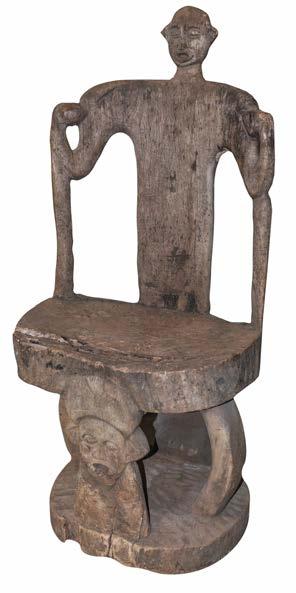
Provenance: Collection of Romy Rey.
(1) £200 - £300
470* Tribal Art. A South Sea Island hardwood paddle, probably 19th century Maori, the blade engraved with the initials G.J.S., 148 cm long, together with another of the same style and period, engraved with the initials NAM, 147.5 cm long, both with drill holes having once been mounted on the wall
(2) £300 - £500
471* Arts & Crafts. A painted and tooled triptych mirror, circa 1900, 3-fold mirror comprising 2 hinged side mirrors folded into green calf frame holding central mirror (some desilvering, especially to latter section), frame gilt tooled with stylised water lilies in bud and intersecting lines terminating in scrolls, left-hand mirror backed with green calf gilt tooled with intersecting lines terminating in water lily flowers and buds (becoming loose and with slight wear at edges), right-hand mirror backed with green calf and forming cover, hand-painted to left-hand side with a young lady in a flowing white gown playing a lute, and tooled to right-hand side with gilt lines, stylised water lilies, and other flowers, and a silver moon and stars seen through gilt clouds, metal clasp to left-hand side, metal hanging chain to top of frame, lacking stand on verso of frame, extremities rubbed and a little worn in places, 36.5 x 29.4 cm An unusual triptych mirror carefully tooled and painted in the Art Nouveau style.
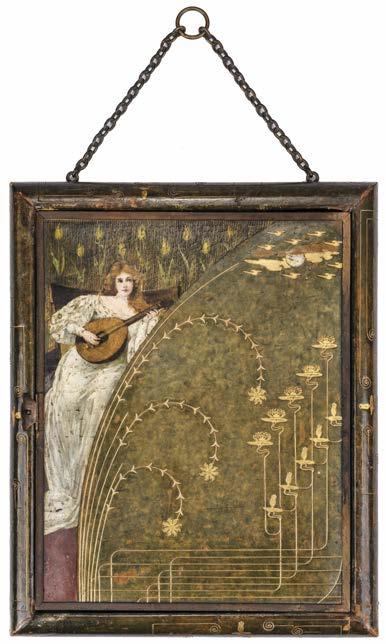
(1) £200 - £300
473* Desk. An Edwardian oak clerks desk, the upper section with mirror flanked by two cupboards each with a two tone green glass panel, enclosing shelves, above a tambour front desk with white marble inset and flanked by concealed drawers each with glass bottles and 6 drawers beneath, the base encompassing an integral steel safe, finished in green and gold with key, with a drawer to each side and one long drawer beneath, 173.5 cm high x 92 cm wide x 59.5 cm deep


(1)
£200 - £300
474* Oak Chair. A joined backstool oak chair, English, South Yorks circa 1670-1700, of polished oak, with solid seat and carved double-splat back, feet worn, total height 96 cm Chinnery (Victor), Oak Furniture: The British Tradition, A History of Early Furniture in the British Isles and New England, Woodbridge: Antiques Collectors' Club, 1998, pp. 479-480.
Backstools always of open-back variety. The majority of backstools have a pair of characteristic crescent-shaped cross-splats, enriched with scrolls and other details (see particularly figure 4:142). The double cross-splat backstool is a firmly entrenched pattern in Yorkshire, with a wide variation in individual treatments as confirmed by the illustrations in Chinnery.
(1) £200 - £300
472* Chairs. A matched pair of Edwardian inlaid mahogany salon chairs, one with decorative bows and flowers design, inlaid on shaped splat, on cabriole legs, recently re-upholstered, 97 cm high

(2) £150 - £200

478* Pocket Watches. A silver, key-wind lever pocket watch, watch signed by J G Graves of Sheffield, an Express English Lever, the rear cover with a cartouche to the centre, stamped Birmingham, William Ehrhardt, circa 1898, case slightly worn and rubbed, 52 mm diameter, together with 9ct rose gold plate Hunter pocket watch with chain, Limited edition 11/100, 51 mm diameter, commissioned to celebrate the 200th birthday of Isambard Kingdom Brunel, cased, plus four continental silver pocket watches, decorative cartouche to the centre of each, and other items including sterling silver watch chain, 53.1g, yellow metal lorgnette, continental pocket watch & chain rotary wrist watch, pocket watch
(12) £150 - £200
475* Mixed Jewellery. A modern 14K gold ring, set with sapphires and illusion set diamond chippings presented in a cross-over formation, stamped 14K, size O, gross weight 4.4g, together with an Edwardian 15ct gold and platinum bar brooch set with a diamond cluster formed as a central stone surrounded by 8 smaller stones, stamped 15ct Plat, 58 mm long, gross weight 4.2g, plus a 15ct gold bar brooch set with an aquamarine flanked by 12 graduated pearls, stamped 15ct, 84 mm long, gross weight 6.2g

(3) £200 - £300
476* Mixed Jewellery. A modern 9ct gold bangle, engraved with floral scrolls, 6 cm wide, 7.5 g, together with an Edwardian 9ct gold amethyst pendant, 4 cm long suspended on a 9ct chain and other items, combined gross weight 16g (please note this includes stones etc)

(5) £150 - £200
479* Propelling Pencils. An Edwardian 18ct gold propelling pencil by Sampson Mordan & Co, set with pearls, 65 mm long (fully extended), gross weight 10.4g, together with two gold plated propelling pencils, one set with a bloodstone seal engraved with a bird the other with a citrine plus an American pencil with black rubber grip stamped ‘Goodyears Pat May.7.51’, ‘Mabies Patent’ with gilt metal mounts

(4) £100 - £150
477* Mixed Jewellery. A modern 9ct gold necklace, 47 cm long, 8g, together with mixed gold including 5 dress rings, combined gross weight 29.5g (please note this includes stones etc)
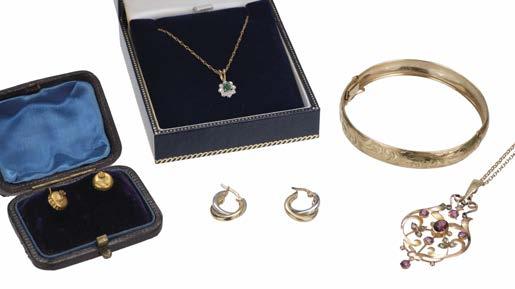
(1) £300 - £400
480* Ring. An 18ct gold and platinum diamond solitaire ring, size N, gross weight 2.5g

(1) £100 - £150
481* Ring. An 18ct gold tanzanite and diamond cluster ring, the central tanzanite surrounded by 8 diamonds each set in a claw, stamped ‘750’, size O/P, gross weight 5.4g
(1) £100 - £150

486* Rings. A modern 9ct gold diamond and emerald ring, size P, gross weight 1.4g, together with 9 modern 9ct gold dress rings, combined gross weight 16.5g (please note this includes stones etc)

(10) £200 - £300
482* Rings. A 9ct gold opal ring, size O/P, gross weight 2.3g, together with various yellow metal dress rings, including a sapphire and diamond cluster ring, size N
(7) £200 - £300
487* Rings. A modern 9ct gold three-tone ring set with diamond chippings, size R, 3.9g, together with 6 other modern 9ct gold rings each set with diamond chippings, combined gross weight 20g


(7) £200 - £300
483* Rings. A 9ct gents bloodstone ring, size V, gross weight 4.6g, together with 6 various 9ct gold rings including one set with a gilded metal coin, plus a yellow metal ring, combined gross weight 32.9 (please note this includes stones etc)

(8) £300 - £400
484* Rings. A 9ct gold 5-stone opal ring, size Q, gross weight 2.7g, together with 9 various 9ct gold dress rings including an illusion set garnet ring, combined gross weight 22.5g (please note this includes stones etc)

(10) £300 - £400
485* Rings. A modern 14ct gold ring pierced with wild animals including rhinoceros, size P, 10g, together with a similar 14ct gold ring, size N, 5.7g

(2) £300 - £400
488* Rings. An 18ct gold wedding band, size W, 4.6g, together with 18ct gold buckle ring set with two small diamonds, size R, gross weight 5.7g, 18ct gold 5 stone opal ring, size P, gross weight 3.2g, 18ct gold and platinum ring set with a quartz stone
(4) £300 - £400

490* Armada Dishes. Six silver Armada dishes by William Comyns & Sons Ltd, London 1969, each of traditional plain form, 83 mm diameter, combined weight 276g,
(6) £70 - £100
491* Condiment Set. A George V silver condiment set by Adie Brothers, Birmingham 1922, comprising two pepperettes, two salt cellars each with blue glass liner, lidded mustard pot, two salts and mustard spoon contained in a shaped red leather box
(1) £80 - £120
494* Mug. A silver mug, London 1939, of baluster form engraved ‘Grenville from his Godfather Capt. Sir Edward Malet 1940.’, with acanthus scroll handle, 13 cm high, 210g, together with a Victorian pedestal cup by Henry John Lias, London 1877, engraved with flower and ‘Snider Section Prize Hythe 17th June 1878 Won By Lieut H. Dacres Thomas By SC, 15 cm high, 140g
(2) £100 - £150
492* Irish Silver. A set of six silver beakers by Rionore of Kilkenny, Dublin 1971, plain form engraved and dated 1972, the interior gilded, 6.5 cm high x 7.5 cm diameter, total weight 950g

(6) £200 - £400
495* Playing card trays. Five silver playing card trays, James Fenton & Co, 1936, 5 matching trays, each with gadrooned border and inset playing card, glazed, each hallmarked on base, combined weight 675g, each 104 x 72mm

(5) £100 - £150
496* Salver. A Victorian silver salver by Daniel and John Welby, London 1896, with later engraving for ‘Killarney Races July 1963 Flesk Plate won by “Bonnie Lass” Owner Mr T.P. Hanlon Ridden By My R.D. Crossman’, pie crust edge on three scroll feet, 22.5 cm diameter, 505g

(1) £100 - £150
493* Mixed Silver. A Victorian silver scent bottle, London 1898, with flower and scroll design, hinged cap with glass stopper, stopper chipped, hallmarks rubbed, together with hallmarked silver sovereign case, with foliate design, rubbed, a modern silver belt buckle by LP Birmingham 1993, flower design, in two parts, 63 g, plus other items including hat pins, broaches, and awards mostly silver hallmarked some continental silver
(28) £100 - £150
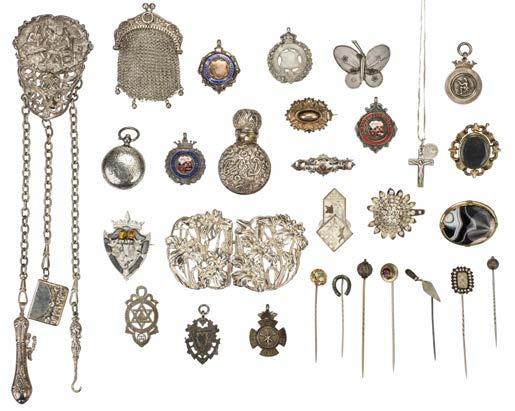
497* Tea Service. A Victorian four-piece silver tea service by Joseph Rogers & Sons, Sheffield 1894, comprising coffee and tea pots, sugar bowl and milk jug, all the neo-classical half gadrooned style, the coffee pot 27 cm high, total weight approximately 1750g


(4) £700 - £1,000
498* Tea Service. A matched George III silver three-piece tea set, comprising teapot by Alice and George Burrows, London 1811, milk jug by IET? London 1817, each of oblong form with acanthus, handles on ball feet, the teapot, 29.5 cm long, two handle sugar bowl, makers mark worn, London 1809, with gadrooned rim and reeded handles, 21.5 cm wide, combined weight approximately 1250g
(3) £400 - £600
499*
A George II silver trophy cup, hallmarks worn but probably London 1754?, of pedestal form foliate embossed with scroll and a vacant cartouche, 15 cm high, 275g, presented on a later ebonised base

(1) £100 - £150
(1) £150 - £200
501*
A silver two handle trophy cup, London 1935, of plain pedestal form, hallmarks worn, 27 cm wide x 13.5 cm high, 775g, presented on an ebonised base applied with small silver shields


(1) £200 - £300
 Trophy Cup.
500* Trophy Cup. A silver two handle trophy cup by Atkin Bros, Sheffield 1912, of half gadrooned pedestal form, off to one side, 24 cm wide x 21 cm high, 635g, presented on an ebonised base with ivorene plaque for Skinner & Co, Aviation Silversmiths
Trophy Cup.
Trophy Cup.
500* Trophy Cup. A silver two handle trophy cup by Atkin Bros, Sheffield 1912, of half gadrooned pedestal form, off to one side, 24 cm wide x 21 cm high, 635g, presented on an ebonised base with ivorene plaque for Skinner & Co, Aviation Silversmiths
Trophy Cup.
1686, old scratches,
William and Mary (1688-94), Threepence, 1689, very fine; William III, Sixpence, 1696, attractively toned, very fine; Queen Anne (1702-14), Threepence, 1706, good fine; George I (1714-27), Sixpence, 1723, obverse with coutermark to the obverse, fine; George III (1760-1820), Sixpence, 1787, toned, good very fine; George III (1760-1820), Sixpence, 1816, fine (9) £200 - £300


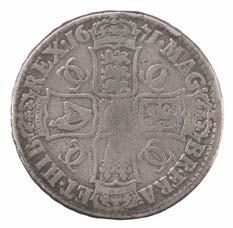





Each lot is subject to a Buyer’s Premium of 20% (Lots marked * 24% inclusive of VAT @ 20%)








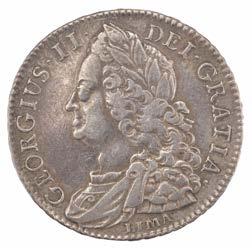







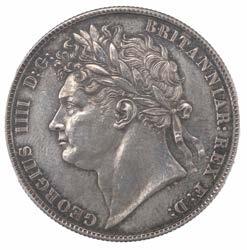 508* William and Mary (1688-1694). Halfcrown, 1693, QVINTO, fine (1) £100 - £150
509* William III (1694-1702). Crown, 1695, edge worn, fine (1) £70 - £100
510* Anne (1702-1714. Shilling, 1708, third bust type, good very fine and some toning (1) £200 - £300
511* George II (1727-1760). Halfcrown, 1745, DECIMO NONO, old laureate and draped bust, very fine (1) £100 - £150
512* George III (1760-1820). Crown, 1820, LX., good very fine (1) £150 - £200
513* George III (1760-1820). Halfcrown 1817, large laureate bust, good very fine (1) £100 - £150
514* George IV (1820-1830). Crown, 1822, SECUNDO, very fine (1) £150 - £200
508* William and Mary (1688-1694). Halfcrown, 1693, QVINTO, fine (1) £100 - £150
509* William III (1694-1702). Crown, 1695, edge worn, fine (1) £70 - £100
510* Anne (1702-1714. Shilling, 1708, third bust type, good very fine and some toning (1) £200 - £300
511* George II (1727-1760). Halfcrown, 1745, DECIMO NONO, old laureate and draped bust, very fine (1) £100 - £150
512* George III (1760-1820). Crown, 1820, LX., good very fine (1) £150 - £200
513* George III (1760-1820). Halfcrown 1817, large laureate bust, good very fine (1) £100 - £150
514* George IV (1820-1830). Crown, 1822, SECUNDO, very fine (1) £150 - £200
516* William IV (1830-1837). Halfcrown, 1834, fine, together with seven further Halfcrowns comprising Victoria, 1885, young head, very fine, Victoria 1887, good very fine, Victoria 1894, fine, Edward VII (4) 1902, 1907, 1909, 1910, first very fine, other three fine





(8) £70 - £100
519 Victoria. Gold Sovereign, 1878, Sidney Mint, young head with shield reverse, very fine

(1) £300 - £400
520* Victorian (1837-1901). Crown (2), 1889, 1900, first good very fine, second very fine, together with Edward VII Crown, 1902, very fine
(3) £100 - £150
517* Victoria (1837-1901). Crown, 1844, young head, star stops VIII, very fine
(1) £100 - £150
521* Edward VII. Gold Half Sovereign, 1909, very fine, together with George V, half sovereign, 1912, very fine (2) £250 - £300

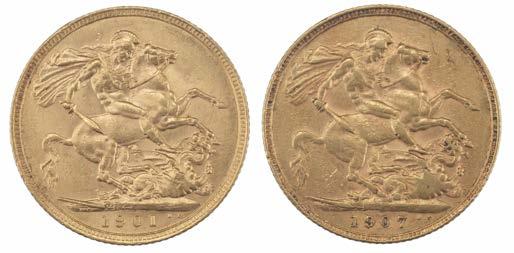
518* Victoria (1837-1901). Gold Sovereign, 1901, very fine, together with Edward VII, gold Sovereign, 1907, good fine

(2) £500 - £600
Each lot is subject to a Buyer’s Premium of 20% (Lots marked * 24% inclusive of VAT @ 20%)
(1) £150 -
526* Coin. Canada, Anticosti Island, Eighth-Penny, 1870 (2), good very fine
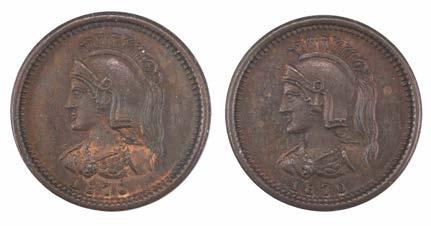



(2) £100 - £150
527* Proof Coins. Man’s First Moon Landing Commemorative Medal (number 2040), silver, obverse showing Neil Armstrong, Edwin Aldrin and Michael Collins, 20.7.1969 AD, reverse Apollo 11 Mission, hallmarked, 58 mm, 70.7g, in Alec Brook Ltd London case with paperwork, together with The Silver Crown of Queen Elizabeth II and Prince Phillip 1947-1972 (3), all silver with Royal Mint box and enclosure, Cook Islands Proof Set minted at the Franklin Mint, Festival of Britain 1951 Crown (2) each boxed and other commemorative coins
(20) £50 - £80
528* Sir
gold commemorative medal, No. A 1299, 0.128oz, with Matthew & Co Limited certificate, together with President Kennedy Memorial 18ct gold commemorative medal, No. A 0432, 0.257oz, with Metalimport Ltd certificate, both extremely fine and presented in the same blue leather box





(2) £250 - £300
 522 George V (1910-1936). Crown, 1933, reverse with a crown surrounded by a circle of roses and thistles joined by shamrocks, good very fine (1) £100 - £150
523* George V. Gold Sovereign (2), 1912, 1918 very fine (2) £500 - £600
524* Elizabeth II. Gold Sovereign (2), 1958, 1959, good very fine (2) £500 - £600
525* Elizabeth II. Gold proof Isle of Man one crown, 1980, reverse commemorating the 80th birthday of Queen Elizabeth The Queen Mother (1900-1980), extremely fine with certificate
£200
Winston Churchill. 18ct
522 George V (1910-1936). Crown, 1933, reverse with a crown surrounded by a circle of roses and thistles joined by shamrocks, good very fine (1) £100 - £150
523* George V. Gold Sovereign (2), 1912, 1918 very fine (2) £500 - £600
524* Elizabeth II. Gold Sovereign (2), 1958, 1959, good very fine (2) £500 - £600
525* Elizabeth II. Gold proof Isle of Man one crown, 1980, reverse commemorating the 80th birthday of Queen Elizabeth The Queen Mother (1900-1980), extremely fine with certificate
£200
Winston Churchill. 18ct
£300 - £500
529* Trading Tokens. A collection of 17th century Bristol CB and Gloucestershire trading tokens (approximately 200), including Obadiah Arrowsmith, Gloucestershire, Cirencester, Halfpenny 1668 (heart shape); Gloucestershire, Obadiah Arrowsmith, Tetbury; Gloucestershire, William Hopton Four Crosses of Stroude 1667; Yeates Daniell, Woodchester, Christopher Atkinson, Tewksbury and many others, with Seaby receipts and correspondence circa 1970s (approx. 200)

£200 - £300
530* Trading Tokens. A mixed collection of trading tokens including 46 spade guinea tokens, J. Sainsbury West Croydon Station, Fattorini & Sons, French Louis XIV tokens and German coins, presented on a red tray, plus a soft ring folder containing 64 mixed coins and tokens including George III 1797 Cartwheel Twopence, very fine, Cartwheel Penny, fine, George II copper coins, various copper trading tokens including Somerset, Hawkins Bird, Wine Street No 2 Bristol One Halfpenny 1793, Essex, Colchester Sucess to the Bay Trade, 1794, Weybridge Mills 1812, Tavistock Devon Mines 1811 (2) and others, mostly West Country (110)

531* Collectors Cabinet. A modern eastern hardwood collectors cabinet on stand, the two doors each carved with a roundel and with brass handles, enclosing 20 shallow drawers, 123 cm high x 60 cm wide x 42.5 cm deep

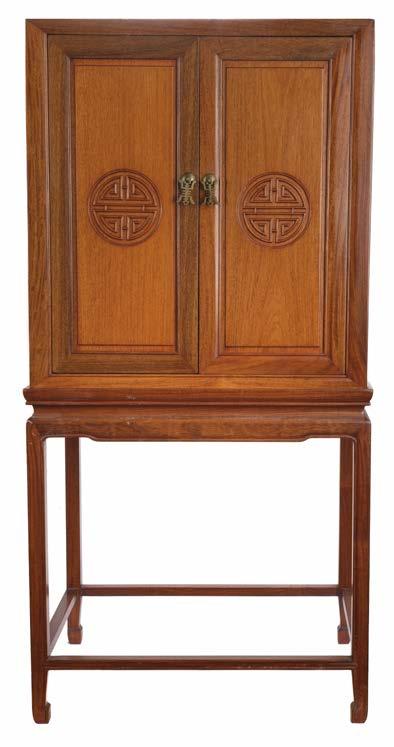
The owner had this specially commissioned to house his medal collection. (1) £200 - £300
532* Collectors Cabinet. A tabletop collectors cabinet, the long rectangular mahogany cabinet with brass handles, the lid enclosing four lift trays each lined with green baize, 11 cm high x 95 cm wide x 23 cm deep
(1)
Each lot is subject to a Buyer’s Premium of 20% (Lots marked * 24% inclusive of VAT @ 20%)
£70 - £100
533* Duke of Wellington. A 19th century bisque porcelain roundel, with a bust of young head Wellington facing right, presented in circular mahogany glazed frame with gold aperture, frame size 25 cm diameter

(1)
£200 - £300
535* Duke of Wellington. A fine equestrian bronze modelled as the Duke of Wellington on horseback after Edmund Cotterill (17941860), retailed by Garrard circa 1837, the Duke in uniform holding a telescope astride his horse Copenhagen, the naturalistic base stamped ‘Published as the act directs by R Garrard. Panton St London, 18th June 1837’, ‘Cotterill Sculp’, mounted on a shaped bronze base, one reign detached, one ear with minor loss, 50.5 cm high
Edmund Cotterill (1794-1860) attended the Royal Academy Schools in 1820 and exhibited there from 1822-1858. From 1833 he was chief designer for R&S Garrard, London and produced equestrian bronzes as well as large groups in silver. This model was originally designed in silver and displayed on the sideboard at Wellington’s London residence, Apsley House.


(1) £500 - £800
534* Duke of Wellington. A bronze half bust of the Duke of Wellington after Henry Weigall cast by Elkington & Co 1852, inscribed on the reverse ‘Modelled from sittings taken on Aug 6 9 11 and Nov 18 1851 / H Weigall. 27 Somerset St., Published Oct 10 1852’ and ‘No 6 Executed by Elkington Mason & Co 1853’, 40 cm high
(1) £300 - £500
536* Duke of Wellington. A collection of Duke Of Wellington commemorative jugs, including four Stephen Green Lambeth salt glazed stoneware Duke Of Wellington character jugs, circa 1820, varying sizes, largest 19 cm height, smallest 7cm, largest with crack to base, together with a Duke of Wellington Caricature salt glazed stoneware jug, minor chip to base, 14.5 cm
(5) £100 - £150

537* Duke of Wellington. A collection of Victorian Duke Of Wellington commemorative jugs, including three Staffordshire Pratt Ware Commemorative Wellington Jugs, with relief moulded Lord Wellington & General Hill design, some crazing to largest piece, largest 16 cm, smallest 12.5 cm, together with a Duke Of Wellington brown transfer pedestal jug, 21 cm, and one other

(5)
£100 - £150
540*
538* Duke of Wellington. A collection of Victorian Duke of Wellington commemorative jugs, including a relief moulded lustre commemorative jug of The Duke of Wellington, the jug bears two titled seated figurines of Wellington in raised embossed detail, with scroll work and purple and gold lustre highlights, 21 cm high, together with Victorian relief moulded lustre commemorative jug, with side profiles of Duke of Wellington in raised embossed detail, purple, gold and green lustre highlights, lightly crazed, small chip to spout, 20 cm high, plus three other relief moulded pedestal jugs (5)

£100 - £150
539* Duke of Wellington. A collection of Victorian Duke of Wellington pottery, comprising of three Staffordshire Duke of Wellington portrait jugs, circa 1850, some crazing and discolouration, one with paint chipping to edge, 18 cm high, together with a treacle glazed Duke of Wellington toby jug, some crazing 20.5 cm high, two Pride of Britain Portrait Duke Of Wellington jugs 16 cm, plus Duke of Wellington portrait shaped tobacco jar, chip to back of lid, crazed, 19.5 cm high

(7)
£100 - £150
A collection of Victorian pot lids, comprising Wellington in later life, No 160 B, within a leafy border, scratches and chips to rim,13 cm diameter, another titled ‘The Late Duke of Wellington’, 10.5 cm diameter, Wellington in bicorn hat, 13 cm diameter plus two others for Stratfield Saye, 12 cm diameter and Walmer Castle 9.5 cm diameter, general crazing and wear throughout (5)

£100 - £150
dealers’ label is inscribed to verso originally priced at £1245 and inscribed ‘c1820 superb quality sulphide of the young Duke of Wellington probably by Apsley Pellatt’.
Apsley Pellatt (1791-1863) was an English glassware manufacturer and politician. His primary interest lay in the chemistry of glass-making and in 1819 he took out his first patent for the manufacture of sulfides or cameo incrustations. (1) £200 - £300
 Duke of Wellington.
541* Duke of Wellington. A fine George III period sulphide portrait miniature circa 1820 attributed to Apsley Pellatt, bust of the Duke of Wellington facing left, on a mitre cut ground, presented in an ebonised and brass frame with convex glass, frame size 12 x 10.5 cm A
Duke of Wellington.
541* Duke of Wellington. A fine George III period sulphide portrait miniature circa 1820 attributed to Apsley Pellatt, bust of the Duke of Wellington facing left, on a mitre cut ground, presented in an ebonised and brass frame with convex glass, frame size 12 x 10.5 cm A
544* Duke of Wellington. A George III pearlware jug to commemorate the Treaty of Paris 30 May 1814, red transfer print showing GR ‘Peace of Europe Signed at Paris May 30, 1814’, flanked by females in classical robes, additionally decorated with two grape and vine and foliage, 15 cm high

(1) £150 - £200
542* Duke of Wellington. A George III Bilston enamel patch box circa 1812-14, the lid painted with a portrait of the Marquis of Wellington, the inner lid with a mirror and blue base, 45 mm wide, together with three further enamel patch boxes inscribed Marquis of Wellington, Duke of Wellington and Wellington, some minor damage
The rank of Marquess or Marquis was bestowed upon Wellington in 1812. He was elevated to Duke of Wellington two years later.
(4) £200 - £300
545* Duke of Wellington. A George III period carved “Wellington Tree” wood panel circa 1820, relief carved portrait of the Duke of Wellington facing left, 26 x 17 cm, presented in a gilt frame, frame size 35.5 x 25 cm, with typed label to verso

John George Children (1777-1852) was an assistant keeper of the Natural History Department at the British Museum. He visited the field of Waterloo shortly after the battle and bought the elm tree under which the Duke of Wellington was stationed during the battle. From this tree, he manufactured numerous items, including this portrait plaque.
(1) £300 - £500
543* Duke of Wellington. A George III blue and white pottery dish circa 1811, transfer printed with a portrait of the Duke of Wellington, titled ‘Lord Wellington’ with battle honours for Vimiera, Talavera and Albuera plus landscape panels, collection label to base,117 mm diameter


Provenance: Woolley & Wallis, Robin Simpson Collection, 8 September 2021 (lot 262).
See John & Jennifer May, Commemorative Pottery 1780-1900, plate 172.
(1) £200 - £300
Lot 544
546* Duke of Wellington. A George III period glass vase commemorating the Battle of Waterloo, of bell shape form engraved with a bust of Wellington facing left, the opposite side with scroll engraved with the motto ‘La Belle Alliance’ and dated 18 June 1815, on a pedestal stem with knop and circular spread foot, 17 cm high
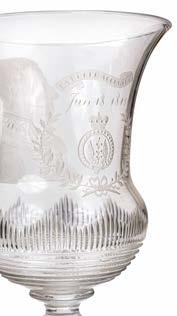
(1) £100 - £200

549* Duke of Wellington. A George III period porcelain plaque by Copeland & Spode circa 1812-14, painted with a portrait of the Duke of Wellington within a gold painted acanthus moulded border, inscribed in red to verso ‘Marquis Wellington from an original painting in the possession of the Countess of Mornington’, ‘Spode & Copeland’, some loss of paint to the border, 13 x 11 cm Illustrated in Spode by Leonard Whiter, page 171, plate 173. Anne Wellesley, Countess of Mornington (1742-1831) was the mother of the Duke of Wellington.
(1) £200 - £300
547* Duke of Wellington. A George III period pearlware puzzle jug circa 1815, printed in blue with a portrait of the Duke of Wellington surrounded by military trophies, the opposite side with an inverted portrait of Napoleon Bonaparte, a cannon to the front with cannon balls and initials D, J and F, the base with a drain hole activated by the hollow handle when the jug is tipped backwards, spout restored, 16 cm high

(1) £150 - £200
550* Duke of Wellington. A George III period porcelain plaque, unmarked but probably Worcester circa 1820, painted with a portrait of the Duke of Wellington within an olive branch wreath, inscribed in red to verso ‘Lord Wellington 1814’, some loss to the gold paint, 10 x 14 cm

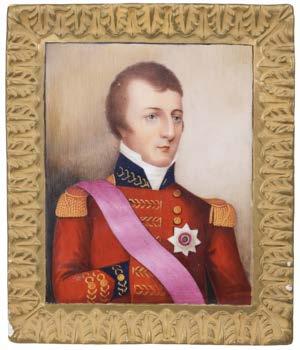
(1) £150 - £200
548* Duke of Wellington. A George III period porcelain jug probably Coalport, painted with a portrait of the Duke of Wellington facing right, within a foliate gilt border, a gold painted interlaced monogram and sprigs, on a white ground, unmarked, some rubbing to the gilding, restoration to the handle, 16 cm high, together with a 19th century pink lustre pearlware pottery jug relief moulded with Wellington and Blucher each on horseback plus another pottery jug, red transfer printed with a battle scene and titled ‘Wellington’, 10 cm high

(3) £100 - £150
551* Duke of Wellington. A
III yellow pottery jug circa 1815, printed and overpainted with the Marquis of Wellington on horseback at Salamanca, the opposite side printed with text ‘The Greatest General of the Age ...’ red painted flowers on a yellow ground, 15 cm high
(1) £150 - £200
 Lot 549
George
Lot 549
George
552* Duke of Wellington. A Regency bronze half bust of the Duke of Wellington by George Gammon Adams, hollow bronze and signed to the rear ‘G.G. Adams. SC. Published Janry 10th 1833’, 30 cm high George Gammon Adams (1821-1898) was an English portrait sculptor and medallist. He was born in Staines and the son of James Adams upholsterer and auctioneer. He entered the Royal Academy Schools in 1840 on the recommendation of the medallist William Wyon where he trained as a medallist. He exhibited several works at the 1851 Great Exhibition. The following year he was given the honour of making the death mask of the Duke of Wellington from which he made a marble bust of the Duke. Adams is also best remembered for a statue of Charles Napier in Trafalgar Square which he completed in 1856.

(1) £200 - £300
553* Duke of Wellington. A Victorian agate cameo brooch, carved with a bust of the Duke of Wellington facing right, set in yellow metal mount, 10 x 8 mm, presented in an oval giltwood frame, glazed, with manuscript label to verso inscribed ‘a cameo of the “Duke of Wellington” given by him to my aunt “Mrs Paterson” & given by her to me. To be an heirloom if I die unmarried, Arthur. W. Pack Beresford’, frame size 90 x 80 mm
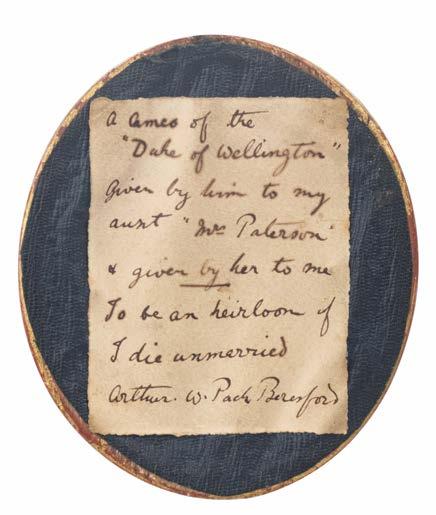

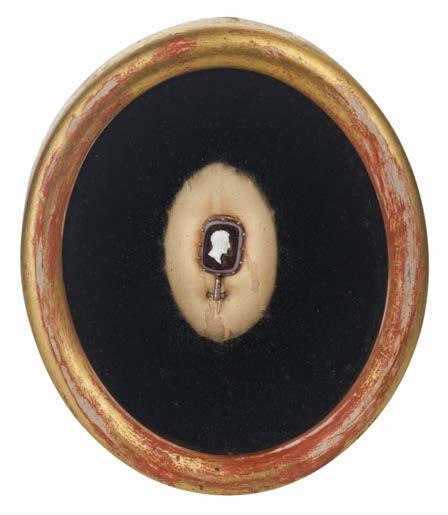
Major Arthur William Pack-Beresford (1868-1902) a native of Fenagh House, Bagnalstown, educated at Clifton College, Bristol and joined the Royal Artillery in 1897, he was commissioned Lieutenant in 1890 and Captain in 1897 before advancing to Major in 1900. He served in the Second Boer War and was severely wounded at Sannah’s Post on 31 March 1900, his gallant conduct is stated to have been conspicuous. After his recovery, he went on to be employed with the South African Constabulary (mentioned in despatches, London Gazette, 8 February 1900). Pack-Beresford died from enteric at Bloemfontein on 5 March 1902.
(1) £150 - £200
554* Duke of Wellington. A Victorian bronze circular wall plaque after G.G. Adams 1853, bust of Wellington facing right ‘Arthur Duke of Wellington’, ‘C.C. Adams Sc. Jan 10 1853’, 24.5 cm diameter, together with a collection of Wellington roundels and plaques including a large circular plaque cast with the Military General Service Medal 1793-1814 design, faintly engraved ‘The Army of the Peninsular’, 17.5 cm diameter
(6) £200 - £300

555* Duke of Wellington. A Victorian equestrian bronze after Matthew Cotes Wyatt (1777-1862), modelled as the Duke of Wellington on his horse Copenhagen, the naturalistic base inscribed ‘Boyer a Paris’ and stamped ‘Registered 9 Nov. 1852’, 15 cm high x 14 cm long
(1)
£150 - £200
557* Duke of Wellington. A fine Victorian yellow metal sliding dip pen made to commemorate the death of the Duke of Wellington, the barrel with registration mark for 20 October 1852, the terminal with a bust of Wellington and the slider with a flag battle honours, military trophies and birth and death date, engraved with scrolls, 13.5 cm long

(1)
£100 - £150
556* Duke of Wellington. A Victorian equestrian bronze modelled as the Duke of Wellington on horseback after Baron Carlo Marochetti circa 1844, the Duke in uniform holding his hat astride his horse Copenhagen on a naturalistic base, unsigned, reigns detached, minor loss to ear, 44 cm high


Baron Carlo Marochetti was commissioned to design the monument to Wellington in Royal Exchange Square, Glasgow in 1844.
(1)
£300 - £500
558* Duke of Wellington. A Victorian ormolu bust of the Duke of Wellington, modelled facing right, with a banner below cast ‘Wellington’ and leaves to the corners, presented in a deep rosewood frame, glazed, frame size 41 x 40 cm
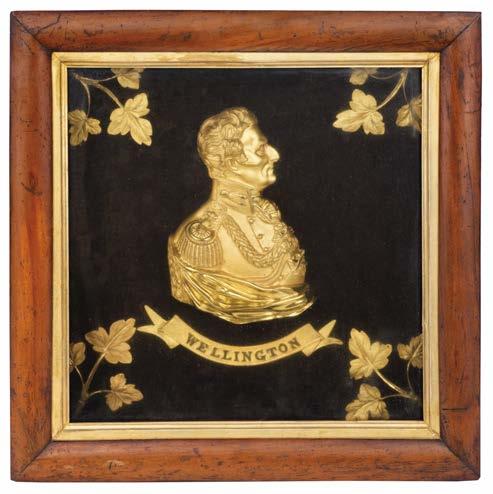
(1)
£200 - £300
559* Duke of Wellington. A Victorian parianware bust of the Duke of Wellington, unmarked but probably by William Adams & Co, modelled wearing uniform and orders, minor firing cracks, 36 cm high

(1) £200 - £300
561* Duke of Wellington. A Victorian silver-gilt memorial brooch made to commemorate the death of the Duke of Wellington by Elkington & Co, Birmingham 1852, the shaped hollow silver brooch with a bust of Wellington cast in relief (slightly loose), surrounded by cherubs and a three-part scroll beneath engraved ‘Virtutes Fortuna Comes’, stamped ‘Elkington & Co 1852’ to verso, 67 mm x 42 mm, gross weight 28.5g, together with another similar but unhallmarked and therefore probably silver-plated, the back with replacement pin and stamped ‘Pubd By Elkington & Co Octr 1852’, 68 mm x 40 mm

(2) £150 - £200
560* Duke of Wellington. A Victorian parianware bust of the Duke of Wellington by E.W. Wyon, modelled in classical drapery, the back impressed ‘E.W. Wyon F.’, 39 cm high Edward William Wyon (1811-85) joined the Royal Academy of Art School in 1829, exhibited at the Great Exhibition of 1851 and a year later made a bust of Wellington for Wedgwood.

(1) £200 - £300
562* Duke of Wellington. A Victorian style Wedgwood plaque, bust of the Duke of Wellington facing right on a blue ground, presented in an ebonised and brass frame, frame size 13.5 x 12 cm, together with a similar Victorian example, frame size 15 x 16 cm plus a smaller example in a circular frame, 10 cm diameter
(3) £100 - £150

565* Duke of Wellington. A Victorian yellow metal mourning brooch circa 1852, set with a convex glass sulphide panel with bust of the Duke of Wellington facing left, vertical pin to the back, 20 x 18 mm, together with a Victorian small glass sulphide paperweight with a bust facing left, 40 x 30 mm, an onyx cameo pendant, carved with a bust facing left, set in a yellow metal frame, 31 x 19 mm, plus a Victorian yellow metal mourning ring, with a bust facing left, the underside with an aperture for glass locket, size I/J



(4) £200 - £300
563* Duke of Wellington. A Victorian white marble cameo, carved as a bust of the Duke of Wellington facing right, presented in a period gilt glazed frame, frame size 16 x 13 cm, together with a similar white marble cameo laid onto a circular hardwood frame, frame size 20.5 cm diameter, plus a terracotta cameo of the Duke of Wellington after Joseph Flaxman and so signed, presented in an ebonised and brass frame with convex glass, frame size 19.5 x 14 cm, period label to verso printed ‘Britain Triumphant and inscribed ‘Duke of Wellington’ and indistinct markings
(3) £200 - £300
566* Duke of Wellington. A Victorian yellow metal seal fob, set with a carnelian panel carved with an intaglio bust of the Duke of Wellington facing right, 35 mm high, appears to have a gold test mark to one of the scroll mounts


(1) £200 - £300
- £300
567* Duke of Wellington. An Edwardian silver pipe tamper by William Henry Jackson, London 1903, modelled as half bust of the Duke of Wellington on integral socle, 55 mm high, 98g together with two brass Duke of Wellington pipe tampers, a Mr Punch brass pipe tamper, silver menu holder with Continental and English hallmarks, probably the Duke, 13 cm high, 87g and other items
(8) £100 - £150
 564* Duke of Wellington. A Victorian yellow metal gents mourning ring circa 1852, set with a convex glass sulphide panel with bust of the Duke of Wellington facing right, unmarked, size Q (1) £200
Lot 565
564* Duke of Wellington. A Victorian yellow metal gents mourning ring circa 1852, set with a convex glass sulphide panel with bust of the Duke of Wellington facing right, unmarked, size Q (1) £200
Lot 565
568* Duke of Wellington. Funeral of the Duke of Wellington pottery wall plaque in the style of a pot lid, from coloured prints from the original plates engraved for the Jesse Austin Process 1845-1870, reproduced by Kirkhams Ltd, Stoke of Trent, 1947, stamps to verso, 18 cm diameter together with a Victorian pot lid showing the Duke of Wellington, 11 cm diameter, plus two Victorian plates for ‘Strathfield Saye The seat of the Duke of Wellington’, 21.5 cm and 18 cm diameter
(4) £100 - £150 Lot
569* Duke of Wellington. Hands of His Father by Baron Marochetti (1805-1867), patinated copper sculpture formed as one hand resting on the other, one end engraved ‘Hands of His Father The Great Duke Modelled by Baton Marochetti’, the other end engraved ‘Presented to R.G.H. by H.G. The Duke of Wellington’, 20 cm long, presented on a modern display stand


One of three known examples, the other two are in the Royal Collection and the collection of the National Army Museum.
(1) £300 - £500
570* Duke of Wellington. A fine German strobwasser lacquered papier maché snuff box circa 1820, painted with a portrait of the Duke of Wellington, the interior numbered 8282 and inscribed ‘Strobwasser sehe, Fabrik in Braunschweig, 20 mm high x 64 mm wide x 90 mm deep, together with another papier maché snuff box, circa 1820, decorated with a portrait of the Duke of Wellington, general craquelure and some loss



(2) £100 - £150
(2) £100 - £150
572* Duke of Wellington. A Victorian Parian cameo after W.B. Kirk, R.H.A and made by W.H. Kerr & Co, Worcester, relief mould bust of the Duke of Wellington facing left, purple stamps to verso, presented in a gilt metal foliate frame with vertical pin, 65 x 50 mm, together with a smaller cameo by the same maker, 55 x 45 mm, another, unmarked but presented in a red leather case gold embossed ‘Wellington’, 60 x 45 mm, plus a Victorian sulphide cameo brooch of the Duke of Wellington facing right, presented in a gilt metal frame, 45 x 35 mm

(4) £200 - £300
573 Duke of Wellington. A Victorian pottery circular wall plaque, relief moulded with a portrait of the Duke of Wellington seated, polychrome painted, with a black border, 22 cm diameter, together with a smaller example but with the Duke facing right, firing cracks, 18 cm diameter

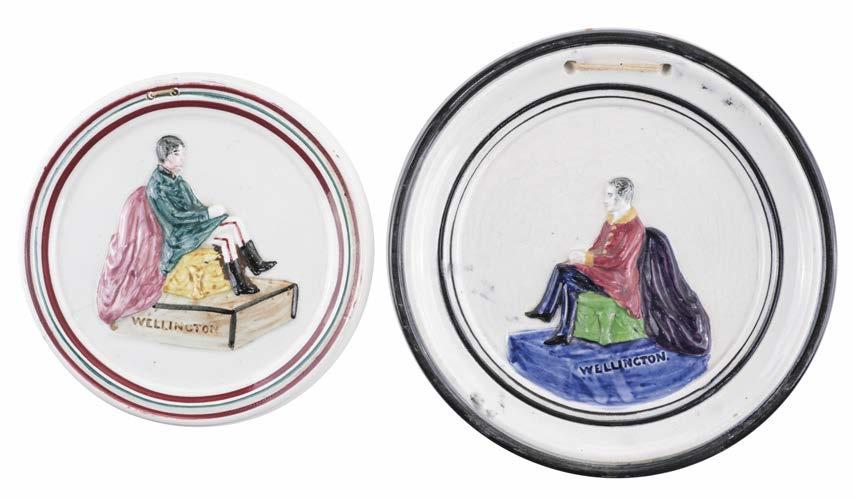
(2)
£100 - £150
574 Duke of Wellington. A Victorian pottery wall plaque, relief moulded bust of the Duke of Wellington facing right, polychrome painted on a white ground, old manuscript label to verso ‘Sir Arthur Wellesley Duke of Wellington’, 17.5 x 13 cm, together with two further plaques, one circular roundel, impressed ‘The Duke of Wellington’, 11 cm diameter, presented in a wooden frame the other in a black and gold painted frame, frame size 18 x 15 cm
(4) £200 - £300
575* Allegorical. An Arcadian scene, M. Gamble according to ye late Act, 1740, hand-coloured engraved leaf depicting a verdant garden with a queen holding a sword aloft in one hand and clasping a goblet in the other, a lady seated in a classical stone niche, and a gentleman reclining on the ground next to a sword, with classical statues of Apollo, Ceres, Minerva, and Jupiter, a fountain, trees and plants in urns, and shells, and a castellated mansion in the background, somewhat browned, and with extensive paper repairs to blank left-hand edge and to top edge on verso, mounted on black lacquered sticks, with chinoiserie decoration in gilt, 27 cm (10.5 ins)
Extremely rare fan by Martha Gamble: we have been unable to trace another.

Martha Gamble was a highly regarded print seller and fan maker, who owned The Golden Fan in St Martin’s Court, St Martin’s Lane. She regularly advertised her fans in 18th century newspapers and journals such as Fog’s Weekly Journal and Daily Advertiser, but tantalisingly little appears to be known about her. (1) £300 - £500
576* Almanack fan. Botanical calendar fan, London: Publish’d as the Act directs, by John Cock & I.P. Crowder, Wood Street, Jany. 1st. 1794, double-sided folding paper fan, the hand-coloured engraved leaf with divisions for each month of the year, January to June on recto, and July to December on verso, each month with a poem and appropriate engraved botanical vignette, above information regarding holidays, phases of the moon, etc., toned, folds splitting in places, a few small losses to lower edge, some archival tape repairs to upper and lower edges (mainly to latter), mounted on wooden sticks, 28 cm (11 ins), together with: Literary fan. Sterne’s Sentimental Journey, Publish’d as the Act directs by the Proprieter, Apl. 1. 1796, folding paper fan, the leaf with 3 hand-coloured oval stipple engravings ‘Yorick & the Monk’, ‘La Fleur & Madame de L.’, and ‘Yorick & the Glovers Wife’, hand-painted with lily flowers between, and with quotations from Sterne printed beneath, browned, slightly chipped and frayed to lower edge (with a small paper repair), mounted on bone-tipped wooden sticks, 25.5 cm (10 ins)

First item rare: not in the Schreiber Collection.
Second item: Schreiber Collection 76, p.16.
(2) £150 - £200
577* Burma. A hand-painted folding fan, circa 1900, a large folding cream silk fan, the leaf hand-painted all over in colours and highlighted with gold, depicting numerous male and female figures in Burmese dress, elephants, horses, palm trees and blossom trees, and a pagoda in the centre, some small water-stains on verso, lightly rubbed to folds, occasional marks, slightly edge-frayed in places, mounted on bone sticks (with expert repair to upper guardstick), 43 cm (17 ins)

(1) £150 - £200
578* Dance fans. Eighteen of the most Favorite Country Dances, circa 1789, folding paper fan, engraved with musical notation and lyrics for dances including The Haunted Tower, Miss Dykes Fancy, Paynes Jigg, Kiss Me Sweetly, The Harriot, The Fife Hunt, a few small discreet repairs to closed tears, mounted on wooden sticks, black ink contemporary inscriptions to upper and lower guard sticks respectively ‘The Gift of Master Fletcher Gwernhayfed’ and ‘The Gift of Mr. Lloyd Fletcher’, 24.5cm (9.75ins), together with:
Duchess of York, circa 1791, folding paper fan, stipple-engraved with an oval portrait of Frederica Charlotta Ulrica, Duchess of York, surrounded by musical notation and lyrics for dances including Duchess of York’s Fancy, The Russian Tippet, Miss Bentick’s Fancy, Shuter’s Hornpipe, Money in Both Pockets, The happy Lass, trimmed to right-hand edge with loss of a fold and corresponding stick, toned, some paper repairs on verso, mounted on bone sticks, 24.5 cm (9.75 ins)



Two rare dance fans, each without imprint, and therefore probably pirated copies.
The first item is not in the Schreiber Collection; we have seen only one other similar, with the same title but different dances, published by Sudlow in 1789. We have been unable to trace the romantic Mr Lloyd Fletcher, but presume the place name is a corruption of Gwernyfed in Wales.
The second item is similar to Schreiber Collection 11, p.4, published by Thos. Weightman in 1791. An early example of royal wedding memorabilia, the fan commemorates the marriage of Princess Frederica of Prussia and Frederick, Duke of York, second son of George III, which took place in 1791. (2) £200 - £400
579* Enigma fan. A fan with riddles, published by T. Balster, January 31, 1792, folding paper fan, the engraved leaf with central oval medallion portrait of a lady, and scattered cartouches containing puzzles and riddles, hand-coloured details and outlines, verso with a ten commandments tablet hanging from a large bow above a laurel wreath incorporating further conundrums, toned and a few fox spots, some short edge-splits and discolouration from adhesive repairs, 8 cm horizontal closed tear to lower edge with adjacent small loss on verso (repaired), mounted on wooden sticks, 25 cm (9.75 ins), together with:
Fortune-telling. The Art of Divination, Publish’d by Dyde & Scribe, circa 1800, folding paper fan, the etched leaf with hand-coloured medallion portrait of a bearded man holding a large open tome bearing the title ‘Book of Fate’, flanked by various predictions in a grid, browned and worn, with repairs and some small losses, mounted on wooden sticks, 28.5 cm (11.25 ins)
Both fans are fare: Neither is to be found in the Schreiber Collection, which lists two other fans printed by Thomas Balster (‘The Queen’s Royal Fan’, and ‘The Map of England’), and one by Dyde & Scribe (‘Charade Fan’); we have not traced another of either of these fans sold at auction or held by an institution.
(2) £200 - £300
Lot 578580* French Revolution.The Fête de la Fédération, 14th July 1790, circa 1790, double-sided folding paper fan, the recto with hand-coloured etching depicting the fête of the French Federation, with a view of the altar in the Champ de Mars in the centre, flanked by numerous spectators and the National Guard, with the royal box on the left, and triumphal arch on the right, within a patterned border stencilled in blue and brown, verso with printed key to the illustration, lettered in centre ‘le serment fait du Roi, le 14 Juillet 1790’, some tiny splits to fold edges, and a little faint creasing, mounted on wooden sticks, 28 cm (11 ins)

Not in Schreiber, and we have been unable to trace another such fan at auction.
An extremely rare propaganda fan, in very good condition, commemorating the Fête de la Fédération which was held exactly a year after the Storming of the Bastille, as a symbol of peace and a celebration of the unity of the French nation. Bearing in mind what was to follow, it is hardly surprising that this is a very scarce fan indeed, since, with its rallying cry in favour of the king, it undoubtedly became a dangerous object to own.

(1) £400 - £600
581* Historical. Chronological Tables of English History, Publish’d 17th. April 1789, by J. Pike, No. 36, Cheapside, hand-coloured doublesided folding paper fan, each side engraved with 2 rows of 8 medallion portraits of monarchs with text below (William the Conqueror to George II), a trifle rubbed and toned in places, but overall in good condition, mounted on wooden sticks, 25.5 cm (10 ins), together with:
The United Sisters, London: Publish’d by Ashton and Hadwen, Little Britain, Jan. 1. 1801. Enter’d at Stationers Hall, folding paper fan, the leaf a stipple engraving by George Wilson, depicting three female figures with linked hands representing England, Scotland, and Ireland, flanked by a unicorn and a lion, with entwined rose, thistle, and shamrock motif above, and the royal arms below flanked by 4 lines of verse ‘Fair Sister Isles ... blest as free’, 1 or 2 fox spots and folds a little toned, but generally in good condition, mounted on wooden sticks, 25 cm (10 ins)
First item rare: not in the Schreiber Collection (which lists no fans published by Pike); we have been unable to trace another at auction or in an institution, or indeed any other fan by J. Pike of Cheapside.
Second item: Schreiber Collection 36, p.71 (silk; unmounted).
Commemorating the Acts of Union passed on 2nd July 1800 and 1st August 1800; the twin Acts united the Kingdom of Great Britain and the Kingdom of Ireland to create the United Kingdom of Great Britain and Ireland. The union came into effect on 1st January 1801.
(2) £300 - £500
582* Historical. Eleanor of Aquitaine crusading in the Holy Land, circa 1860s/70s, hand-coloured engraved leaf depicting a scene from the Crusades with Eleanor of Aquitaine and her husband King Louis VII meeting a Saracen leader in the Holy Land, framed by tiny gold spangles at either side, backed with ivory gauze, some splitting of folds to left and right edges, with associated staining (from old adhesive?), mounted on gilt decorated pierced bone sticks, 24 cm (9.5 ins)
Rare: we have been unable to trace another fan bearing this engraving.
(1) £150 - £200
584* Malbrouk. The Celebrated French Marlborough Song, France, circa 1785, double-sided folding paper fan, the recto with handcoloured etching of 3 vignettes: Malbrouk (the Duke of Marlborough) taking leave of his wife before going off to war, flanked by a mounted page bringing news of Malbrouk’s death (on left), and Malbrouk’s tomb (on right), verso with printed and ink musical notation, and 19 verses in French titled ‘The Celebrated French Marlborough Song’, toned and dusty, 1 or 2 discreet repairs, alternating pairs of bone and wooden sticks, horizontal break to upper guard stick with riveted metal splint on verso, 24.5 cm (9.75 ins)


Schreiber Collection 38, p.71/2 (unmounted).
(1)
£150 - £200
583* Lace. A Brussels lace fan, early 20th century, folding lace fan of hand-made cream Brussels needle lace, mounted on faux blond tortoiseshell sticks (one with small abrasion on verso), upper guardstick with yellow metal monogram ‘AR’ topped by a coronet, 25.5 cm (10 ins), together with another lace fan similar, plus: A Bedfordshire Maltese lace fan, circa 1910, folding lace fan of hand-made cream Maltese lace, a few minor breaks in lace, mounted on mother of pearl sticks, 21 cm (8.25 ins),


(3) £150 - £200

585* Ostrich feather. A large ostrich feather fan, early 20th century, folding white ostrich feather fan, mounted on mother of pearl sticks, engraved with volutes and tendrils inlaid with black and gold (slightly rubbed in places), 47 cm (18.5 ins), contained in a Duvelleroy fan box, rubbed and some wear, lid with printed label inside and inscribed on outside ‘FANS’ in blue marker pen, plus a large black ostrich feather fan mounted on faux tortoiseshell sticks, with twisted tasselled cord to handle, 43 cm (17 ins)

(2) £150 - £200
586* Souvenir fan. The Crescent Buxton, circa 1790, folding paper fan, with oval engraving printed in black of a large neo-classical semi-circular building, titled to lower edge, and enclosed in a double border of silver spangles (a few missing), slightly dusty and toned, mounted on bone sticks, 24.5 cm (9.75 ins), together with: Neoclassical fan. A pictorial engraved fan, circa 1800, folding paper fan, the leaf engraved in pale blue with 3 oval depictions of Grecian urns, each within a border of spangles (some missing), on a hatched dotted line ground, hand-painted borders of laurel leaves and berries in gold and blue to upper and lower edges, both side edges with 1 or 2 folds adhered together (right-hand guard stick lying on top of next stick), occasional small holes and splits to folds (one with slight loss), verso with hand-painted laurel wreath in blue, and with 3 folds strengthened with paper, mounted on bone sticks, loss to mother-of-pearl rivet, 24 cm (9.5 ins)
First item: rare commemorative fan celebrating Buxton Crescent, designed by John Carr of York, and built for the fifth Duke of Devonshire between 1780 and 1789, as the centrepiece of his Georgian Spa development at Buxton, Derbyshire.

See Schreiber Collection, 108, p.82: a slightly different view to ours, etching with aquatint, printed in blue. The British Library holds an unmounted leaf with the same etching as the Schreiber fan, but printed in green (1891,0713.453), as does The Fan Museum.
Second item also rare: we have not been able to trace another example of this fan.
(2) £200 - £300
587* [Ascher, Zika (1910-1992)]. A collection of embroidered, woven, and printed fabrics, 17th century & later, including: a pair of late 19th century hand-embroidered Chinese cuffs, worked in polychrome silks and metal threads on a cream silk ground, depicting figures, pagodas, bridges, and vegetal forms, slightly dusty in places, each 61.5 cm (24.25 ins), manuscript and printed label attached with thread ‘Liberty of London’; a 19th century fine cotton Persian prayer cloth, block-printed in reds, greens, and blues on a cream ground, with central large boteh and a pair of peacocks within a scalloped niche frame, surrounded by floral and foliate motifs, with decorative Arabic script above, within a multibanded floral border, some browning and losses, 183 x 110.5 cm (72 x 45.5 ins); a double-ended cloth similar, block-printed with exotic birds and floral motifs, faded, and with some splits, 129.5 x 68 cm (51 x 26.75 ins); a late 19th century Indo-Persian metalwork table mat, hand-worked on black wool, with fringed edging, 45 x 45 cm (17.75 x 17.75 ins); a small pointed hemmed piece of metalwork embroidery, English, late 16th/early 17th century, 17.5 x 7.5 cm (7 x 3 ins); an early 19th century woven shawl, somewhat worn, 99 x 108 cm (39 x 42.5 ins); a Franco-Prussian printed fabric panel, circa 1870, with repeated portrait medallions of Wilhelm I, Bismarck, and other statesmen, encircling a battle scene, discoloured and worn, with loss, 200.5 x 62 cm (79 x 24.5 ins); and some small fragments of early brocade, various sizes and condition
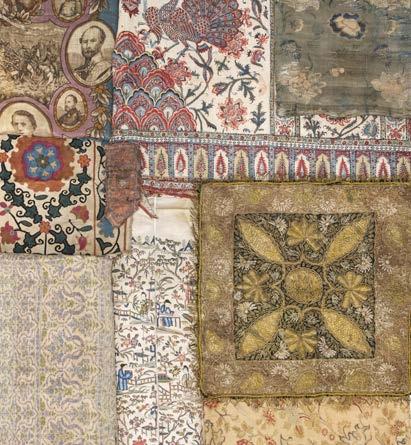
Provenance: from the Zika Ascher Collection and Ascher Archives. Zikmund Ascher (1910-1992), known as Zika and nicknamed ‘The Mad Silkman’, was a Czech textile businessman, artist and designer who, with his wife Lida (1910-1983), became a leading name in the field of British textiles, art, and fashion. The pair, who arrived in Britain at the outbreak of WWII, were innovators who pushed the conventions of British fabric design in daring new directions. They brought colour and vibrancy to the bleak face of post-war textiles, and with this, hope and optimism was conveyed through their work. They experimented with bold patterns and new and unconventional fabrics, including mohair, rayon, parachute nylon and cheesecloth, influencing top couturiers such as Christian Dior, Cristobel Balenciaga and Yves Saint-Laurent, and they also collaborated with leading artists such as Georges Braque, Pablo Picasso, Henry Moore, Ivon Hitchens and Henri Matisse, to produce a series of iconic silk scarves. In 1987 the V&A in London mounted a retrospective exhibition of the Aschers’ work, and published an accompanying book by Valerie D. Mendes and Frances M. Hinchcliffe entitled Ascher: Fabric, Art, Fashion. More recently, in 2019, an impressive publication The Mad Silkman: Zika and Lida Ascher Textiles and Fashion, by Konstantina Hlaváckova, accompanied an exhibition at the Museum of Decorative Arts in Prague, paying a lasting tribute to the important contribution made by the Aschers to British fashion.
(34) £200 - £300
588* Aubusson tapestry. La Bascule, 19th century, woven wool tapestry, depicting a young girl being elevated on one end of a seesaw, and 3 children on the other end, in a verdant river landscape with rustic dwellings, within a foliate-clasped border, some expert and unobtrusive consolidation, backed with brown cotton, verso with label of conservator ‘Atelier Jean-Marie Dor “Aubusson”’, and with velcro attached to top edge, 183 x 160 cm (72 x 63 ins)
(1) £200 - £400
589* Aubusson tapestry. L’Escarpolette, 19th century, woven wool tapestry, depicting a young girl and boy seated on a swing hanging from a tree on a river bank, with flowers, including irises, and a dragonfly, some expert and unobtrusive consolidation, backed with grey cotton, verso with label of conservator ‘Atelier Jean-Marie Dor “Aubusson”’, and with velcro attached to top edge, 158 3/4 x 123 cm (62.5 x 48.5 ins)


(1) £150 - £200
590* Bag. A silver gilt evening bag, probably American, circa 1920, black velvet bag, silver gilt frame stamped ‘Sterling 2085’ elegantly pierced in the rococo style with cherubs and a c-scroll cartouche, engraved on one side with monogram ‘JWAL’, the catch formed as a cherub’s head, the lining beige moiré taffeta, with a velvet carrying handle, 20 x 17.5 cm (8 x 6.75 ins) excluding handle
(1) £100 - £150

591* Bedcover. A large broderie perse coverlet of circa 1780s chintz, English, early 19th century, composed of numerous appliquéd hand blocked chintz motifs in pink, blue, cream, and brown, expertly attached with buttonhole stitch to a fine cream cotton ground, creating the design of a large flower basket in the centre, including roses, a passion flower, poppies, fuschias, auriculas, etc., surrounded by exotic birds, within a scrolling leaf, berry, and flower frame, large cornerpieces of a cornucopia of flowers, with large flower and vase motif at centre of each side, outer border of flowers between ribbon swags (petering out at right-hand side of top edge, as made), some dust-soiling and small marks, lower corners toned, 14 cm closed tear to left-hand border, a number of neat period darns, later cream cotton backing with machine-stitched hem, 310 x 249 cm (122 x 98 ins)

A beautiful and impressive appliquéd bedcover, a particularly good example of the art of broderie perse.
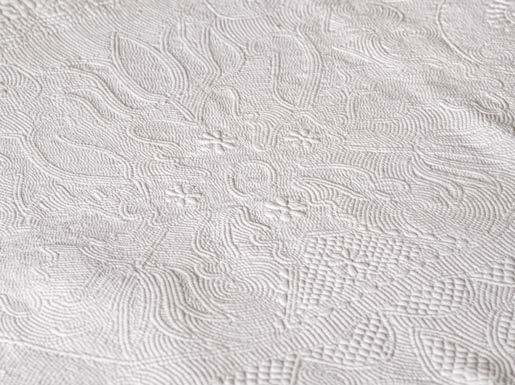
(1) £600 - £800
592* Boutis de Provence. A finely-worked quilt portion, probably French, early 19th century, padded white cotton, pieced, with 2 vertical joins, close-quilted by hand overall, with spirals terminating in flowers and hearts, and a two-handled urn at one end, one small area of toning, 46 x 153.5 cm (18 x 60.5 ins), together with
A large Boutis de Provence marriage quilt, French, early 19th century, padded white linen bedcover, close-quilted by hand overall, large central panel with lattice design set within a wide border of patterned diamonds, 3 sides of border with repeated large motif of spirals, hearts, and flowers, remaining side with large motif of flowers and heart within a wreath, some toning and a few stains, portion with crudely repaired closed tear (approximately 21 x 11 cm), faint ink stamp to edge on verso, 209.5 x 226 cm (82.5 x 89 ins), plus a French boutis petassoun quilt, mid 19th century, small infant lap quilt of hand-quilted white cotton, with flower basket design, toned, and some small stains, 49.5 x 46 cm (19.5 x 18 ins)
(3) £300 - £500
593* Carpet. An early 20th century Persian silk carpet, probably Kashan, the central medallion with wild animal border and on a dark blue ground and multi banded border, the whole piece finely woven with animals, floral scrolls and geometric decoration, a long tasselled fringe to each end, generally in good original condition with little sign of wear, approximately 261 x 173 cm (103 x 68 ins)
(1) £500 - £700

594* Children’s clothes. A Regency boy’s linen skeleton suit, late 18th/early 19th century, hand-stitched cream linen skeleton suit, comprising a long-sleeved shirt with stand-up collar of fine white linen, front with 2 tucks either side of opening, latter with 4 metal button closures stamped ‘1’ within a wreath and lettered ‘United States of America’ around edge, back of shirt with 6 tucks, lower edge of shirt with 8 further buttons, matching, for attaching the trousers, latter with front pockets, and cuffed at ankles, with button closure (buttons replaced), several very small holes (largest 5 x 5 mm), waist with a few rust marks (from buttons), chest 74 cm (28 ins), sleeves 25 cm (9.75 ins), waist 30 cm (11.75 ins), length of trousers 56.5 cm (22.25 ins), overall length 84 cm (33 ins), together with:
A Victorian boy’s velvet dress, hand and machine-stitched all-inone ensemble comprising conjoined waistcoat, jacket, and skirt: maroon grosgrain taffeta waistcoat with collar, and front closure with a metal hook and stitched loop and 7 mother of pearl buttons (1 or more replaced?); waistcoat sewn into a wine-coloured velvet jacket edged with maroon taffeta and lined with cotton twill, with flap pockets, long sleeves, embellished with scalloped cuffs and mother of pearl buttons, and 11 long laps at rear, closure below collar with button missing; matching velvet skirt with wide taffeta trim, attached to waistcoat with stitching at waist, front closure with 4 buttons as before, 7 metal hooks and corresponding loops on inside, overall some small light marks, and 1 or 2 tiny holes, chest 66 cm (26 ins), sleeves 39.5 cm (15.5 ins), waist 64 cm (25 ins), overall length 68 cm (26.75 ins), plus 3 19th century christening gowns, generally in good condition
Provenance: Second item from a collection which came from the family of Thomas Crewe Dod (1754-1827) of Edge Hall, Malpas, Cheshire.
First item: a rare survival of a boy’s outfit made during a period of great transformation in the history of children’s clothing. Prior to the 1780s boys had been attired in tailcoats and breeches in imitation of those worn by men. The last two decades of the 18th century saw the introduction of the infinitely more practical and comfortable skeleton suit, typically composed of a jacket or shirt and long trousers which buttoned together as here. This suit of cool linen is finer and less structured than the formal suits generally seen in family portraits, and was likely made for hot summer days, with the comfort of the child in mind, though perhaps not intended for boisterous play. Children’s, and particularly boys’, clothing is incredibly scarce, and the survival of a cream lightweight skeleton suit in such good condition is highly unusual.

(5) £200 - £300
595* Clothing. A 1930s wedding or court dress, full length fitted cream lamé gown with train, handmade, patterned with leaves and fully lined with cream sillk, with round neck, long sleeves (padded on shoulders and buttoned at cuffs), and metal eye and stitched hook closure to side, a few pulled threads, staining to underarms, lining of train marked, bust 90 cm (35.5 ins), waist 74 cm (29 ins), sleeves 63 cm (24.75 ins), length 139 cm (109.5 ins), length including train 213 cm (84 ins), together with 6 items of 1920s clothing, comprising: a rare girls’ robe de style dress of gold lace over silk, with ribbon straps, metal stud closures at back, flower trim at neck and around waist and stiffened panniers, and a corsage of grapes at waist, somewhat damaged, with losses, bust 66 cm (26 ins), waist 62 cm (24.5 ins), length 61 cm (24 ins); a gold lamé dress with foliate pattern, with lined and boned fitted bodice, padded bust, metal zip closure at back, narrow self straps, and a flared skirt with gathers at rear, occasional light marks, bust 82 cm (32 ins), waist 66 cm (26 ins), length 97 cm (38 ins); a pink and silver lamé unstructured jacket, with 3/4 length sleeves, silk-lined patch pockets at front, and 3 short slits in hem at rear, bust 117 cm (46 ins), sleeves 39.5 cm (15.5 ins), length 61.5 cm (24.25 ins); a gold lace overdress, with pattern of stylised roses, round neck (self button at rear), petal sleeves of net (one with loss of gather stitching), and short train at rear, bust 84 cm (39 ins), waist 60 cm (23.5 ins), sleeves 19.5 cm (7.75 ins), length 107 cm (42 ins); a full-length biascut lamé flapper dress, sleeveless, with floral pattern in orange and yellow, and self pendant to neck, small hole to left shoulder, v-neck at rear slightly torn, short tear in hem, bust 90 cm (35.5 ins), waist 80 cm (31.5 ins), length 140 cm (55 ins); and a sleeveless cutwork black overdress with cream stitching, bust 83 cm (33.5 ins), waist 86 cm (34 ins), length 113 cm (89 ins), plus a 1940s full-length chiffon and embroidered net gown (some damage), and a 1950s full-length blue taffeta evening dress with ruched bodice
(9) £300 - £500

596* Clothing. A beaded and metalwork Victorian bodice, by Power, Sloane Street, London, circa 1870s, cream satin silk boned sleeveless bodice, hand and machine-stitched, and elaborately hand-beaded and embroidered all over with oak leaves and acorns, using simulated seed pearls, paste stones, seed beads, spangles, cream silk thread, and heavy metal threads worked in stem stitch and bullion stitch, incorporating a wide ruched band of cream chiffon above the waist, metal hook and eye closures to rear, lined with cream silk, woven waist band fastener to lining with maker’s name ‘Power 132 Sloane Street S.W.’, worn, with fabric perishing in places and some losses to embellishments, bust 76 cm (30 ins), waist 46 cm (18 ins), length 46 cm (18 ins), together with a cream silk satin short-sleeved wedding dress with short train, circa 1910, overlaid with elaborately embroidered and beaded chiffon, faux flower posy at waist and 2 more to bow detail of train, woven waist band fastener to lining with maker’s name ‘Osborn 31 & 32 Sussex Place S.W.’, worn, and a late Victorian bodice and skirt of cream silk satin and lace, the skirt with short train, 4 cm tear to right-hand side of bodice, skirt foxed and spotted
A beautiful bodice embellished with that symbol of prosperity and good fortune, the acorn, most likely made for a wedding or perhaps a court occasion, by Power who were court dressmakers in Sloane Street, London.

(4) £200 - £300
597* Clothing. A collection of juvenile and adult sailor outfits, mostly early 20th century, comprising children’s garments: 4 sailor tops with collars, 3 with manufacturer’s woven label ‘Rowe of Gosport’ (one with woven rank badge on left sleeve), 1 pair of white trousers with buttoned front flap and lacing at the back (with ‘Rowe of Gosport’ label), a pleated navy skirt with woven label ‘Rowes of Bond Street’, a cream woollen square-necked vest with side ties, and a white cloth hat; and adult’s garments: a navy woollen jacket with collar and rope lanyard, 2 sailor tops with collars, 2 squarenecked shirts (one with woven rank badge), and a sailor collar, various sizes, mostly in good condition

(14) £100 - £150
598* Clothing. A pair of Regency silk half boots, circa 1820s/30s, pale blue silk satin ankle boots, stitched by hand, with square toes, small rosette to front of each, and side-lacing with tongue, the stitched eyelets with original silk lacing ribbon (one missing some length and metal aiglet), lightly faded and a little dusty to edges in places, lined with linen, flat leather soles, length 24 cm (9.5 ins), together with:
A pair of Regency metalwork velvet slippers, dark blue velvet slippers, stitched by hand, with square toes, hand-worked with allover pattern of leaves and tendrils, in gold metallic thread incorporating spangles, one shoe with short split at back of heel, lined with linen, flat leather soles, length 24 cm (9.5 ins), and
A silk brocade reticule, circa 1810, yellow silk brocade bag, with large floral pattern, hand-stitched, lined with cream cotton, with original matching silk ribbon drawstring, 30.5 x 20.5 cm (12 x 8 ins)

Three Regency wardrobe essentials, all surviving in very good condition. In particular, silk boots are rarely found in such wonderful unworn condition, due to their obviously delicate nature.
(5) £300 - £400
599* Coronation robes. A set of robes belonging to Lord and Lady Cross, 1901 and later, comprising: a silver gilt Viscount’s coronet, hallmarked R. & S. Garrard & Co., London, 1901, with 16 silver balls (tarnished), crimson velvet cap, with gold thread finial topped with a pineapple (latter detached), and ermine fur trim to base rim, lined with cream silk stamped with maker’s name in gilt, 23 cm (9 ins) x 21 cm (8.25 ins); a Viscount’s robe of crimson velvet with miniver cape, collar, and edging, the cape with 2.5 rows of ermine tails, fur toned, lined with cream silk, lining discoloured and perishing at neck, and soiled at foot, cream grosgrain ribbon ties (later?), velvet to reverse of fur collar perishing, length 193.5 cm (491.5 ins); a long crimson velvet waistcoat, lined with cream silk, lining stained and perishing in places, fur trim removed, length 91 cm (231 ins); a silver gilt Viscountess’s coronet, hallmarked Edward Barnard & Sons Ltd, London, 1936, with 16 balls (tarnished), crimson velvet cap finished with a gold thread pineapple, base rim trimmed with ermine, cream silk lining and drawstring compartment, diameter 13.5 cm (5.25 ins); a Viscountess’s fitted kirtle of crimson velvet, scalloped edges and sleeves trimmed with miniver (several areas of insect damage to fur at hem), fastening at front embellished with seed pearls and beads, partially lined with cream silk (lightly soiled in places at foot), bust 82 cm (32 ins), waist 76 cm (30 ins), sleeves 26.5 cm (10.5 ins), length 160 cm (63 ins); a Viscountess’s mantle of crimson velvet, edged with miniver (a couple of small areas of insect damage at foot) and with capelet of miniver with 2.5 rows of ermine tails (lightly toned), lined with cream silk (somewhat perished overall, though holding), length 261.5 cm (103 ins); and a pair of gold metal shoulder cordons, each composed of wide twisted cord tied in a bow, the tails each terminating in a tassel, overall length 58 cm (23 ins), together with order of service volume: The Form and Order of the Service that is to be Performed and the Ceremonies that are to be Observed in the Coronation of their Majesties King George VI and Queen Elizabeth in the Abbey Church of S. Peter, Westminster on Wednesday, the 12th day of May, 1937, Eyre and Spottiswoode, 1937, printed in red and black throughout, original Japanese vellum, with monarch’s armorial gilt stamped to upper cover, 4to Provenance: From the Cross family, by direct descent.

The Viscount’s robe and coronet were worn by Richard Assheton Cross, 1st Viscount Cross (1823-1914), at the coronation of Edward VII in 1902, and possibly by the 1st Viscount a second time, at the coronation of George V in 1911. Both sets of robes and coronets were worn at the coronation of George VI in 1937, by the 3rd Viscount, Assheton Henry Cross (1920-2004), when he was only 17, and his mother, Maud Evelyn Cross (1889-1976), the 3rd Viscount having inherited the title as a minor aged 12. Both sets of coronation robes were worn again, at Queen Elizabeth II’s coronation in 1953, by the 3rd Viscount and his wife Patricia Mary Cross (1928-2014).

Richard Assheton Cross, 1st Viscount Cross, was a British statesman and Conservative politician who served as Home Secretary between 1874 and 1880 under Benjamin Disraeli, and again between 1885 and 1886 under the Marquess of Salisbury. A lawyer and banker, Cross is widely acknowledged as one of the country’s outstanding home secretaries. The Cross Act of 1875 empowered municipalities to buy and demolish slums and to build housing for rental. In the same year Cross carried through Parliament: the Factory Act, regulating the employment of women and children in textile mills; the Public Health Act, a comprehensive sanitary code; and two statutes reinterpreting Gladstone’s trade-union legislation of 1871. Cross was created viscount in 1886, and held the secretaryship for India from that year until 1892. From 1895 to 1900 he was Lord Privy Seal.
Cross was a fellow of the Royal Society, a bencher of the Inner Temple, and an ecclesiastical commissioner, and was keenly interested in the affairs of the church. His honours included, besides the viscountcy, the Knight Grand Cross (1880) and Knight Grand Commander (1892). He was among the small band of her ministers to whom Queen Victoria gave her close personal friendship. He is mentioned frequently in her journals from 1877 until 1900, often as a guest at the royal residences of Balmoral, Windsor and Osborne.
An attractive set of robes, with interesting provenance, offered in timely fashion in this, the year of the coronation of King Charles III.


(9) £1,000 - £1,500

600* Curtain. A rose-printed cotton curtain, probably English, early 20th century, a large curtain of floral cotton, with bold pattern of roses and wisteria, amongst thorny stems and woody branches, in deep and pale pink, green, and brown, central vertical seam, machine-stitched gather to top edge, with sewn metal hooks, 2 small holes 10.5 cm in from right-hand edge, width of gathered top edge 173 cm (68 ins), width of lower edge 246 cm (97 ins), drop 241 cm (95 ins)
(1) £150 - £200
601* Curtains. A pair of large chintz bed curtains & matching sofa cover, French, 19th century, a pair of hand-stitched glazed cotton chintz curtains, with a blue-printed pattern of roses, poppies, and sweet william flowers, connected by woody stems, on a ground of beige stripes composed of semé dots, 4 vertical joins to each, that to extreme left and right respectively with final panel of fabric turned the other way out (to go behind bed), top edge handgathered, leading and lower edges trimmed with wide scroll gimp in pale green and white (worn in a few places), left-hand curtain with 8 cm vertical tear to top edge, width of gathered top 208 cm (82 ins), width of lower hem 410 cm (161.5 ins), drop 291 cm (114.5 ins); and a matching hand-stitched fitted sofa cover, with gathered circular frames for front of arms (diameter 12.5 cm/12 ins), trimmed with the same gimp (the circles with gimp rosette in centre), lined with cream cotton, 210 cm x 273 cm (82.5 x 107.5 ins)

A beautifully-made set of curtains and sofa cover in good, useable condition.
(3)
£300 - £500
602* Curtains. A pair of large chintz curtains, French, 19th century, a pair of hand-sewn glazed cotton chintz curtains, with a pattern of sinuous vertical pink and yellow rose stems, on a grey and white ground of flowers and stripes, 2 central vertical joins to each, outside edges of curtains trimmed with green silk ribbon, leading edges with hand-gathered frill trimmed on both sides with (later?) green tape (part of frill to right-hand curtain reattached with machine stitching), top edge hand-gathered, with some original brass curtain rings present, lower hems unstitched, toned, and some staining, occasional edge-fraying and small holes, top left corner of left-hand curtain torn with loss, sepia coloured glazed cotton lining, width of gathered top 112cm (44 ins), width of lower hem 200 cm (79 ins), drop 296 cm (116.5 ins)
(2) £300 - £500
603* Curtains. A pair of large chintz curtains, French, 19th century, a pair of hand-stitched glazed cotton chintz curtains, with a large pattern of flowers, including roses, chrysanthemums, foxgloves, fuchsias, carnations, and narcissi, in shades of red, pink, blue, green, and light brown, on a ground of alternating blush and celadon wide and narrow stripes, central vertical join to each, uniformly toned, some areas perished with occasional small losses (notably to leading edges), 1 or 2 small stitched repairs, some spotting and stains, lined with pale green glazed cotton, width of each approximately 159 cm (62.5 ins), drop 314 cm (123.5 ins)


A rare survival of two large pieces of chintz, the pattern, with its riot of flowers, still startlingly bright.
(2) £500 - £800

604* Education. Five lithographs issued by the Working Men’s Educational Union, 1850s, 5 colour lithographed educational banners, printed on cream cotton, each with circular ink stamp to lower corner ‘Working Men’s Educational Union, King William St., Trafalgar Square’, 3 titled in contemporary ink to verso: ‘Ganges’, ‘India - Shanam Climbing the Palengra’, and ‘Juggernorth’, ‘Bethany’ with printed title at head, fifth banner untitled (Nazareth), loops to top left and right-hand sides for hanging, all but Ganges with brass eyelets to corners, occasional fox spots and marks, Nazareth with small water stain, but generally all in very good condition, each approximately 91 x 120 cm (35.75 x 47.25 ins)

Founded in 1853, the Working Men’s Educational Union was a philanthropic venture designed to provide education for the working classes. These hangings were specially made for use in their lectures. Printing on cotton instead of paper meant that the banners were more durable, and had the added advantage that paper duty did not have to be paid, a tax which was not fully abolished until 1861.
(5) £200 - £300
605* Embroidered panel. A silk panel of 18th century appliquéd embroidered metalwork motifs, 7 expertly stitched motifs within a border, comprising large flower urn cornerpieces, each different, motifs including a carnation, acorns, a Tudor rose, and a tulip, with flaming fleur-de-lys ornament to 2 opposing sides, and a pointed oval wreath to a third side, enclosed in a 4 cm wide border of scrolling flower and leaf stems, hand-worked in polychrome silks and metal threads, using padded satin stitch, bullion stitch, stem stitch, basketweave, and long and short stitch, and incorporating spangles, 3 motifs with remains of original red silk ground, each motif and border carefully stitched to a backing of crimson silk stretched over thick board, edges a little soiled, water-stain to lower left corner (not quite touching threadwork), motifs approximately 16 x 16 cm (6.25 x 6.25 ins) and slightly smaller, overall size of border 53 x 53 cm (21 x 21 ins), overall size 69 x 67 cm (27 x 26.25 ins), together with:

An embroidered apron front panel, late 18th/early 19th century, panel of polychrome silk embroidery on brown silk, with two vertical joins, hand-worked with flower and leaf stems, using long and short stitch, satin stitch, French knots, and stem stitch, some small losses to threadwork, silk ground slightly frayed to left-hand margin with a few small holes, 25.5 x 70 cm (10 x 27.5 ins), framed (28.3 x 73.2 cm), plus 2 late 18th century uncut embroidered cream silk waistcoat panels, comprising front panels and pocket flaps, finely worked in coloured silks (faded) with floral and foliate decoration, silk beginning to perish in places, each panel approximately 77 x 26.5 cm (30.25 x 10.5 ins)
(4) £200 - £300
606* Embroidered panels. A pair of appliquéd and metalwork runners, Italian, late 16th/early 17th century, 2 matching panels with red and yellow velvet appliqués couched with metallic thread on a red silk ground (latter worn, with mainly only warp threads remaining), forming a design of dolphins, pelicans, and urns, amongst arabesque and floral motifs, velvet rubbed and some losses to appliqués and threadwork, edged with gold metallic braid, and short ends with fine gold/bronze metallic fringe respectively, 20th century backing of beige twill, 28 x 89.5 cm (11 x 35.25 ins) excluding fringe
(2) £300 - £500
 Lot 605
Lot 605
607* Embroidered pelmets. A pair of embroidered and metalwork pelmets, Continental, early 18th century, and later, 2 matching conker brown velvet pelmets, with scrolling polychrome silk and metalwork appliqués, incorporating spangles, early 18th century, applied to 19th century velvet with later infills and additions, depicting scrollwork, cornucopias, bows, and flowers, including tulips, irises, daffodils, etc., using long and short stitch, padded satin stitch, couching, stem stitch, and latticework, one pelmet with cut-out piece top lef t 131.5 x 17 cm not affecting embroidery, some loss of metalwork revealing padding beneath, blanket interlining and hessian backing, tasselled braid to lower and left edge of one pelmet, and to most of lower edge of the other, height including trim 52 cm (20.5 ins), length 277 cm (109 ins) and 266.5 cm (105 ins)
Two large and striking pieces incorporating early embroidery; the metalwork and some of the coloured silk embroidery has been painstakingly appliquéd to the velvet, the stitcher carefully restoring what had been lost, with fresh embroidery in silk threads to match as closely as possibly, creating a harmonious whole. The pelmets have since undergone some further structural alteration, but the embroidery is still robust and largely intact, poised for another incarnation.

(2) £800 - £1,200
608* Embroidered picture. A blackwork Regency embroidery of Venus & Cupid, circa 1800, black thread with cream thread highlights on cream felt, depicting a classical semi-naked female in profile seated on a rock, her right hand holding on to the arm of an amoretto, flanked by a flowering plant and a pair of turtle doves, within a floral scalloped classical border with palmette ornaments at corners, felt threadbare in places, and with several small holes (not within stitched area, except in one instance to upper border), 37.5 x 37.5 cm (14.75 x 14.75 ins), framed and glazed (45.8 x 45.6 cm), together with:

A darning sampler by Mary Ann Damant, 1814, worked in earthy colours on cream linen, with a 4-stanza pious verse surrounded by 4 even-armed crosses, and 2 flower sprigs, some wear, mostly to right-hand side (affecting several letters), 30 x 30 cm (11.75 x 11.75 ins), framed and glazed (34.1 x 34.3 cm), with recent manuscript note on backboard ‘Mary Ann Damant 1814 born 1808 Essex d.1836’, plus: an 18th century linen sampler by Mary Birkett, aged 10, November 16 1792, worked in cream and red thread with alphabets above verses, name and date below, 31.5 x 32.5 cm (12.5 x 12.75 ins), framed and glazed (33.6 x 34.5 cm); and another linen sampler similar, by ‘Mary Ann Hainworth, Chesham, 83’, worked in black with alphabets above Biblical verses, name and date below, a few small holes (one repaired), not affecting stitching, 29 x 27.5 cm (11.5 x 10.75 ins)
(4) £200 - £300
609* Embroidered picture. A chenille picture of Regency figures in a garden, circa 1810, finely-stitched with chenille, and occasional silk and metallised thread, in shades of green, gold, cream, and brown, on a cream silk ground, depicting a frieze of figures in a garden, the figures with cut-out stipple-engraved faces and limbs, comprising a young lady with a lyre next to a picturesque tomb, a young gentleman placing a rug on the ground, a country girl proffering floral bouquets, 2 ladies with an infant in a baby carriage, one at the helm and the other holding a parasol over the infant, and a young boy at play, the figures set upon a sward of grass, and within floral arches flanked by trees, some marginal dust-soiling, 33.5 x 50.5 cm (13.25 x 20 ins), framed and glazed (41.7 x 59 cm)

A charming pastoral scene of Regency gentlefolk and a country girl, unusually large, and surviving in very good condition.
(1) £300 - £500
611* Embroidered picture. A silkwork hymn sampler, circa 1750, polychrome silk threads on a beige linen ground, with 3 stanza hymn in oval sunburst frame, within a wide decorative border of flowers, including carnations, daffodils, geums, and heartsease, worked mostly in chain stitch and stem stitch, faded, and some losses to linen ground (stitching largely intact), 45.4 x 30.5 cm (18 x 12 ins), together with:

610* Embroidered picture. A sailor’s woolwork picture, late 19th century, hand-stitched in coloured wools, depicting a three-masted square-rigged naval frigate, flying a white ensign from her stern, shown in profile in a calm sea, worked in padded satin stitch and long and short stitch, with rigging composed of floating stitches in cotton thread, 29 x 43.5 cm (11.5 x 17.25 ins), glazed maple frame (38.2 x 52.6 cm), together with 2 other needlework pictures, a Victorian petit point picture depicting an exotic pheasant amongst paeony branches, and a gros point picture of the royal crest

(3) £200 - £300
Each lot is subject to a
An 18th century silk and metalwork picture of Our Lady of the Pillar, Spanish, blue, green, yellow, and white silk threads, and gold metalwork, incorporating petalshaped spangles, on a figured cream silk ground, with flesh details drawn in watercolour, depicting a crowned Virgin Mary standing on a pillar holding the Christ Child, beneath a canopy topped by a pelmet, and with falling drapes either side terminating in tassels, incorporating various floral and foliate motifs, titled in cartouche to lower margin ‘N.S.D. Pilar’, worked in long and short stitch, couching, satin stitch, and stem stitch, metallic braid outer border secured with small rivets, toned, some spangles lost or broken, 37 x 28 cm (14.75 x 11 ins), framed and glazed (39.6 x 30.2 ins) Nuestra Señora Del Pilar or Our Lady of the Pillar is the patron saint of Spain and all Hispanic peoples. The Virgin Mary is said to have appeared to St James in the year 40 A.D., holding the Christ Child and standing atop a pillar of jasper. A chapel was built around the pillar, followed by a succession of increasingly grandiose churches, culminating in the current Basílica de Nuestra Señora del Pilar in the city of Zaragoza, Aragon. (2) £300 - £500
612* Embroidered picture. Adoration of the Shepherds, Flemish, possibly 17th century, silk embroidery highlighted with gold thread on a coarse linen ground, depicting the Holy Family with oxen and shepherds, against a backdrop of classical ruins, with vegetation, and a pair of putti in the clouds above, expertly worked in long and short stitch, stem stitch, chain stitch, couching, and padded satin stitch, incorporating a single gold spangle, colours faded, 2 small areas of loss to threadwork on left-hand side with linen ground showing, small brown stain to right-hand edge, 39 x 31 cm (15.5 x 12.25 ins), glazed gilt frame with attribution plaque 'Maria Van Dyke' (46 x 38 cm), backboard with Christie's black ink stencil and early manuscript labels pertaining to provenance A skilled embroidery picture, evidently executed by a professional needlewoman, and long-held to be by renowned embroiderer Maria Cuypers (circa 1565-1607), the mother of painter Anthony Van Dyck. An eighteenth century manuscript label on the backboard states: This piece of Needle-work was purchased of a Man who brought it from Antwerp", with a quotation beneath from Walpole's Anecdotes of Painting in which he states that Van Dyke's mother was admired for 'her Needleworks in Silk'. A second manuscript label, written in the early twentieth century by T. Crome, gives further details of provenance, compiled from documentation supplied by Mr Harding of Messrs A. Savill & Son: 'This piece of needlework was purchased from a man who brought it from Antwerp, by the late George Scott Esqre F.S.A. of Woolston Hall, Essex, a celebrated connoisseur of his time, and by him attributed to the mother of Van Dyke. The label above referring to Walpole's Anecdotes of Painters is in the handwriting of the late George Scott who died about 1750. From Woolston Hall it passed through the families of Scott [Bod?] and Lady Prideaux to the late Perry Watlington Esqre of More Hall, Harlow, Essex, from whose estate it was purchased in 1902. In an inventory of the pictures in the Boudoir of Woolston Hall, bearing the date 1851 ... it appears as follows "The Nativity in needlework, by the mother of Van Dyke"'. Part of a further manuscript label on the backboard reads 'Watlington Eqr. More Hall Harlow'.
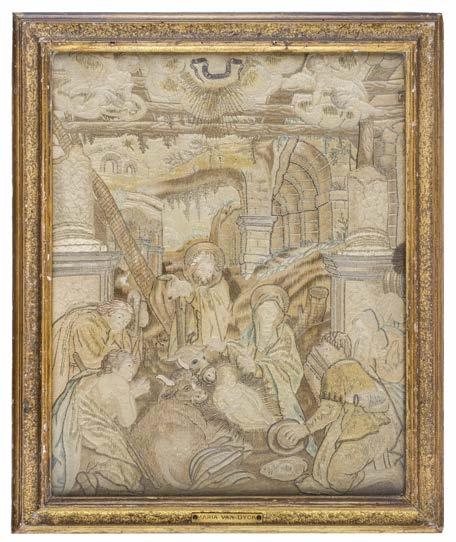
Antiquary George Scott (1720-1780), was an honorary doctor of law and a great collector of antiquities and manuscripts. He was admitted as a Fellow of the Royal Society in 1748. By the time he died, a widower with no children, he was a virtual recluse at Woolston Hall. George Scott's estate passed to his cousin Robert Bodle, whose son Robert inherited, leaving it to his daughter, Mary Elizabeth, who died unmarried in 1872. Mary's younger sister, Louisa, who had married George Watlington as his second wife, died without issue before her sister, so Woolston then passed to John Watlington Perry Watlington, the son of Thomas Perry by his wife Maria Jane, daughter of George Watlington by his first wife. J.W. Perry Watlington died childless and his estates passed to his sister Louisa Watlington (d.1892), who inherited both Woolston Hall and Moor Hall. Maria Cuypers was apparently an accomplished painter of flower pictures as well as a professional embroiderer. She was known to have been extremely skilled at needlework, and her embroidered pictures were highly acclaimed. Anthony Van Dyke was her seventh child, and she died whilst giving birth to her twelfth.
(1)
£500 - £800
613* Embroidered pictures. A collection of 7 oval blackwork pictures, circa 1810-20, a collection of landscapes and riverscapes, each finely handstitched with black silk thread (2 with the addition of cream and brown thread respectively) on a cream silk ground, variously depicting anglers, rustic dwellings and other buildings, river craft, haystacks, figures and animals, etc., one captioned ‘The Happy Cottagers’ and another ‘A River Prospect’ to lower edge, all but one with some degree of loose threads and toning, largest with splits in silk ground and 2 with a few small holes, largest 21 x 26 cm (8.25 x 10.25 ins), smallest 8.5 x 11.5 cm (3.25 x 4.5 ins), all in glazed gilt moulded oval or rectangular frames (30.5 x 35.3 cm and smaller), one with glass cracked, 2 (a small pair) with framer’s engraved label of J. Sturt, and early manuscript ownership label below ‘Geo. E. Crisp Playford Hall, Suffolk’
(7) £200 - £300

615* Embroidery. A portion of early tapestry, British, circa 1700, tapestry strip formed from 2 mirror-image designs with central join, hand-worked in tent stitch, each with stylised carnation and paeony stems flanked by large volutes, in pink, cream, blue, green, yellow, and black, on a yellow ground, some threadbare patches and holes, 122 x 26.5 cm (48 x 10.5 ins), together with:

A pair of finely-embroidered borders, Chinese, 19th century, hand-worked in polychrome silk threads, with floral and various other motifs, some fading, each 98 x 9 cm (38.5 x 3.5 ins), plus another piece of Chinese embroidery, incorporating metallic threads, sometime made into a table mat, 25.5 x 51 cm (10 x 20 ins), and a quantity of other items, mostly ladies’ accessories, including a fringed silverwork ivory silk mat incorporating spangles, several large embroidered flowers for appliqué, a number of folding fans (all defective), some beaded and woven borders, 2 sequinned belts and 1 of jet, several bags, including a 1920s embroidered Egyptianstyle evening bag, some early 20th century hosiery, and a folding cream silk parasol (worn), various sizes and condition
Provenance: Collection of Romy Rey. (a carton) £200 - £300
614 Embroidery pattern book. Dessins pour coins de mouchoirs, pour manchettes, et pour cols [manuscript cover title], [France or Belgium], circa 1860, a manuscript album in 3 parts of 50, 66 and 24 numbered thin paper leaves, comprising a total of 243 designs on rectos and versos of 140 leaves, leaves not numbered consecutively and some inverted but overall complete, each design being shown both in black India ink and in coloured inks of up to 12 colours, some occasional minor spotting, creasing and marginal fraying, title repaired at margins and with following leaf of designs partly adhered at inner margins, 4 numbered leaves with closed tears (65, 1, 11 & 7), original paper wrappers with ink title in block capitals to upper cover, browned, torn and repaired with modern paper backstrip, folio (31 x 21 cm)

(1)
£300 - £400
616* Fabric. A bolt of pale gold ‘Lullingstone’ silk damask, by Gainsborough, circa 1930s, substantial roll of silk/cotton fabric, with large repeated pattern of floral vases, swags, ribbons, and volutes, width 129 cm (51 ins), length 60 metres (66 yards)

A large, unused, quantity of top-quality silk damask woven by renowned silk-weaving company Gainsborough. Established in 1903, the manufacturer was awarded the Royal Warrant in 1980, and is still operating today. Synonymous with luxury, Gainsborough has produced fabrics for royal palaces, state buildings, grand residences, the Parisian catwalk, and even for the walls of the first class dining room on The Titanic. The famous Goring Hotel, London, commissioned the company to reproduce ‘Lullingstone’ on its 1930s looms for the drawing room in its Royal Suite where Kate Middleton, now the Princess of Wales, famously spent the night before her wedding to Prince William.
(1) £500 - £800
Lot 615
617* Fabric. A collection of fabric pieces, 17th century and later, including: an early 17th century Spanish ‘collarin’ or priest’s liturgical collar, with gold velvet appliquéd pattern of arabesques, outlined in gold metallic thread and with stems worked in red thread, on a green velvet ground, fixing loop to each side, worn with losses, backed with linen, backing annotated in ink in an early 19th century hand ‘de Cordova año de 1622’ and in a later hand above ‘Victoria’, and further annotated in a late 19th century hand ‘Parroquia de Palma año de 1889’, 20.5 x 63 cm (8 x 24.75 ins); a large cushion cover of red voided velvet on a gold satin ground, one side depicting a floral urn flanked by mythical beasts and putti, and the other depicting Cupid with sculptural face above, surrounded by foliate volutes and acorns, stitched by hand to 3 sides, lower edge open, some wear and a number of darns, 12 x 23.5 cm patch to centre of lower edge on Cupid side, 59 x 57.5 cm (23.25 x 22.5 ins); a pieced portion of metallised brocade, with large pattern of flowers and pears in shades of yellow, green, and pink on a gold ground interwoven with silver thread, with central vertical machine-stitched join, gold metallic trim to edges, faded and some minor fraying, 73.5 x 41 cm (29 x 16.25 ins); a piece of bizarre silk, patterned in blue and gold on a red ground, worn and with numerous repairs, loosely backed with early red and gold damask (held by repair stitches), 146 x 53 cm (57.5 x 21 ins); and an appliquéd runner in red and gold with metalwork outlines, possibly Portuguese, worn, 20.5 x 121 cm (8 x 47.5 ins)
The current church of Santa Victoria in Córdoba [or Cordova], Andalusia, Spain, wasn’t built until the end of the 18th century, and therefore it is likely that the contents of an earlier church on the site were dispersed at some time, perhaps explaining the subsequent appearance of the collar in Palma, Mallorca, Spain.
(7) £200 - £400
618* Fabric. A collection of unused sample pieces of French voided velvet, early 20th century, 10 lengths of voided velvet, comprising: a long length of Prussian blue cut velvet on a gold ground, with large design of arabesques and fleurons, small stain to right-hand side (6 cm in from edge), 181 cm (71.25 ins); a square panel of blue strie cut velvet on a pink and gold ground, with allover design of fleurons within a lattice, 62 x 62 cm (24.5 x 24.5 ins); 2 panels of Prussian blue strie cut and uncut velvet on a gold ground (the ground of each slightly different), with pattern of flower urns within a frame of volutes, largest piece with 4.5 x 22 cm notch cut from lower right corner, smallest piece with 6 x 10 cm notch cut from top right corner, 96 x 58 cm (37.5 x 22.75 ins) and 80 x 57.5 cm (31.5 x 22.5 ins); a panel of dark blue strie cut velvet on a pale blue ground, with stylised palmette and boteh design, 21 x 6 cm notch cut from lower left corner, 76 x 62 cm (30 x 24.5 ins); another of similar design, blue strie cut velvet on a gold ground, 52.5 x 61.5 cm (20.75 x 24.25 ins); 2 matching panels of Prussian blue strie cut velvet on a pale blue and gold ground, with a large pattern of interlocking palmettes, largest length with 8 x 4.5 cm piece cut from centre of bottom edge, 101.5 x 65.5 cm (40 x 25.75 ins) and 69 x 65 cm (27.25 x 25.5 ins); a panel of red and blue cut velvet on a gold satin ground, with all-over floral pattern, 77.5 x 66 cm (30.5 x 26 ins); and a panel of pale turquoise strie cut velvet on a shot gold ground, with vertical flower and leaf pattern, a few small faint marks to lower left corner and near top left corner, 85 x 58 cm (33.5 x 22.75 ins), all with sevedges to left and right-hand sides, top and bottom edges variously selve, raw, or stitched, each with manufacturer’s contemporary manuscript label attached to edge, some with ink stamped number to selvedge

Provenance: The Gainsborough Silk Weaving Company archive; ‘Costume and Textiles’, 15th March 2005, Christie’s South Kensington, lot 236. A collection of vibrant velvet sample pieces, unused and therefore in excellent condition, manufactured in the style of 16th century Italian velvets.
(10) £1,500 - £2,000

619* Fabric. A fragment of fine silk, probably Central Asian, circa 1500, fine gold silk, printed with roundels containing opposing mythical beats, possibly lions or griffins, dimensions at widest points 17 x 42 cm (6.75 x 16.5 ins), expertly stitch-mounted in a glazed clip frame (30 x 55.7 cm)

Previously offered in the following sale: ‘Indian and Islamic Art and Textiles’, 29th April, 2005, Christies South Kensington, lot 110.
A rare survival of an early textile; this piece has been carbon dated to just after 1500. Although applying colour to textiles dates back nearly 2,000 years, little is known about the printing process or the makers of printed textiles at this period. The pattern of the piece offered possibly emulates that found on a more complex - and therefore more expensive - woven silk, of the kind produced in Central Asia. As such it may have been intended as a lining fabric, or for the lower end of the market, a probability also bourne out by the slightly haphazard placing of the block prints, making its survival all the more unusual.
(1) £2,500 - £3,500 Lot
620* Fabric. A large piece of floral chintz, French, circa 1870, cotton chintz unstructured curtain panel, with all-over pattern of large flower sprays on leafy stems with curling tendrils, in shades of pink, peach, blue, and olive green, on a cream ground, central vertical seam, top edge raw, left-hand edge with narrow hem unpicked, tufted braid hand-stitched to right-hand edge (with some losses), and lower edge with wide machine-stitched hem, some faint spotting, mostly to lower portion, a few small stains, several small holes (4 x 4 mm and smaller), 388 x 163 cm (153 x 64 ins)

(1) £400 - £600
621* Fabric. A large piece of raspberry silk damask, probably Italian, late 18th/early 19th century, large length of raspberry damask, probably Jacquard-woven, with large pattern of stylised flowers and fronds, incorporating latticework, berries, and seedheads, selvedges to each side, some light spotting to part of final 17 cm of lower short end, but apparently unused, with green twisted cord loop on the right selvedge possibly once attaching manufacturer’s tag or seal, width 61 cm (24 ins), length 504 cm (198.5 ins)

A beautiful early furnishing silk, in excellent, unused condition.
(1) £400 - £600
623* Fabric. A long roll of brocatelle, 18th century, jacquardwoven linen and silk scarlet brocatelle, with a large pattern of stylised flower urns, fleurons, fruit, drawer handles, etc., top backed with 19.5 cm piece of hessian (hand-stitched), lettered in large ink manuscript ‘C.M’, and with thick twisted cord along edge stitched at intervals to form hanging loops, bottom edge backed with a 13 cm piece of the same, with 3 stout buttonhole stitch loops (one to centre, and one to each corner), left and right-hand edges with hand-stitched rolled hem, some light marks and scattered tiny holes (several stitched repairs), 12.5 x 8 cm notch cut out of righthand side near top edge, 689.5 x 76.5 cm (271.5 x 30 ins)

(1) £700 - £1,000
622* Fabric. A length of unused block-printed calico, French, early 20th century, with arborescent design of an exotic bird perching on a sinuous woody branch entwined with the stems of large flower blooms, including paeonies, irises, and tulips, with butterflies, printed in pink, purple, blue, green, and brown, on a cream ground, possibly a sample piece with manufacturer’s ink stamped number ‘9749’ to left and right-hand selvedges, top and bottom edges raw, some faint blue curling line marks, 126 x 77.5 cm (49.5 x 30.5 ins), together with:

A chintz curtain, French, 19th century, single curtain with double frill to leading edge, with a bold vegetal pattern of large-stamened exotic flowers, ferns, open seed pods, etc., printed in red, brown, black, and green, on a blue ground, faded, top edge with double tucks and 4 brass rings, right-hand selvedge unstitched, and lower edge raw, width of gathered top 58 cm (22.75 ins), width of lower edge 89 cm (35 ins), drop 175 cm (69 ins), and a hand-stitched 19th century pieced chintz panel, French, with large floral pattern printed in raspberry, blue, and dark brown, on a cream ground, hanging tabs to top edge, lower edge raw, worn, with scattered holes and darns, patched with old handkerchiefs on verso, 121.5 x 64 cm (47.75 x 25.25 ins)
(3) £150 - £250
624* Fabric. A panel of silk lampas persienne, French, 1720s, pieced panel of silk lampas persienne, with a design ‘à la dentelle’ incorporating stylised floral and foliate motifs, woven in cream, green, silver, and bronze, on a gold ground, rubbed in places with some surface losses, gold metallic braid to edges, backed with pieced hessian, latter with 6 large brass rings sewn to top edge, 99 x 84 cm (39 x 33 ins)

Lampas is a precious figured silk fabric with a refined and complex weaving technique which produces a rich and colourful result. Lampas persienne, or ‘décor à dentelle’ with its patterns echoing the forms of lacework, was particularly popular in the late 17th and early 18th century.
(1) £300 - £400
Lot 623
625* Fabric. A piece of cotton chintz, English, 1920s/30s, midweight cotton chintz, with design of exotic pheasants, green woodpeckers, and other colourful birds, perched on the woody branches of larch trees, amongst paeonies and almond blossom, in vivid polychrome on a slate blue ground, slevedge to left-hand side, remainder raw, 5.5 x 11 cm notch out of upper right corner, 179 x 127.5 cm (70.5 x 50.25 ins)

A wonderfully vibrant piece of fabric, apparently unused.
(1)
627* Fabric. A roll of unused French chintz, 19th century, glazed cotton chintz, with pattern of wide stripes of roses, morning glory, and ivy, in pink, blue, yellow, orange, and green, on a pale brown ground of stylised leaf stems, alternating with narrower stripes of red-veined white 3-lobed leaves on a ground of semé brown dots, between narrow stripes of morning glory stems on a red-brown ground, selvedges to left and right, top and bottom edge raw, 421 x 59.5 cm (165.75 x 23.5 ins), together with:
A length of chintz, 19th century, glazed cotton chintz, with pattern of flower posies in pink, blue, green, and yellow, on a cream and pale blue striped ground, selvedges to left and right/raw edges to top and bottom all with remains of original stitching, toned, occasional fox spots, and a few tiny edge holes, 343 x 81 cm (135 x 32 ins)


(2) £200 - £400
£200 - £400
626* Fabric. A printed cotton length, probably French, early 20th century, with large pattern of flower sprays incorporating a peacock and pan pipes, with floral sprays above and below flanked by a tamborine on the left and a pair of pipes on the right, both entwined with flower and leaf stems, in shades of pink, blue, purple, green, mustard, and brown on a cream ground, some offsetting of the pink, selvedges to left and right, top and bottom edges raw, 259 x 76 cm (102 x 30 ins)
(1)
£150 - £200
628* Fabric. Two matching pieces of voided velvet, French, 19th century, 2 panels of deep pink cut and uncut velvet on a pink satin ground, with large design of floral urns within an architectural volute frame incorporating lions’ heads and seated putti, selvedges to left and right-hand sides (folded over and with remains of stitching, fraying in places), top and bottom edges raw, scattered small marks, ground beginning to perish in places (one panel with 8.5 cm closed tear), approximately 127 x 52 cm (50 x 20.5 ins)
(2) £300 - £500

629* Handkerchief map. Fairburn’s Travelling Handkerchief. A Map of England and Wales, exhibiting the Roads, Cities, Towns and Principal Villages, with their Bearing by Compass and Distance from London, Engraved by E. Bourne, Andersons Buildings, City Road, Published by the Proprietor John Fairburn, 1831, map of England and Wales printed in black and white on calico, with title vignette to upper right corner, and References to the Counties and Explanation of the Map upper left, toned and some light damp-staining, 57 x 47.5 cm (22.5 x 18.75 ins), framed and glazed (59.2 x 49.8 cm)

Rare. The attractive vignette was designed and engraved by W. Grainger, and a note below reads: “This design represents a merchant giving an unprovided boy a ticket to admit him on board one of his ships, the sailor waiting to conduct him. The other emblems are Strength, Navigation, Commerce, Manufacture, Trade, Fertility and Industry.”
(1)
630* Handkerchief. A printed handkerchief depicting HMS Duke of Wellington, circa 1854, cream cotton printed in brown, depicting HMS Duke of Wellington running under steam and sail, surrounded by other ships and rowing boats, with table below comparing the date, size, and capability of the Duke of Wellington with HMS Victory and HMS Caledonia, within a floral and foliate border, selvedge to left-hand side, remainder hemmed by hand, toned and a few fox spots, 15 x 5 mm hole, 27 x 31 cm (10.5 x 12.25 ins), mounted, doublesided glazed frame (35 x 39.5 cm), the verso with corner-mounted engraved diagram showing the longitudinal and cross sections of the HMS Duke of Wellington published by Blackie & Son, Glasgow, toned and some fox spots, 2 vertical folds, sheet size 25 x 35.5 cm (9.75 x 14 ins)
A rare handkerchief commemorating Sir Charles Napier’s flagship, HMS Duke of Wellington, launched in 1852; we have been unable to trace another example either sold at auction or in an institution.
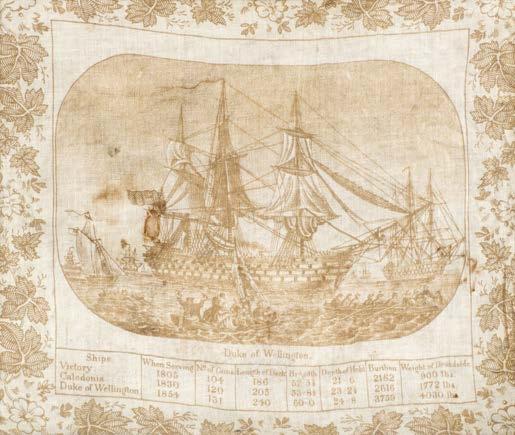
(1) £150 - £200
Lot 630
£200 - £400
631* Handkerchief. The Battle of Waterloo, circa 1815, fine white cotton printed in red, with a plan of the battle in the centre, flanked by an ‘Explanation of the Plan’ (with a vignette ‘Observatory of the Prince of Orange’) and an ‘Explanation of the Battle of Waterloo’ (with a vignette ‘The Observatory of Buonaparte’), a large battle scene above, with charging cavalry, and amassed foot soldiers, and a large scene below ‘Village and Church of Waterloo’ and ‘Taking of Buonaparte’s Carriage’, within a helix border, that to top and bottom edges partly incorporated into hand-stitched hem, initials ‘S M’ hand-worked in cross-stitch in cream thread to top right corner, toned and lightly soiled, but fabric robust and colours still bright, approximately 56 x 63 cm (22 x 24.75 ins), mounted, framed and glazed (69.5 x 76 cm)

A rare early printed handkerchief in unusually good condition, commemorating the Battle of Waterloo. The V&A has an identical handkerchief (accession number 1811-1899), and the National Army Museum has one printed in brown (NAM. 1965-07-6-1).
(1) £500 - £800
632 India. A velvet pheran, Kashmir, early 20th century, black velvet unstructured long robe, with elaborate couched embroidery to v-neck, shoulders, cuffs of wide sleeves, and front patch pocket, worked in red and green cotton thread and green, silver, and gold metallic thread, fully lined, 20 cm split in seam at front crudely stitch-repaired, shoulders 39.5 cm (15.5 ins), sleeves 53.5 cm (21 ins), length 132 cm (52 ins), together with an assortment of other world textiles, comprising robes, tunics, and skirts, mostly in good condition, various sizes

Provenance: Collection of Romy Rey.
(1) £100 - £200
633* Lace. An 18th century lace stomacher, dark cream stomacher of Maltese bobbin lace, 1 hole (5 x 1 cm) and a few other small breaks, 31 x 17 cm (12.25 x 6.75 ins), together with a large quantity of other lace items and edgings in a variety of techniques, mostly white or cream, many pieces handmade, including lengths and trimmings, tablecloths and mats (some with drawn threadwork and embroidery), shawls, collars, parts of sleeves and cuffs, etc., various sizes and condition

Provenance: Collection of Romy Rey. (2 cartons) £300 - £500
634* Mughal. A large hand-painted panel of an elephant and figures, early 20th century, watercolour and gouache, highlighted with gold and bodycolour, on fine cream cotton, depicting 3 armed figures riding atop an elephant, surrounded by further figures on foot or horseback holding various weapons, including talwars, a crossbow, spears, and staffs, 2 figures with flags, within a border of stylised flowers, some light staining and marks, a few small holes, 124 x 90.5 cm (48.75 x 35.5 ins)
(1) £100 - £200

635* Needlework. A collection of embroideries and other related items, 18th & 19th century, comprising: a small 18th century hairwork landscape, Continental, finely hand-worked in back stitch on cream silk, depicting a figure at a large well, with a windmill in the distance, and a building with steep roof to the right, laid over card with contemporary stitching to edge, toned, 8 x 12 cm (3.25 x 4.75 ins); an 18th century embroidery of a songbird perched on a leafy branch, worked in long and short stitch on cream silk backed with cotton, using silk threads (predominantly light brown, cream, and green), silk ground perishing, tack holes to edges, 18.5 x 22.5 cm (7.25 x 8.75 ins); a small polychrome beadwork picture on perforated card (toned), of a Turkish gentleman smoking a hookah, rose border to upper and lower edges, 13 x 14.5 cm (5.25 x 5.75 ins); a blackwork picture on linen-backed silk, of a castle in a rocky landscape, circa 1800, silk ground beginning to perish, 17.5 x 23 cm (7 x 9 ins); an early Victorian hand-coloured Berlin chart of a mother and child flanked by a palm tree and a pagoda, 8 x 10 cm (3.25 x 4 ins), contemporary glazed mahogany frame with hanging loop to top edge (13 x 15.5 cm); a pair of flower embroideries on paper, circa 1820, toned and foxed, sheet size 23 x 21 cm (9 x 8.25 ins), and 2 others similar, another on paper, Victorian, browned, and one on linen, circa 1800, stained; 7 Victorian tapestry pictures, various (floral, historical, children, animals, etc.), in gros or petite point, 33 x 33 cm (13 x 13 ins) and smaller; and a gros point dolls’ house rug, 12 x 8.5 cm (4.75 x 3.25 ins), mounted on card, together with a circa 1900 Art Nouveau design of stylised berries, leaves, and flowers, gouache in brown tones on cream wove paper, with ‘E.S.K.’ oval blindstamp lower left corner, sheet size 31.7 x 19.5 cm (12.5 x 7.75 ins)

The embossed stamp ‘E.S.K.’ on the final item listed indicates that the work was entered for examination at the South Kensington School of Art. (18)
£200 - £300
636* Ottoman. An early 19th century Turkish embroidered cloth, linen cloth with wide border to one long side and half of shorter sides (remaining long side raw), finely hand-worked with scrolling stems and dense floral decoration in polychrome and silver metal threads, using long and short stitch, satin stitch, and stem stitch, finished with a metallic knotted border, stained and worn, with period darns and repairs, 91 x 103 cm (35.75 x 40.5 ins), together with:

A 19th century Turkish sash, linen sash, with wide embroidered borders to short ends, hand-worked in orange, green, and yellow threads, and silver metal threads, using tent stitch and Algerian eyelets, short ends fringed, a few small rust marks to long edges (and one small related hole), 18 x 225 cm (7 x 88.5 ins) excluding fringe, plus 6 small metalwork borders related, approximately 19 x 37 cm (7.5 x 14.5 ins), and slightly smaller
(8)
£150 - £250
637* Quilt. A large patchwork quilt of small squares, circa 1850s-1870s, large quilt composed of small printed and plain cream cotton squares (approximately 1 in square), arranged in geometrical patterns, verso unlined revealing torn remains of paper piecings, toned, worn in places, with losses, handkerchief sometime stitched to centre of verso as strengthening, 305 x 307 cm (120 x 121 ins), together with another large Victorian patchwork quilt, composed of small hexagons of printed cotton (1.25 x 1.5 ins), toned, occasional minor wear, neatly backed with sprigged striped cotton in both blue and pink colourways (several large stains), hand-quilted overall in pale thread, and with butted edges, 228.5 x 241 cm (90 x 95 ins)
(2) £200 - £400

638* Quilt. A quilt of late 18th century Chinoiserie fabric, English, circa 1854, printed with a pattern of pagodas, swans, and a bridge, set amongst flowers and trees, lightly faded in part, some soiling, mostly to edges, fabric beginning to perish along 10.5 cm line of central fold towards top edge, some staining to backing fabric, paper label with inscription in biro pinned to one edge: ‘This quilt was done for Granma Hannah Spensley by her granny when she [was] 14 yrs old about 1854 she was a Raw from Low Row Swaledale’, 220 x 192 cm (86.75 x 75.5 ins)


The surname ‘Raw’ is particularly associated with the village of Low Row in the Yorkshire Dales. There are records of generations of Spensleys living in Yorkshire from at least the mid 17th century onwards.
(1) £150 - £200
639* Quilt. An early 19th century marriage quilt belonging to Mary Brown, 1827, embroidered and chintz quilt, with patterns of flower vases and other floral motifs, exotic birds, and butterflies, in shades of pink, blue, green, and purple, with large central square naively embroidered with a vase of flowers surrounded by hearts within a floral border, and a smaller square at each corner of the large square similarly embroidered with a flower vase, hearts, and floral sprig cornerpieces, worked in chain, feather, buttonhole, seed, and herringbone stitches, in shades of pink, cream, and gold, ‘Mary Brown 1827’ cross-stitched in brown thread to central square, backed with white twilled cotton, hand-quilted overall in pale thread, and with turnover hem, scattered small areas of wear, and some loss of threadwork to square panels, occasional light marks, central square with 6 x 3 cm stitched repair, 254 x 254 cm (100 x 100 ins)
(1)
£500 - £800
Lot 639
640* Quilts. A collection of Welsh quilts, early 20th century, 5 double-sided Welsh quilts, comprising: a raspberry/pink quilt, 1 or 2 faint marks; a blue/gold quilt, some marks; a pale yellow/peach quilt, occasional light marks, 1.5 x 1 cm hole in yellow side; a red/olive green quilt, a few small holes to red side (largest 2 x 2 cm), one edge worn on both sides, green side with mottled fading; and a bright yellow/grey quilt, some small marks, all hand-quilted overall with a variety of patterns, including hearts, flowers, palmettes, leaves, lattice designs, spirals, fan shapes, helix pattern, chevrons, circles, lunettes, and stars, various sizes

(5)
£200 - £400
641* Sampler. A needlework by Harriet Latchford, 1828, handworked in cross-stitch and Algerian eyelet on linen, using pink, blue, green, yellow, brown, black, and cream silk threads, on a cream linen ground, with alphabets between decorative borders, above a moral quotation entitled ‘A Rule of Life’, and wide zig-zag stylised floral borders, one incorporating various coronets, with maker’s name and date below within a star frame ‘Harriet Latchford Feby 2 1828 Aged 8 Years’, flanked by 2 pairs of tall floral urns, the whole within a floral border, selvedges to sides, handstitched hem top and bottom, faintly foxed, a few very small holes, but stitching intact and bright, tack holes to edges, 43 x 33 cm (17 x 13 ins), together with:
A needlework by Helen Robertson, circa 1800, hand-worked in cross-stitch on linen, using green, gold, pink, cream, grey, and black silk threads, with asymmetrical rows of decoration, including coronets, floral urns, birds, and a dog, name of maker at foot, toned, 32 x 25 cm (12.5 x 10 ins), and another cross-stitch linen sampler, dated 1829, toned and worn (3) £100 - £200
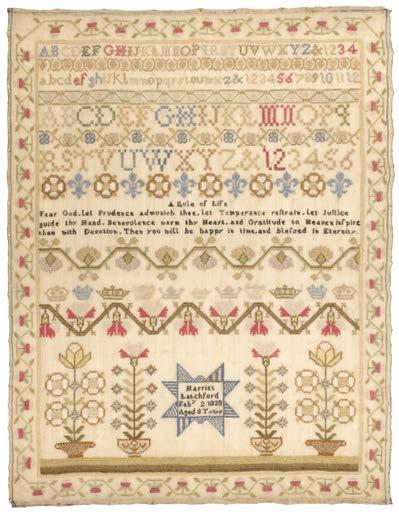
642* Sewing machine. A Prima Donna sewing machine by Whight & Mann, circa 1870s, C-frame lockstitch black sewing machine with lion’s paw casting, manufacturer’s name and foliate scroll decoration in gilt (rubbed), lacking spool pin, wooden plinth 16.5 x 29 cm (6.5 x 11.5 ins), height 30.5 cm (12 ins)
Rare early sewing machine made by manufacturers and importers Whight & Mann who were based in Ipswich, Suffolk. The Prima Donna was the firm’s small domestic machine, manufactured during the 1870s and priced at four guineas.

An advertisement of the time proclaimed: “The Prima Donna lock-stitch hand sewing machine will do all the work required of a family in the most superior of style. It is extremely simple and so easy to learn that even the servant will become familiar with the briefest of instruction. Unequalled for Beauty and Simplicity of Construction. It will sew any material, from the finest muslin to heavy leather.”
(1) £150 - £200
Lot 642
643* Shawl. A Kashmir moon shawl, circa 1820, finely woven wool shawl, large central chevron-edged circle densely filled with small flower and leaf motifs, the main ground with small botehs within a lattice frame, large moon quadrants to corners repeating central design, scrolling palmette and leaf spray border (two different colourways), in shades of red, green, and blue, on a red ground, some wear, especially to edges, including loss to one corner, recently hand-stitched to a red cotton backing, with some holes and tears carefully consolidated, 160 x 146cm
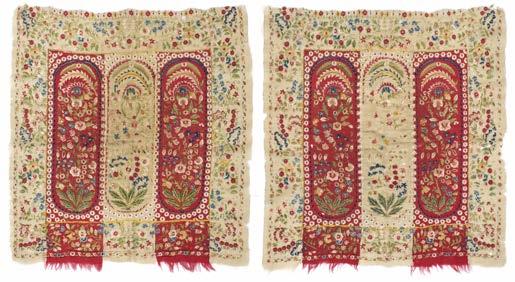
(1) £400 - £600

644* Shawl. Two ends of a Delhi shawl, India, circa 1850s, 2 matching wool shawl fragments of wide cream and red stripes, densely handembroidered with polychrome flower and foliate motifs within 3 panels enclosed by a wide border, one side fringed, scattered small holes and some loss of threadwork, each approximately 56 x 53 cm (22 x 21 ins), together with a quantity of other textiles, mostly shawls and stoles, some hand-embroidered, but including 2 handembroidered Indian neck yokes with mirror work, and a pale blue sari with silver embroidery, various sizes and condition
Provenance: Collection of Romy Rey.
(20)
£100 - £200
646* Spitalfields. A bodice and deconstructed skirt of silk damask, probably Spitalfields, circa 1745-50, boned and fitted bodice of blue silk damask with large pattern of flowers and leaves, of later construction, stitched by hand and machine, probably intended for fancy dress, with elbow length sleeves trimmed with wide lace flounces, matching lace to neck and front, v-shape to waist front and back, and eyelets with lacing to back, sleeves coming unstitched slightly in a couple of places, bust 64 cm (25 ins), waist 48 cm (19 ins), sleeves 40.5 cm (16 ins), length 45 cm (17.75 ins), matching skirt with ungathered waist and hand-stitched hem, some light discolouration to bodice and skirt in places, width between pink-striped selvedges 56 cm (22 ins), length 98 cm (38.5 ins), entire width of hem (i.e. if side seam was unstitched) 188 cm (74 ins)

See the V&A for a green banyan woven in a similar silk damask featuring a large pattern of leaves and flowers “woven in the style of Anna Maria Garthwaite” (accession number T.92-2003).

(2) £700 - £1,000
645* Shawls. A Kashmir stole, early 19th century, rectangular fine cream wool shawl, woven in red, green, and yellow, with a band of boteh to each end (7 complete botehs and one incomplete), the whole edged with floral and foliate narrow border, short ends fringed, a few small brown marks, 75 cm (29.5 ins) x 236 cm (93 ins), together with:

A woven Norwich shawl, mid-late 19th century, square cream shawl, woven in red, blue, yellow, green, and black, with all-over pattern of scrolling stems, palmettes, and botehs, longer sides with polychrome fringe, some minor marks, dimensions not including fringe 176 cm (69.25 ins) x 183 cm (72 ins), plus 2 others, a cream shawl with woven polychrome bands, 2 edges fringed, one very small threadbare area, and a couple of faint marks, 171 cm (67.25 cm) x 173 cm (68 cm), and a light brown turn-over shawl with polychrome border of botehs and palmettes, fringed all round, a couple of tiny holes, 5” split along edge of one corner, 148 cm (58.25 ins) x 152 cm (60 ins), and 24 large and small borders and fragments from 19th century embroidered and woven shawls, mostly in good condition, and some very fine, 1 or 2 maker’s marks, various sizes (27) £400 - £600
647* Spitalfields. A pair of silk brocaded damask panels, 1750-55, 2 matching lengths of figured cream silk, woven with a large pattern of flower sprays, in blue, gold, green, cream, brown, and black, on a cream brocade ground of flower and leaf tendrils, selvedges to sides folded over and with tack holes resulting in some minor staining and 1 or 2 short tears (1 or 2 tacks remaining), top and bottom edges raw, one piece with 3 water-stains (one enclosing a turquoise mark), but fabric robust and colours bright, width 53 cm (21 ins), length 97 cm (38.25 ins)

(2) £300 - £400
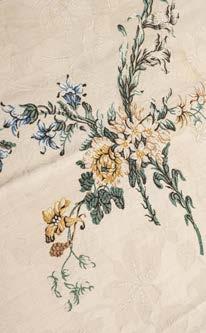
648* Tapestry. Three chair seat covers, Victorian, comprising a pair of tapestry panels, worked in polychrome wools in gros point, with a pair of colourful swallows within a frame of flowers and grapes entwined with a red ribbon tied in a bow at the top, one panel cut dowm, approximately 75 x 56 cm (29.5 x 22 ins) and 63 x 61 cm (24.75 x 24 ins), and a smaller tapestry panel similar, depicting roses, morning glory, and pansies, 48 x 49.5 cm (18.75 x 19.5 ins), all 3 threadbare in places, but colours bright (3) £100 - £200
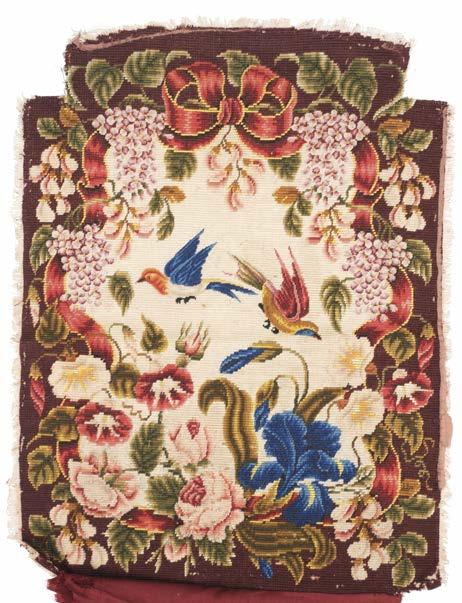
649* Val St Cyr (b. Arthur Andrews Hilder, 1890-1967). A small archive of original drawings and ephemera belonging to art student and designer Edna Timson, 1920s-1930s, including: a full-length pen & ink design, with blue watercolour, on artist’s board, of a woman wearing a cocktail dress and hat, and carrying a fur-lined wrap, signed by Val St Cyr to right-hand side, toned, chipped to top edge, sheet size 45.5 x 29.8 cm (18 x 11.75 ins); a large pen & ink design, with green watercolour, on artist’s board, of a lady in a crinoline and wig beside a tree, calligraphic signature of Val St Cyr lower left, image size 40.5 x 30 cm (16 x 12 ins), and a copy of the 1931 calender for which it was drawn (toned and marked, with slight wear to extremities); 2 monochrome watercolours on artist’s board, half-length designs, each of a woman wearing a dress and hat, lightly toned and marked in places, sheet size 29.8 x 23.3 cm (11.75 x 9.25 ins); a pen & ink fashion design and a pen, ink, and watercolour Christmas card by Edna Timson, both signed; a sketchbook belonging to Edna Timson, containing 58 pencilled fashion designs on rectos and versos of 29 leaves, some with annotations; 20 signed letters on headed paper, mostly typed, to Edna Timson from Val St Cyr, the paper headed variously ‘53, New Cavendish Street, Portland Place, W.1.’, ‘Baroque, Ltd., 97, New Bond Street, London. W.1.’ and ‘7, Nottingham Place, W.1.’; 32 headed correspondence cards, written in ink, from Val St Cyr to Edna Timson; and a scrapbook of newspaper cuttings, mostly 1930s fashion designs by Edna Timson

Innovative fashion designer Val St Cyr was a major force on the London stage of fashion design during the first half of the 20th century. He developed an interest in drawing and, in particular, fashion design, from an early age, knowing by the age of 15 what his chosen career would be. To that end he went to Paris in order to study cutting and draping, and it was not long before St Cyr was designing for such well-known names as Madame Elizabeth Handley-Seymour, one of the major society dressmakers in London, and as well as for film and theatre productions. In 1921 Val St Cyr set up his own business with a friend, Ernest Pacey Sands, calling it the House of Baroque. In a Baroque promotional brochure, the designer was declared to be “at once original, daring and artistic”, a claim which was certainly borne out by his work. St Cyr emphasised individuality, and stated that a woman’s clothes should reflect her personality, rather than conform to the standard modes of the age, and he often took known forms and motifs and re-interpreted them in his own idiosyncratic way. The company eventually employed around 100 people, and their work was shown at various exhibitions. At the height of his success St Cyr was hailed by ‘The People’ newspaper as “the most successful English dress designer now living”. The V&A has around 40 designs by Val St Cyr from his early days with Mrs Handley-Seymour, dated 1916-1918.
This archive sheds a fascinating light on Val St Cyr’s work as a tutor of art and design, as well as giving a sense of the person he was.
(a folder) £200 - £400
650* Weaving. A collection of 7 volumes belonging to Karl Müller, Webschule Crimmitschau, 1935, comprising: a volume of mounted samples (i.e. cotton in cellophane bags mounted 6 to a page, and stitch-mounted thread bundles in different colours, typically 9 or 10 to a page), with neat annotations in ink, original cloth, blindstamped ‘Materialienlehre’ to upper cover, 4to; 2 small folio books of printed and manuscript notes, hand-coloured charts, and mounted threads/cloth samples/diagrams, original cloth, one with manuscript label to upper cover ‘Musterzerlegen’; 2 books of handcoloured charts, original card covers, titled ‘Bindūngslehre’ to labels on front covers, small folio and large 4to; and 2 small folio books of manuscript notes, original card covers, titled ‘Spinnereikünde’ and ‘Maschinenkünde ünd Fachrechuen’ to labels on front covers

Karl Müller was a student of the Crimmitschau weaving school, Germany.
(7) £100 - £150 Lot
651* Wedding dress. A 1940s wedding gown, handmade cream rayon dress, with fitted bodice and round neck, narrow sleeves terminating in pointed lace cuffs with press stud fasteners (some small breaks in lace), 11 self buttons with corresponding loops to back of bodice, inner sleeveless bodice with zip closure to rear, close-gathered long skirt (short section unstitched at waist) with long frill-trimmed train, several small brown spots to bodice, some other marks to skirt and train, and small hole towards lower edge of skirt at front, bust 72 cm (28 ins), waist 51 cm (20 ins), sleeves to point 61 cm (24 ins), length 145 cm (57 ins), length including train 293 cm (115 ins)
(1) £100 - £200
652* Wedding dress. A two-piece 1940s wedding dress, strapless ivory satin wedding dress with all over pattern of lily of the valley flowers, with ruched bodice boned at sides, and full-length biascut skirt, bust 82 cm (32 ins), waist 64 cm (25 ins), length 131 cm (51.5 ins), with matching bolero, with upturned cap sleeves, and mandarin collar, with 2 decorative self buttons and hook and loop fastening, length 40 cm (15.75 ins), together with a 1960s Louis Feraud at Rembrandt two-piece, comprising a cream and grey wool sleeveless dress, with high neck, zip fastening at rear, cord trim to skirt, and cream lining, stated size 12, bust 82 cm (32 ins), waist 68 cm (26.5 ins), length 90 cm (35.5 ins), with matching grey wool coat, with round neck, long sleeves, zip fastener to front, and cord trim to edges, bust 92 cm (36 ins), waist 74 cm (29 ins), sleeves 54 cm (21.25 ins), length 92 cm (36.25 ins), and a 1940s grey sheepskin coat, with shawl collar, long sleeves with wide upturned cuffs, slit pockets, coiled metal hook and loop fasteners, and lilac lining (with small hole), large hole under left sleeve, bust 94 cm (37 ins), sleeves 61 cm (24 ins), length 100 cm (39.5 ins)
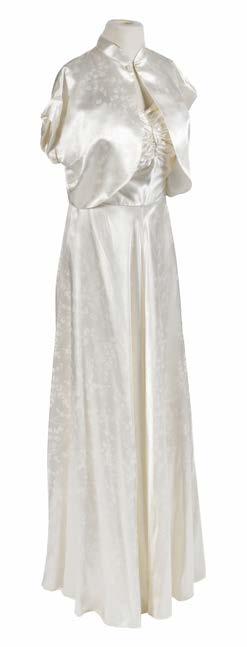
(5) £100 - £200

653* Worth (House of). A 1930s cocktail dress, dark blue silk georgette(?) dress, with square neckline to front and v-shape to back, pleated bodice with knot detail, ruched short sleeves, and 3/4 length skirt, metal zip closure to back, fully lined, woven label ‘Boutique Worth Paris’, a few small marks, but overall in good condition, bust 76 cm (30 ins), waist 60 cm (23.5 ins), sleeves 18 cm (7 ins), length 108 cm (42.5 ins), together with 10 other early-mid 20th century garments, including: a moss green satin cocktail dress with strapless ruched crepe bodice, with Harrods label (size 34); a 1950s 3/4 length moss green taffeta dress with cap sleeves (latter a little worn at edges), and large ruched border to skirt terminating in an over-sized bow to rear; a puce pink satin cocktail dress with straps, with woven label ‘Suzy Perette New York’; a pale grey silk 3/4 length coat, with peach lining, 3/4 length sleeves with upturned cuffs, and large pocket flaps with Turk’s head buttons; a fitted sleeveless brown cocktail dress with gored skirt, woven label to waist ‘Jacques Heim Paris Cannes Biarritz’, various sizes and condition (mostly in good condition), plus 9 20th century hats, including 2 with Bergdorf Goodman label, and 2 Harrow school caps, one with ‘W.A. Stimson Ltd’ label (22)
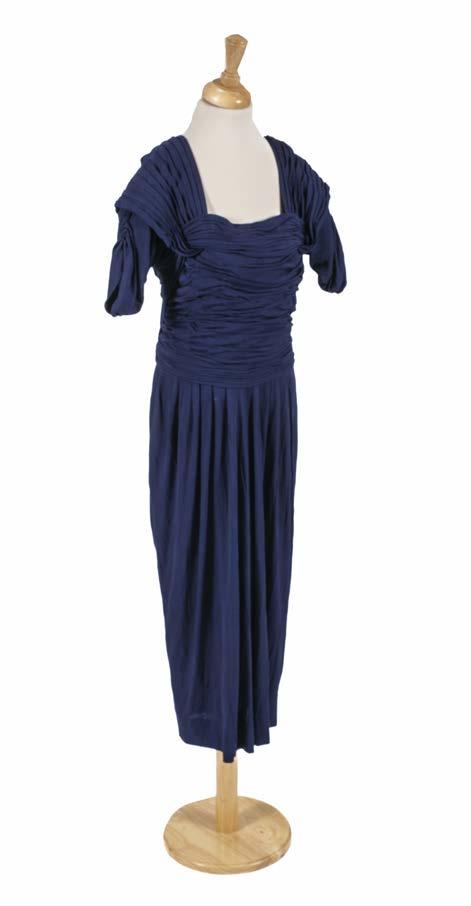
654 Mirror. A large painted and gilt trumeau overmantle, English, circa 1790-1810, mirror, 87 x 111 cm (34.25 x 43.5 ins), surmounted by a large rectangular oil on canvas panel, depicting a grisaille dancing female figure with tamborine, within a beaded pointed oval frame, flanked by a nude bacchante on either side, the body of each terminating in a large volute of vine leaves, tendrils, and grapes, faint craquelure, some minor spotting and tiny chips, 53 x 112 cm (21 x 44 ins), gilt moulded beaded frame, topped by a ribbon with tasselled bow (strengthened behind with wooden baton, loss to top of bow), the painting and mirror separated by a gilt carved frieze with Bacchus's head in the centre, flanked by floral volutes, lower edge of frame with frieze of laurel branches, some light rubbing to frame, cream baton strips sometime attached to sides, brass mirror plates for hanging on verso, 175 x 122 cm (69 x 48 ins) A beautiful and impressive overmantle mirror, the subject matter suggesting that it might originally have been commissioned to hang in a dining room.

(1) £800 - £1,200
£200 - £300


15 JUNE 2023
For further information or to consign, please contact Paul Rasti, Susanna Winters or Rachael Richardson: info@dominicwinter.co.uk 01285 860006
Jane Austen. Pride and Prejudice: A Novel, 3 volumes, 2nd edition, London: T. Egerton, 1813, modern antique-style blue half morocco gilt, 12mo Estimate £8,000-12,000 (15 June 2023)Online Results: If you weren’t present or able to follow the auction live, you can find results for the sale on our website shortly after the sale has ended.
Payment: The price you pay is the amount at which the auctioneer’s hammer falls (the hammer price), plus a buyer’s premium (a percentage of the final hammer price) and vat where applicable. You will be issued with an invoice made out to the name and address provided on your registration form.
Please note successful bids made via live bidding cannot be invoiced or paid for until the day after an auction. A live bidding fee of 3% + VAT (Dominic Winter / Invaluable) or 4.95% + VAT (the-saleroom) will be added to your invoice.
Cheque: Cheques will only be accepted on the day of the sale by prior arrangement (please contact our office for further information). Cheques by post will be accepted but a period of 5 working days will be required for the cheque to clear before purchases can be collected or posted.
Cash: Payments can be made at the Cashier’s Office, either during or after the sale.
Debit Card: There is no additional charge for purchases made with debit cards in the UK.
Credit Cards: We accept Visa and Mastercard. It is advisable to let your card provider know in advance if you are intending to purchase. This reduces the time needed to obtain authorisation when the payment is made.
Bank Transfer: All transfers must state the relevant invoice number. If transferring from a foreign currency, the amount we receive must be the total due after the currency conversion and the deduction of any bank charges.
Note to Overseas Clients: All payments must be made by bank transfer only. No card payments will be accepted unless by special prior arrangements with the auctioneers.
Collection/Postage/Delivery: If you attend the auction in person and are successful in your bid, you are free to collect your item once payment has been made.
Successful commission or live bids will be invoiced to you the day after the sale. When it is possible for our in-house packing department to send your purchase(s), a charge for postage/packing/insurance will be included in your invoice. Where it is not possible for our in-house packing department to send your item you will be required to make your own arrangements or to contact Mailboxes etc (tel: 01793 525009) or Pack and Send (tel: 01635 887237) who may be able to help.
We provide a monthly delivery service to Central London, usually on Wednesday of the week following an auction. Payment must be received before this option can be requested. A charge will be added to your invoice for this service.
Lots marked with AR next to the lot number may be subject to Droit de Suite.
Droit de Suite is payable on the hammer price of any artwork sold in the lifetime of the artist, or within 70 years of the artist's death. The buyer agrees to pay Dominic Winter Auctioneers Ltd. an amount equal to the resale royalty and we will pay such amount to the artist's collecting agent. Resale royalty applies where the Hammer price is 1,000 Euros or more and the amount cannot be more than 12,500 Euros per lot.
The amount is calculated as follows:
Royalty For the Portion of the Hammer Price (in Euros)
4.00% up to 50,000
3.00% between 50,000.01 and 200,000
1.00% between 200,000.01 and 350,000
0.50% between 350,000.01 and 500,000
Invoices will, as usual, be issued in Pounds Sterling. For the purposes of calculating the resale royalty the Pounds Sterling/Euro rate of exchange will be the European Central Bank reference rate on the day of the sale.
Please refer to the DACS website www.dacs.org.uk and the Artists’ Collecting Society website www.artistscollectingsociety.org for further details.
Each lot is subject to a Buyer’s Premium of 20% (Lots marked * 24% inclusive of VAT @ 20%)
Libraries & Archives
Nathan Winter & Chris Albury
Paintings & Prints
Nathan Winter
Antiques & Furniture
Henry Meadows
Medals & Militaria
Henry Meadows
Aviation & Transport Collections
Chris Albury & Henry Meadows
Atlases, Maps & Prints
John Trevers
Antiquarian Books
Colin Meays
Modern First Editions
Paul Rasti
Children's Books, Toys & Games
Susanna Winters
Sports Books & Memorabilia
Paul Rasti
Taxidermy, Fossils & Field Sports
John Trevers
Vintage Photography & Cinema
Chris Albury
Manuscripts, Autographs & Ephemera

Chris Albury
For free valuations without obligation, please contact any of the above specialists for further advice.
Mallard House, Broadway Lane, South Cerney, Cirencester, Gloucestershire, GL7 5UQ 01285 860006 / firstname or info@dominicwinter.co.uk
www.dominicwinter.co.uk
1. The Seller warrants to the Auctioneer and the buyer that he is the true owner or is properly authorised to sell the property by the true owner and is able to transfer good and marketable title to the property free from any third party claims.
2. (a) The highest bidder to be the buyer. If during the auction the Auctioneer considers that a dispute has arisen he has absolute authority to settle it or re-offer the lot. The Auctioneer may at his sole discretion determine the advance of bidding or refuse a bid, divide any lot, combine any two or more lots or withdraw any lot without prior notice.
(b) Where goods are bought at auction by a buyer who has entered into an agreement with another or others that the other or others (or some of them) shall abstain from bidding for the goods and the buyer or other party or one of the other parties is a dealer (as defined in the Auction Biddings Agreement Act 1927) the buyer warrants that the goods are bought bona fide on joint account.
3. The buyer shall pay the price at which a lot is knocked down by the Auctioneer to the buyer (“the hammer price”) together with a premium of 20% of the hammer price. Where the lot is marked by an asterisk the premium will be subject to VAT at 20% which under the Auctioneer’s Margin Scheme will form part of the buyer’s premium on our invoice and will not be separately identified (the premium added to the hammer price will hereafter collectively be referred to as “the total sum due”). By making any bid the buyer acknowledges that his attention has been drawn to the fact that on the sale of any lot the Auctioneer will receive from the seller commission at its usual rates in addition to the said premium of 20% and assents to the Auctioneer receiving the said commission.
4. (a) The buyer shall forthwith upon the purchase give in his name and permanent address and pay to the Auctioneer immediately after the conclusion of the auction the total sum due.
(b) The buyer may be required to pay down during the course of the sale the whole or any part of the total sum due, and if he fails to do so after such request the lot or lots may at the Auctioneer's absolute discretion be put up again and resold immediately.
(c) The buyer shall at his own expense take away any lot or lots purchased no later than five working days after the auction day.
(d) The Auctioneer may at his own discretion agree credit terms with a buyer and extend the time limits for collection in special cases but otherwise payment shall be deemed to have been made only after the Auctioneer has received cash or a sterling banker’s draft or the buyer's cheque has been cleared.
5. (a) If the buyer fails to pay for or take away any lot or lots pursuant to clause 4 or breaches any other condition of that clause the Auctioneer as agent for the seller shall be entitled after consultation with the seller to exercise one or other of the following rights:
(i) Rescind the sale of that or any other lots sold to the buyer who defaults and re-sell the lot or lots whereupon the defaulting buyer shall pay to the Auctioneer any shortfall between the proceeds of that sale after deduction of costs of re-sale and the total sum due. Any surplus shall belong to the seller.
(ii) Proceed for damages for breach of contract.
(b) Without prejudice to the Auctioneer's rights hereunder if any lots or lots are not collected within five days or such longer period as the Auctioneer may have agreed otherwise, the Auctioneer may charge the buyer a storage charge of £1.00 + VAT at the current rate per lot per day.
(c) Ownership of the lot purchased shall not pass to the buyer until he has paid to the Auctioneer the total sum due.
6. (a) The seller shall be entitled to place a reserve on any lot and the Auctioneer shall have the right to bid on behalf of the seller for any lot on which a reserve has been placed. A seller may not bid on any lot on which a reserve has been placed.
(b) Where any lot fails to sell, the Auctioneer shall notify the seller accordingly. The seller shall make arrangements either to re-offer the lot for sale or to collect the lot and may be asked to pay a commission not exceeding 50% of the selling commission and any special expenses incurred in cataloguing the lot.
(c) If such arrangements are not made within seven days of the notification the Auctioneer is empowered to sell the lot by auction or by private treaty at not less than the reserve price and to receive from the seller the normal selling commission and special expenses.
7. Any representation or statement by the Auctioneer in any catalogue, brochure or advertisement of forthcoming sales as to authorship, attribution, genuineness, origin, date, age, provenance, condition or estimated selling price is a statement of opinion only. Every person interested should exercise and rely on his own judgement as to such matters and neither the Auctioneer nor his servants or agents are responsible for the correctness of such opinions. No warranty whatsoever is given by the Auctioneer or the seller in respect of any lot and any express or implied warranties are hereby excluded.
8. (a) Notwithstanding any other terms of these conditions, if within fourteen days of the sale the Auctioneer has received from the buyer of any lot notice in writing that in his view the lot is a deliberate forgery and within fourteen days after such notification the buyer returns the same to the Auctioneer in the same condition as at the time of the sale and satisfies the Auctioneer that considered in the light of the entry in the catalogue the lot is a deliberate forgery then the sale of the lot will be rescinded and the purchase price of the same refunded. "A deliberate forgery" means a lot made with intention to deceive. (b) A buyer's claim under this condition shall be limited to any amount paid to the Auctioneer for the lot and for the purpose of this condition the buyer shall be the person to whom the original invoice was made out by the Auctioneer.
9. Lots may be removed during the sale after full settlement in accordance with 4(d) hereof.
10. All goods delivered to the Auctioneer's premises will be deemed to be delivered for sale by auction unless otherwise stated in writing and will be catalogued and sold at the Auctioneer's discretion and accepted by the Auctioneer subject to all these conditions. In the case of miscellaneous books, the Auctioneer reserves the right to extract and dispose of books that, in the opinion of the Auctioneer at his absolute discretion, have no saleable value and, therefore, might detract from the saleability of the rest of the lot and the Auctioneer shall incur no liability to the seller, in respect of the books disposed of. By delivering the goods to theAuctioneer for inclusion in his auction sales each seller acknowledges that he/she accepts and agrees to all the conditions.
11. (a) Unless otherwise instructed in writing all goods on the Auctioneer's premises and in their custody will be held insured against the risks of fire, burglary, water damage and accidental breakage or damage. The value of the goods so covered will be the hammer price, or in the case of unsold lots the lower estimate, or in the case of loss or damage prior to the sale that which the specialised staff of the Auctioneer shall in their absolute discretion estimate to be the auction value of such goods.
(b) The Auctioneer shall not be responsible for damage to or the loss, theft, or destruction of any goods not so insured because of the owner’s written instructions.
12. The Auctioneer shall remit the proceeds of the sale to the seller thirty days after the day of the auction provided that the Auctioneer has received the total sum due from the buyer. In all other cases the Auctioneer will remit the proceeds of the sale to the seller within seven days of the receipt by the Auctioneer of the total sum due. The Auctioneer will not be deemed to have received the total sum due until after any cheque delivered by the buyer has been cleared. In the event of the Auctioneer exercising his right to rescind the sale his obligation to the seller hereunder lapses.
13. In the case of the seller withdrawing instructions to the Auctioneer to sell any lot or lots, the Auctioneer may charge a fee of 12.5% of the Auctioneer's middle estimate of the auction price of the lot withdrawn together with Value Added Tax thereon and any expenses incurred in respect of the lot or lots.
14. The Auctioneer’s current standard notices and information (i.e. Collation and Amendments) will apply to any contract with the Auctioneer as if incorporated herein.
15. These conditions shall be governed by and construed in accordance with English Law.

